- Free shipping on all orders

- North America
- South America
- Middle East
- Australia & Pacific
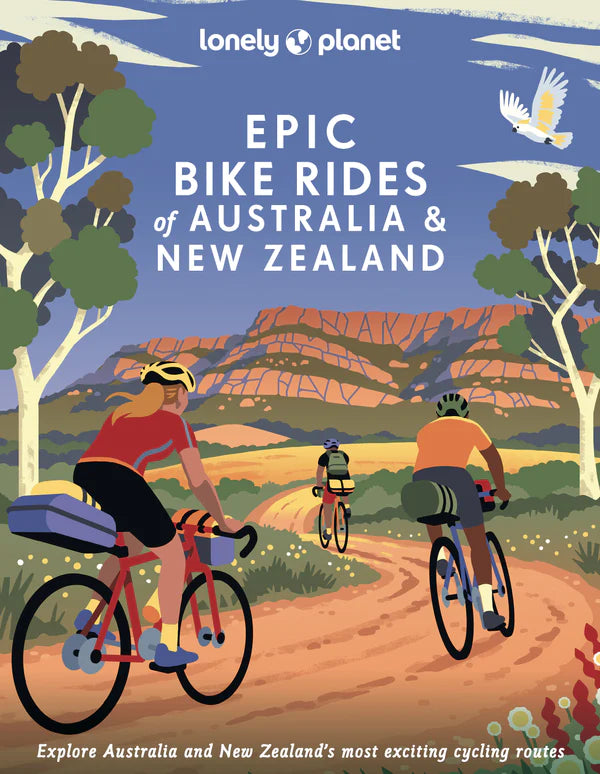
New Releases
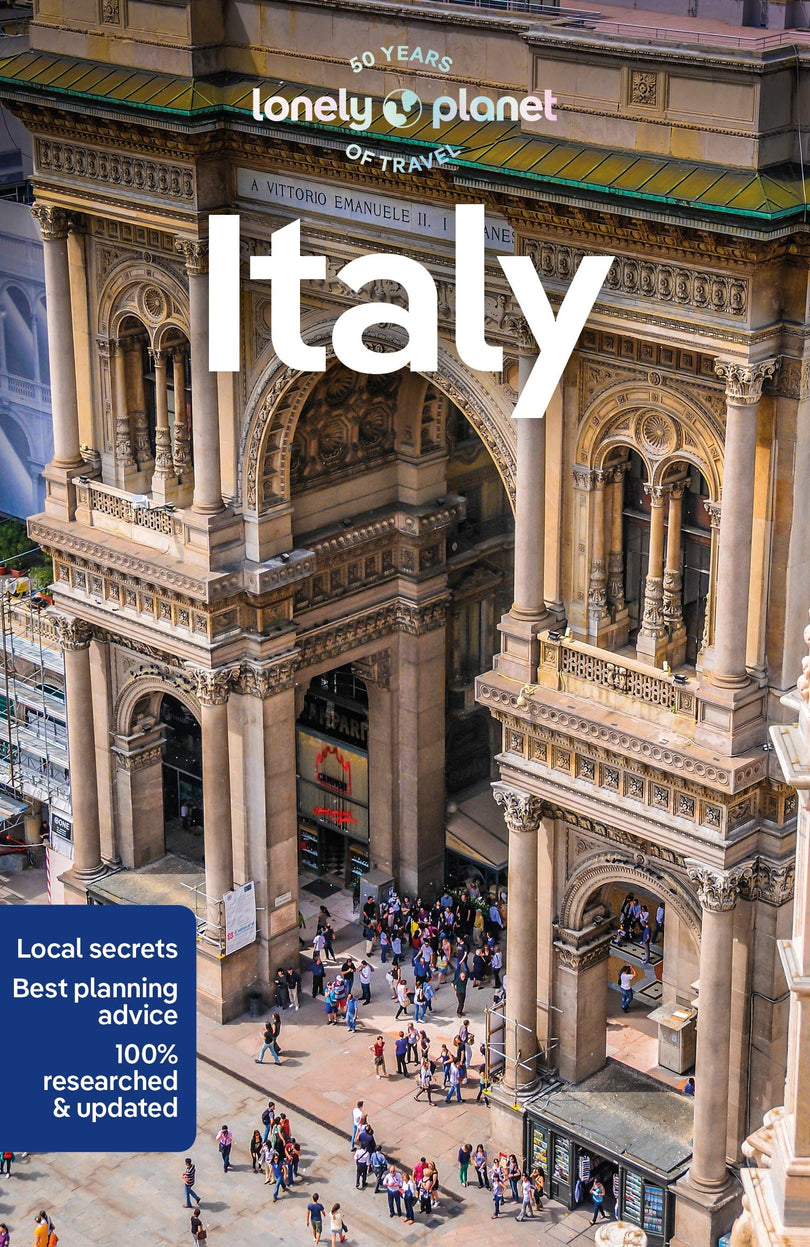
Trending Destinations
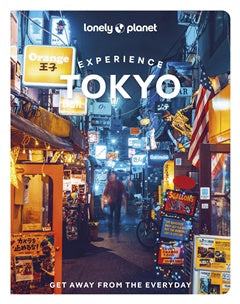
Experience Guides
- Outdoor Travels & Adventures
- Epic Guides
- Food & Drink
- Gifts & Inspiration
- Language Guides
- Lonely Planet Kids
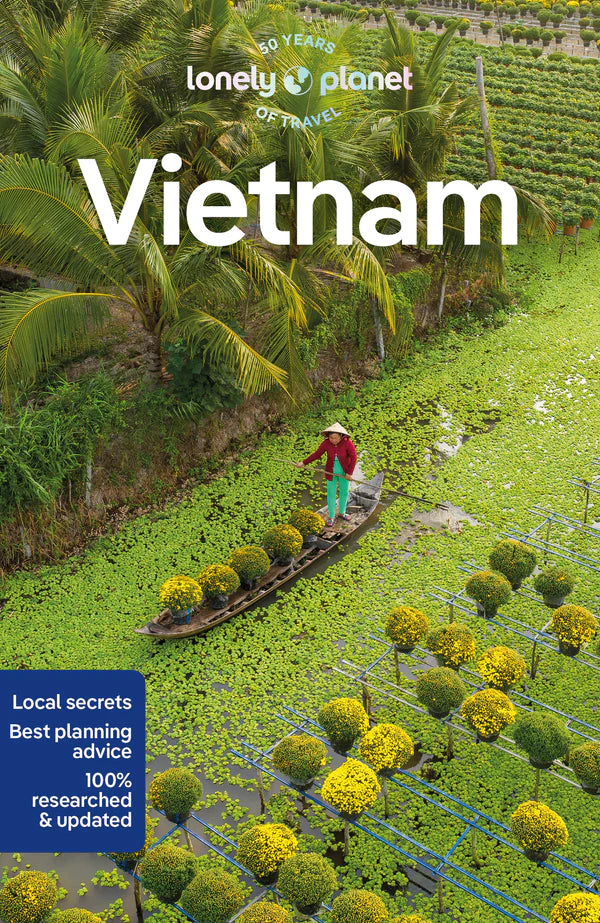
Country Guides
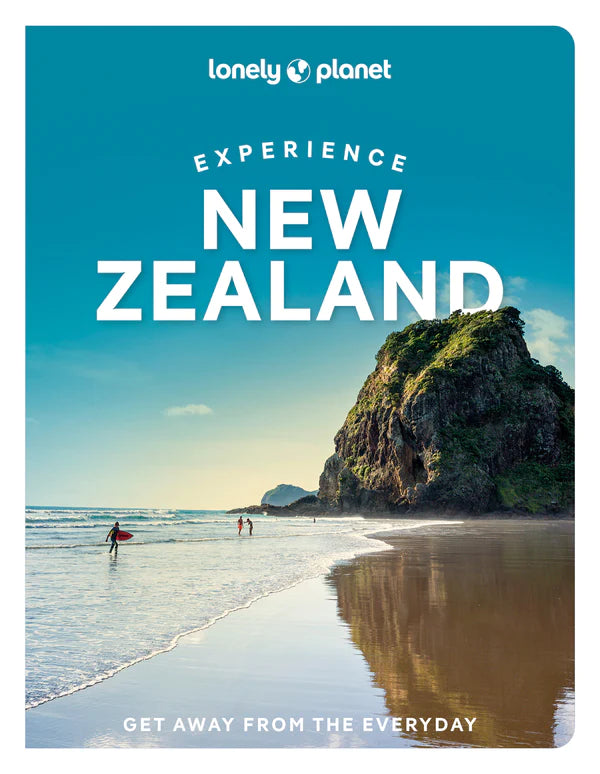
Pocket Guides
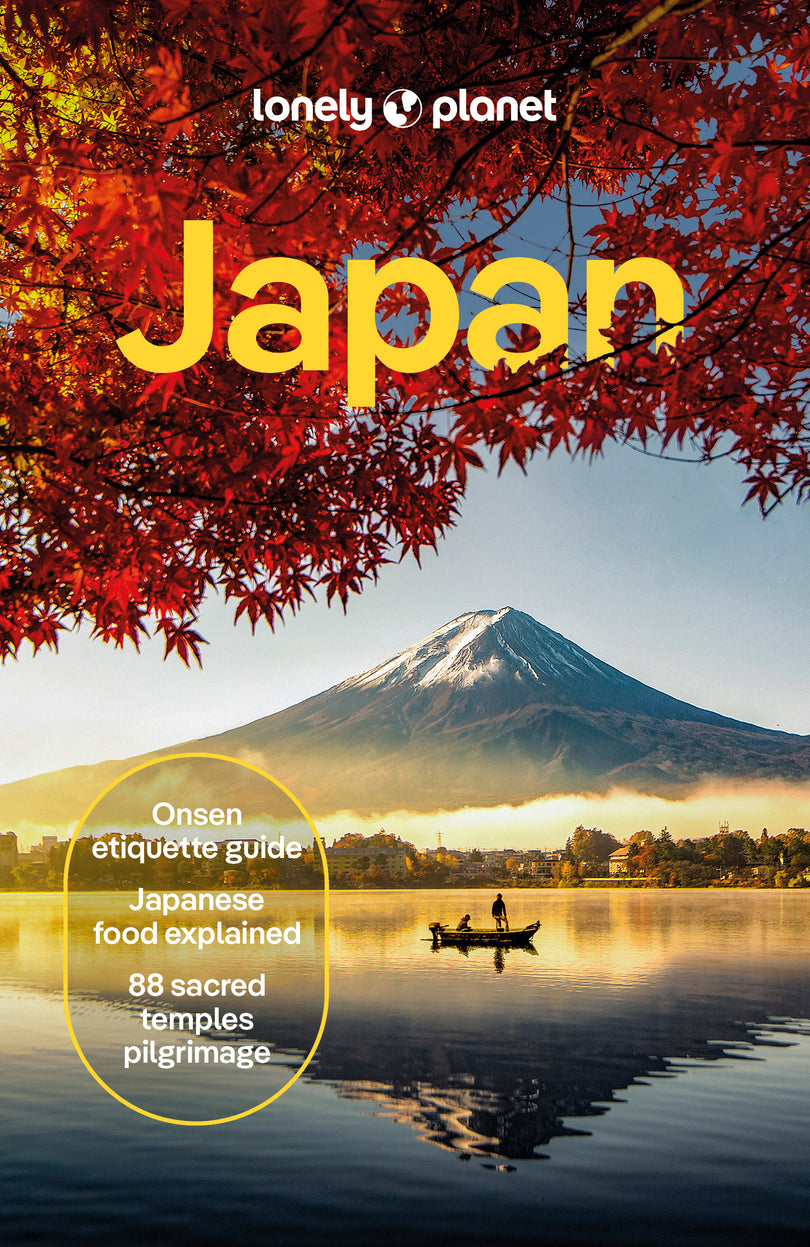
All Guides & eBooks
- Lonely Planet Insider
Your cart is empty
Get this book for free by becoming a Lonely Planet Insider:
- 3 eBook downloads every year
- Exclusive offers and discounts
$2.99 USD/month (charged annually) Learn more
You may see your eBook price change from your local currency to USD during checkout. Our team is working on a fix for this and hope to have it resolved soon. We apologize for this inconvenience.
- Full-colour maps and images throughout
- Highlights and itineraries help you tailor your trip to your personal needs and interests
- Insider tips to save time and money and get around like a local, avoiding crowds and trouble spots
- Essential info at your fingertips - hours of operation, phone numbers, websites, transit tips, prices
- Honest reviews for all budgets - eating, sleeping, sight-seeing, going out, shopping, hidden gems that most guidebooks miss
- Cultural insights give you a richer, more rewarding travel experience - festivals, cuisine, religion, history, architecture, literature, music, crafts, environment
- Over 50 maps
Covers Includes: Tehran, Esfahan, Yazd, Shiraz, Persepolis, Kashan, Choqa Zanbil, Takht-e Soleiman, Tabriz, Masuleh, Mashhad, Garmeh, Alamut Valley, Alborz Mountains, Kaluts, Qeshm Island and more
eBook is available in ePub, MOBI and PDF.
ISBN: 9781786575418
Edition: 7th
Publication Date: September 2017
Writers: Simon Richmond, Jean-Bernard Carillet, Mark Elliott, Anthony Ham, Jenny Walker, Steve Waters
384 pages, 32pp color, 52 maps | Dimensions: 128mm × 197mm
Next edition due: December 2025
Language: English

Which guidebook is right for me?
Country, city & regional guides.
- Top experience collections
- Regional itineraries recommended by experts (from a couple of days to multi-week)
- 3D illustrations and guided tours of key sights
- Extensive coverage of history and culture
- Detailed maps throughout - includes walking maps and a pull-out planning map
EXPERIENCE guides
(country, city & regional).
- Led by local experts that reveal their favorite experiences and hidden gems
- Personal itinerary building tools
- Seasonal planning calendars
- QR codes unlock additional online content
POCKET guides
(city & regional).
- Special features cover most popular sights
- Content organized by neighborhhod
- Recommended 1, 2, 3 and 4-day itineraries
- Guided walking tours
5 of the Best Iran Guidebooks
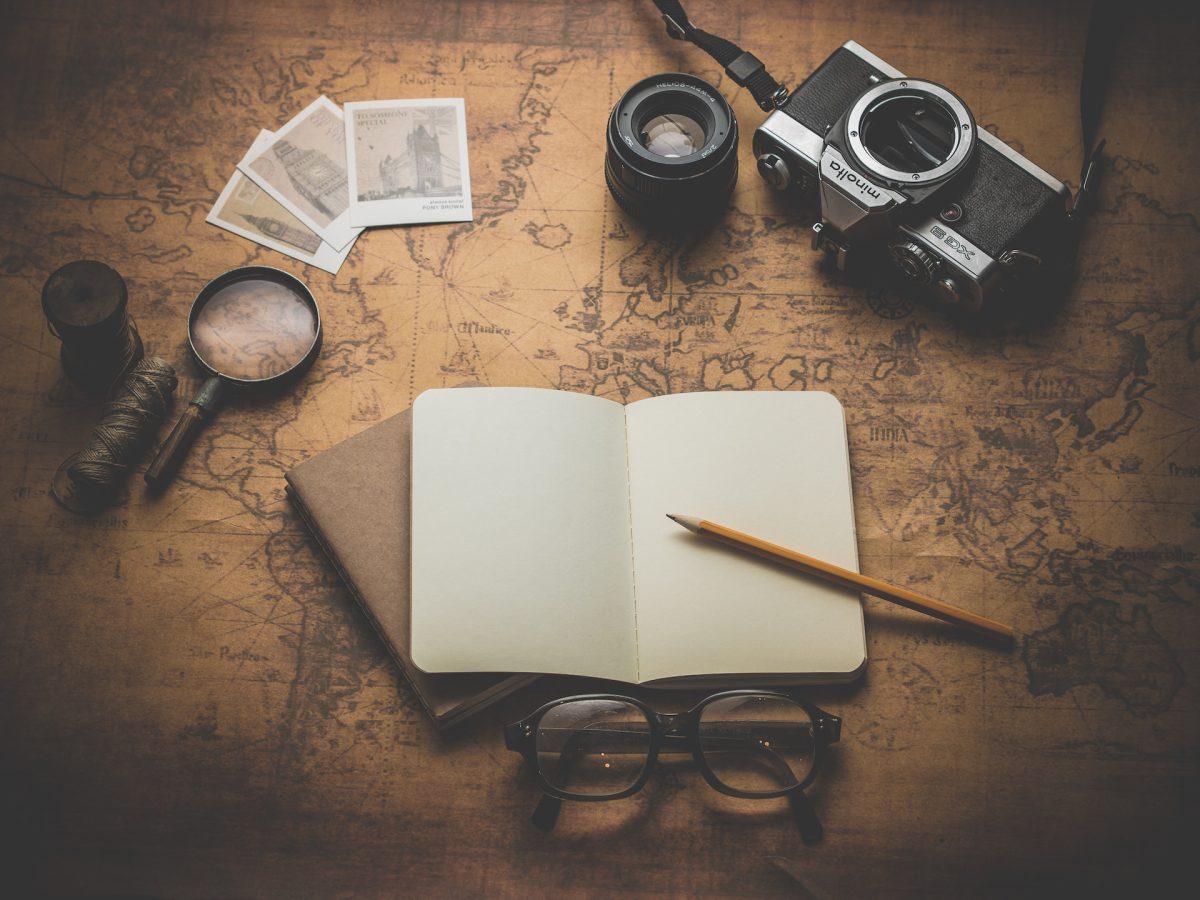
Table of Contents
There are lots of Iran guidebooks for those who want to travel to Iran. Some of these books are written by international organizations like Lonely Planet and some are written by those who have come to Iran and experienced Iran firsthand. Here I’d like to share 5 of the best Iran guidebooks with you.
Iran (Bradt Travel Guide Iran)
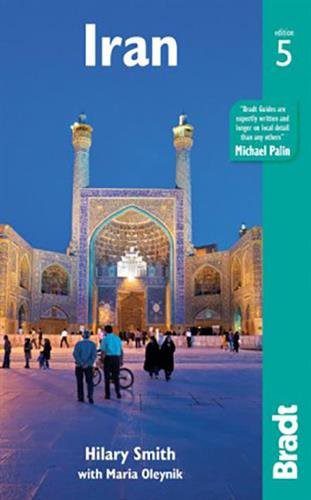
Now into its fifth edition, Bradt’s guidebook regarding Iran provides the most detailed background, history and cultural information available when visiting this “ Jewel of Central Asia “. This new edition has been thoroughly reviewed to provide all the latest information, from updated history and cultural developments to security, language, and hotel prices, plus expanded practical information for independent travelers. Food and arts, rugs, and handicrafts are all covered, plus new details of skiing in Iran and recommended Iranian movies. For outdoor enthusiasts, swimming, desert, and eco-tours are also included. With new direct flights to Iran now available from Europe, and warm-hearted and welcoming people eager to meet tourists, visiting this intriguing country has never been easier.
Iran’s cities are packed with gilded mosques and blue-mosaic shrines built in honor of the country’s greatest leaders. Its people are generous and its terrain ranges from the sands of the Persian Gulf to the Alborz Mountains in the north. The expert authors give first-hand descriptions of attractions ranging from the exquisite mosques of Esfahan and the museums and palaces of Tehran to the spectacular mountain hikes. New maps and up-to-date information on all the basics – hotels, restaurants, businesses and shops – help you to uncover the mysteries of ancient Persepolis , to enjoy a soak and scrub in a local hammam (bath), or to pick up a pair of giveh slippers or a Persian rug in Kerman’s bazaar.
Thoroughly updated, this new edition also includes new details of ‘Around Tehran’, caravanserai, Nishapur, Qaleh Rudkhan, and Kurdish villages on the Silk Road Trail, plus new maps of the historic bazaars of Esfahan, Yazd, Kerman, and Shiraz. It has been updated by Middle East expert Maria Oleynik, who is fluent in ten languages, including Persian and Arabic.
Iran – Culture Smart!: The Essential Guide to Customs & Culture
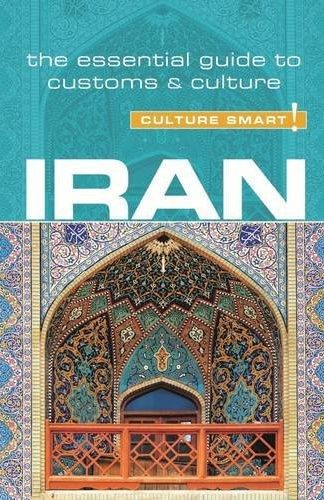
Iran is home to one of the world’s oldest civilizations. Travelers have long been seduced by the echoes of the extraordinary ancient history contained in the word “Persia.” But Iran is also a modern society that is experiencing great changes. Although it is still feeling the effects of the Islamic Revolution of 1979, social restrictions have loosened considerably in recent years. Strict Islamic rules coexist with an increasingly dynamic society driven by an overwhelmingly young population. Animosity toward the West at a political level sits side-by-side with a wholehearted welcome for foreigners as individuals.
“ Iran- Culture Smart !” is one of those Iran guidebooks that takes you beyond the clichés to show how life in Iran really is and how you can feel comfortable in its society. It offers insights into a country full of surprises. Despite Iran’s deep commitment to Islam, the pre-Islamic Zoroastrian past is still a part of people’s everyday culture. Its language, Farsi, shares linguistic roots with English and French. It is a country where one of the most genuine democracies in the Middle East is overlaid by an unelected theocracy. And where “No, thank you” really does sometimes mean “Yes, please.” If nothing else, this entrancing, beautiful, and sometimes infuriating place is a country whose inhabitants genuinely wish visitors Khosh Amadi! —Welcome!
Author: Stuart Williams
Iran Travel Stories
A History of Iran: Empire of the Mind
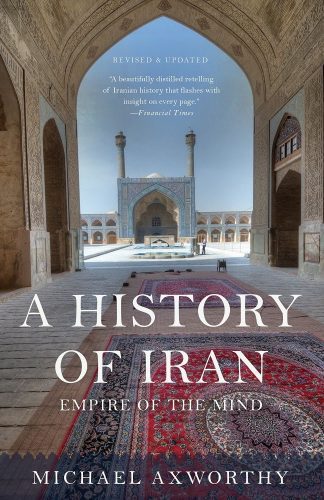
Iran is a land of contradictions. It is an Islamic republic, but one in which only 1.4 percent of the population attends Friday prayers. Iran’s religious culture encompasses the most censorious and dogmatic Shi’a Muslim clerics in the world, yet its poetry insistently dwells on the joys of life: wine, beauty, and sex. Iranian women are subject to one of the most restrictive dress codes in the Islamic world, but they are always stylish.
In “ A History of Iran ” , acclaimed historian Michael Axworthy chronicles the rich history of this complex nation from the Achaemenid Empire in the sixth century B.C. to the present-day Islamic Republic. In engaging prose, this revised edition explains the military, political, religious, and cultural forces that have shaped one of the oldest continuing civilizations in the world, bringing us up to modern times.
Concluding with an assessment of the immense changes the nation has undergone since the revolution in 1979, including a close look at Iran’s ongoing attempts to become a nuclear power, A History of Iran offers general readers an essential guide to understanding this volatile nation, which is once again at the center of the world’s attention.
Author: Michael Axworthy
Iran, Persia: Ancient and Modern
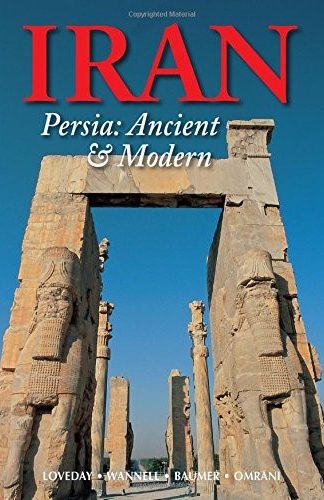
Iran, or Persia as it was formerly known, has been of interest to outsiders for millennia. From the Greco-Persian wars of antiquity, through the rise and flourishing of Islam, to the age of European imperialist expansion in the East, Iran has been a central player in global history. Drawn by its strategic location along the Silk Road, ancient and distinctive culture, and abundant natural resources, foreign diplomats, traders, and travelers have been coming to Iran for centuries.
The Islamic Revolution of 1979 and subsequent events put a strain on Iran’s relationship with the outside world, particularly the West, leading to sanctions and a decline in tourism and trade. Today, the country’s attractiveness to outsiders has greatly increased, with travelers and business people once more setting their sights on Iran.
“ Iran, Persia: Ancient and Modern “
Authors: Christoph Baumer, Helen Loveday, Fitzroy Morrissey, Bijan Omrani, Bruce Wannell
Iran, Islamische Republik und jahrtausendealte Kultur (German Book)
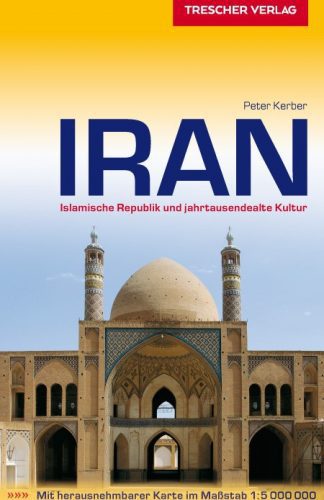
All regions of Iran in 600 pages – Over 400 color photos – Key travel information at a glance – Plenty of background information on history, culture, and everyday life – Detailed descriptions of all attractions – Over 50 city maps and overview maps – Numerous practical tips and travel recommendations from A to Z.
Iran is a fascinating travel destination that, throughout its millennia-long history, has been a melting pot of civilizations, as evidenced by impressive ancient excavations such as Persepolis or Pasargadae. In addition to unparalleled architectural monuments, the country boasts astonishing landscape diversity with fertile valleys, barren plateaus, and towering mountain ranges. All of this, and above all, the hospitable people of the country, leave indelible impressions on every visitor.
Those who wish to form their own opinion contrary to some reservations will be surprised by how safe it is to travel as a tourist in the country and will return with many positive impressions.
Iran, Islamische Republik und jahrtausendealte Kultur – by Peter Kerber
How to Get an Iran Visa; A Complete Guide
FAQs about Traveling to Iran
Q: is it safe to visit iran.
A: Iran is generally considered a safe destination for travelers. However, it is always advisable to stay informed about the current situation and follow any travel advisories issued by your home country. Exercise common sense, respect local customs and laws, and take necessary precautions to ensure your safety.
Q: Do I need a visa to enter Iran?
A: Yes, most visitors to Iran require a visa. You can obtain a visa through an Iranian embassy or consulate in your home country or apply online through a travel agency before your trip. Some nationalities are eligible for visa-on-arrival, but it is recommended to check the latest visa requirements well in advance of your travel.
Q: What is the best time to visit Iran?
A: Iran experiences diverse climatic conditions. Spring (March to May) and autumn (September to November) are generally considered the best times to visit, as the weather is pleasant. However, it depends on the specific regions you plan to explore. Summers can be hot in some parts, while winters can be cold, especially in mountainous areas.
Q: What should I wear in Iran?
A: Iran has a dress code that requires both men and women to dress modestly. Women should cover their heads with a headscarf and wear loose-fitting, knee-length, or longer clothing that covers their arms and legs. Men should also avoid wearing shorts or sleeveless shirts in public.
Q: Can I use my credit/debit cards in Iran?
A: International credit and debit cards are generally not accepted in Iran due to sanctions. Therefore, you can either bring cash to cover your expenses or request an Iranian debit card when making arrangements with your travel agent. Also, be noted that money exchange facilities are available, and it is recommended to exchange currency at authorized exchange offices or banks.
Q: What is the main language spoken in Iran?
A: The official language of Iran is Persian (Farsi). However, there are also various regional languages and dialects spoken throughout the country. While English is not widely spoken, you can find English-speaking individuals in hotels, tourist areas, and larger cities.
Q: Can I use the internet and social media in Iran?
A: Internet access is available in Iran, but there are restrictions on certain websites and social media platforms. Some popular platforms like Facebook, Twitter, and YouTube may be blocked or have limited access. However, you can use Virtual Private Networks (VPNs) to bypass these restrictions if necessary.
Q: Is it customary to tip in Iran?
A: Tipping is not common in Iran. However, it is appreciated if you wish to show appreciation for exceptional service. In restaurants, it is common for a service charge to be included in the bill. It is always a good idea to check and understand the bill before deciding whether to leave an additional tip.
Q: What are some cultural norms and customs to be aware of in Iran?
A: Iranians are known for their warm hospitality and respect for guests. It is customary to greet people with a handshake and exchange pleasantries. It is important to respect Islamic customs, such as not consuming alcohol in public and refraining from public displays of affection. Additionally, be mindful of local customs and traditions when visiting religious sites and conservative areas.
Customize your Iran tour to get what you exactly want
Leave a reply cancel reply.
Your email address will not be published. Required fields are marked *
Save my name, email, and website in this browser for the next time I comment.
2 thoughts on “ 5 of the Best Iran Guidebooks ”
Touche. Great arguments. Keep up the good work.
Hi there to every one, the contents existing at this web page are actually amazing for people experience, well, keep up the good work fellows.
Free Iran Travel Consultation
Let us know whatever you need for your trip, and we assist in arranging everything needed
Recent Posts
- Jameh Mosque Yazd: Stepping into the Past
- Alexander Prison: From Dungeon Myths to National Heritage
- Zoroastrian Fire Temple of Yazd: Flames of Unity
- Dowlat Abad Garden: A Symphony of Nature & Architecture
- Zurkhaneh: Traditional Persian Gym
Discover the most outstanding articles on all topics of life. Write your stories and share them
- Iran Visa Policy
- Apply for Iran visa
- Active Style
- Inside Style
- Discovery Style
- In-Depth Style
- Knowledge Based Style
- Daily Tours
- Why “To Iran Tour”?
- Partnership with To Iran Tour
Find Your Account
Iran Travel Guide
Publisher description.
#1 best-selling guide to Iran* Lonely Planet Iran is your passport to the most relevant, up-to-date advice on what to see and skip, and what hidden discoveries await you. Hike among the Castles of the Assassins in Alamut Valley, Lose yourself in Esfahan’s historic bazaar, or ski in the Alborz Mountains; all with your trusted travel companion. Get to the heart of Iran and begin your journey now! Inside Lonely Planet Iran Travel Guide: Full-colour maps and images throughout Highlights and itineraries help you tailor your trip to your personal needs and interests Insider tips to save time and money and get around like a local, avoiding crowds and trouble spots Essential info at your fingertips - hours of operation, phone numbers, websites, transit tips, prices Honest reviews for all budgets - eating, sleeping, sight-seeing, going out, shopping, hidden gems that most guidebooks miss Cultural insights give you a richer, more rewarding travel experience - festivals, cuisine, religion, history, architecture, literature, music, crafts, environment Over 50 maps Covers Tehran, Esfahan, Yazd, Shiraz, Persepolis, Kashan, Choqa Zanbil, Takht-e Soleiman, Tabriz, Masuleh, Mashhad, Garmeh, Alamut Valley, Alborz Mountains, Kaluts, Qeshm Island and more eBook Features: (Best viewed on tablet devices and smartphones) Downloadable PDF and offline maps prevent roaming and data charges Effortlessly navigate and jump between maps and reviews Add notes to personalise your guidebook experience Seamlessly flip between pages Bookmarks and speedy search capabilities get you to key pages in a flash Embedded links to recommendations’ websites Zoom-in maps and images Inbuilt dictionary for quick referencing The Perfect Choice: Lonely Planet Iran , our most comprehensive guide to Iran, is perfect for both exploring top sights and taking roads less travelled. Looking for more extensive coverage? Check out Lonely Planet Middle East guide. Authors: Written and researched by Lonely Planet. About Lonely Planet: Since 1973, Lonely Planet has become the world's leading travel media company with guidebooks to every destination, an award-winning website, mobile and digital travel products, and a dedicated traveller community. Lonely Planet covers must-see spots but also enables curious travellers to get off beaten paths to understand more of the culture of the places in which they find themselves. *Best-selling guide to Iran. Source: Nielsen BookScan. Australia, UK and USA
Food and drink in Iran
Iranian cuisine is one of the world’s finest, an intriguing mixture of sweet and sour that owes nothing to the Chinese version. Iranian khoresht – stewed dishes of meat and fruit – may sound uninspiring but wait until you’ve tried duck or chicken in pomegranate and walnut sauce ( fesenjan ), lamb with morello cherries or apricots, beef or lamb with spinach and prunes ( aloo ) and chicken and zereshk (barberries), etc. Delicious.
Also try abgoosht (literally water-meat), or dizzi stew served in a jug-like container with a pestle and commonly available even at bus station restaurants. This is a concoction of slowly simmered pulses, meat and vegetables. When in Esfahan, try beryani, boiled lamb meat minced and fried with onion and spices. Saffron (in particular from Mashhad) itself is a very common ingredient that you will even taste in chicken kebab and rice.
White rice and bread are the staple foods. A delicious change is rice with butter slowly steamed until a crunchy, caramelised layer is formed. Traditional Iranian salads or servings of fresh mint leaves are called sofreh and traditional restaurants are then often called s ofreh knaneh , meaning a ‘house of sofreh’ in Persian.
Fresh fish such as trout from the many farms, prawns and shrimps from the south and north coast, and sturgeon from the Caspian Sea are flown in every day to the major cities.
The Iranian equivalent of British fish and chips, or American hamburger and French fries, is chelo-kebab , a skewer of grilled lamb, served with plain rice, with or without a raw egg on top. There is also Iranian coleslaw, which is often available in restaurants in place of salad or in addition, and is called salad-e kalam (cabbage salad). Zorat-e mekziki (Mexican corn) is the the all-time favourite snack on sale practically everywhere in major cities.
And of course there’s the originally Shirazian sweet delight of falludeh ice, a sorbet with wispy ‘noodle’-like strands, served with lime juice and ice cream. One of the joys of visiting Iran is sitting eating falludeh , sipping tea or smoking a pipe in the attractive surroundings of a historic tea house. Gooshfil deep fried and poolaki caramelised sugar sweets are also widely popular.
All alcohol is banned in Iran although the Christian communities, in Esfahan for example, are allowed wine strictly for communion use. However, Iran’s famous vineyards are now being recultivated after most were uprooted in revolutionary zeal; the grapes are for eating, and for the production of grape juice, syrups and vinegar.
Iranian (non-alcoholic) beer is terrible, though Delster is just about palatable if well chilled. A very passable non-alcoholic ‘lager’ is Bavaria, now imported from Dubai. It’s available only in large centres at about 40,000 rials from local shops (US$1) but more in restaurants and hotels – just slightly more than the Iranian bottled beer but worth every rial.
Local carbonated soft drinks, such as cola, Fanta and Sprite, tend to sweetness, and the fruit juices, either freshly pressed or in cartons, are more thirst quenching, such as pomegranate juice, talebi (cantaloupe melon) juice, and carrot juice with a scoop of ice cream from fruit-juice shops. The refreshing, pressed-lime sodas of pre-revolutionary Iran are unfortunately no longer available (presumably because the soda isn’t) but another refreshing drink, doogh (yoghurt and water, like Turkish ayran or Indian lassi ), is available.
Health and safety in Iran
Before you go.
It is advisable to be up to date with all primary immunisations including tetanus , diphtheria and polio – an all-in-one vaccine (Revaxis) lasts for ten years. You would also be wise to be protected against hepatitis A and typhoid . Hepatitis A vaccine (eg: Havrix Monodose or Avaxim) comprises two injections given about a year apart. The course costs about £100, but may be available on the NHS; it protects for 25 years and can be administered even close to the time of departure.
Hepatitis B vaccination should be considered for longer trips (two months or more) or for those working with children or in situations where contact with blood is likely. Three injections are needed for the best protection and can be given over a three-week period if time is short for those aged 16 or over. Longer schedules give more sustained protection and are therefore preferred if time allows. Hepatitis A vaccine can also be given as a combination with hepatitis B as ‘Twinrix’, though two doses are needed at least seven days apart to be effective for the hepatitis A component, and three doses are needed for the hepatitis B.
The newer injectable typhoid vaccines (eg: Typhim Vi) last for three years and are about 85% effective. Oral capsules (Vivotif) may also be available for those aged six and over. Three capsules over five days lasts for approximately three years but may be less effective than the injectable forms as their efficacy depends on how well they are absorbed.
Vaccinations for rabies are advised for everyone, but are especially important for travellers visiting more remote areas, especially if you will be more than 24 hours away from medical help and definitely if you will be working with animals.
In the major cities, it will be said that the water is safe for cleaning teeth as it is heavily chlorinated (neighbouring Tajikistan and Afghanistan suffer cholera outbreaks). However, it is always safer to use bottled water both for drinking and for cleaning your teeth.
Opportunities to strip off and sunbathe are obviously severely limited in the Islamic Republic, but the force of the Iranian sun is powerful and there is comparatively little shade so avoid excessive exertion during midday hours and wear a sunhat. Women should wear theirs over a scarf. Clothing in natural fibres is most comfortable for the hotter months but evening temperatures can drop suddenly, especially in the hills, so take a light sweater too.
Take the usual precautions when walking across rough and stony ground, and through shrubbery and vegetation, against snakes, scorpions, etc. If you are entering a ruined building from broad sunlight, make a noise so that any snakes retreat.
Travel clinics and health information
A full list of current travel clinic websites worldwide is available on www.istm.org . For other journey preparation information, consult www.travelhealthpro.org.uk (UK) or http://wwwnc.cdc.gov/travel/ (US). Information about various medications may be found on www.netdoctor.co.uk/travel . All advice found online should be used in conjunction with expert advice received prior to or during travel.
Safety in Iran
Any crime carries severe penalties in the Islamic Republic. It is likely that the greatest danger you will face (other than crossing the road) is having your wallet, purse or camera snatched. Keep photocopies of the most important pages (including the visa if possible) of your passport and air ticket, and spare passport photos separately, and don’t flash money or expensive camera equipment ostentatiously. The British Foreign and Commonwealth Office has warned that bogus policemen have approached some visiting foreigners, advising that in such circumstances you should insist on seeing an identity card and inform the restaurant, shop or hotel of the incident. Remember that no Iranian policeman has the right to take or retain your passport unless you are in a police station.
Iran is very safe for women travellers. Harassment is now minimal, especially if you wear the manteau , as it is assumed you are Iranian and/or Muslim. Be aware, however, that it is very unusual for a single woman to walk unescorted in public at night. Make sure to avoid being alone in the evening in particular in the old town in Yazd, or Ahvaz and Khuzestan generally. If you do feel, however, that you are being harassed, you are strongly encouraged to bring this to the attention of other people present, in particular men (eg: a bus driver). Such behaviour is looked down upon by other members of the society. By expressing your indignation publicly you will be doing other female travellers, and yourself, a great favour. Keep in mind that harassment often happens simply because it is perceived as acceptable.
Road safety in Iran
You are more likely to be in danger if you insist on importing your car. There were 24,000 road deaths and over 80,000 injuries reported in Iran in 2006. During the first eight months of 2012 around 14,000 people lost their lives. The number of deaths, however, seems to be slowly decreasing from the peak of 27,759 deaths in 2005. Leaving aside the nightmare of Tehran traffic, which guarantees road rage and stomach ulcers, be aware that Iranian lorry and coach drivers work very long hours and that few private vehicles have reflectors or working lights and their drivers disregard every rule in the book.
Traffic does not necessarily stop at a red light, nor wait until green before setting off, with the exception perhaps of Kish and Qeshm. Regard zebra crossings as merely road surface decorations. Pedestrians take their life into their own hands crossing the road and the sight of their terror-stricken faces forms the chief entertainment for motorists. If a driver flashes his/her lights it does not mean it is safe to cross; your presence is being acknowledged, but not necessarily your continued existence on this earth. On the other hand, having started to cross, do not turn tail or break into a run; both actions constitute a personal challenge to the driver to continue the pursuit.
Personal conduct
Be aware that it is easy to break an important social convention without realising it and this can affect your safety. For instance, in summer 2004, the smoking of ‘hubble-bubble’ waterpipes ( qalian ) in public was banned on the grounds that it promoted ‘licentious behaviour’. Presently men can smoke in public, but it may be more difficult for women, as most traditional tea houses would not serve qalian to women or mixed groups.
If you are confronted with officialdom, do not lose your temper, shout or threaten. Be polite and apologetic if not abject. Women: forget all feminist scruples and cry. Always insist on seeing someone who speaks English (any other Western language will be difficult).
Travelling with a disability
Planning an accessible trip to Iran may be challenging, as the required information is not easy to come by. Nevertheless, the ancient beauty of this unique country can very well be enjoyed by anyone, with or without disability. Since the establishment of the Ministry of Social Welfare in the 1970s, public services for people with disabilities have improved, and many disability organisations are active to achieve general inclusion.
Travel and visas in Iran
All nationalities except Israelis are allowed to apply for a visa. Anyone domiciled in the USA should approach the Iranian Interests Section of the Embassy of Pakistan or the nearest Pakistani consulate or the Iranian Mission at the United Nations.
Those resident elsewhere, however, including US passport holders, should contact the Iranian embassy or consulate in their country of residence for information regarding the embassy’s opening times, methods of payment and exact visa application details.
Although the procedure for British and US passport holders is complex, other nationalities, including those from Germany, the Netherlands, Scandinavia and Italy, have fewer problems in this respect. Women without headscarves will generally be allowed onto Iranian embassy grounds, however, it is advisable and strongly recommended that you do wear a headscarf as it makes a good impression.
Since 2016 it has been possible to obtain a 30-day tourist visa on arrival in some international airports in Iran. However, visa applications on arrival are not automatic and payment in euros is preferred. US, UK and Canadian passport holders are not eligible for this option and are required to apply in advance through the embassy.
Getting there and away
International Airport (IKA) , Tehran, but foreigners with valid visas can also enter/exit Iran by way of various Persian Gulf states airports (eg: Abu Dhabi and Bahrain to Shiraz, Bahrain to Mashhad, Dubai to Ahvaz and Bandar-e Abbas). Sometimes officials check your baggage receipt against the tag on your luggage.
There are at present no direct flights from any American or Canadian airports. British Airways has a direct London–Tehran service. KLM/Air France and Austrian Airlines have resumed their regular flights to Tehran. Turkish Airlines fly to a number of cities in Iran from Istanbul, including Esfahan, Shiraz and Mashhad. Istanbul–Tehran flight duration is around three hours. All flight carrier options listed below, when booked in advance, should cost around £400 for an economy-class return fare.
A list of current international cities with services to and from Imam Khomeini International Airport is available on the English version of the airport’s website, which also contains useful plans showing routes through the airport, positions of banks and lists of available taxi services.
Pegasus Airlines , the Turkish low-cost airline, fly to Tehran via Istanbul with connections from various European cities.
Aeroflot have good connections to some European cities.
There are border-crossing points from Turkey (via Dogubayezit); from the Republic of Azerbaijan (via Baku/Astara); from Turkmenistan (via Ashkhabad or Sarakhs); and from Pakistan.
Provided you can obtain a visa there is a weekly train, the Trans-Asia Express, from Istanbul to Tehran (twice weekly in summer) leaving on a Tuesday and arriving on a Friday; The Man in Seat Sixty One provides up-to-date information on timetables, booking, prices and train facilities.
Iran can be accessed by sea from Dubai to Bandar-e Lengeh, from Kuwait to Khorramshahr and from Shahjah to Bandar-e Abbas. Ferries are operated by Valfajr Shipping with normally two departures per week. Contact one of the company’s offices to make a reservation.
Getting around
On all forms of public transport that are not pre-segreagated, and excluding planes, men will probably be asked to change their seat to avoid sitting next to female strangers.
When to visit Iran
Visits to the south coast of Iran (eg: Bandar-e Abbas) are best made in the winter months of December, January and February when humidity and heat levels are at their lowest, while spring (March to mid-May) and autumn (mid-September and October) are the best times to travel around central and northern Iran. The summer months of June through to early September are best avoided as the temperature can be in the high 40s (˚C), although it is a dry heat except on the south coast.
Take the numerous public holidays into account if your visit is connected with business and/or your time is limited. Try to avoid Ramadan, the first ten days of Moharram (the sacred month) and the first week of the Nou Rouz celebrations, when staffing in offices and government departments will be minimal and all forms of long-distance transport and hotels will be extremely busy and expensive. However, during the Nou Rouz and throughout the high-season summer months, most historical sites and buildings have extended opening hours (until 20.00).
It is difficult to convey the reality of a land mass of 1,650,000km 2 , but Iran, with its 31 provinces, is three times the size of France, or the size of the United Kingdom, France, Spain, Italy and Switzerland combined. The Zagros Mountains in the west form a natural barrier with Iraq, and to the north are the Caucasian republics and those of central Asia, all of which were once within the territory of the former Soviet Union.
To the east are Afghanistan and Pakistan, while the Persian Gulf and the Sea of Oman mark Iran’s southern limits. It is a land of great contrasts, physically and climatically, as mountain ranges push up the mostly desert plateau of the centre. Apart from the green Zagros chain in the west, there are the snowy crags of the Alborz range in the north, the Makran Mountains in the south and the westernmost extension of the Hindu Kush, which force up the landscape of Iran’s eastern provinces.
This geological ‘upturned bowl’ effect means that towns on the same latitude but on either side of the same mountain range receive very different amounts of rainfall: Dezful (western Zagros, 143m altitude) gets approximately 358mm a year whereas Esfahan (eastern Zagros, 1,570m altitude) receives a mere 108mm.
Much less rain falls in the Great Desert basin, where some areas are pretty much unable to support any life at all. Generally speaking, regions south of latitude 34˚N get rain mainly during January, while those north of this receive most rainfall during the spring, especially April. An exception is the Caspian region, where the heaviest month for rain is October.
Few in the West are likely to associate snow with their mental image of Iran, yet about two-thirds of the Islamic Republic’s land mass usually endures heavy winter snowfalls (January–February) because of the average high altitude throughout the country. Tabriz (1,349m) in the northwest has about 30 days of snow a year, about ten days more than Arak (1,753m) to the east, whereas Esfahan, at a higher altitude, gets about seven days and Yazd (1,230m) about half this.
Of course, areas of very high altitude such as Mount Damavand (the so-called roof of Iran, 5,610m high) and especially its northeast face, Takht-e Soleyman in the Alborz range, and Sabalan (4,500m) near Ardabil in Iranian Azerbaijan have perennial snow as well as glaciers. Indeed, many Tehranis escape the smog and pressure of life within the overcrowded capital by flocking to the ski runs that drape the mountains, within a few hours’ drive of the city.
There are three if not four distinct climates in Iran: most regions have the continental climate of long, hot summers and short, sharp winters. In the northwest, the Iranian province of Azerbaijan shares a similar climate to that of Switzerland, and further east, along the south shore of the Caspian, it is as humid as the south, but without those gruesome higher temperatures. In the central desert region it is dry and insanely hot (NASA’s infrared satellites measured the Dasht-e Lut desert at Gandom Beryan cindering at 70.7°C during the summer of 2005). In August 2015, the town of Bandar Mahshahr in southern Iran recorded a ‘heat index’ of 74°C, the second highest ever recorded.
Events calendar
Join iranians in their mid-winter festivities.
Translated as ‘100 days’ before the Iranian New Year, jashn-e sadeh celebrates the most sacred symbol of Zoroastrianism, fire. Festivities include lighting fires outdoors, as well music and dancing. Main events usually take place inside Zoroastrian shrines.
Fajr International Film Festival
Celebrated since 1982 this festival is Iran’s largest cinema happening of the year featuring Iranian as well as international cinema. It is usually followed by the Fajr International Music Festival also held in Tehran with performances from Iran and abroad. February in particular is full of cultural and music events as part of the celebrations of the 1979 Islamic Revolution anniversary.
Dare yourself to jump over a bonfire
On the last Tuesday of the Iranian calendar, this fire-jumping festival is held as a prelude to Iranian New Year (Nou Rouz) celebrations on 21 March, marking the arrival of spring and awakening of nature.
Spread your picnic blanket to celebrate sizdah bedar
On 13th day of the Iranian month of Farvardin, in the much loved Iranian tradition of sizdah bedar , families gather outdoors to enjoy spring, good food and nature.
Spot celebs along the red carpet for Hafez
In the honour of the excellent Iranian cinema tradition, the best films and actors are nominated and awarded this prestigious prize for their work.
Join Iranians in their fasting during the holy month of Ramadan
The holy Muslim month of Ramadan starts in July and lasts into August. Throughout its duration Iranians refrain from drinking, smoking or eating during the daylight hours to teach themselves self-discipline, self-restraint and generosity. Share an evening iftar meal in this atmosphere of love and friendliness.
Drop in to a Zoroastrian shrine for the autumn mehregan festival
Devoted to Zoroastrian goddess of light, Mithra, the festival celebrates light over darkness. It is believed that Romans adopted Mithra worship from Iran and become devoted followers of the goddess.
Observe a religious Moharram procession
From late October into November (depending on the Muslim calendar), Moharram is considered to be the most important Shi’a ceremony. Marking the death of Imam Hossein, the central point of the holiest month of the year are mourning rituals. Mourning processions are held across Iran to express passion and the notion of martyrdom, a characteristic feature of Shi’a Islam.
Leave the dark nights behind with the winter solstice
Also known as shab-e chelleh, this celebration, usually held on 21 December, marks the first of the 40 days before jashn-e sadeh . Of Babylonian origin, the winter solstice celebration dates back to pre-Zoroastrian times and has to date remained an important feature of Iranian cultural tradition.
What to see and do in Iran
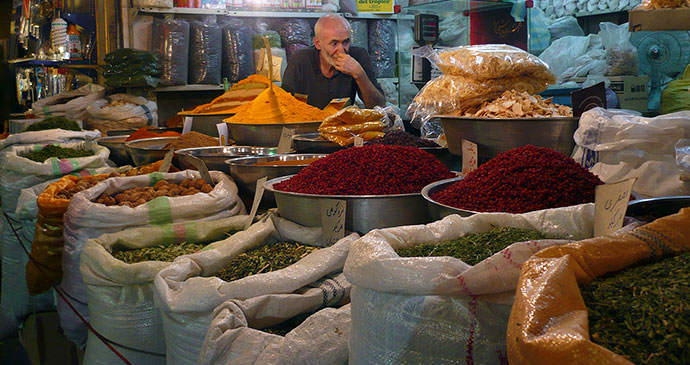
A spice seller at the bazaar © Mohammad Jhiantash, Wikimedia Commons
Esfahan bazaar
Since 1998 many more shops, including one or two selling the famous Esfahani gaz or nougat, have reopened in the covered arcade running all around the square. Before walking through the main 17th-century door of the bazaar, look up and you’ll see a Sagittarius figure and Shah Abbas victorious over the Uzbek enemy, as described by Jean Chardin in the late 17th century. The recent cleaning has also revealed a depiction of Europeans playing chess high up on the right. Above, there was a gallery where musicians banged and trumpeted every sunset, causing foreign merchants to suffer violent headaches, and a Portuguese bronze bell marking the Safavid conquest of Hormuz.
Just inside the door, immediately on the right, a narrow alley leads into a small courtyard of cotton block-printing workshops. There is an endless variety of printed cottons; prices depend on size, quality of the fabric and the colour complexity of the design. Dealers now greatly outnumber the makers and just one or two of them are retained to show tourists the basic technique.
The bazaar runs northwards and eastwards intermittently. The main carpet quarter is situated to the far left (west) away from the main street; a short walk through here will raise serious doubts in your mind whether there are enough homes worldwide to house all these carpets.
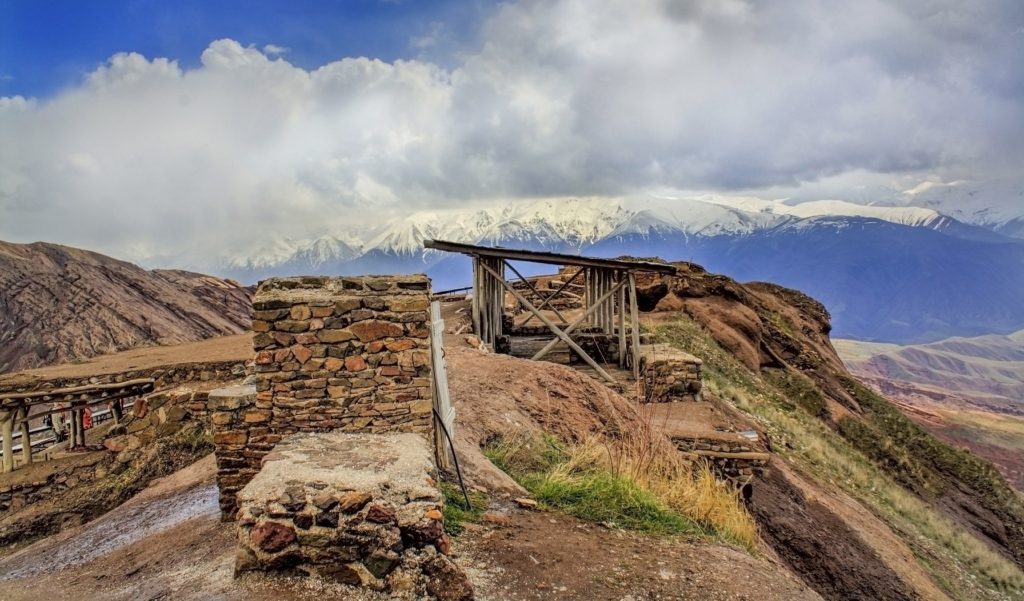
Fortresses of the Ismaili Assassins
As the Fatimid regime of Egypt and Syria began to crack and fragment in the 1060s, the Ismaili community in Iran began to dig in, securing strongholds to defend their villages and land. This valley of the river Alamut soon gained an international reputation as the ‘Valley of the Assassins’, with its chain of impregnable fortresses dominating the trade routes, and its team of highly trained men willing to sacrifi ce their own lives to safeguard the leaders of the Ismaili community, such as Hassan al-Sabbah in Iran and Rashid al-Din Sinan in Syria (the ‘Old Man of the Mountains’ as described by the Crusader chronicler, Joinville).
These were the young men whose clandestine activities spread terror among the Crusaders and Muslim military leaders as they infi ltrated inner court circles to ‘remove’ those who threatened their own community – leaders like the Seljuk sultan and champion of Sunni Islam, Malik Shah (r1072–92), his vizier Nizam al-Molk (assassinated 1092) and Richard Coeur de Lion.
As recorded by Marco Polo, rumours spread that Hassan al-Sabbah could instil such loyalty and single-mindedness only by drugging his followers with hashish (who were then known as hashashiyya , from which comes ‘assassin’) and promising them the delights of paradise.
The reality was that this was a tight-knit community with a rigid hierarchy under a charismatic leader – Hassan al-Sabbah – renowned for his scholarship and library. His death in 1124 resulted in serious disquiet within the community, and without the protection of the strongholds such as Alamut, perhaps its very survival would have been threatened.
Later successors followed more pragmatic policies, establishing links with neighbouring political powers, but the Mongol invasions changed all this. Circumstances allowed Hulagu, the Mongol commander, to seize and imprison the leader of the Iranian Ismaili community in Qazvin in 1256, heralding a massacre in which the fortresses were surrendered.
The community scattered throughout Iran but in the 1770s it was in control of Kerman and Bam, with the blessing of the Zand family. The leader of the Ismailis was honoured with the title of Agha Khan by Fath Ali Shah, but by 1840 the religious atmosphere had so changed that most of the community left for India and the rest scattered around central Asia, Pakistan and East Africa.
The Tomb of Avicenna
This 10th-century Muslim scientist, who originated from Bukhara, central Asia, was mentioned in Chaucer’s Canterbury Tales but the monument itself dates from 1952 and was clearly inspired by the early 11th-century Gonbad-e Qabus monument in northeastern Iran. The museum on the ground floor was once dull and uninformative, but it has been been completely reorganised and is now a delight.
Local artefacts are located in the first room to the left on entry, while the room to the right is a library with interesting displays of historical medical instruments, such as the glass bloodletting suction ‘cuppers’ and manuscripts, while the main hall with the memorial to Avicenna shows the herbs, plants and seeds (with their Latin names) used in pharmacy with labelling in English and Farsi.
There is a good view of Mount Alvand from outside the upper platform, and the gardens are pleasant, although one dices with death crossing to and from the roundabout. Avicenna (born c980ce) fled from his enemies at court in Bukhara (Uzbekistan), arriving in Hamadan in about 1015 to practise as a doctor for some nine years. He then moved to Rayy and Esfahan, returning to Hamadan only to die of colic in 1037.
Most of his 130 or so books have been lost but fragments remain to show he wrote knowledgeably on economics, poetry, philosophy (influencing St Thomas Aquinas) and music as well as physics, mathematics and astronomy. His Book of Healing and Canon of Medicine became the standard medical textbooks in Europe until the mid 17th century; it is from Avicenna and other Muslim scientists that we get such words as algebra, alchemy, alcohol and alkaline.
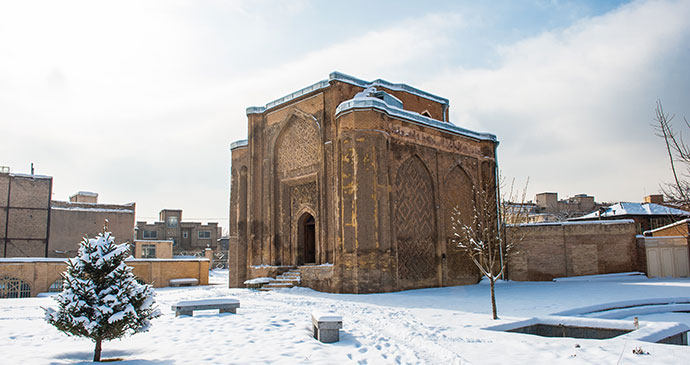
Gonbad-e Alavian
Gonbad-e Alavian is a glorious if dusty tomb building; the girls’ school formerly here has been relocated. It is thought this was the mausoleum for members of the Alavian family, who controlled Hamadan for two centuries, but when it was built exactly is unclear.
To some scholars its elaborately carved plaster of leaf and flower motifs resembles Seljuk decoration as found at Divrigi and elsewhere in Turkey – as well as on the 1148 mausoleum Gonbad-e Surkh in Maragheh – but others argue the almost threedimensional, lace-like ‘Baroque’ quality of its motifs is early 14th-century Ilkhanid work.
The original roof has gone and much of the brick and plaster strapwork exterior has been restored but don’t be put off by the present monochrome colour, dust and gloom; let the plasterwork speak to you. The Quranic inscriptions inside (Q53:1–35), on the mihrab (Q36:1–9), outside (Q76:1–9) and over the entrance (Q5:55–6) refer to rewards and punishments, death and paradise, the importance of prayer and charity giving – all very apposite for a mausoleum and possibly the plaster leaf and plant forms symbolise the gardens of paradise. A torch is useful for the interior.
Nushijan Tappeh
Going 60km in a southerly direction from Hamadan towards Malayer, you arrive at Nushijan Tappeh . British archaeologists worked on this small Median site, about one-sixth the size of the main apadana platform at Persepolis, from 1967 to 1974. Four principal buildings were found on this outcrop: two temples, a fort and a columned hall with an enclosing wall.
The central temple, probably constructed before 700bce, had a narrow entrance leading into an antechamber possessing a stepped ‘Maltese cross’ groundplan and a spiral ramp to an upper level. It then led to a sanctuary with a triangular cella, or inner body of the temple and large blind windows with ‘toothed’ lintels decorating the walls. A brick fire altar (85cm high) with four steps was screened from the entrance and, perhaps to protect its sanctity from later squatters, the temple was filled with shale to a depth of 6m and carefully bricked in. This was a tremendously important find: perhaps the earliest temple with a fire altar in situ found in western Iran.
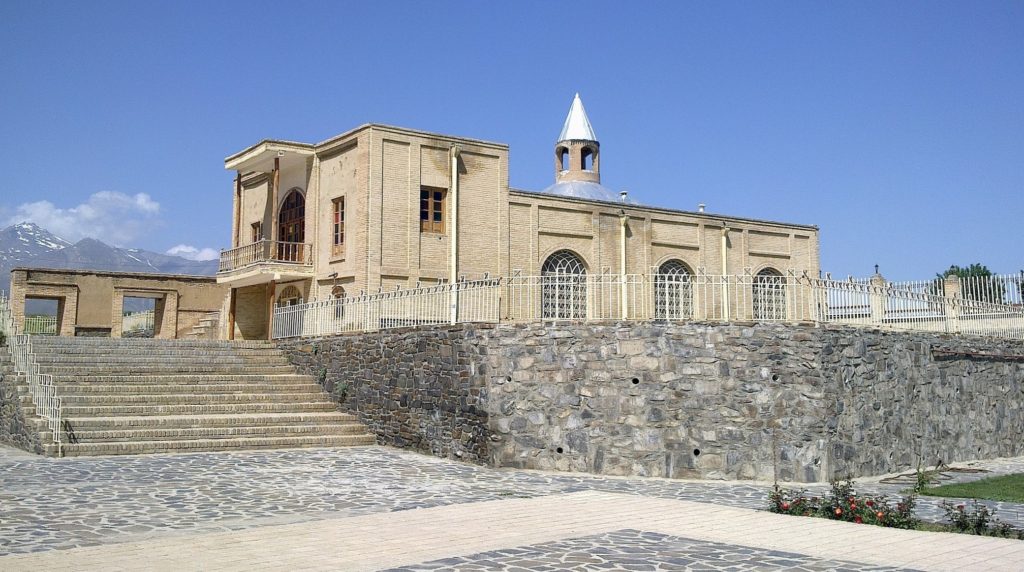
The second temple, located just to the west, had similar rooms and a spiral ramp but with a different orientation and an asymmetrical groundplan. The fort measured 25m x 22m, approximately the size of the Gate of All Nations at Persepolis, with four long magazines and a guardroom with another spiral ramp for access to at least one other floor, while the hall with a slightly irregular groundplan was somewhat smaller with 12 columns supporting a flat roof. Very little stone was used in construction throughout the site but the bricks (especially in the vaults) were often carefully shaped.
For some reason the site was then left largely unoccupied until the Parthian period (c1st century ce). At present the original structure is protected by an aesthetically unappealing steel roof, which regrettably spoils the authentic beauty of the site
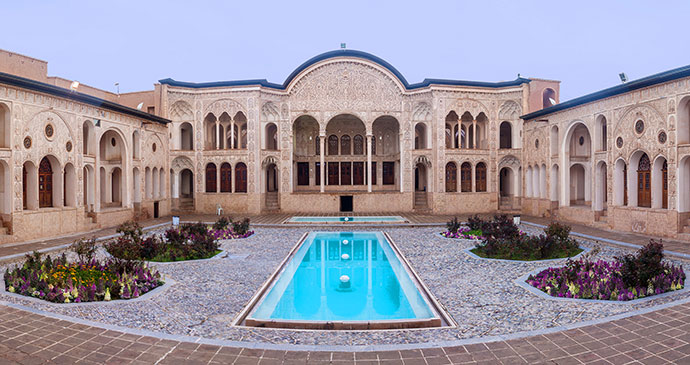
Kashan will always be associated in Islamic art for its high-quality ceramics ( kashi ) production, which dates from the 12th century, even enduring the Mongol campaigns. It is also renowned for its manufacture of costly silks and carpets for the Safavid court.
The 17th-century English merchant, Thomas Herbert, estimated there were then approximately 4,000 families in the town mainly involved in textiles, which would mean that the community was then ‘in compass not less than York or Norwich … The houses are fairly built, many of which are pargeted and painted; the mosques and hamams are in their cupolas curiously ceruleated with a feigned turquoise.’
Undoubtedly he would also have heard that Kashan was the place from which the Three Wise Men set out for Bethlehem. Almost 250 years later, other English travellers reported that Kashan boasted 24 caravanserais, 35 hotels for foreign merchants, 34 hamams , 18 large mosques, and 90 small shrines but in such a bad state that Lord Curzon commented, ‘A more funereal place I had not yet seen.’ Matters were made no better by its reputation for poisonous scorpions.
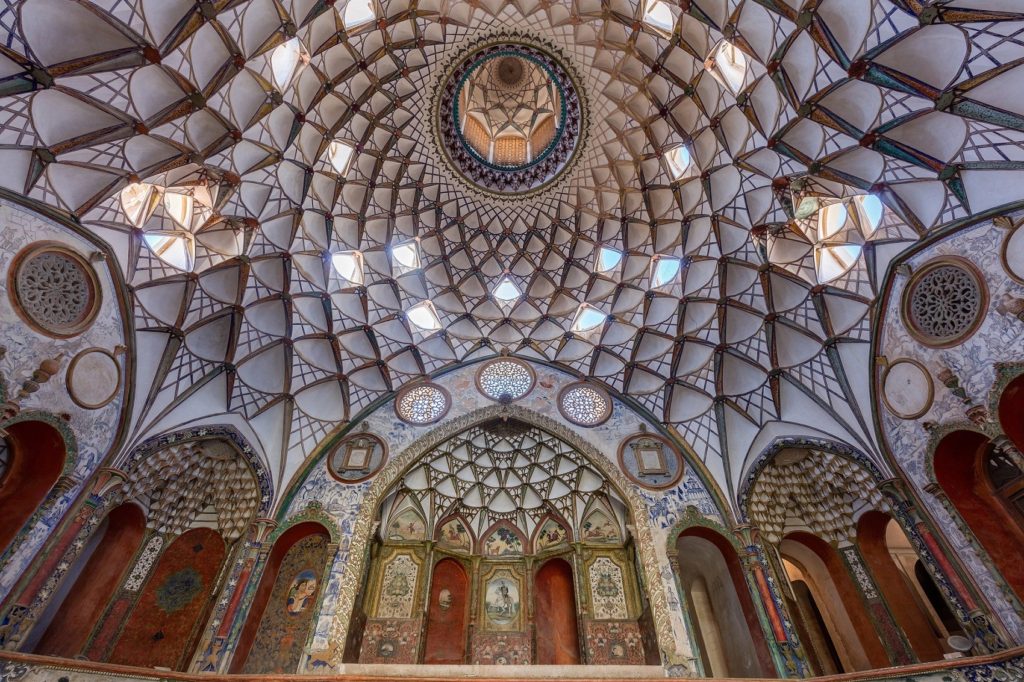
Kashan’s most recent political history has been primarily associated with the nuclear installation in Natanz, 89km southeast from the city. The details of the facility for enriching uranium were leaked in 2002 and subsequently confirmed by President Khatami’s administration.
While the carpet industry here is one of the best in the country, the lack of shops selling them makes it next to impossible to find a good carpet. It is the old merchant houses, however, that make this city special.
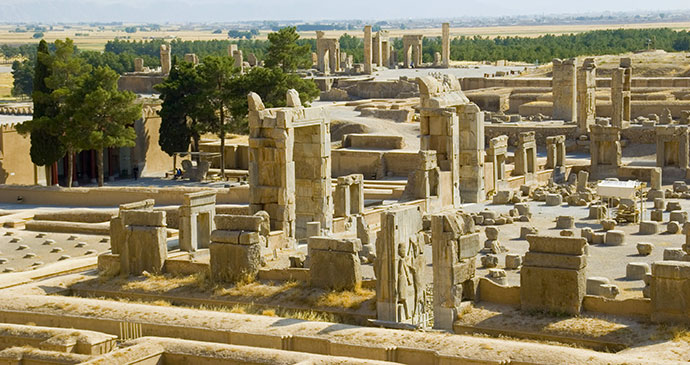
More than any other ancient site in Iran, Persepolis (Takht-e Jamshid in Persian) embodies all the glory – and the demise – of the Persian Empire. It was here that the Achaemenid kings received their subjects, celebrated the new year and ran their empire before Alexander the Great burnt the whole thing to the ground as he conquered the world.
It was Darius the Great who began construction around 515BCE, with his successors adding buildings, but it was still unfinished when, in early 330BCE, Alexander the Great burnt it to the ground after looting the city, seven years before his death. It took him, according to Plutarch, 10,000 mules and 5,000 camels to carry away the booty from this revenge attack for the Achaemenid firing of Athens.
The stone came from nearby quarries but the labourers came from all over the Achaemenid Empire including Greece, as the marks of the Greek toothed chisel testifies. Gold and silver foundation tablets (now in Tehran’s National Museum) were found on the site but more fascinating, for their wealth of detailed information, were the 30,000-odd clay tablets that were uncovered.
The complex consisted of military quarters, treasury stores, small private rooms and huge reception areas, but the exact function of the complex remains an intriguing mystery. Susa was the Achaemenid winter capital and Hamadan the summer residence, while Pasagarda was perhaps built to commemorate Cyrus the Great’s victory over the Medians. But Persepolis?
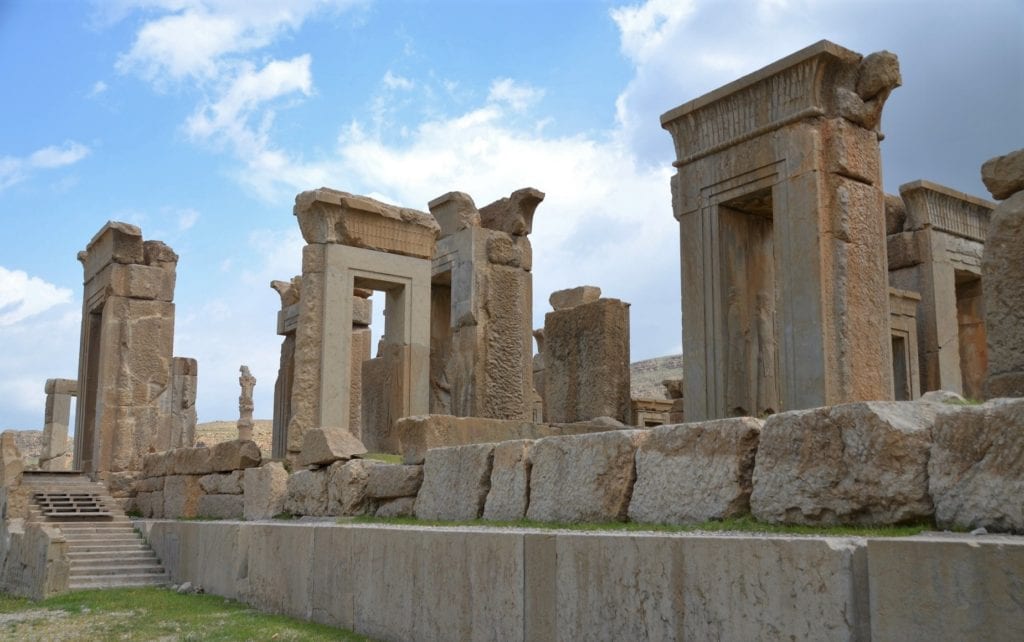
On the evidence of low reliefs showing visitors bearing gifts, and lions attacking bulls (Leo ascendant over Taurus suggesting spring pushing winter away), many assume Persepolis was used once a year to celebrate Nou Rouz, the spring equinox.
Frequent use of the lotus flower motif with its 12 leaves possibly symbolises the 12 months of the year and the always-green cypress tree could also be interpreted to refer to Nou Rouz, but such festivities are not mentioned in Achaemenid and later sources.
There seem to have been only two occasions when the Achaemenid ruler received gifts: on the official imperial birthday, and the annual sacrifice to Mithra.
The bull may also be depicted to represent a cow, a symbol of fertility and a guardian of nomad people.
Shiraz, with its long and rich history, friendliness and the laid-back attitude of its inhabitants, is one of the nicest and most welcoming cities in Iran. As the Iranian saying goes, ‘Esfahan for the head, but Shiraz for the heart’.
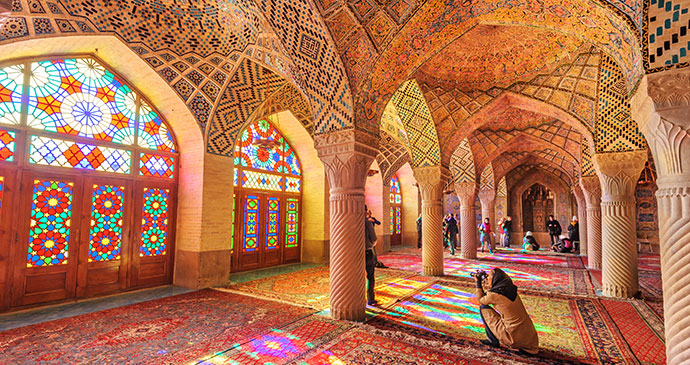
Despite dramatic growth in the last two decades to a population of around 1.5 million and the resultant traffic nightmare, Shiraz has miraculously managed to preserve the relaxed atmosphere of a provincial town, despite the daily assault on both its infrastructure and the nerves of its inhabitants.
It has an excellent university, which annually floods the city with an appealing wave of young, educated and friendly Iranians, who provide the real energy driving this fine city. Many foreign visitors are surprised that Shiraz itself has so few surviving historical monuments when there are such archaeological treasures in the neighbouring countryside, but earthquakes over the centuries have taken a heavy toll, along with the less excusable ‘urban development plans’ of the Pahlavis (for whom Shiraz was an unfortunate target of their dubious vision and largesse).
Shiraz is a place to stroll in fine gardens, see the Azadi Park Ferris wheel and roundabouts crowded with excited schoolgirls, chadors flying in the breeze. Both in the bazaar and in the major shrine, Shah Cheragh, you may glimpse the darker complexions of men and women from various tribal clans such as the Qashqai, the Qash Kuli and the Khamseh, visiting the city for provisions, clothing and jewellery.
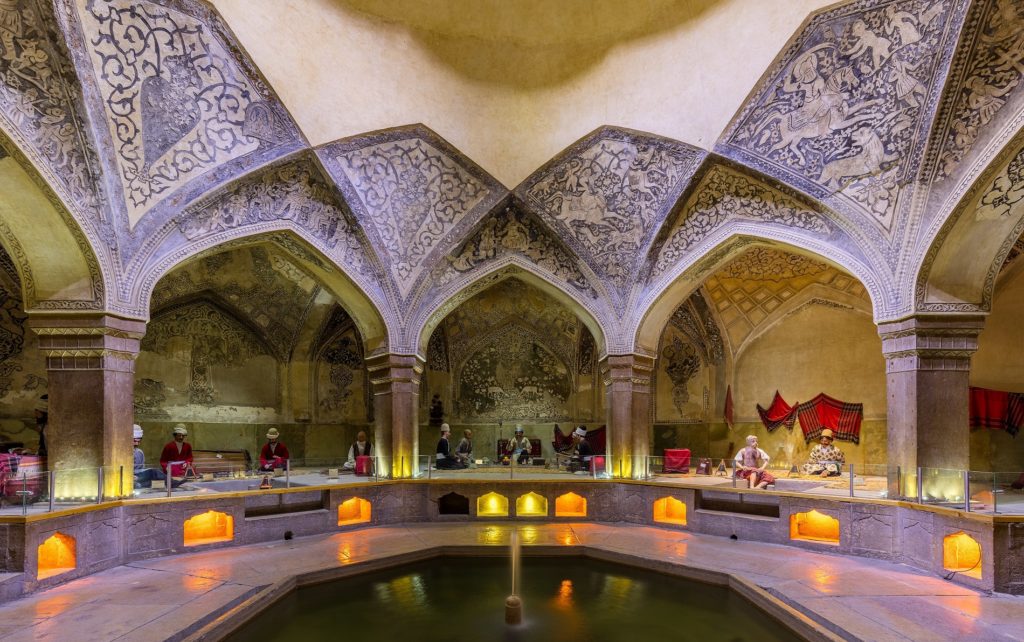
Older men often wear a beige, hemispherical felt cap with a tall upturned rim, while women cover their immense skirts and glittering lurex tabards with black chadors ; both caps and skirts are made in the bazaar. Many of these families still retain a migratory lifestyle, travelling with goats and sheep from Hamadan to Shiraz and the south in late autumn, returning in the spring, but some are now at least partially settled in outlying villages.
If you wish to see the rugs and carpets associated with such clans, the Shiraz bazaar is a good place to look, but prices are no longer low and quality is variable since such work was highly acclaimed in the West during the 1976 World of Islam exhibitions in the UK.
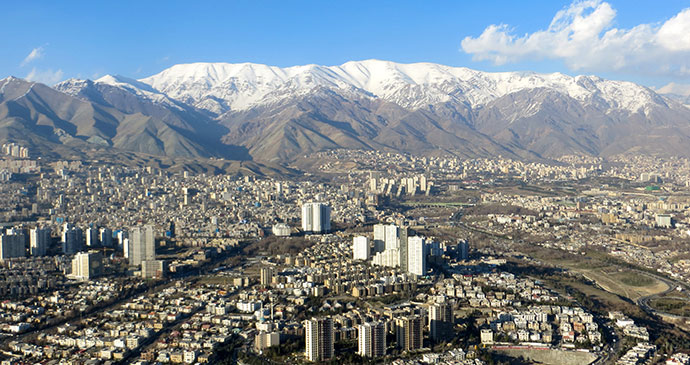
Looking at the sprawl of modern Tehran spreading up into the Alborz foothills, it is difficult to believe that before 1795, when it became the Qajar capital, it was an insignificant village ‘possess[ing] nothing, not even a single building, worthy of notice’ (Thomas Herbert, 1627). Then, there were unimpeded views of Mount Damavand and the Alborz. As of the 2011 census the population of Tehran is over 12 million, which is approximately one-sixth of the country’s total figure.
While population growth in Iran from 2006 until 2011 has only been around 1.3%, the general urbanisation rate has now passed 70%, which may suggest further growth of the capital as more people from the villages are moving here in search of employment. Currently Tehran accounts for more than half of the country’s economic activity and is set to grow further. The inner areas of the city are home to around 50 colleges and universities, making it the most dynamic student city in the country.
Many tourists shun Tehran and proceed directly to the historical south, but the Iranian capital is a wonderfully diverse and vast city with a vibrant café culture and pleasant parks scattered around the city perimeter.
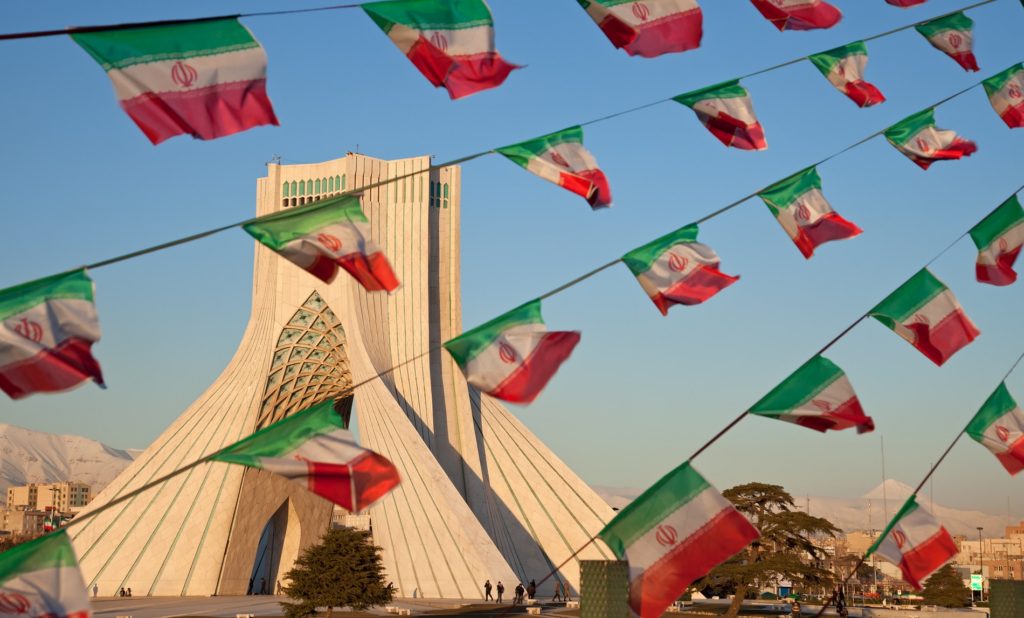
If visiting Tehran before and around Nou Rouz , you will be pleasantly surprised by light traffic, fresh air and flower blossom aromas at the city’s largest Mahallati flower market, selling more than five million flowers every day. While its southern parts (around Golestan Palace) offer, or rather conceal from the general view, a vast range of historic monuments, the upper affluent northern Tehran (Alborz foothills) is the place for an evening stroll or weekend mountain hiking (Tochal).
It is easier to get around if you think of Tehran, as one never-ending Vali Asr Street and everything else springing from it, like branches from a tree.
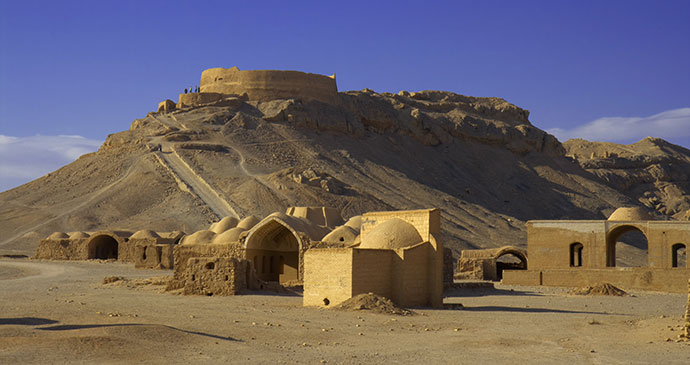
The town has long been associated with Zoroastrianism, and the production of textiles. It fell to the Arab invaders in 642ce but the Zoroastrian community was strong here until the late 17th century. There were still plenty of adherents left in the 19th century, when official persecution caused many to flee to India or to Tehran , where the presence of foreign diplomatic missions offered more protection.
Today, Zoroastrians form less than 10% of the town’s population, mainly located in the Posht-e Khan Ali quarter. When Marco Polo visited in 1272, noting its fine textiles and its strategic location on trade routes from India and central Asia, this ‘Good and Noble city’ was walled, but undoubtedly today he would get hopelessly lost in the confusion of ring roads and roundabouts.
Today Yazd is one of the most tourist-friendly cities in Iran, and offers excellent souvenir-shopping opportunities. Look through the workshops selling handwoven silk cloth termeh, produced solely in Yazd. Traditional hotels are abundant and conveniently located in the old town centre, while many tourists and backpackers use the City as their base to explore nearby desert dunes. Yazd is also known as the hosseiniyeh of Iran, the centre of the Imam Hossein commemorative celebrations in the country.
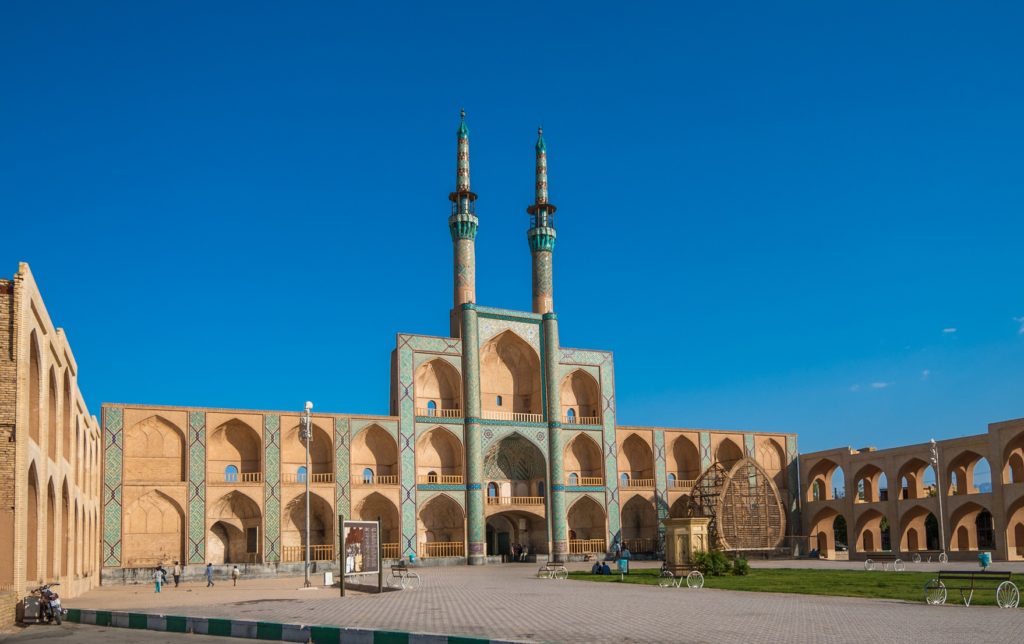
Although it does not possess any royal monuments like those at Persepolis, Shiraz and Esfahan, Yazd is renowned for its vernacular buildings, including ice houses, water cisterns (ab anbars), domestic houses and spectacular wind towers (badgirs) – of which Yazd boasts one of the tallest in the world.
Two dakhmeh (Zoroastrian ‘towers of silence’) are situated a little south of town. In accordance with Zoroastrian laws governing the sanctity of earth, fire, air and water, in Achaemenid times the dead were exposed and their bones later gathered to be placed in ossuaries or tombs in rock.
But in later centuries large circular stone walls were built on rock and the bodies of Zoroastrian men, women and children were placed on their designated, paved zone on the open stone platform inside. Sadly, the local authorities have turned a blind eye to vandalism of these buildings, which only serves to fuel foreigners’ negative perceptions of religious tolerance in modern Iran.
Related books
For more information, see our guide to Iran :
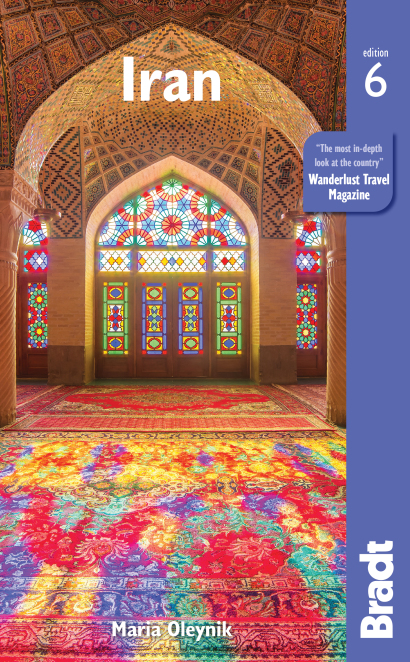
Related articles
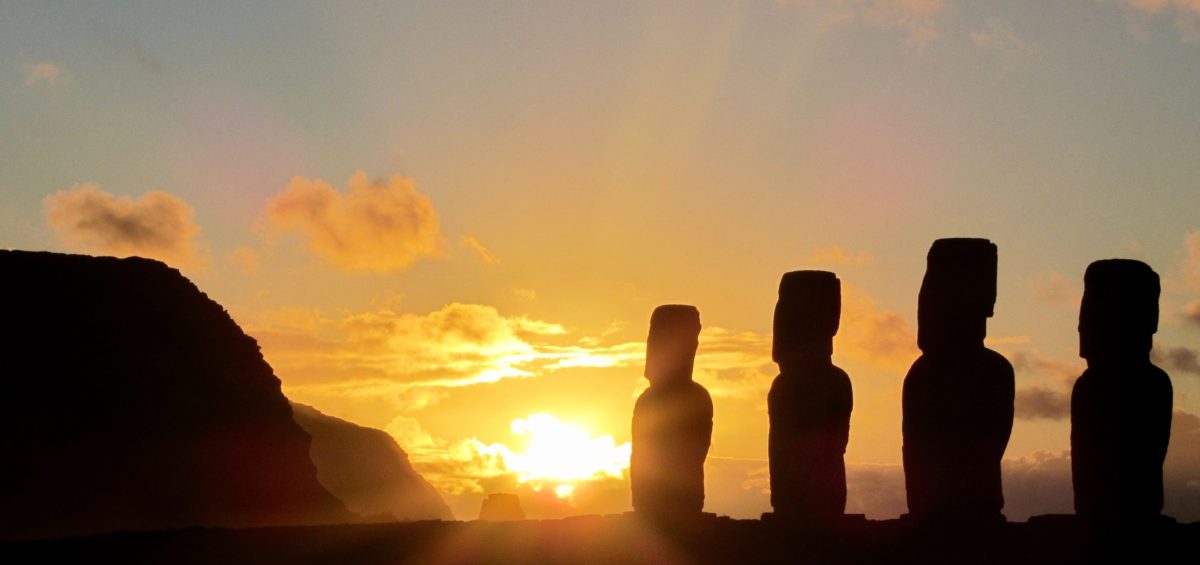
9 lost cities of the world
From crumbling Persian empires to colossal Roman cities, here are some of our favourite ruined civilisations from around the world.
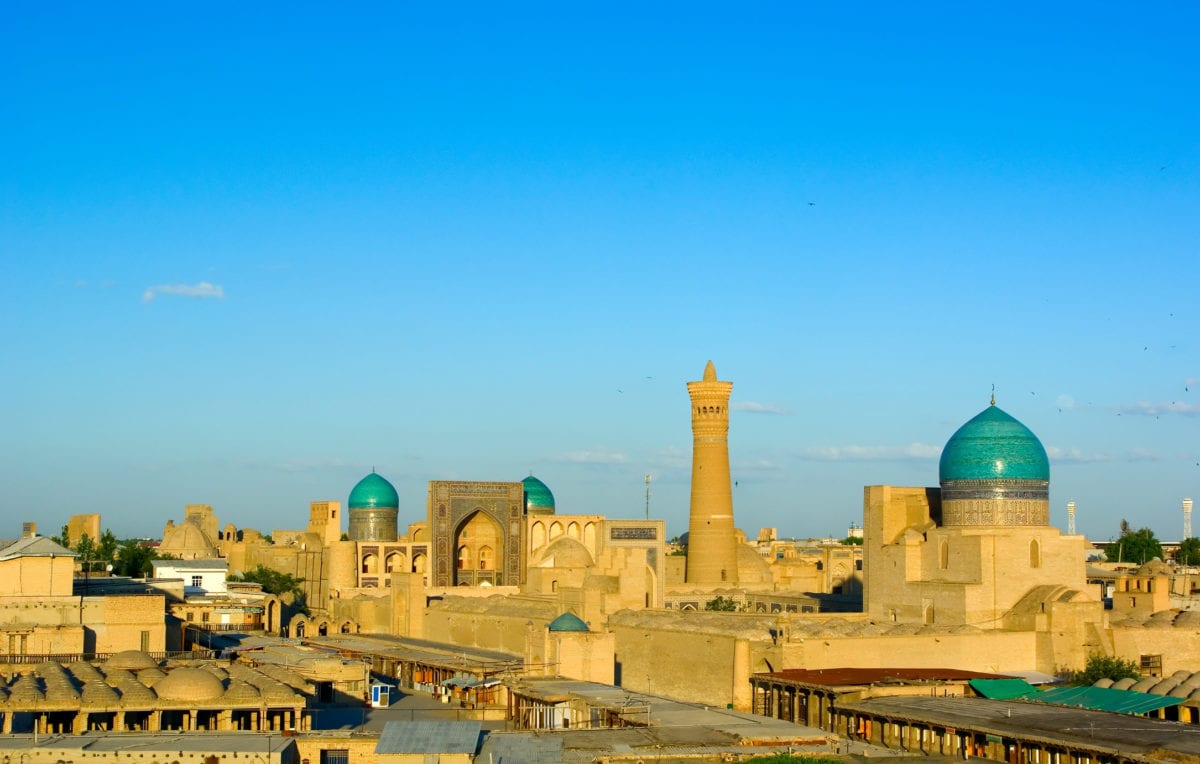
Mosques, mausoleums and madrasas: our favourite Silk Road sights
Discover our favourite sights along one of the most important trading routes in history.
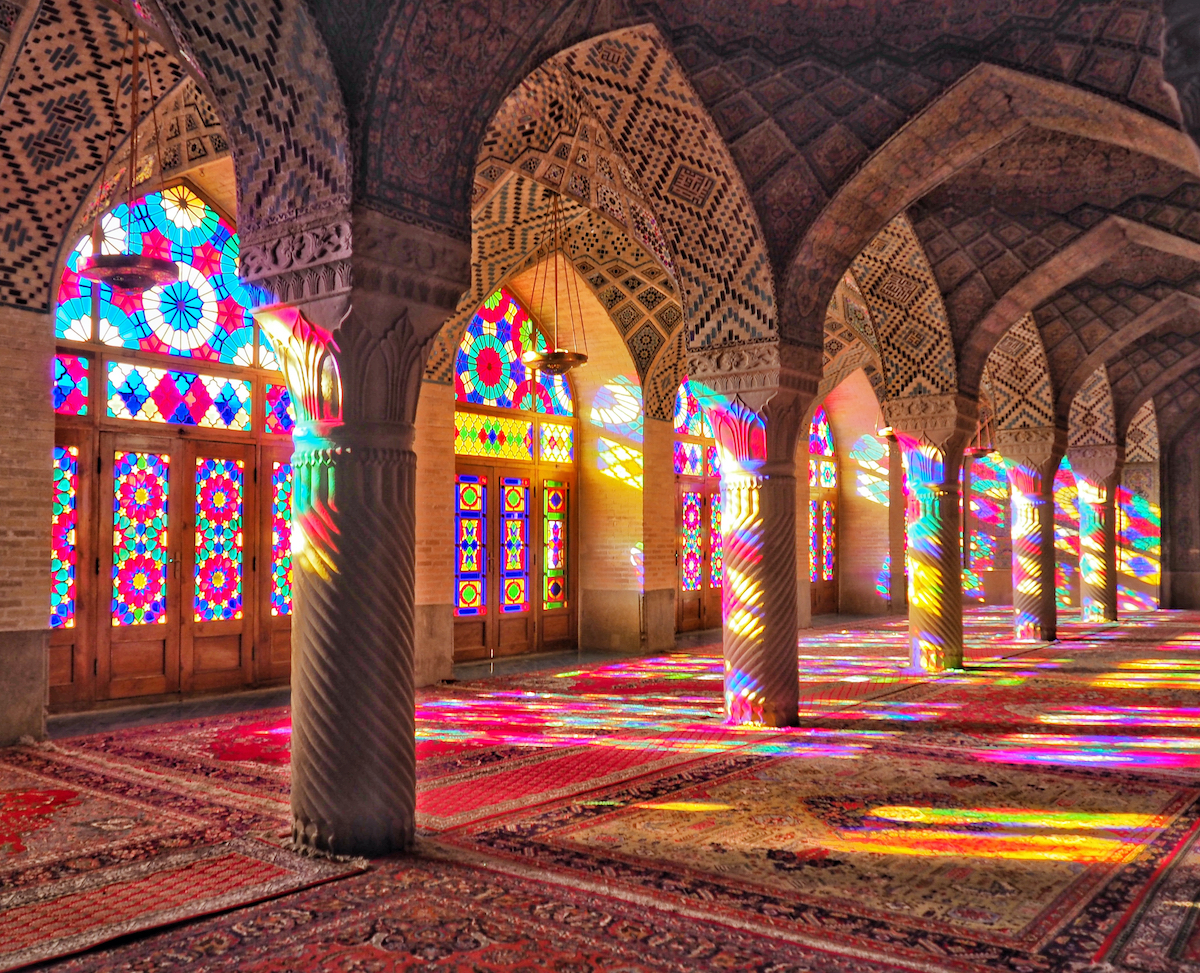
Brighten up your day with the world’s most colourful places
Sit back and enjoy this kaleidoscope of colours.
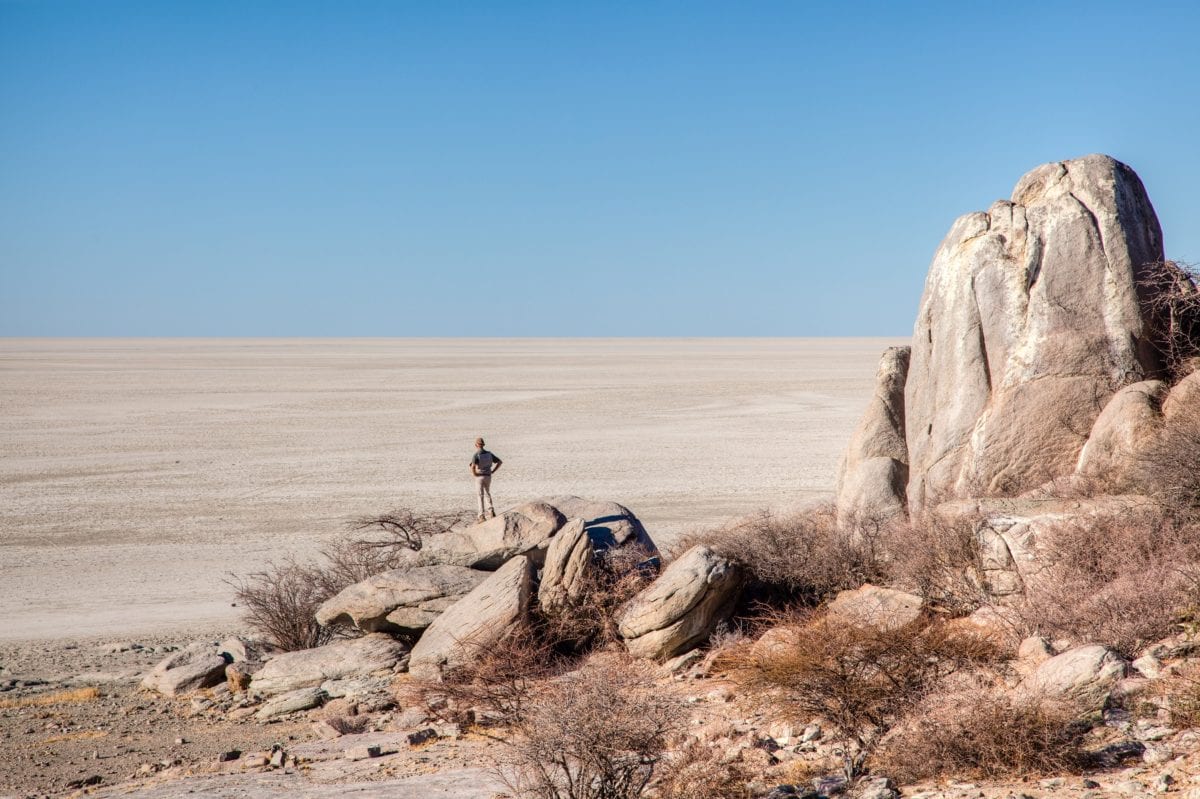
The world’s most impressive geological features
Marble caves, salt lakes and rainbow mountains.
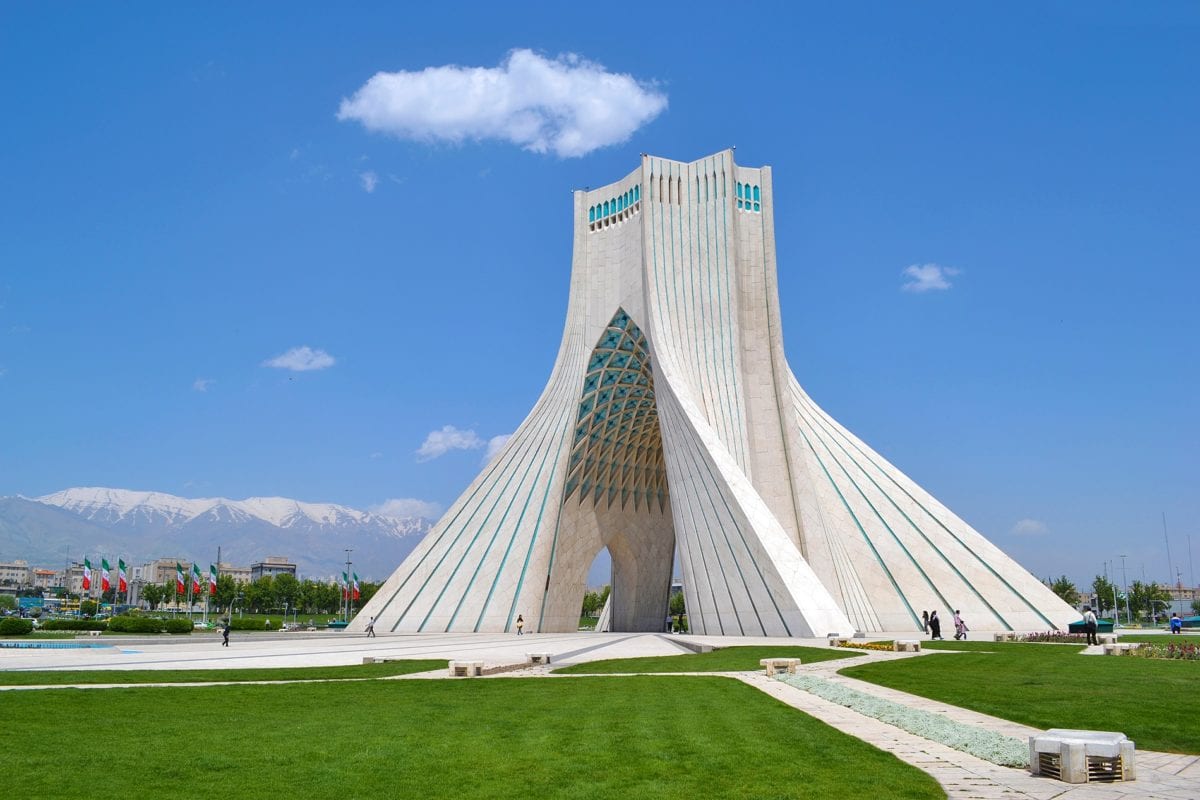
Lockdown in Iran: Meanwhile in Tehran
In the time of corona, Iran is one of the most heavily affected countries in the world.
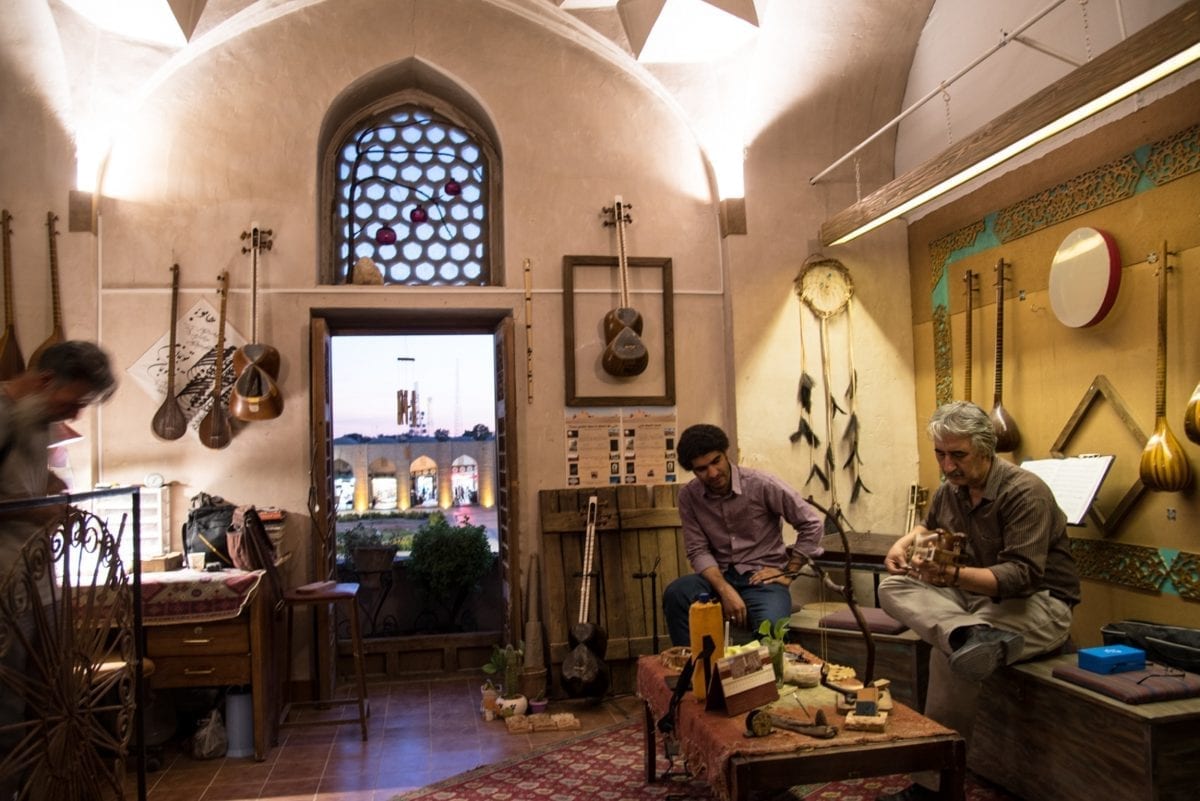
Lockdown in Iran: Meanwhile in Kerman
The first thing that made me think of travelling to Iran was hearing traditional Persian music on the Swiss radio.
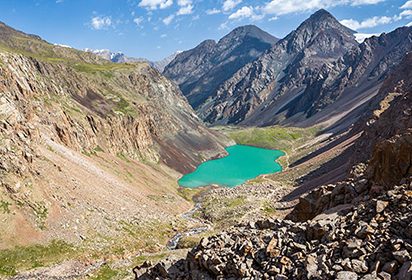
The hottest emerging destinations for 2019
We’re proud to be the only travel publisher with guidebooks to your favourite emerging destinations.
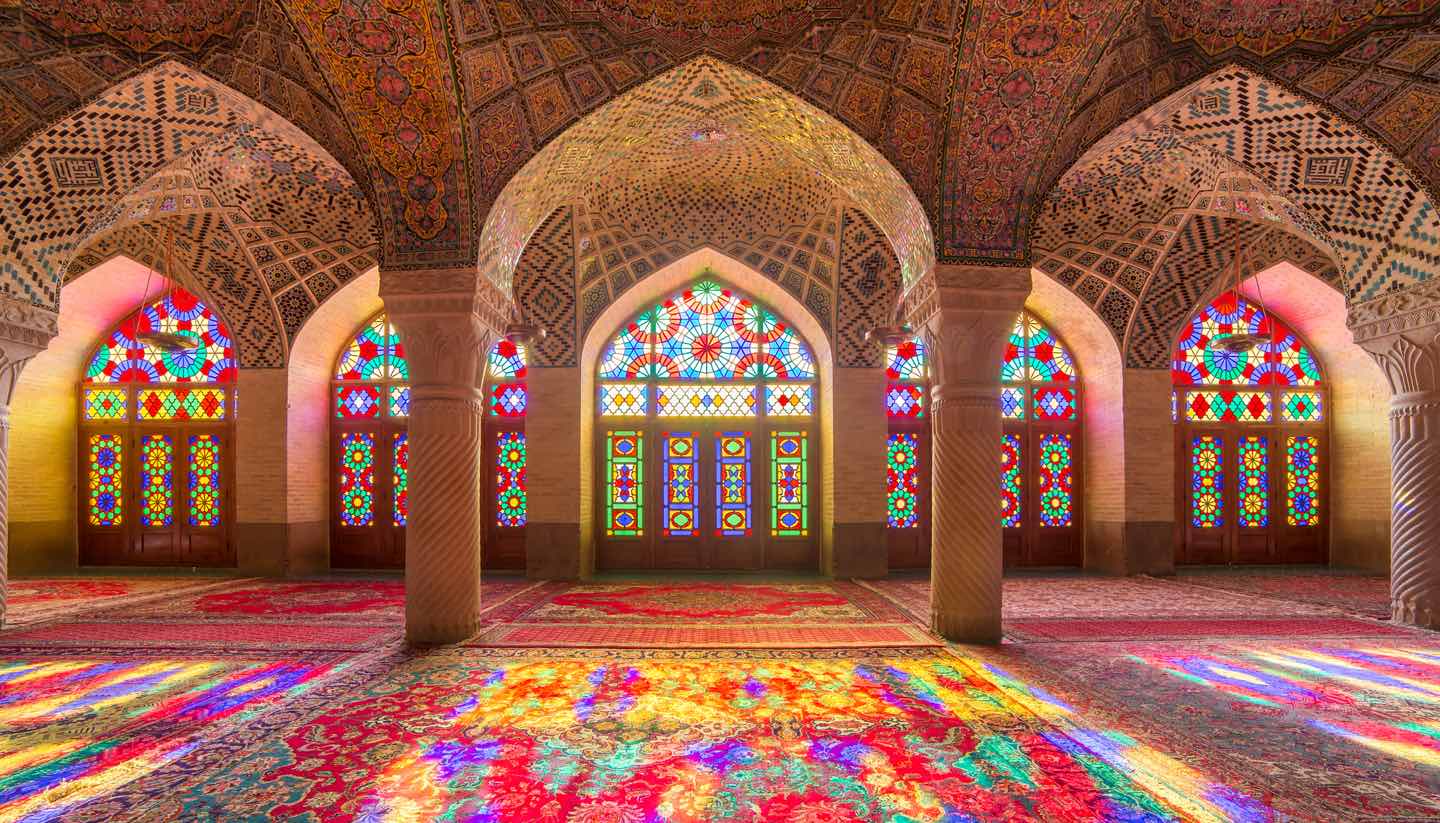
Introducing Iran
- Images of Iran
- History, language & culture
- Weather & geography
- Doing business & staying in touch
Plan your trip
- Travel to Iran
- Where to stay
While you’re there
- Things to see & do
- Shopping & nightlife
- Food & drink
- Getting around
Before you go
- Passport & visa
- Public Holidays
- Money & duty free
Book your flights
- Tehran Imam Khomeini International Airport
Iran travel guide
Iran ought to be one of the world’s most treasured travel destinations, blessed as it is with extraordinary historical sites, exquisite landscapes and a fascinating culture. But international tensions and a tough domestic regime have prevented that from being the case – it has remained a destination for the intrepid.
Things are changing, though. Since the election of a moderate president in 2013 and the gradual thawing of relations with the West, this once out-of-bounds country has started to open up. No one’s pretending that its current leadership can’t be shockingly hard-fisted in matters of civic law. But most foreigners are likely to find their preconceptions shattered. They will find Iranians warm and friendly, keen to practice their English and quick with the tea invites.
Rich Persian heritage dating back 3,000 years is evident throughout the country. Historical sights like the ancient ruins of Persepolis and the still-glorious former capital of Isfahan are abundant. Iran has a distinct cultural identity too, with its predominately Shia-Muslim population, which sets it apart from most nations in the Islamic world.
Parts of the country are very conservative, but Tehran will strike many visitors as extremely modern. Despite the image perpetuated of religious dogma, in the capital women walk around in skinny jeans and make-up, while couples openly hold hands. There’s a lively café culture and a youth culture comparable to Mediterranean countries. Persian cuisine can be sampled in countless traditional and more contemporary restaurants.
Ancient Persia has the potential to attract millions of tourists per year, but it's the modern reforming Iran that could be of as much interest. Flashpoint travel advice should be heeded and tourists still won’t be flocking to the country on a whim. But those who do travel will find street-level Iran to be almost unrecognisable from the Iran making headlines around much of the world.
1,648,195 sq km (636,371 sq miles).
81,801,633 (UN estimate July 2016).
50 per sq km.
Islamic Republic.
Supreme Leader Grand Ayatollah Ali Hosseini Khamenei since 1989.
President Ebrahim Raisi since 2021.
Travel Advice
The Foreign, Commonwealth & Development Office ( FCDO ) provides advice about risks of travel to help British nationals make informed decisions. Find out more about FCDO travel advice .
FCDO advises against all travel to Iran
Your travel insurance could be invalidated if you travel against FCDO advice. Consular support is also severely limited where FCDO advises against travel.
If you’re a British national already in Iran, either resident or visitor, carefully consider your presence there and the risks you take by staying.
FCDO advises against all travel to Iran. British and British-Iranian dual nationals are at significant risk of arbitrary arrest, questioning or detention in Iran. Holding a British passport can be reason enough for the Iranian authorities to question you. If you are detained in Iran, you could face months or years in prison.
Find out more about why FCDO advises against travel .
Risks to British nationals in Iran
Consular support is extremely limited in Iran. If you need consular assistance you should contact the British Embassy in Tehran .
FCDO advises against all travel to Iran. British and British-Iranian dual nationals are at significant risk of arbitrary arrest, questioning or detention in Iran. Holding a British passport can be reason enough for the Iranian authorities to question you. If you are detained in Iran, you could face months or years in prison.
Find out more about why FCDO advises against travel
Dual nationals
The Iranian authorities do not recognise dual nationality. If you are a British-Iranian dual national and you are detained in Iran, the authorities will not tell FCDO or grant FCDO access to see you. If you are detained, your case will be in the hands of the Iranian authorities, who have shown a pattern of hostility towards the UK and British citizens.
Before you travel
FCDO advises against all travel to Iran.
No travel can be guaranteed safe. Read all the advice in this guide as well as support for British nationals abroad which includes:
- advice on preparing for travel abroad and reducing risks
- information for women, LGBT+ and disabled travellers
Follow and contact FCDO travel on Twitter , Facebook and Instagram . You can also sign up to get email notifications when this advice is updated.
Travel insurance
If you choose to travel, research your destinations and get appropriate travel insurance . Insurance should cover your itinerary, planned activities and expenses in an emergency.
This advice reflects the UK government’s understanding of current rules for people travelling on a full ‘British citizen’ passport from the UK, for the most common types of travel.
The authorities in Iran set and enforce entry rules. If you’re not sure how these requirements apply to you, contact the Iranian Embassy in the UK .
COVID-19 rules
There are no COVID-19 testing or vaccination requirements for travellers entering Iran.
Passport validity requirements
If you visit Iran against FCDO advice, your passport should be valid for a minimum of 6 months from the date you arrive. It’s not possible for British nationals or dual nationals to apply for a UK passport in Iran.
Check with your travel provider to make sure your passport and other travel documents meet their requirements. Renew your passport if you need to.
You will be denied entry if you do not have a valid travel document or try to use a passport that has been reported lost or stolen.
Previous travel to Israel
If your passport has stamps from Israel or other countries’ border crossing points with Israel, you may be refused entry to Iran.
Visa requirements
You need a visa to enter Iran as a visitor.
Check the expiry date of your visa before travelling. If you overstay your visa, you may have to stay in Iran until this is resolved and you are at risk of being detained.
Women and girls aged 10 or over should wear a headscarf in their visa application photos.
If you’re travelling through an Iranian airport, check visa requirements with your airline and the Iranian Embassy in the UK .
Applying for a visa
If you choose to travel to Iran against FCDO advice, apply for a visa well in advance of your travel. The application process for an Iranian visa can be long and unpredictable.
If you want to travel to Iran with a British passport, the Iranian Embassy has told FCDO that to get a visa you must either apply as part of an organised tour, or have a sponsor in Iran. Check with the Iranian Embassy in the UK for more information.
Some British nationals have had problems getting visas from private online visa agencies.
Your passport must be valid for at least 6 months from the date you submit your visa application.
Vaccination requirements
At least 8 weeks before your trip, check the vaccinations and certificates you need in TravelHealthPro’s Iran guide .
Dual nationality
Iran does not recognise dual nationality. Dual nationals are considered Iranian nationals by Iranian authorities. All Iranian nationals must travel to and from Iran using an Iranian passport.
You may also be required to demonstrate to the Iranian airport authorities that you have the right to enter the UK. You must be able to produce your British passport or a valid UK visa in your Iranian passport on request.
Holding a British passport can be reason enough for the Iranian authorities to question you. The Iranian authorities have shown a pattern of hostility towards the UK and its citizens.
Being considered an Iranian national
Even if you do not consider yourself Iranian, you may be seen as an Iranian national by Iranian authorities. For example, if your father is Iranian, or if you’re married to an Iranian man.
Customs rules
There are strict rules about goods that can be brought into and taken out of Iran. You must declare anything that may be prohibited or subject to tax or duty.
Pork products
Importing pork products is illegal.
Children travelling without a male parent
In Iran, a female parent travelling with her children must have the father’s permission, usually verbal, to take them out of Iran. This is assumed to be the case by Iranian immigration authorities unless the father has petitioned the court, or the court has ruled to prevent the children travelling. For more information, contact the Iranian Embassy in the UK .
Kish Island
To enter Kish Island, you must arrange your visit through an Iranian travel agency. The agency must:
- inform the Iranian Ministry of Foreign Affairs about your visit at least 2 weeks before you travel
- have received confirmation that a visa will be issued on arrival
The nearest Iranian embassy or consulate can give you advice and a list of registered travel agents.
You must also have a hotel reservation before you travel. Your guide must:
- pass a copy of the hotel reservation confirmation to the Immigration Office at Kish Airport at least 48 hours before you arrive
- meet you at the airport when you arrive
Travellers have occasionally been denied entry to Kish without explanation. If you’re denied entry, follow the advice of your airline or travel agent.
Terrorism
There is a high threat of terrorist attack globally affecting UK interests and British nationals, including from groups and individuals who view the UK and British nationals as targets. Stay aware of your surroundings at all times.
UK Counter Terrorism Policing has information and advice on staying safe abroad and what to do in the event of a terrorist attack. Find out how to reduce your risk from terrorism while abroad .
Terrorism in Iran
Terrorists are very likely to try and carry out attacks in Iran.
Terrorist attacks could be indiscriminate, including in places frequented by foreigners. Stay aware of your surroundings, keep up to date with local media reports and follow the advice of local authorities.
Previous attacks include:
- in April 2024, 11 Iranian security force members were killed, following attacks claimed by Jaish al-Adl on an Iranian military site in the southeastern province of Sistan-o-Balochistan
- in January 2024, at least 84 people were killed and more than 200 wounded in suicide bombing attacks in Kerman, southern Iran, carried out by Islamic State Khorasan Province (ISKP)
- on 13 August, 2023, one person was killed and 8 wounded in a terrorist attack at a Shia Muslim shrine in the Iranian city of Shiraz, southern Iran
- in 2022, 15 people were killed at a holy site in Shiraz
Military activity in the Red Sea area
Military activity is currently underway in response to attempts by Houthi militants to prevent movement of international shipping in the Red Sea. While the area of activity is limited to the Red Sea and Yemen, there is a possibility that Travel Advice for nearby countries could change at short notice. You should continue to monitor Travel Advice and follow any relevant instructions from local authorities.
Political situation
There is tension in the region. Any military action could escalate quickly and could pose risks for the wider region. If you are in the region, or considering travel to the region, monitor news updates and continue to check FCDO travel advice for updates.
FCDO advises against all travel to Iran. If you’re a British national already in Iran, either resident or visitor, carefully consider your presence there and the risks you take by staying.
FCDO ’s ability to provide consular assistance is extremely limited in Iran. In an emergency, for example if there is serious violence, unrest or a deterioration in the security situation, it is extremely unlikely that the British government will able to evacuate you or provide face-to-face assistance in Iran. In these situations, it may become more difficult to leave safely. Air, sea and land routes are under the control of the Iranian authorities.
Assume that no face-to-face consular assistance will be possible in an emergency situation and that the British government will not be able to help you if you get into difficulty in Iran.
Arbitrary arrest and detention
There is a very high risk of arbitrary arrest, questioning or detention for British nationals and British-Iranian dual nationals. Holding a British passport can be reason enough for the authorities to question you. If you’re detained in Iran, you could face months or years of imprisonment.
If you’re a British-Iranian dual national and you are detained in Iran, the authorities will not tell FCDO or grant FCDO access to see you. FCDO may also not be able to visit you to provide consular support for long periods.
British-Iranian dual nationals have been arbitrarily detained in Iran and made to serve long prison sentences. In January 2023, a British national was executed after receiving the death penalty. Iran has arrested and detained non-Iranian European nationals travelling on tourist visas. The criminal justice process in these cases falls below international standards.
If you’re detained in Iran your case will be in the hands of the Iranian authorities, who show a pattern of hostility towards the UK and its citizens. As a result, consular assistance to British nationals in Iran is extremely limited.
Iranian authorities have accused people with links to the UK of inciting protests. If you are in or near a protest, you are at serious risk of arrest. Mass arrests, including of bystanders, happen often. It is difficult to predict where protests will take place, and they may turn violent. British nationals arrested in connection with protests may come under added suspicion of espionage or working to undermine the Iranian government. This can increase the risk of lengthy detention, criminal charges or receiving the death penalty.
You may also come under suspicion if you are near sensitive sites, have contact with Iranians who are of interest to the authorities for any reason, or are taking photographs.
Even if you avoid protests and crowds, there is still a very high risk of arbitrary arrest, questioning or detention. In all cases of detention, FCDO has serious concerns that the judicial process falls below international standards.
Links to the UK
While having British connections can be reason enough for the authorities to be suspicious of your activities, you are at even greater risk if you are involved in:
- civil societies (including labour unions, human rights groups or political activist groups)
- journalism
- any organisation perceived as anti-Iranian (either within Iran or elsewhere)
- any institution based in the UK that receives public funds from or which have perceived links to, the British government
- historic or current social media activism related to protest movements in Iran
You are more at risk during times of terrorist incidents, national unrest, or when there is an increase in tensions between Iran and the international community.
Border areas
Border areas are sensitive. FCDO advises all British nationals already residing in Iran against all travel:
- within 100km of the Iran-Afghanistan border
- within 10km of the entire Iran-Iraq border
- to the provinces of Sistan and Baluchistan
- to the area east of Bam and Jask, including Bam
There is risk of banditry in the area east of Bam, Jask, and Sistan and Baluchistan. This is the main route for drug traffickers from Afghanistan and Pakistan. The towns of Zahedan, Zabol and Mirjaveh are particularly insecure.
Some Iranian officials and media reports have falsely alleged a UK connection to anti-government groups in Khuzestan, Kurdish-majority regions, and Sistan and Baluchistan. If you travel to these areas against our advice, stick to the main routes to avoid accidentally entering restricted or military zones.
Take sensible precautions to protect yourself from street crime and petty theft. Avoid carrying large amounts of money and keep your passport safe.
There have been some attacks and robberies targeted at foreigners and tourists, including attempted robberies by thieves posing as policemen, usually in civilian clothing. If you’re approached by anyone who claims to be a policeman, ask to see ID and request the presence of a uniformed officer or marked patrol car. Do not hand over documents or cash, or get into a vehicle.
Getting cash in Iran is extremely difficult. Non-Iranian debit and cash cards will not work in Iran. It’s usually not possible to change travellers cheques.
It’s illegal to change money on the street. You can exchange selected foreign currencies in some exchange bureaux, though you may have problems changing money. Euros and US dollars are more commonly accepted than British pounds.
Find out before travelling how you will get enough Iranian rials for your visit legally. If you cannot, you may need to reconsider your travel plans.
Surrogacy and adoption
If you’re visiting Iran to arrange an international surrogacy or adoption, consider the risks and challenges involved. Surrogacy is a complex, lengthy process. You should:
- make sure you’re aware of the facts and well-prepared before starting the process
- get specialist legal advice on Iranian and UK laws before making any arrangements
- read FCDO and Home Office guidance on surrogacy overseas
- research clinics and hospitals thoroughly to make sure they are safe and reputable
The British Embassy cannot get involved in surrogacy arrangements or recommend hospitals or clinics.
Commissioning a surrogacy will not automatically mean that the child holds British citizenship. To bring your child born through surrogacy from Iran to the UK, you must apply for a full British passport . You need an Iranian birth certificate for this. It’s not possible for British nationals or dual nationals to apply for a UK passport in Iran.
Laws and cultural differences
Ramadan is a holy month for Muslims. The dates vary by year and country. During this time, do not eat, drink, smoke or chew gum in public in the daytime, including in your car.
You should also:
- check opening hours of shops and restaurants
- be aware that if hotels and restaurants are providing food or drink in fasting hours, they may separate you from Islamic guests, for example with screens
- be aware that fasting can cause tiredness, particularly during the later afternoon and early evening
- be patient and show tolerance
Get more advice when you arrive from your tour guide, hotel or business contacts.
Dress codes
Islamic codes of behaviour and dress are strictly enforced. In public places women must cover their heads with a headscarf, wear trousers or a floor-length skirt, and a long-sleeved tunic or coat that reaches to mid-thigh or knee. Men should wear long trousers and long-sleeved shirts in public.
There are extra dress requirements at religious sites. Women may be asked to put on a chador (a garment that covers the whole body except the face) before entering.
Relationships between men and women
Adultery and sex outside marriage are illegal under Iranian law and carry the death penalty.
Relationships between non-Muslim men and Muslim women are illegal, although few Westerners have been prosecuted. If a Muslim woman is found in a relationship with a non-Muslim man, she may be sentenced to be whipped.
Unmarried partners and friends of the opposite sex travelling together should exercise extreme caution. Sex outside marriage and same-sex relations are against the law in Iran, with the death penalty as the defined punishment.
Iranian hotel managers could insist on seeing a marriage certificate before allowing couples to share a hotel room.
LGBT+ relationships
Same-sex relationships are illegal under Iranian law and can carry the death penalty.
Read more advice for LGBT+ travellers .
Female travellers
Women should take extra care, particularly when travelling alone or with friends of the opposite sex. Women face a range of issues, from enforced hijab wearing to harassment due to there being relatively few foreign women in Iran. Respect local customs and avoid isolated areas. See more advice for women travelling abroad .
Films and magazines
Many western streaming services including Netflix and Prime are illegal.
It is illegal to import, sell, manufacture or drink alcohol in Iran. This is on religious grounds, with exceptions only for certain recognised Iranian religious minorities. Drinking alcohol in public is not allowed, with no exceptions. Penalties can be severe.
Photography
Photography near military and other government installations is strictly prohibited. You can be detained and charged with breaking national security laws. Sensitive government buildings and facilities are often difficult to identify. Take extreme care when taking photographs in any area.
Using a laptop or other electronic equipment in public places can be misinterpreted, especially if it contains photographs. You may be arrested and detained on serious criminal charges, including espionage. It’s better to ask before taking photographs of people.
Illegal drugs
It is illegal to import, sell, manufacture or consume drugs in Iran. Penalties for importing and possessing drugs are severe and enforced. Many people convicted of drug offences, including foreign nationals, have been executed.
Personal ID
You must carry copies of your passport photo page and visa for identification. Make sure you have a copy of the emergency contact details.
Satellite phones and drones
You need permission from the Iranian authorities to import or use equipment like drones or satellite phones. Using them without permission is illegal and you could be arrested.
Mobile phones, internet access and communications
Iranian authorities have blocked, significantly slowed or shut down landline, internet and mobile services without warning in the past. This can be nationwide or localised. This can affect communication and location services on smartphones and other devices. You should:
- not rely on mobile data, non-Iranian mobile apps or international calls for personal safety
- always keep an alternative means of communication and navigation with you
- make sure friends and family know where you are
Business travellers
Individuals involved in commercial disputes with Iranian companies risk being stopped from leaving the country until disputes are resolved.
Representatives of British or western companies may receive particular attention. British businesspeople travelling to Iran should take steps to protect commercially sensitive information, including password protection of electronic devices and not carrying unnecessary information. Electronic devices may be screened by customs officials on arrival and departure.
Transport risks
Road travel .
You need a 1968 international driving permit ( IDP ) when using a UK driving licence to drive in Iran. You cannot buy an IDP outside the UK, so get one before you travel.
If you’re planning to drive in Iran, see information on driving abroad .
Iran has a high rate of road accidents. Take great care when travelling by car or public transport and when crossing streets. If you’re involved in an accident, no matter how minor, do not leave the scene. Wait until the police arrive to write their report.
Iranian authorities sometimes set up informal roadblocks both in cities and on main highways. These are often staffed by young and inexperienced officers. Always carry identification with you and avoid getting into disputes.
It is not widely accepted for women to drive motorbikes on public roads and there is a risk of being arrested.
Motorcycle taxis should not be used as they have sometimes taken tourists to quiet locations and robbed them.
Pre-booked taxis are safer than taxis hailed from the street.
Air travel
The UK Air Safety List (ASL) lists all known airlines in Iran that do not meet international safety standards and are banned from operating commercial air services to, from, and within the UK. Check the UK Air Safety List when considering which airlines to fly with. The list is maintained by the Department for Transport, based on advice from the UK Civil Aviation Authority .
Sea travel
Many areas of the Caspian Sea, Persian Gulf and Gulf of Oman are very politically and militarily sensitive, with increased military activity including seizures and attempted seizures, boardings and harassment of maritime vessels.
The waters around the islands of Abu Musa and the Tunbs in the southern Persian Gulf are particularly sensitive. British national mariners should not dock or sail into waters around these islands.
When in the region, maintain a high state of awareness and be alert to local and regional tensions which may affect your route. Vessels may be at increased risk of maritime attack and harassment if they operate in the:
- Gulf of Oman
- Northern Arabian Sea
- Persian Gulf
- Strait of Hormuz
Commercial vessels have been attacked by unmanned aerial vehicles (commonly referred to as military drones) off the coast of Oman, with one attack in 2021 resulting in the deaths of a British and Romanian national. Vessels have also been seized in and around the Gulf of Oman and the Strait of Hormuz in recent years resulting in detention of the vessels and crew.
If your vessel is hailed, provide the vessel name, flag state, and confirm they are exercising navigation rights and proceeding in accordance with international law, as reflected in the UNCLOS Convention. Vessels and mariners should maintain high levels of awareness when they are operating in the area and report into UKMTO. They should document footage of all incidents wherever possible.
Extreme weather and natural disasters
Earthquakes .
Many parts of Iran are at risk of earthquakes and tremors. These can be high magnitude, cause damage to infrastructure, and put lives at risk.
Read the US Federal Emergency Management Agency advice on what to do before, during and after an earthquake .
Some provinces can suffer from floods in spring, particularly:
You should:
- follow advice given by local authorities
- be adequately equipped with waterproofs, thermals, hiking boots and rations when driving and walking
Before you travel check that:
- your destination can provide the healthcare you may need
- you have appropriate travel insurance for local treatment or unexpected medical evacuation
This is particularly important if you have a health condition or are pregnant.
Emergency medical number
Dial 115 and ask for an ambulance.
Contact your insurance company promptly if you’re referred to a medical facility for treatment.
Vaccinations and health risks
At least 8 weeks before your trip check:
- the latest information on vaccinations and health risks in TravelHealthPro’s Iran guide
- where to get vaccines and whether you have to pay on the NHS travel vaccinations page
Medication
The legal status and regulation of some medicines prescribed or bought in the UK can be different in other countries.
Read best practice when travelling with medicines on TravelHealthPro .
Healthcare facilities in Iran
In general, medical facilities in Iran are reasonable in the major cities but poor in remote areas. Many health professionals speak some English.
In 2022 there were shortages of some basic medicines in Iran.
If you’re a British national in Iran having medical or cosmetic treatment, you may not get adequate care in an emergency.
FCDO has a list of English-speaking doctors in Iran .
Travel and mental health
Read FCDO guidance on travel and mental health . There is also mental health guidance on TravelHealthPro .
The Foreign, Commonwealth & Development Office ( FCDO ) cannot provide tailored advice for individual trips. Read this travel advice and carry out your own research before deciding whether to travel.
Emergency services in Iran
Ambulance: 115
Police: 110
Contact your travel provider and insurer
Contact your travel provider and your insurer if you are involved in a serious incident or emergency abroad. They will tell you if they can help and what you need to do.
Refunds and changes to travel
For refunds or changes to travel, contact your travel provider. You may also be able to make a claim through insurance. However, insurers usually require you to talk to your travel provider first.
Find out more about changing or cancelling travel plans , including:
- where to get advice if you are in a dispute with a provider
- how to access previous versions of travel advice to support a claim
Support from FCDO
FCDO has guidance on staying safe and what to do if you need help or support abroad, including:
- finding English-speaking lawyers , funeral directors and translators and interpreters in Iran
- dealing with a death in Iran
- being arrested
- getting help if you’re a victim of crime
- what to do if you’re in hospital
- if you’re affected by a crisis , such as a terrorist attack
Contacting FCDO
Follow and contact FCDO travel on Twitter , Facebook and Instagram . You can also sign up to get email notifications when this travel advice is updated.
Help abroad in an emergency
If you’re in Iran and you need emergency help from the UK government, contact the British Embassy in Tehran .
You can also contact FCDO online .
FCDO in London
You can call FCDO in London if you need urgent help because something has happened to a friend or relative abroad.
Telephone: 020 7008 5000 (24 hours)
Find out about call charges

Book a Hotel
© Columbus Travel Media Ltd. All rights reserved 2024

25 Things to Know Before You Visit Iran
- Last Updated: February 6, 2024
We’ve been all around the world, spent a lot of time in a lot of different countries, and if there’s one thing we can honestly tell you it’s that we’ve never felt as welcomed, fascinated and humbled as we did when we visited Iran.
Iran is such an incredible country to travel. The architecture will amaze you, the friendliness of the people will leave you speechless, the culture is fascinating and the landscapes are out of this world.
Iran is also very misunderstood, with many people believing whatever propaganda they hear on the media about how dangerous or difficult it is to travel there.
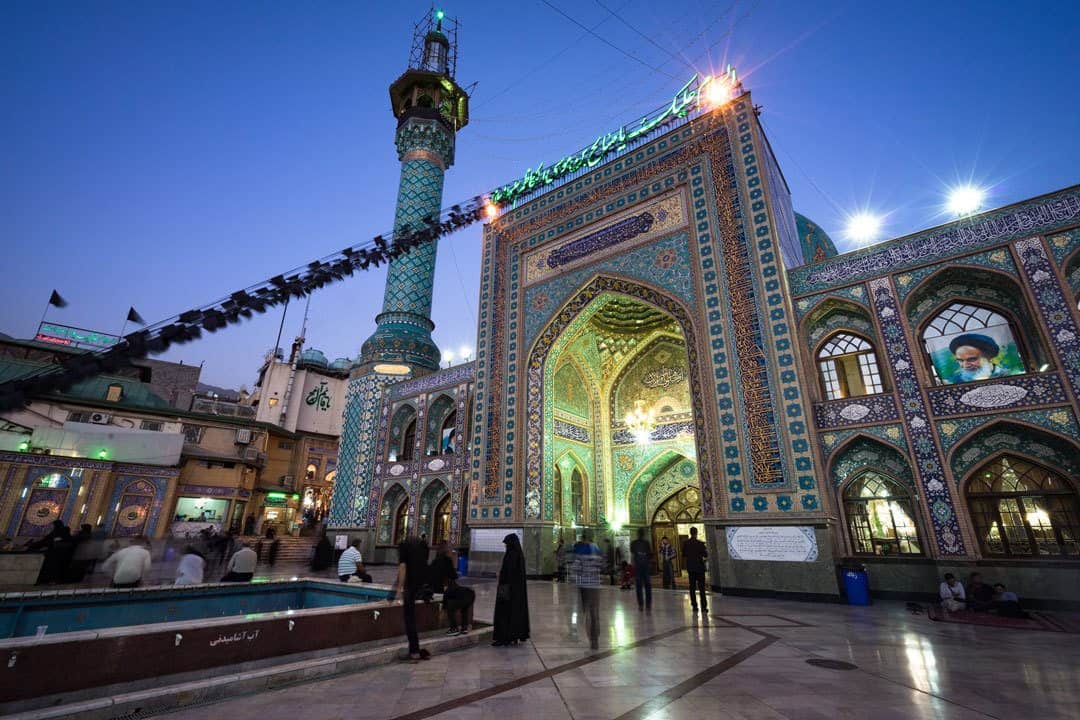
Table of Contents
Iran is Safe!
There’s a lot of customs to follow, you need a visa for iran, have a head scarf in your carry-on luggage before arrival, bring a phrase book or have google translate on your phone, bring a lot of cash, the currency has two names, bring comfortable footwear, research the food and don’t just eat kebabs, bring a backpack rather than a suitcase, draw up an itinerary, but keep it flexible, let your guard down and talk to locals, always ask the price before buying, book domestic flights with your accommodation or travel agent, team up with other travellers and share tours, be on time for your appointments, the traffic is horrible, you need a vpn to access some social media platforms, there is wifi, but be patient with it, pick up a local sim card, iran has its own uber called snapp, you can drink the tap water, good coffee is hard to find, there’s a female-only carriage on the metros, what to know before you visit iran.
The truth is travelling in Iran definitely has its quirks, and being an Islamic country means there’s a few things you need to know about the religion and culture before you go so you can show absolute respect.
Luckily these are easy enough to know before you go if you do a bit of research. We spent one month travelling around Iran and learnt so much during our time there.
To help put your mind at ease about travelling in this incredible country, here’s our list of the most important things to know before you visit Iran.
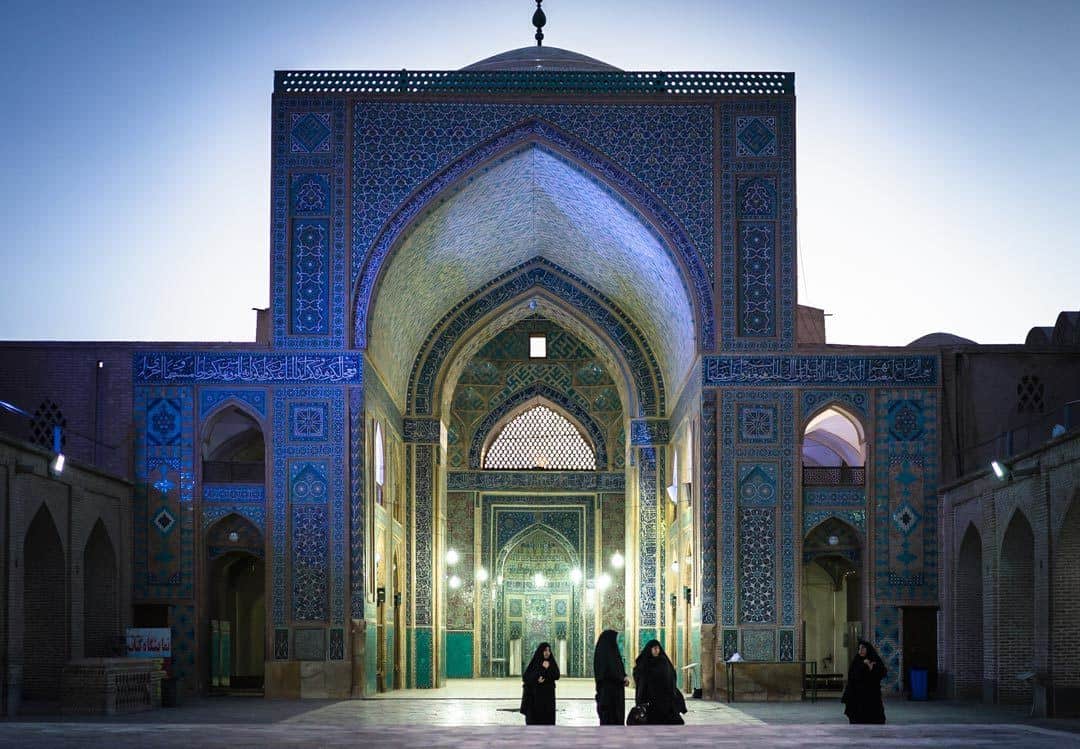
All of the mainstream media outlets portray Iran as an unsafe country, somewhere that you’ll be at risk if you visit.
The mainstream media is wrong.
We did not feel unsafe once through the whole 4 weeks of us backpacking independently in Iran.
We weren’t with a tour group, had no tour guides, don’t speak the local language, took public transport and taxis, wandered the streets on our own – basically everything you shouldn’t do if you’re in a dangerous country.
And guess what? Nothing bad happened to us at all!
The Iranian people are so friendly and helpful. They want you to have a great time and tell your friends so more people will come and visit.
We were walking around one morning on a quiet street when a car passed us and turned around. A group of young people stopped the car, came up to us, and asked if we were ok or if we needed help.
Once we told them we were just looking for a coffee they pulled out their phones and started showing us where the cafes were on a map.
They even offered us a ride, and said if the cafes were closed they had coffee at their home and would love to make us some.
This is just one example of dozens of interactions that happened to us when we were in Iran. Iranians love that tourists are coming to their country and travelling around.
The locals know what the media says about them and what a lot of the world thinks of their country, and the people just want to show that they are nice, generous people.
Theft against tourists is very rare and even the Religion Police (secret police) tend to leave tourists alone.
Just be careful around the bazaars and crowed places for pickpocketing. We didn’t have any issue and didn’t hear of any other travellers having problems, but this is common sense in any busy place in the world.
With all that being said, there is a large military and police presence in Iran. Do not photograph any military areas or government buildings, and stay away from any protests if you see them.
Obviously there are some areas of Iran that are no-go zones, such as the borders of Afghanistan, Pakistan and Iraq, so do your research and talk to locals if you’re thinking about going anywhere near them.
When you travel somewhere you want to take in everything about the country and its people, and that includes the culture and customs.
Iran has quite a few local customs that may take some getting used to, so it’s important to learn about them before you go so you don’t accidentally offend or disrespect anyone.
Some of the most common ones that throw tourists off are:
- Women must wear hijabs (headscarves) at all times in public. They must also wear loose-fitting clothes that don’t show their figure.
- Giving a thumbs-up sign is considered rude, similar to giving the middle finger in Western society.
- Men can wear short-sleeved shirts, but long pants must be worn at all times.
- Men and women who aren’t related shouldn’t touch either. That means no shaking hands or hugging someone of the opposite sex.
- If you are travelling with your significant other, avoid any public displays of affection.
- Always bring a gift if you are invited to someone’s house. Candy, pastries or flowers are fine.
Now we want to give a special mention to ta’arof – This is a hospitality trait where it’s customary for someone to refuse payment for a service, and is probably the most confusing thing for any tourist to get their head around.
Basically what happens is if you make a purchase (a souvenir, taxi ride, etc), the person may refuse your payment out of politeness. It is then up to you to insist despite their refusals that you want to pay. After two or three times they’ll then accept your money.
If they still keep refusing then perhaps you have just experienced some amazing Iranian hospitality! But chances are they’ll accept the payment once the process has been completed. Don’t worry, you’ll get the hang of it.
The locals are so lovely, that if you do something wrong someone will approach you and nicely let you know. For example, if you are a lady and your headscarf falls off without you knowing, a local will kindly let you know.
Don’t stress about getting your outfits beforehand as shopping in Iran is cheap. Just bring one headscarf and set of loose-fitting clothes, and buy more once you get there.
The culture is the best thing about visiting Iran, and after a few days, you’ll start to understand and fall in love with it just like we did.
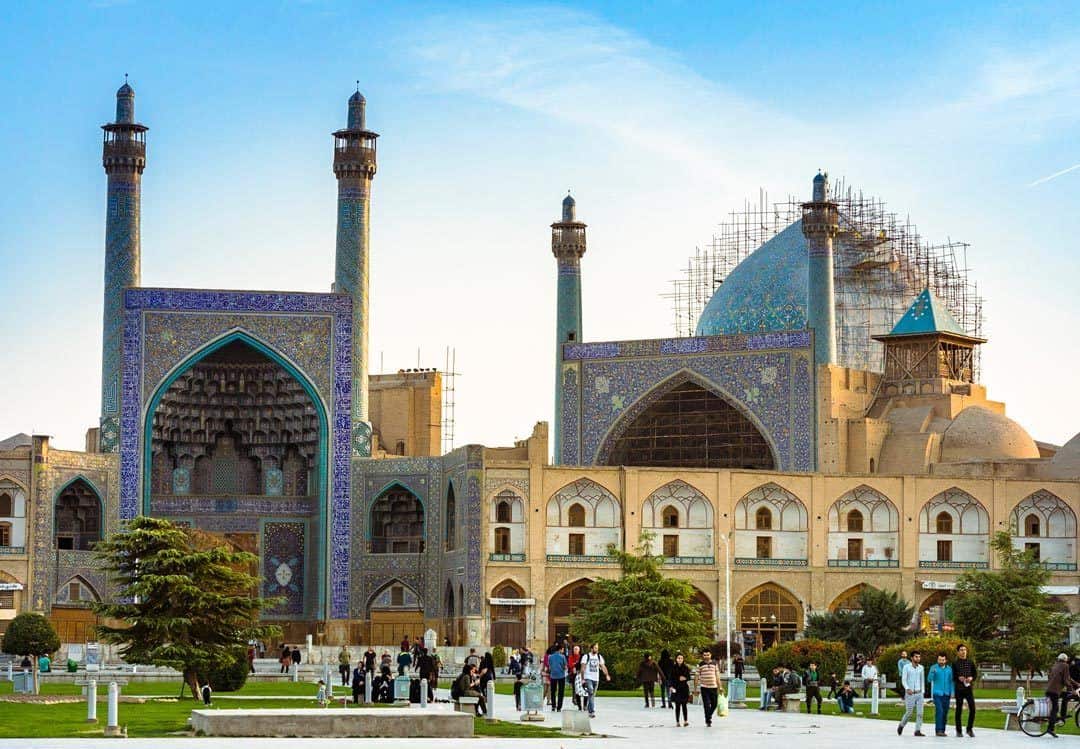
In order to visit Iran, you’re going to need to get a tourist visa. This used to be a very difficult process, but luckily things have gotten easier with the introduction of visa on arrivals in 2016
On the 14th February 2016, the Ministry of Iran announced that citizens of 180 countries can now apply for VOA of 30-days at most international airports, including Tehran, Shiraz, Mashad, Tabriz and Isfahan.
There’s an exception to this rule though, and if you are from Canada, the UK or the USA, we have some bad news for you…You can only visit Iran if you join a guided tour, so no chance of getting a VOA and travelling independently.
Your tour company will help organise your visa for you.
Check out our article on how to apply for a Visa On Arrival in Iran.
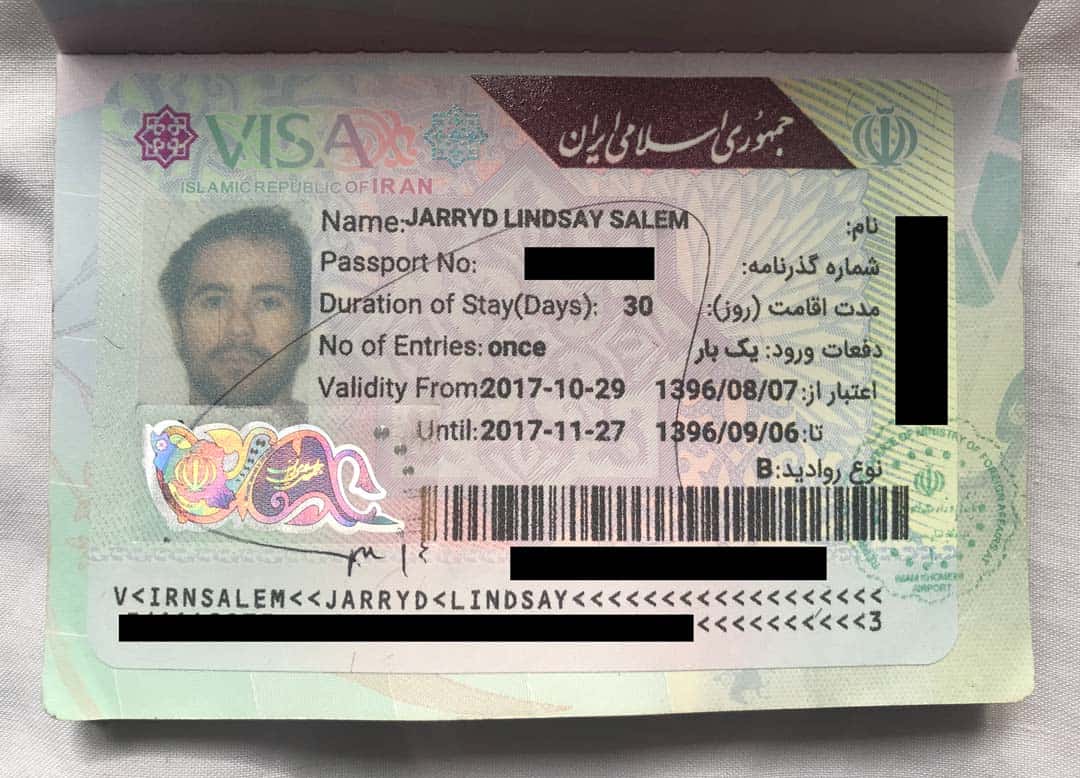

You Need to Dress Appropriately
This follows on from the customs section above, but in a bit more detail.
Iran is an Islamic country, and as such you need to follow the Islamic dress code. Here are some things to keep in mind.
Women need to cover their arms, legs and head. This including a Hijab, loose long length shirt with long sleeves and pants.
Leggings or tight jeans are ok as long as your top is long and covers your bottom. When wearing pants, you need to be covered down to your ankles.
The most common way to cover your head is with a scarf. The local women wear bright colours and are very stylish with their clothing, so don’t think you need to wear all black.
Black is still worn a lot but not so much among the younger generation.
You can wear sandals. Some guesthouses and hostels will allow you to take your headscarf off on their premises but do check first.
Men aren’t allowed to wear shorts in public, so bring long, lightweight pants as the best option. T-shirts are fine to wear in public. Men can wear sandals too.
If you do wear inappropriate clothing it’s not the end of the world, and besides some angry looks from some of the older generation, you’ll probably just end up having a friendly local let you know what’s best to wear.
In Tehran, the locals push the limits in terms of what they wear in public. At the end of 2017, an uprising occurred and supposedly women were no longer required to wear the Hijab in public in Tehran, but wait until you are in the country to find out for certain.
When you land at the airport, it is respectful to put a scarf straight on your head ladies. This will cause no trouble for you by locals or the officials at the airport.
Once you’re in the air on an international flight you’ll see most young ladies take their hijab as soon as the plane leaves the ground. Just follow what the locals do.
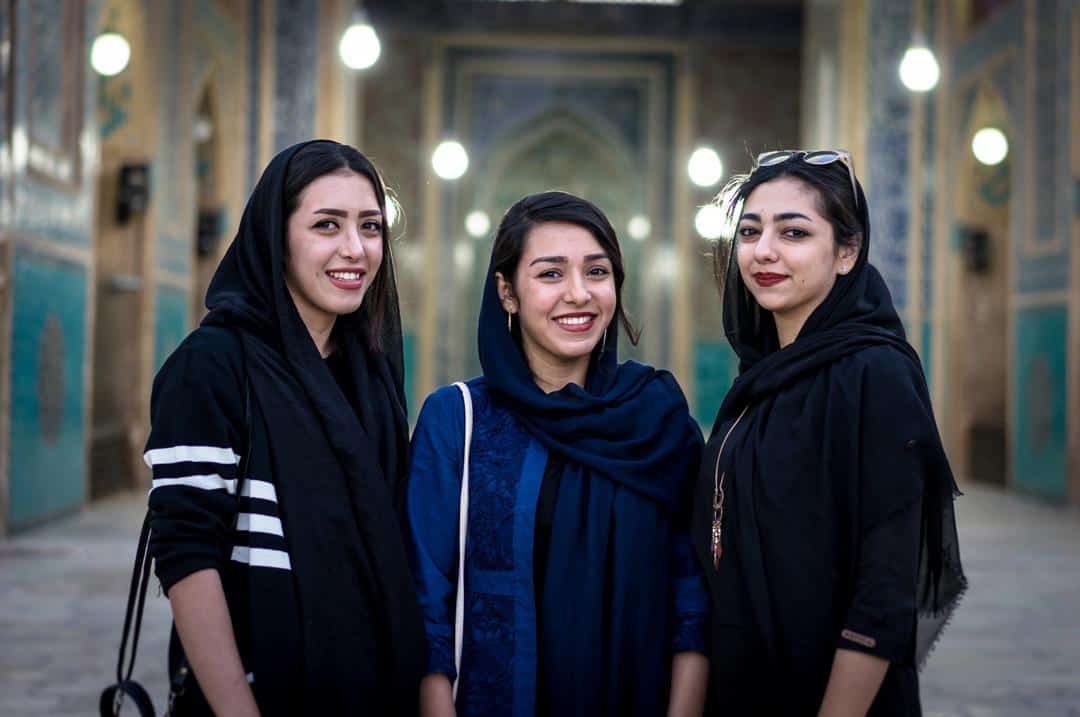
We were quite surprised to discover that a lot of Iranians could speak a little bit of English, but that wasn’t always the case, so do yourself a favour and bring along something that can help translate English to Persian.
We always travel with Google Translate and offline languages saved on our phones, but at times having a phrasebook is the best (and most social) way to interact with people who don’t speak any English.
Remember, you are in a country that doesn’t have English as an official language, so don’t be that rude tourist that gets upset if people aren’t understanding you.
Persian (Farsi) is difficult, and no locals expect you to learn much beyond hello and thank you while you are there, but do your best anyway as a few extra words will go a long way in showing respect.
Also don’t be surprised if you are constantly invited out for tea with people so they can practice their English. If the opportunity comes up, make time for it, as it’s an amazing experience for both the local and yourself.
Don’t forget your cash when visiting Iran, as none of the ATMs in the country accepts foreign credit or debit cards thanks to the embargo. So if you forget to bring all of your cash for your entire trip, you’re out of luck.
Figure out what your usual budget is for a trip ($50 a day, $100 a day, etc), then bring a bit extra just in case. USD is best for all around the country but Euros and British Pounds are also accepted in Tehran.
There’s two exchange rates in the country – official rate and black market rate – and the black market rate is of course much better.
We actually found an exchange booth at Tehran airport that gave pretty close to the black market rate, so we traded some cash there.
As a tip don’t exchange all of your foreign cash into Rials at once, because you’ll either get ripped off on the exchange rate back if you have any left over, or you’ll be unable to trade it outside of the country.
Also don’t be too concerned about travelling around with thousands of dollars in your backpacks. As we mentioned earlier theft is rare. Do keep your money stashed in different spots though just in case.
UPDATE: If you’d prefer not to carry all your cash with you, can actually pre-order a local Iranian debit card from the company, Mah Card . It works just like a normal debit card in your home country.
You order it on their website and they’ll deliver it to your hotel in Tehran when you arrive. They have an online system too where you can top up the funds if you’re running low.
Use the code ‘ NOMADASAURUS ‘ at check-out to get a 40% discount on the card when ordering. Instead of a 19 Euro issue fee, our code brings it down to 11 Euro.
“Toman or Rial?” Get used to asking that question, because if you don’t it could end up being a costly mistake.
The currency in Iran is officially known as the Rial, and is valued at roughly 30’000 IRL to USD$1. That’s a lot of zeros, so what the locals have started doing is dropping a zero and calling the new value a Toman.
1 Toman = 10 Rial
When you hear prices quoted in Tomans you need to add a zero on the end and pay the amount in Rials. It sounds confusing, but you’ll pick it up pretty quickly.
That’s why it’s important to always ask Toman or Rial, so you don’t accidentally pay too much on an item. Most vendors quote in Tomans anyway, so chances are if the price seems too good to be true, you need to multiply it by 10.
Rumour has it that Iran will officially introduce Toman as a currency in the coming years, but that hasn’t come into effect yet.
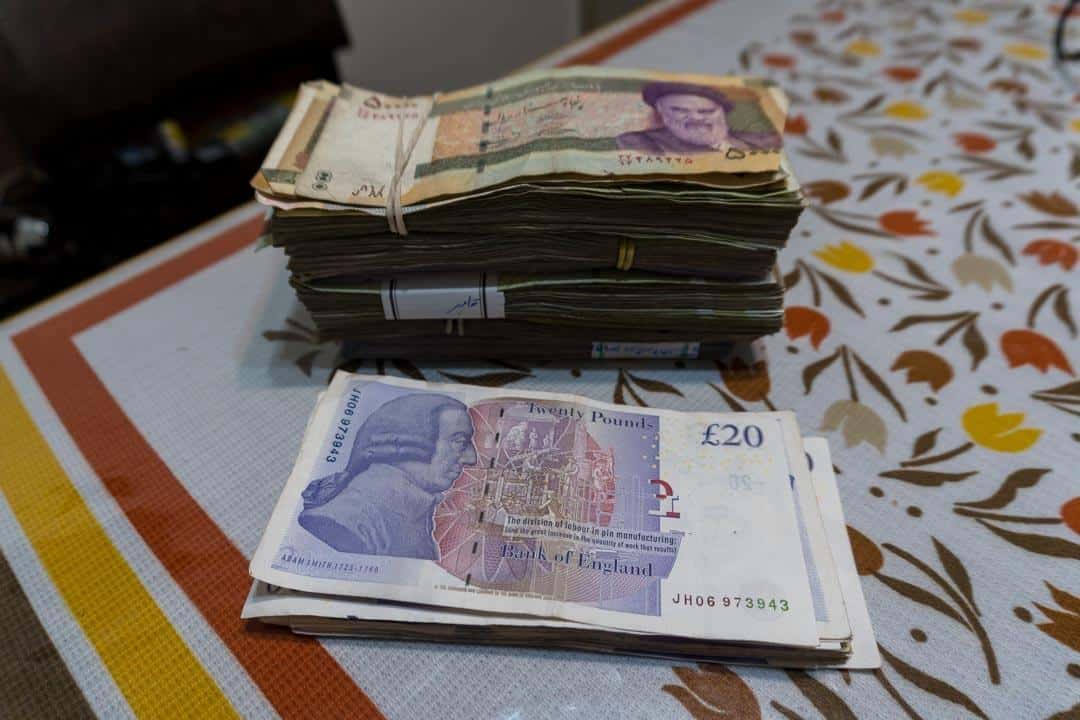
You are going to do a lot of walking in Iran, so bring comfortable footwear. The towns here are so amazing that you’ll probably end up walking at least 10km every day, so look after your feet.
These don’t necessarily have to be hiking boots (unless you’re planning on doing some treks). Just make sure you have some flat shoes that you can wear all day without a problem.
Don’t bring heels. You don’t need them, and you won’t wear them. We had a pair of hiking shoes each and a pair of sandals. That was perfect.
Persian food is varied and delicious, and there’s plenty of different styles to try, so be adventurous!
Most people travelling on a budget will end up eating falafel sandwiches when they’re in Iran because they are cheap ($1 !), filling and delicious, but there’s plenty more to Iranian cuisine then just kebabs.
We don’t consider ourselves to be foodies, but luckily we were travelling with our good friends Dan and John and they are all about culinary travel, so they had a huge list of food they wanted to try. And boy were we thankful they did!
They had looked up the different types of food they wanted to try, so we basically followed their advice and tried it all. Of course, it was super delicious too.
One particular dish we all loved was dizi. It’s quite confusing how to eat the first time, so we had the restaurant owner show us how to mix and grind all the ingredients. If she didn’t show us, we wouldn’t have a clue how to eat it.
If you are a vegetarian, there are food options but they can be limited. There is a lot of eggplant, lentil and chickpea dishes. There are simple salads and rice also.
Try to get away from the popular tourist areas as well, as the prices are going to be a lot higher than the average place.
Move away and you will be surprised how much the price drops, and the portions are larger. If you are passing a local restaurant and it is packed with locals, that is going to be a winner.
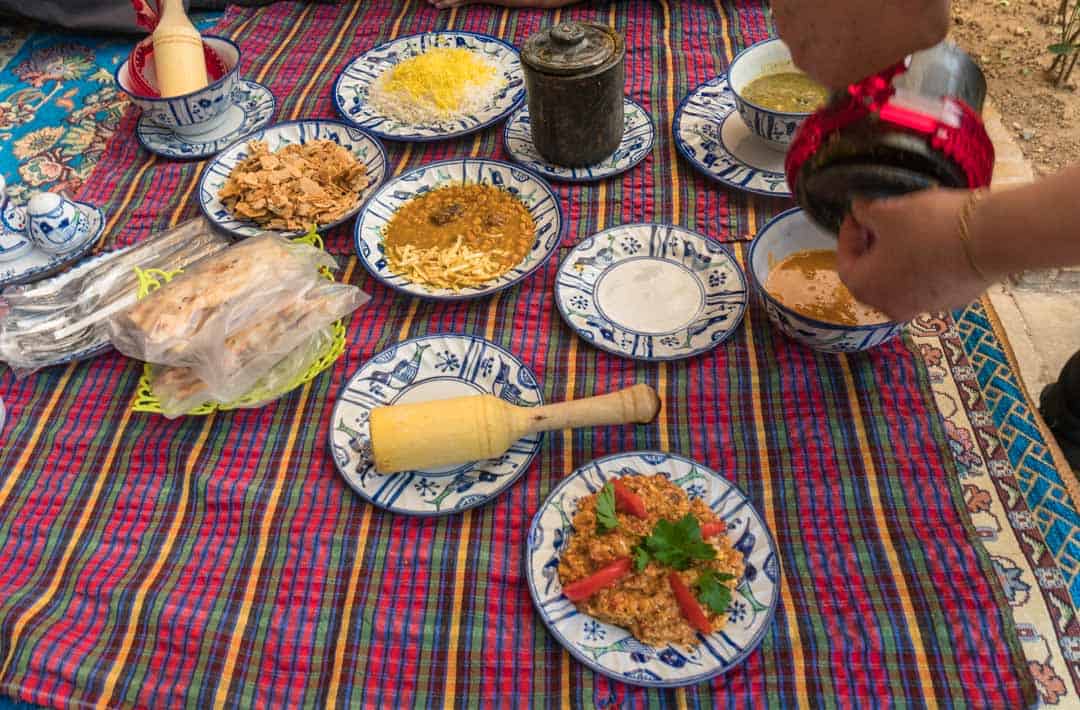
We always recommend people travel with a backpack rather than a suitcase, but this is especially useful when you visit Iran.
The road and paths are uneven, and wheeling a suitcase would be a nightmare. A lot of hotels don’t have lifts, so unless you’re feeling strong it’s going to be hard to carry your suitcase up a lot of flights of stairs.
Always choose a lightweight backpack that fits you perfectly for the best support.
There are also hybrid backpacks, that have harnesses and wheels on the bottom for the times where you just don’t want to carry it.
Unless you are on a whirlwind 7-day trip of the country we recommend you design an itinerary of what you want to see and do, but don’t book anything until you are in the country.
Iran is one of those countries that is best to research beforehand so you can make the most of your time and you don’t miss anything, but don’t be surprised if some places you end up liking more than others.
Be willing to change your plans if you get somewhere that you want to stay an extra day, or if you meet a backpacker that raves about one town you hadn’t considered before.
Don’t stress about booking buses, flights or trains before you arrive. Everything can be booked in-country, for a much cheaper price than you’ll find online.
By not locking in your travel plans, you can change and swap your itinerary easy enough.
Disclaimer: The one time that you may need to book everything ahead of time is during Nowruz, which is the Persian New Year. If you’re planning on travelling to Iran during this time (it happens around the spring equinox in March) you’ll find things are extremely busy with millions of locals travelling around the country to spend time with their families too.
Looking for somewhere else to check out when you visit Iran? Don’t miss our article on the best things to do in Shiraz!
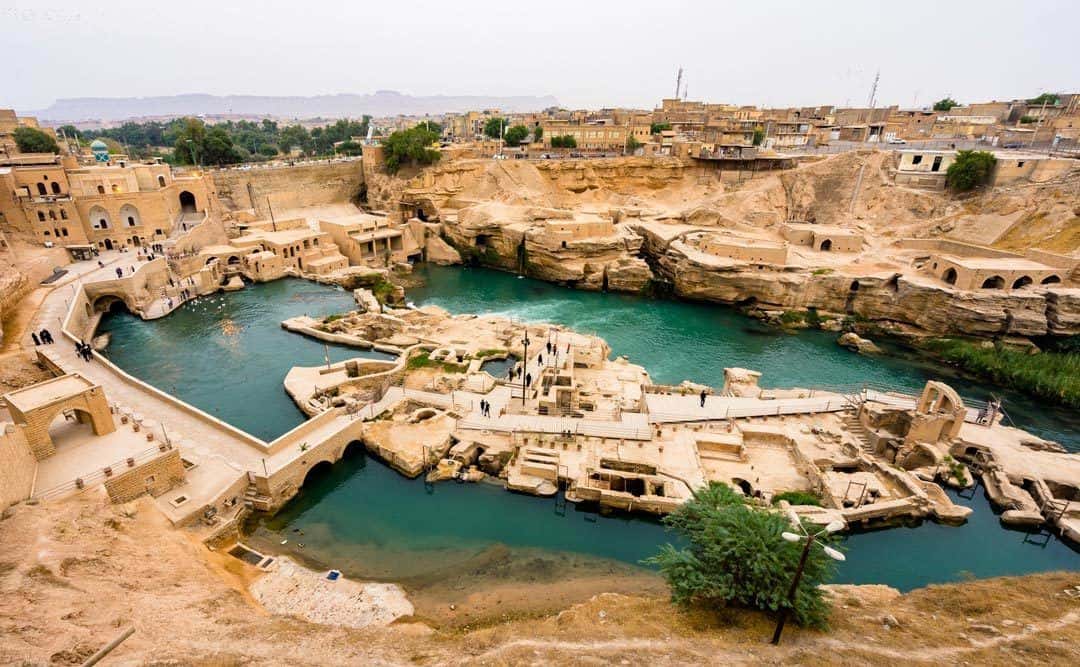
One of the best experiences you will have in Iran is spending time with all the friendly locals. And trust us, you’ll get plenty of opportunities if you are open to it.
The city squares are usually where locals will approach you to welcome you to their country, have a chat and practice their English.
Don’t shy away from this, even if you are a solo traveller. We found out so much information about Iran and how the locals live simply by chatting away.
Most people asked us questions about where we are from and were very happy to answer our questions. It was a true insight to Iran and we made some beautiful friends from it (many of whom we still keep in contact with).
Don’t be surprised if you get a lot of invitations to people’s homes as well, and this may be one of the few countries where we’d say hanging out with strangers is highly encouraged. The Couchsurfing scene is huge here too if you’re into that.
Do be wary of some people who will take you to an expensive tea house though. They are nice people, you will have great conversations, but they can be a little cheeky.
Also always look at the menu before you start ordering to make sure they haven’t taken you somewhere that has crazy prices.
Some will invite you out and try to sell carpets to you. If you are not interested just be firm and move on with the conversation.
We only had this happen to us once out of more than a dozen great experiences, and once we made it clear we weren’t buying a carpet we still had a great chat with him.
There is only one thing with all this – Expect to be stopped every few minutes by people wanting to chat! Make sure you’re mentally prepared when you go out around town to have a million friendly conversations.
You shouldn’t just do this in Iran, you should do this everywhere you travel, but it’s important to keep in mind.
In some countries, there are tourist prices and local prices. To be honest, we almost never felt ripped off here, but it did happen occasionally.
Before you buy anything, whether it’s a souvenir, a meal, a pot of tea, a tour, a taxi ride or whatever, ask to see the menu or how much it will cost to avoid any unpleasant surprises.
Get out of the tourist squares too. Chances are if you walk a couple of blocks outside of those popular areas, the prices will drop dramatically.
When buying survivors, ask the price at a few places, get the vibe from the person/place and then buy. Try your bartering skills, but don’t be offensive.
We always try to settle in the middle so both parties are happy. This is their business and they need the money more than you do.
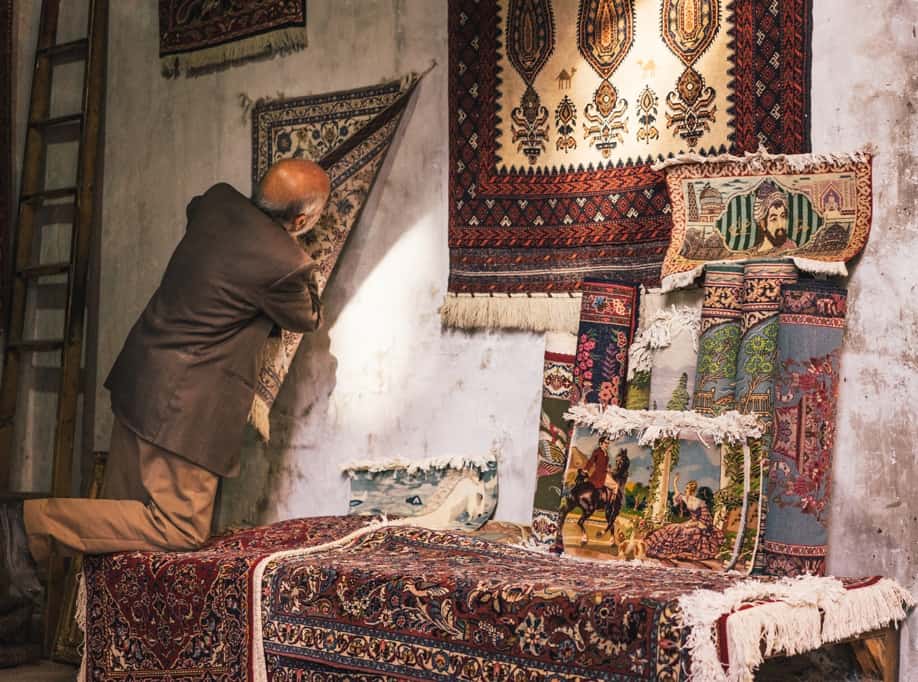
If you are flying domestic, book through an agent or your local guesthouse in the country. All the local airline pages are in Persian, and these are where the best deals are.
Online booking agencies like Skyscanner and Momondo will not bring up these flights. We were in the west near the Iraqi border and wanted to fly to Tehran. Our local guesthouse helped us out and we booked it for $50 USD including snack and bags.
They were charging $200 USD on one of those online booking agencies above. We never were questioned at the airport about the local price and everything went smoothly.
If you’re not travelling in a group of four, ask at your guesthouse or talk to other travellers to see if you can share the cost of a driver with them.
Sometimes hiring a driver between towns as private transport would work out to be the same price as 4 bus tickets. You get there faster and can stop when you like along the way.
This will save you money and you might even make some awesome friends out of it.
Iranians are very punctual. If you plan to leave for a tour at 8am be in reception at 7:45am, and the driver will most likely already be there.
Buses and trains also won’t wait for you if you aren’t there. The last thing you want to do is miss your tour because you slept in or hadn’t packed yet.
If you’re heading to the airport, bus or train station make sure you leave plenty of time in case of bad traffic.
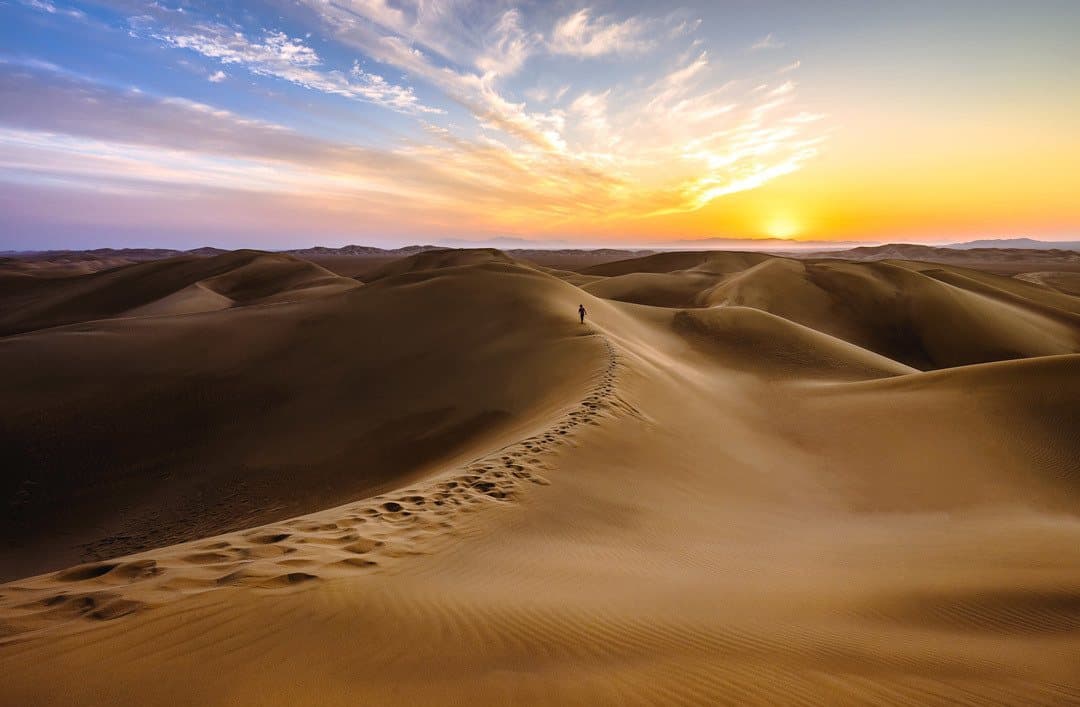
When we say horrible, we’re being polite. The traffic in Iran is actually insane.
If you’re exploring Tehran don’t be surprised if you have plenty of “Holy s**t!” moments as you go to cross the street or you get around in taxi.
It’s not that Iranians are bad drivers…they just don’t have a concept of space when driving around. In one way it’s almost as entertaining as it is scary.
No one is actively trying to run pedestrians down, but if you do try to run the gauntlet of crossing a busy road it’s best to wait for a local to join them on their hell-bent journey to the other side.
Some social media platforms are banned in Iran and you cannot access them without a VPN (Virtual Private Network).
You cannot access Facebook, Facebook Messenger, Twitter, YouTube or Pinterest. You can access Instagram , but the rest only with a VPN.
We used ExpressVPN and had no issues. Here is a link to get your first 30 days for free .
Make sure you download your VPN before you arrive in Iran, because a lot of the VPN sites are blocked by the government.
If you can, we also recommend having access to a few different VPNs, because every now and then one might be blocked in Iran.
ExpressVPN worked for us during our trip, but some people have reported that it didn’t work during their own trip. Last we heard it’s back up and running properly now though.
Most of the guesthouses we stayed at had free wifi, but don’t expect it to be fast.
Some hotels had wifi available in the rooms, while others were only in the reception area or dining rooms. It all depends on how upmarket your place is. In popular cities, tea and coffee houses had wifi also.
One thing to keep in mind though is that just because there is wifi at your hotel, be respectful on how much you use it.
There are no unlimited data plans in Iran, so the hotels have to pre-purchase data in small packets.
Please don’t be that person that streams Netflix or tries to download the new season of Game of Thrones, because all that will happen is you’ll end up using all the net for everybody else in the hotel, and cost the owner more money.
Yep, we met a guy that did just that in Varzaneh, and because it was a weekend it meant nobody in the hostel could get internet until Monday. Thanks, mate.
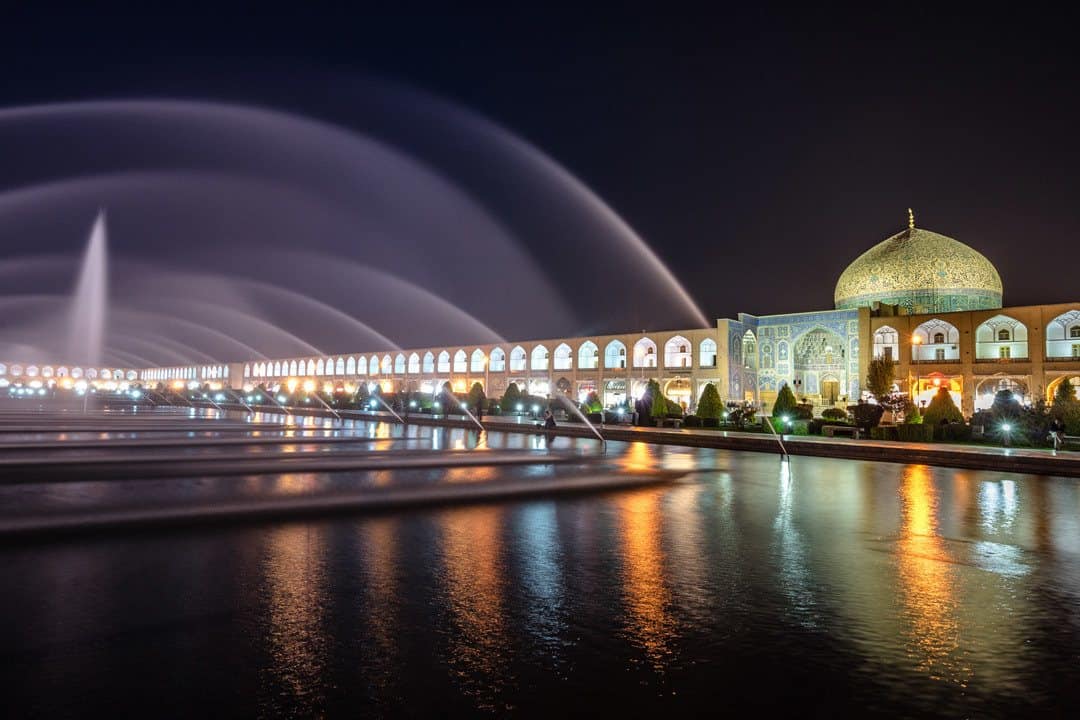
Despite what you may have been told, you can buy a local sim card in Iran as a foreigner, and it’s a great idea to do so.
This way you can call hotels to make bookings use WhatsApp and Snap (more on that below) on the go, and keep in touch with friends and family back home.
We bought up a sim card with the telecommunications company IranCel through our hostel in Tehran, however, they marked the price up by double.
We found out later that you can buy sim cards at the airport or at any store, so our suggestion is to do this yourself.
When going into the phone store bring your phrasebook or a local friend. You will not need to show any ID, just pay in cash, but it helps to have your passport with you just in case.
You can top up at little general stores that display the IranCel sign. They will do it all on your phone and charge a small fee for their time. Please don’t argue with that, it’s maybe 25c USD.
We were getting 5GB of data for about $10 USD.
There is an app in Iran called Snapp, and it is similar to Uber. It’s a rideshare app where drivers register and customers can order cars to get around town.
This was a lifesaver for us!
What makes Snapp so great is that a price is determined by the app and you pay in cash once you get to your destination. There’s no metre, so the driver will take the most direct way possible.
When you book it you’ll get the driver’s name, their car model and their registration number, so you know you’re getting in the right vehicle.
Yo drop a pin on a map for where you want to go, so there’s no need to try and explain it to the driver in case he doesn’t speak English (or your pronunciation is crap).
The other added benefit is you can rate the drivers afterwards, so they are more likely to be honest rather than a taxi driver.
The only thing is you cannot easily download it onto an iPhone, as Apple is an American company and does not support Iran. It doesn’t show up in the App Store.
If you go to the Snapp website you can download it to your Apple phone through a special link there. Downloading it on an Android phone is easy with no issues.

This one was a big surprise to us, but you can drink the tap water just about everywhere in Iran.
It’s totally safe to drink, even if you’re new to the country, so don’t worry about buying plastic water bottles everywhere you go.
Bring a reusable water bottle instead and simply fill up as you go.
Don’t drink river water tough if you are out hiking.
Iran is a nation of tea drinkers, so it’s no surprise that you’ll get delicious fresh tea for cheap (or free) just about everywhere.
But what about us coffee drinkers??
The bad news is that getting good coffee is very hard in Iran. Despite their close proximity to places like Turkey, the coffee culture phased out years ago and so now the best you’ll find is usually those horrible instant packets.
There is a silver lining though, and some entrepreneurial locals have discovered that coffee is basically the second greatest thing on earth (after a delicious IPA, which you also can’t get in Iran), and some Western-style coffee shops are popping up in major towns.
They’re not cheap, but when you need that caffeine hit in the morning it’s totally worth it.
When you catch the metro around Tehran or Esfahan, there are carriages designated just for women, which is great if you’re a solo female traveller.
These are basically sections that males aren’t allowed in to stop accidental touching of non-related mixed genders, but it also adds a sense of security for women taking public transport.
Occasionally if the mixed carriages are full you’ll see one or two men in the female ones, but they tend to stand next to the door away from everyone.
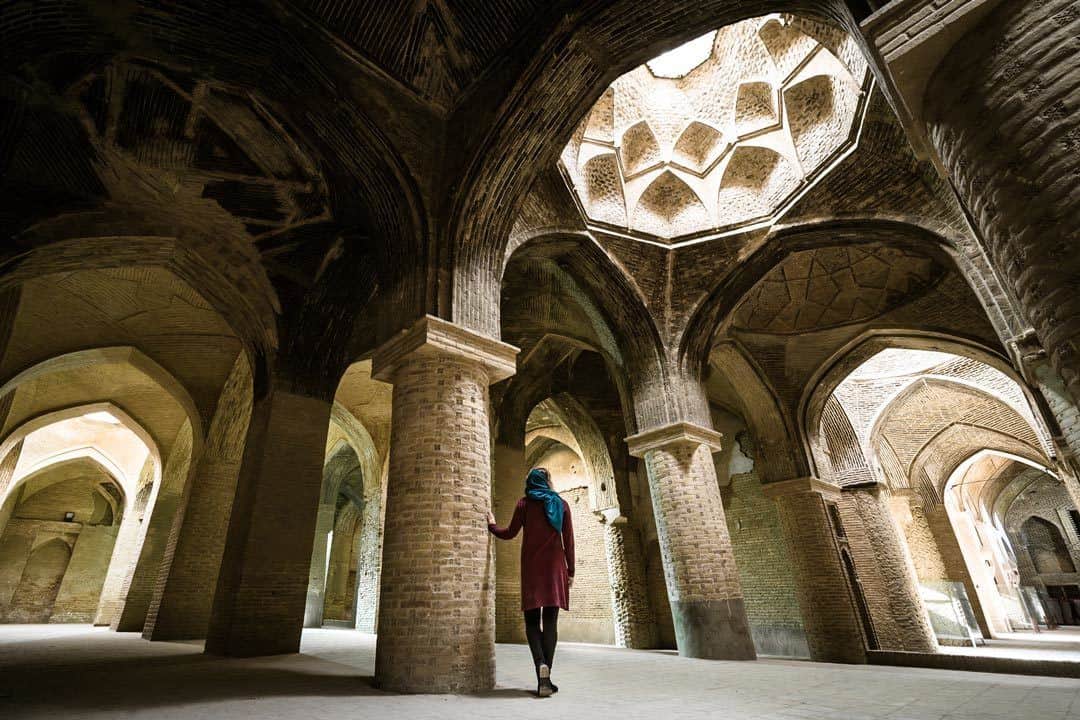
[box] Those were just some of the things you need to know before you visit Iran. Has the article helped you? Do you have anything else to add? Leave a comment below and let us know![/box]
Alesha and Jarryd
Hi, We’re Alesha and Jarryd!

We’ve been traveling the world together since 2008, searching for the planet’s best destinations and adventures.
Love Travel?
Sign up for our free weekly newsletter for the best travel tips, ideas and deals!
We respect your privacy. Unsubscribe at any time.
READ MORE...
Quark Ultramarine Review – Best Polar Expedition Ship [2024]
30 Awesome Things to Do in Easter Island
The Land of Spears and Smiles – Wogasia Spear Festival on the Solomon Islands
Related Posts
Rocky mountaineer – celebrating 30 years of life-changing experiences, how to get to magnetic island, queensland – everything you need to know, 12 awesome productivity hacks to make working from home easy, we’ve joined the kathmandu family, 105 thoughts on “25 things to know before you visit iran”.
Hello friends, I read your comments and I wish I could say that I am happy that you think so naively about the Iranian regime, but the truth of Iran and its people is not what these friends say, and unfortunately the bitter truth is that all those media that They present this regime and the leaders of the Islamic Republic as terrorists and a bunch of dishonorable and inhuman people, they are telling the truth and only the oppressed people of Iran understand this! you can ask them. But for you tourist friends, yes, this country can be a paradise because your money is worth many times more than ours, and not you tourist friends, but the unfortunate people of this cursed country feel the pressure. Our only wish was to have normal rights and a normal life like you, but this regime stole that life from the people of Iran and blackened the lives of the people of this country. Hoping for a day when this terrorist regime, which has made the Middle East and the whole world insecure, will be destroyed and we Iranian people have good and sincere relations with the people of other countries of the world . That day we will have at least a normal life and the world will not recognize this country as a criminal terrorist country. Written by a 27 young Iranian.
hi I want to just say now ( 2023-15-11 ) that the US dollar is 510000 Rials and here is heaven for people of countries where the currency is the dollar and Iran just is Hell for local people thanks to the Iran government for this situation!!!!!!
Hi dear Alisha and Jerry My name is Raziyeh. As an Iranian, I wanted to express my sincere gratitude for your kind words and appreciation of our beautiful country. Contrary to media propaganda, Iran is safe, and Contrary to media statements, we are hospitable and genial people who do everything to ensure you have a fun time in Iran. Please do not believe the lies that social media tells about our country. We’ll be happy to see tourists and give information to them. I hope you revisit our country. Best regards, Raziyeh.
Hi everyone I’m from Iran. I’m happy that you liked your trip to Iran. Iran has a lot of museums and attractive places if you’ll come you should visit them. And we’ll be happy to see tourists and give informations to them.
Iran is an extremely lovely place to travel. Thank you for the trip advice. I adore your article.
For foreigners especially Westerners Iran is a very dangerous country. There is a high risk of being arrested on fake charges. Atleast 50 foreigners have been arrested recently and sentenced without a fair trail. The “friendly” citizens of Iran will not help you out unless you pay them witg Euro or Dollars…..
Well! I accidentally found this while surfing the net, and it’s a bit sad that each dollar is 450000 Rials… People are still friendly to tourists though, no matter how hard our lives are. I hope you visit our country again, after all these sad events, of course.
22 days later and its 510000. when will these evil leaders leave us alone
We are glad that you were satisfied with your trip.You pointed out great points like someone who has lived inside for years… Our people believed, but the government has crushed the people so much under the economic pressure that they have become a little unfair to each other. Be sure to use SNAP inside Iran.. Be sure to check the price before buying.. Our common currency is Toman and Rial is nominal. For example, now every 1 dollar is equivalent to 33000 Tomans.. To eat a pizza, you need 6 or 7 dollars.3 cents are required for 1.5 liter of taqriya water.. If you have an acquaintance in Iran, you can be much easier.. Don’t pay too much attention to the capital because it has very beautiful cities with a very old history. Thank you for choosing which country for your trip. Good luck
Thank you for the excellent information and for taking an interest in the lovely country. really nice tips for visiting Iran.
I’m glad you liked Iran. Unfortunately, due to the difficulty in managing economic affairs, the Iranian people suffer from the high cost of goods. Now each dollar is equivalent to 277,000 rials, which is really terrible, of course for our people! Of course, Iran is still full of beautiful places and amazing places! I hope you have good trips …❤
Hi guys I am Ava. I am from Iran/ Isfahan. If you want to come to Iran I would be happy to help you. I have a beautiful Iranian old house.
Can you please write about traveling in Iran at the moment. I would be traveling on a New Zealand passport. Thank you. Evan.
Iran holds many surprises for visitors; like the climate which can fluctuate greatly, depending on the area and time of year, dispelling the long-held myth that Iran is nothing more than a vast, sweltering desert. But Iran is a historical place and i like to visit this type of places that is why few days ago i read this type of article on another site it contain huge information. While some surprises are nice when travelling, it’s important to be as well prepared as possible.
Is $1000 for 7 days visiting 5 cities everything included except airline tickets a reasonable price? Please let me know what you think! Cities included are Tehran, Yazd, Esfahan, Shiraz, and the desert side with Caspian sea. Thanks,
Definitely if you stay at budget accommodation, take public buses as transport and not eat at fancy restaurants. Have a good trip
it’s very good
Indeed it is 🙂
I am Iranian. You described Iran very well. I am glad that you visited Iran
Thank you for your comment Masoud. We really enjoyed travelling around Iran. 🙂
Hi Thank you for your essay about Iran. As an Iranian I do hope you have good memories generally from Iran. No country is perfectly free of any trouble but please do not believe propaganda against Iran unless you travel to Iran and live with Iranian for a couple of weeks (at least) and then judge.
Hi there! I’m an Iranian, and i’m REALLY happy that you loved our country! I hope other tourists enjoy their travel to Iran, and I wanted to say, that Pinterest doesn’t need VPN! 🙂 And also about hijab, if you’re thinking that it’s gonna make you struggle, well, it definitely isn’t. I mean, it’s not such a big deal, and you’ll get used to it and continue enjoying! Anyways, hope you like our country
Reasons for a Group Visit to Iran Experienced travelers may want to look away. Guided tours can really be the best option for some travelers going abroad. Of course, they limit you a little and lose a little freedom. You will not have enough time to fall in love with a place and you will not have enough time to stay there, and other companions may not be with you. But no matter what the veterans might say, there are good reasons to tour for those who want to.
Salaam All, I’ve travelled extensively in the Middle East (Egypt, Palestine, Lybia, Qatar, Dubai, Saudi Arabia, Iran and India. My wife, daughter and myself went on holiday to Iran in 2012 and 2015 (for my 60th birthday). An Iranian couple came to sing happy bithday to me in farsi. It was an inexplicable experience, no crime on the street, no fighting, very, very safe, people very friendly and warm, food and confectionary very good, not expensive to shop but hotel accommodation could be expensive, public transport (bus and metro rail) very good and effecient, metro stations very clean and very easy for foreigners to use. Although we were based in Northern Tehran (Eliheyah), we once drove by luxury coach to Ishfahan to spend one week there (2012), the other trip we flew to Shiraz to spend one week there (2015). I fell in love with this country, it’s absolutely beautiful. In Tehran, we even went in the cable cars on the Azborg mountains. O, I just cannot stop raving about IRAN. I’ll visit there anytime. Please don’t believe the media with their negative reports, go see for yourself and discover this amazing country. Salaam from Riedwaan Salie (Cape Town, South Africa.
That is so nice. What a great birthday trip. We are so glad you had a wonderful time with you family. We found the country very welcoming and friendly also. Thank you for your comment. 🙂
Your itinerary was perfect! I hope you come back again very soon! I heard now you should ask for visa only from agencies. Also now for your money matters you can use a local debit card like Daricpay to charge and transfer money online
We hope to visit again one day. Take care
Hi Im am an iranian person and your information was totally correct about iran I am very glad to see you were anjoyed traveling to iran If you come to iran again you can visit other cities like shiraz,Tabriz,Isfahan,Hamedan they are as beautiful as Tehran
Thank you so much for your comment. 🙂
Hi all, I have been 2 weeks in Iran the last month, my friends and I were travelling the west part of this huge country touring the famous cities and recommended places over the countryside. I could never thought how beautiful were every little point that we stopped by: landscapes, restaurants, seacoast, food… persian landmarks will remind forever in my mind. As we were travelling by car we trusted (company removed, you can message below if interested), a notorious iranian company which offers a wide variety of car for rent. The service was excelent and they provided us whatever we need in order to make our trip easer. I would definetely recommend this company If you are thinking about renting a car to shuttle from a place to another, they are serious and reliable. Thanks persian people and the company for making our dreamt trip happen!!
We love Iran!!!!
Sounds like you had a great trip. We are so glad so had a great time.
Hi Alesha and Jarryd, Thank you for the useful info and your interest in my beautiful country. I’m Zahra Mazaheri an English – Farsi translator. I would be more than happy to help the tourist to Iran in having a pleasant journey.
Glad you liked our article. All the best
Iran is a wonderful country for all nations to visit. Whether you’re interested in going to cultural and historical places, try local food, shopping, or visiting new people, the country is one of the best places for all of these.
Thank you for your comment. It is a magnificent country
thanks so much for your tips, and i want to add this there is something that we call it “Taarof” This is a polite exchange that takes place in all aspects of life in Iran, in shops, in streets, in businesses, at homes. Simply stated, it is a form of one person making an offering and the other, refusing it. This ritual may repeat itself several times before the individuals finally determine whether the offer and refusal are real or simply polite. Be very careful how and with whom you taarof so that it does not interfere with your stay. Use common sense as to when to do it and when not to.
Thank you so much for this. After travelling the country for 3 weeks, we only experienced this once in Tehran on the outskirts of the city, We ate locally, bought locally, stayed locally, bought a lot of items on the street but only experienced it once. We were shocked. We had read about it and was waiting every time but it never came. Maybe if you are a foreigner they don’t do it as much. Thank you the explanation.
I really appreciate for your thoughts on this topic. Thanks for sharing this information with us.
Hi Alesha and Jarryd, this was so helpful. We’re off to Iran in a couple of weeks and great to get some tips re luggage, local currency cards and communication options. thanks david
Hi David, We are so happy the article was helpful. You will have a great time in Iran. Do not over pack. Woman have to be covered. Loose clothing is a must and a long top/dress is best as it covers the figure. Her arms and legs have to be covered. Sandels can be wore. A hijab is a must so bring scarfs. For the men, your arms do not have to be covered. Do bring pants as you need it for mosques. Our advice is to bring zip off pants. They are great. We did not use local currency cards. We bought all our cash in euros and exchanged it in Tehran on day 1. We did it with our guesthouse. They gave us a great rate. As for communication, do download Farsi offline before you go so communication can be easier. Surprisingly a lot of people do speak broken English. have a great trip.
Hi guys. Im so glad you had a good time over here. I believe Iran is the most misunderstood nation (thanks to media!) and articles like this may help people see Iran for what it is. One thing i need to point out is the currency exchange rate. the rate of 30,000 to 1 USD is no longer valid. 1 USD would be exchanged to about 110,000 rials now (11,000 Toman). Hope to see you back here soon! cheers
i promise to passengers ( our guess ❤) that we can make nice memory for you , and hope you enjoy that
Hi guys, great article! Just wanted to suggest that you include information about the Pocket WiFi and Travel Debit card services offered by MahCard (www.mahcard.com) as well… We travelled from Amsterdam to Iran during January this year and we used both services from MahCard and they really made our trip much easier…
Thank you for your tip Lotte. We have never heard of these guy. Definitely would be helpful. We strongly encourage travellers to do their on research on companies and make their own judgements. All the best
Hello! Very useful info about Iran. I am preparing a trip with car from UAE to ROMANI so it will be Bandar Abbas to Turkey Border. Any info and advices are welcomme! Thx
Hi Als, not too sure about that border. We flew in to Tehran. All the best.
Hello Dear Guys, I’m really glad to find your blog. It’s really interesting to me. I should say thank you to you for giving this good information about my country to people. It would be our honor to be host in your next travels to Iran.
I have been to a lot countries. I have been to super cold areas like Norway and have lived in the snowy Switzerland, and have also been to warm countries such as Bali, Sri Lanka, etc… What I love about Iran is that whenever and in whatever season you go, there are always 4 seasons. The southern part (Persian Gulf) is known for its golden beaches and hot climates, other areas such as Shemshak, Darbandsar, etc… are known for their snow and mountains. I recommend going to ski resorts in winter, and as a person who has lived in Switzerland I can tell that they are better. At the same time where you find snow in Iran, you can also travel to the other side where there are hot deserts. I recommend you go to these desert areas with a local tour called RONATURE, which is an ecofriendly tour and provides vegan and vegetarian food, furthermore supports locals and the environment. The Persian Gulf is unimaginably beautiful. Qeshm island in the south is probably the most beautiful place in the world, unfortunately there are not many photos of this island online because not many people know about it yet, but I do recommend taking diving courses there. The water park in Kish island is the best I’ve ever seen, much better than the ones in Dubai. I could go on for forever but you go to Iran once and experience all the four seasons. You get snowy mountains and sunny beaches. You go skiing and after a short flight you are tanning on the beach. This is a miracle and not something other countries dont have to offer. I can say nothing more but to recommend this marvellous country. Do not listen to the media, Iran is safer than Europe and Im not even slightly exaggerating.
Thank you for helping people to travel to Iran, I believe everyone should visit Iran beyond the media portrayal.
We totally agree with you Vahid. Never listen to the media about a destination, we don’t. We really enjoyed our time in Iran and encourage people to experience this country for themselves. 🙂
Sorry, I won’t support Iran. The government is evil. They imprison and torture their own citizens and they execute gay people. How can you support a government like that? Oh, and if you have an Israeli stamp on your passport, they won’t let you in. That’s ok with you?
We don’t support the government, we support the people of the country, who are among the friendliest, most genuine and hospitable people we have ever encountered. If we were to boycott countries with corrupt and evil governments, we’d start with the US.
I recently moved to Iran, as I am Iranian-American (well, now mainly just Iranian). I really appreciate all of the sweet and insightful comments and your wonderful website. Since the last time I lived here I was a child and have only visited every few years, when I arrived I was definitely feeling like a Persian that came back from a lost time warp of sorts, and had to learn the deeper levels of what you all already thoughtfully mentioned like tarof and the culture. Iran is a BEAUTIFUL & AMAZING country and I am lucky to be here. Just to let people know, everything I read here is true and helpful. 🙂 Even riding a bus from Iran into Armenia (to access my american bank for my final paycheck), I started out feeling slightly awkward as the 99% Persian only passenger peers around me were playing cute little games with each other laughing, with LOTS of incredible Persian music… I started getting many happy flashbacks of American-Iranian dance parties… but this was the REAL thing! Within minutes I joined in after being invited to clap my hands and a few girls were doing little hand dances in their seats… within about 10 minutes half the people on the bus were all SINGING together, it was precious. I felt like I was home, with my (native) Iranian people, and I got little happy tears in my eyes. YOU CANNOT FIND THESE MOMENTS IN AMERICA or EUROPE where nearly everyone around you surrounds you with welcoming bright eyes all at the same time. It’s like they are making you part of their family. I recommend visiting Iran for ANYONE… You will see that Iranians are good hearted and loving, even with all the sanctions. Give them a genuine smile, and you will get 100 smiles back, with tea and poetry. 😀
What a beautiful moment. That is great you are going back to your roots. We hear you. Iranians are good hearted and so generous. It is a beautiful country. Have a great time and hope you settle in quickly. All the best
Thanks for visiting my country. Hope tourism breaks all the wall of this global village.
We hope so too. It is a beautiful country with many beautiful people. We loved our time there
Thank you so much for this amazing article! I am going to visit Iran, but just for one week, so I need to take everything that I can from this short trip. I didn’t know that I need a VPN, that is a surprise! I have Surfshark subscription. Maybe you know how it works in Iran?
Not too sure if it will work or not. We used VPN Express and had no issues. There are free VPNs if you get suck and find yours does not work. Have a great trip.
So disappointing to learn that Canada is not one of the countries included on the Visa on Arrival program…I really want to spend a week in Tehran but it looks as though that won’t be possible. That’s really too bad 🙁
I know. It is a little more of a hassle but worth it. I know Canadians, UK and USA citizens have to go on a tour but there are many great tours within the country. If you want a tour that is not a tour, check out Yomadic. He’s tours are informative but relaxed and have great reviews. All the best.
I was 10 days in Iran (Teerah, Esfahan, Yazd and Siraz) and … is a great country, good food, culture and fantastic people. Thank you Iran!
Glad you had a wonderful time Vitor. 🙂
hi im ghazal from kermanshah iran! a offer all to come here and feel how friendly people are
Yourwellcom
I’m sorry for this government rule.
Your welcome. I hope you back soon in my country.
hello,im shahzad from iran. thank you so much for your excelent content about Iran. all of the sentences are true about my country and u knew it very well.im so happy that you had good times here. As the other iranian people said,now 1 USD is equal with 141,000 Rials :).so Iran is a very cheap country for tourists,too:). come to my country and enjoy,it would be your best trip with no debt:)
Hi Shahzad, We had a wonderful time there. Thank you for the update with the exchange rate. We recommend all travellers to visit Iran. 🙂
Thanks for this guys! I am super excited leaving for Tehran on Monday I booked a small tour as I felt anxious about travelling independently first time ever in Iran. If I like it -and I am sure I will – I shall go back. I was advised to take a day travel backpack and a medium sized wheely which I hope to fill up with things bought locally. Of course I shall take essentials. Is a long skirt allowed? It might be cooler than trousers. What do you think?
Hi Alex, I hope you are having a wonderful trip, That great you booked a small tour. Sometimes it is the best way to see the country and learn about the people and culture. There is so many great souvenirs to buy. Unfortunately my bag wasn’t big enough. 🙂 Absolutely a long shirt is allowed but not a tight body fitting one. Long sleeve and maxi dresses are perfect. Trousers are great just make sure you top is loose and long past your bottom. Have a great trip.
Wow, Thanks for this. I’am glad, that I found your page. I’ll travel in october alone to isfahan. I’m already so excited
That’s amazing. You will have a great time. The Iranians are so friendly and welcoming. There is so much to do there. Here is a video we made about Isfahan if you want to check it out. https://youtu.be/XDYJ44CutT4
Great points!
Regarding bringing a load of cash though, I found a solution. In my last trip to Iran, I got a DaricPay card. It made everything easier!
Thank you for your suggestion and information. Glad that worked for you. We still recommend visitors to take cash as not everywhere will accept cards.
Hello everyone. This is Ali, an Iranian. This page is a good guidance; LIKE ! Iran is a country of different climates and has very beautiful historical monuments and natural areas. Contrary to propaganda, Iran is safe and a good choice for travel. Come to Iran and have nice time here.
Thank you Ali. 🙂
This is great ! Thank you! I’m preparing to go there in June and your article answered a lot of questions! I will come back to it just to remember everything. Thanks again.
Glad the article could help. Have a wonderful trip Joanna.
Great i read your experiences you had great fun in Iran. Everyone should need to aware about your guidelines before visit.
Hi Eric, thank you. We had a great time in Iran. Definitely everyone should read up on the guidelines, not just what we have written but from other also. It is important to do your research before travelling to a country. 🙂
Hey, great article on Iran tourism. What should I plan in terms of budget, if I want to plan a 7-day trip to Iran and cover major tourist/historical destination.
How would you rate food for just vegetarians. Thanks!
We budgeted $80 USD a day for a couple. We came home with a little bit of money but we rather have more than less as there is no ATMs that work for foreigners. As for vegetarian food, there are many options.
This is awesome article, I’ve read a ton of articles online these past couple of months as I’m traveling to Iran in May. I’ve already bought a NordVPN subscription regarding the social media access, I hope it will work fine too, saw some recommendations for it too. Other than that I really cannot wait for the trip, so I keep reading about it. Thanks 🙂
Awesome Steve. Have a great time. The people there are so friendly. It is an amazing country.
hi steve, i recommend, first travel to iran then try free vpn then buy subscription.because some vpn in iran dose not work. instagram and what up don’t need vpn.have a nice trip!
Hi I am very pleased to be pleased with your trip to Iran I hope that one day we will be able to travel to other countries as well These days, people in my country are very sad.
Hi Mostafa, thank you for your message. We did enjoy visiting your country but did hear this from many locals. We hope that one day it all changes and travel will be a lot easier for Iranians. We saw nothing but friendly and welcoming people. The most friendliest country we have visited. We hope happiness comes soon.
Glad to hear that you had good trip in Iran guys. However things get worse and now 110,000 rials = 1 USD which is good for tourists. Lol.
Thanks for that Mohammad. Not good for the locals. We thought it was cheap when we visited last year. Sorry to hear that
I glad to read this site My country has very beautiful natural scenery and tourism, as well as very caring and kind people… I hope to see you in my city, Isfahan, the city of culture and art, and we can spend good times together^_^ I hope that there will always be in all countries, including my country
Hello I am Iranian I am very pleased that you have been satisfied with traveling to Iran I wish you success
Thank you for stopping by. We loved travelling Iran. The people were so welcoming and we had a lot of great chats with many. We are looking forward to returning one day.
You were ok travelling without a guide? Is it easy to travel around without one? And is it possible to hire guides to specific places, such as Persefone of some mosque? My wife and I are planning to visit Iran on April or October? What’d say? Thanks a lot.
Absolutely. We met so many local people and had so much fun. It is an easy country to get around in. Their transport system within the cities were easy and great. Their bus system across the country was comfortable and faster than the train. You can hire guides at main attractions as you go. The hotels can help with that also. Have a great trip.
If you are from the USA, Canada or UK you need to go on a tour.
Hi We are older Australians and are wanting to go to Iran. We usually plan our holiday booking accommodation and transport before we go so are a little hesitate going without anything booked. We have not been on a tour before and they don’t appeal to us.
Thank you so much for this valuable information. My mother and I are trying to book an organized trip with Intrepid Travel. They told us that we were not allowed to be out and about without the accompaniment of a male. Which they say we would have to stay in our hotel during our free time unless we go with a male. Have you heard of this before?
I am Mehdi and I am from, Shiraz Iran. I welcome your arrival to Iran in advance. Staying you in your hotel during your free time in Iran is not right. You can go out without a male. I can help you if you have any question. please don’t hesitate to ask me. you can contact me at [email protected] . I hope you have a nice trip in Iran. Regards; Mehdi
Hi Cathy, that is so strange they would tell you this. That is wrong on Intrepid Travel to tell you this and if they are concerned about this for their guests they should provide tours for you free of charge as staying in the hotel room is not a very good experience at all. I hope you wrote to them to express your disappointment with this.
As Mehdi said above, that is not right. When we were travelling throughout Iran there were many woman travelling on their own that out and about by them selves. We did not hear of any issues. Obviously have your wits about yourself. The people of Iran are so friendly. The friendliest we have come across in our travels. I hope you got to experience this and see a lot of the beautiful country.
Hi Cathy, I’m an Iranian person, this is not right, you can go out without a male. Iran is full of friendly people and I’m sure you will enjoy your time and this would be one of the most unforgettable trips.
Hello kathy I’m very surprised by your talk I am from Iran and I assure you that it is not
Hey guys! This is one of the *very* few articles about Iran that I completely agree with. Oh, apart from one sentence: “Iranians are very punctual”… I actually laughed out loud. You must have got lucky. In any case, I’m glad you enjoyed your time, and hope we cross paths one day.
(also, feel free to edit this out: the photo of Alesha at Friday mosque in Yazd is actually Friday mosque in Esfahan)
Thanks so much Nate! Glad the piece got the seal of approval from the Iran expert himself! And I guess we did get super lucky with the locals being punctual. For the whole month we were there we were never left waiting. Will count our lucky stars, and make a note that perhaps it’s not always the case.
And thanks for the correction on the Friday mosque! Have amended it now. Happy travels mate.
Hi dears! I’m an iranian girl & I love my country… Actually my father is a tour guide & I’ve heared such lovely words from so many tourists… they mostly say they had heard many bad things about iran and they have experienced the bests when they came here… I’m so glad to here such nice words by many travelers and i really appreciate you cause you ‘re telling the truth about my amazing country!!!! I love you all dears!!
Leave a comment Cancel reply
Save my name, email, and website in this browser for the next time I comment.

Borders Of Adventure
Leading Culture and Adventure Travel Blog by Becki Enright. Looking at the world with a different angle to change perceptions of misunderstood places, for the best in travel.
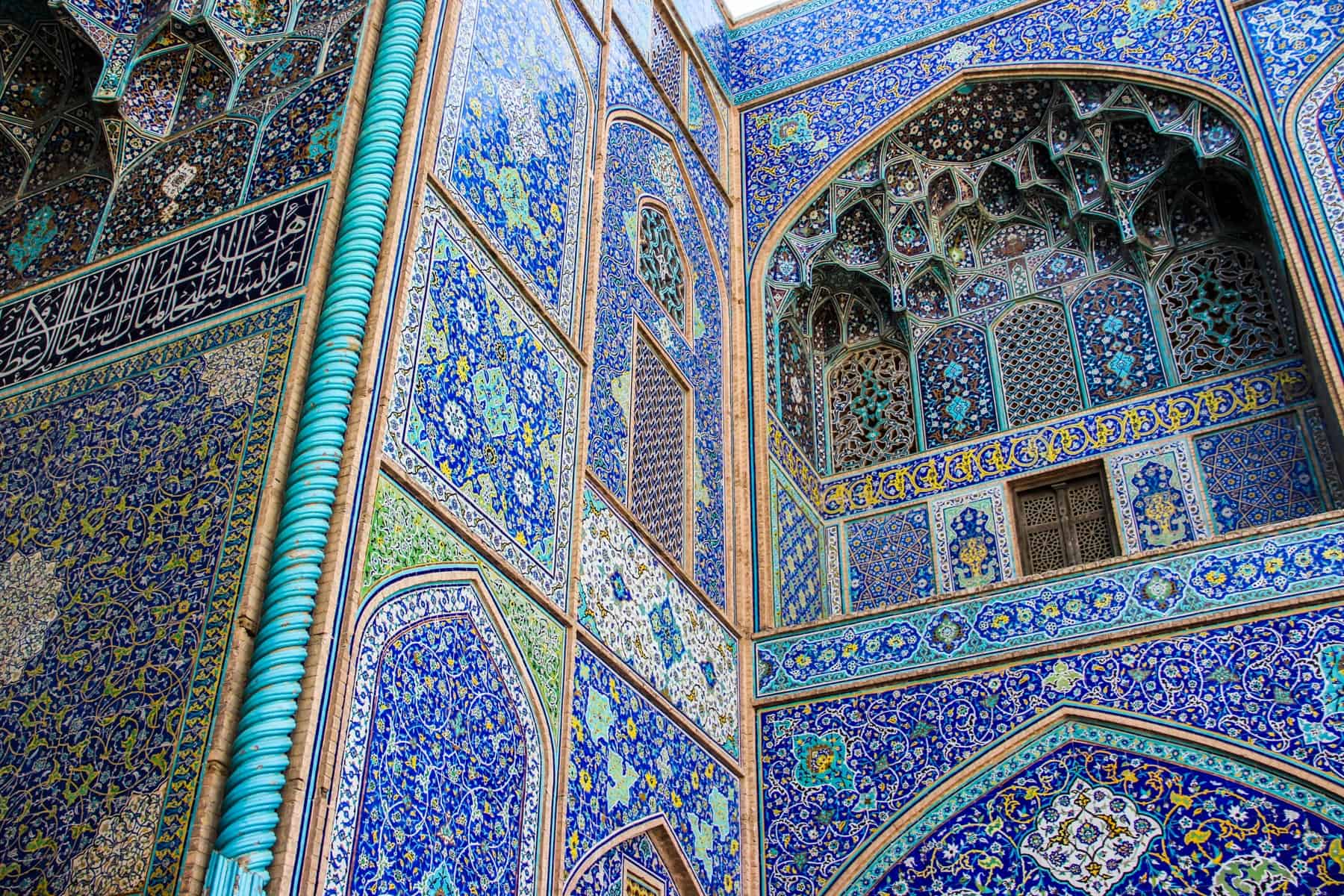
Iran , Misunderstood Destinations
This Is How to Travel to Iran – Everything You Need to Know
Disclaimer: This post contains affiliate links to handpicked partners, including tours, gear and booking sites. If you click through or buy something via one of them, I may receive a small commission. This is at no extra cost to you and allows this site to keep running.
Many travel to Iran to experience the delights of the ancient Persian Empire yet are unaware of the limitations faced by the rules and regulations of what is now the strict Islamic Republic.
As travel warnings persist and diplomatic relations with other countries continue with varying degrees of existence, many are confused about how to go about entering Iran and travelling in Iran safely, efficiently, and within the boundaries set by the current regime.
However, an Iran trip doesn’t have to be difficult at all – tourism is growing as relations develop; hatred of the western world is not as rife as the media likes you to think, and travel in the country is safe. Ancient Persia is within easy grasp, most notably in the central region where key sites have been maintained and the infrastructure linking them is growing, and tourists are not subjected to as heavily enforced rules as the locals.
With enough pre-planning and prior research, you can easily avoid the limitations and stresses of travelling in what is perceived as a closed and tricky country to traverse.
Use this checklist and list of tips for when you visit Iran as a comprehensive guide to help get you started. This Iran travel guide shows you how and is constantly revised with the help of an authorised tour guide on the ground in Tehran, alongside access to regular Iran tourism updates via tourism business partners.
Travel Warning: Due to the volatile security in the region and the recent developments in April 2024, check your government and official advisories before visiting Iran.
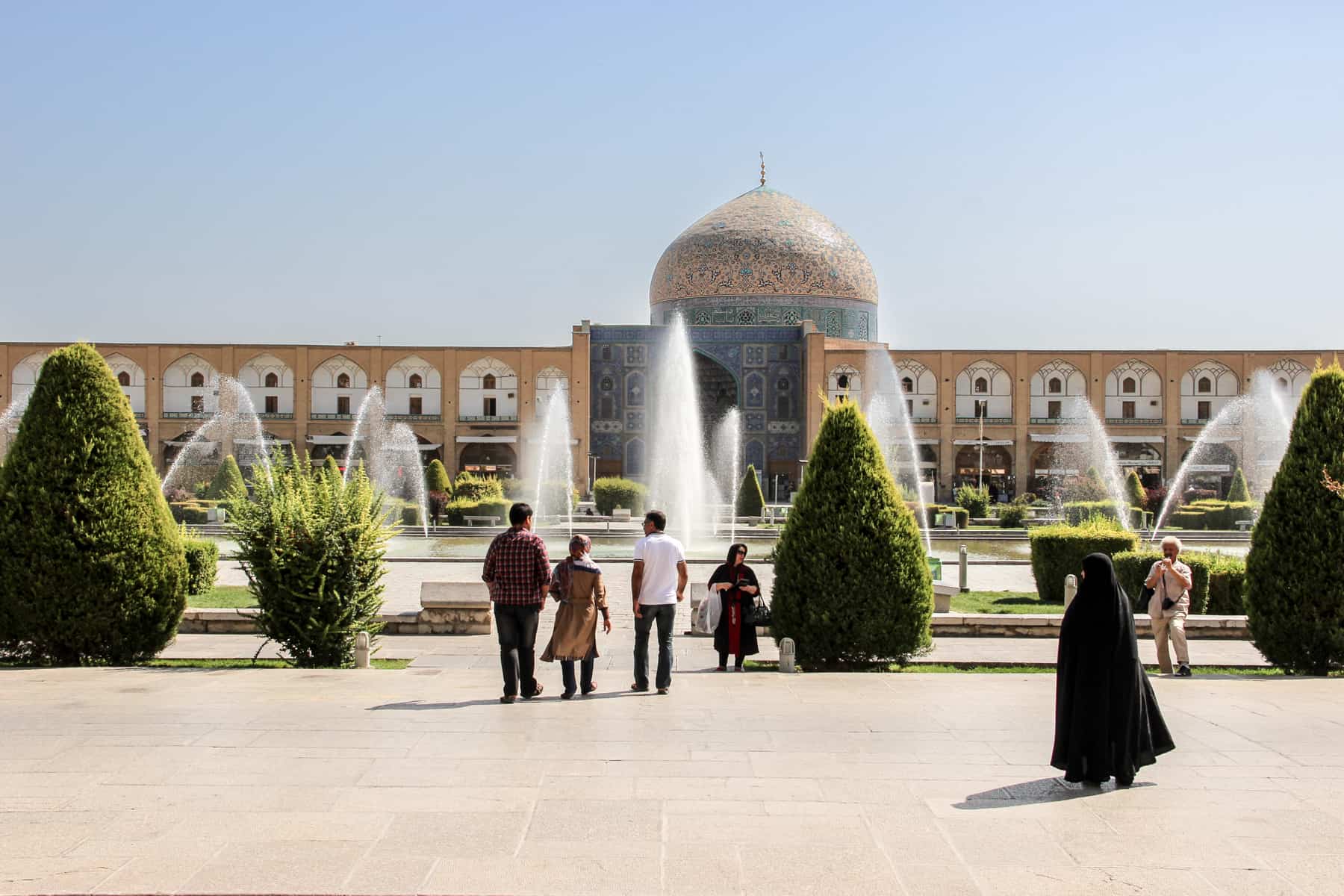
Check Before you Visit Iran
Persia and iran – are they the same, how to get an iran visa on arrival – 180 countries, cost of visas for iran and cost for visa on arrival in iran, you must have travel insurance for an iran visa application, iran tourist visa and authorisation code costs, iran visa timings with authorisation code, proof of travel to israel, current diplomatic relations, nationality restrictions – americans traveling to iran, nationality restrictions – british and canadians travelling to iran, nationality restrictions – israelis travelling to iran, booking the best iran tour, private guided tours of iran, travelling independently in iran, couchsurfing in iran, solo female travel in iran, when is the best time to visit iran, unesco world heritage sites in iran, what should i pack for iran, you are safe in iran, and iranian people are very welcoming, is it safe to travel to iran right now, rules in iran, is iran an arab country, currency in iran – two names, one currency, credit and debit cards in iran, inner-city transport, intercity transport, separate men’s and women’s carriages on iran public transport, pre-register with your country’s foreign office, which sim cards to use in iran, which vpn to use in iran, finding traditional food amongst the fast food, drinking in iran, etiquette in iran, understand the concept of ‘persian time’, read more on the history of iran and iran travel, want to travel iran – pin it.
Inbound bookings for Iran usually change when something has severed particular diplomatic ties, which then reverberates to tourism apprehension and a halt to tourism altogether. Always check the news and the political landscape before travelling to Iran to see if you (and your nationality/country) are affected by visas and entry to Iran. It’s always a matter of time and patiently waiting to see how the political landscape plays out following these events. Here are some of the more recent ones.
On 3rd January 2020, it was announced that the Iranian Major-General Qasem Soleimani was killed in a US airstrike, with Iran calling for ‘severe revenge’. While the outcome is not yet known, this does ignite fears of a conflict in the Middle East , and it pays to be more aware of travel warnings at this time. American citizens, in particular, may face more restrictions.
Following the Ukrainian Airlines plane crash near Tehran, several flights routes to Iran have been cancelled following the news that the Ukrainian jet was ‘unintentionally’ shot down . If you have any Iran travel planned, check your airline to see if the service is still running.
The arrest of the UK Ambassador to Iran in Tehran as part of government protests have further sparked an international row between the two countries. UK travellers should be on alert for developments.
Both Iran and Persia are used interchangeably about the country and also while you are on the ground. Reference to Persia is more so in the context of the history and legacy of the ancient kingdom of the Persian Empire; Iran is about the modern-day Islamic Republic of Iran in the Middle East.
READ MORE: Best Places to Visit in Iran to See Ancient Persia
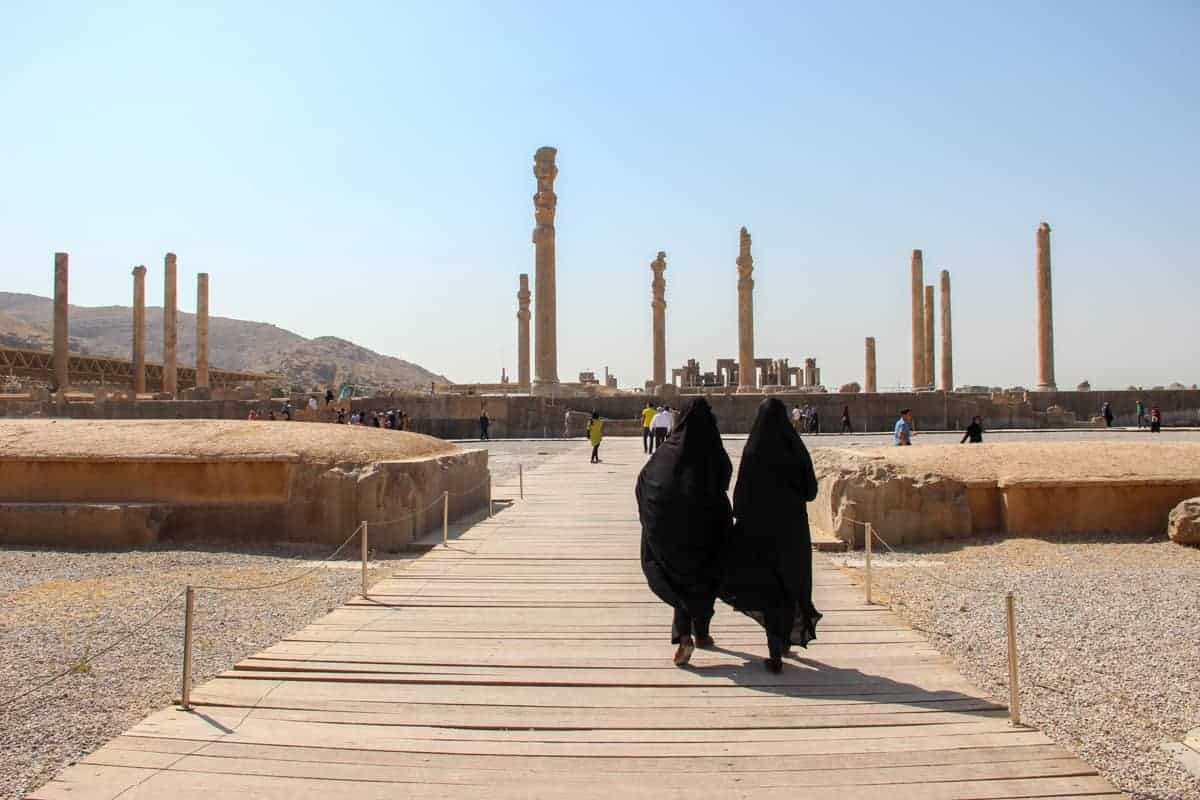
You’ll stumble between modern-day cities and the sights of ancient Persia, like the Persepolis, on any Iran trip.
Can Everyone Travel to Iran? Iran Visas and Authorisation Codes
Getting a visa for Iran is quite possibly the most stressful and challenging part of your entire trip. You first need to know if you are eligible and what limitations you may face.
For countries like the UK, which have strained and little to no diplomatic relations with Iran, you may find that you cannot even get an Iran visa in your country because there is no Iranian embassy. British travel to Iran means a little more legwork, where you may also have to travel elsewhere, like Dublin or Paris for example, to obtain the visa since there is no Iran embassy in the UK.
Most airlines flying to Iran will not allow you on a flight unless you show you have an Iran visa, but you can get a visa on arrival. However, sanctions have been lifted, most notably in 2016, with up to 900 Iran visas daily on average granted on arrival, according to the Office of Foreign Affairs. Tourism numbers annually have increased year on year, with 5.2 million foreign visitors entering Iran in 2015, in comparison to 4.7 million in 2013.
On the 14th February 2016, the Ministry of Iran announced that airports could issue 30-day visas for Iran, for nationals of 180 countries.
Non-eligible nationalities for Iran Visa On Arrival:
Afghanistan, Bangladesh, Canada, Colombia, India, Iraq, Jordan, Pakistan, Somalia, USA, UK
A 30-day Tourist Visa Upon Arrival, for those of eligible nationality , can be obtained at the following Iran airports:
IKA: Tehran Imam Khomeini Airport THR: Tehran Mehrabad Airport MHD: Mashad Airport SYZ: Shiraz Airport TBZ: Tabriz Airport ISF: Isfahan Airport
Follow the signs that say ‘Visa on Arrival’ where you will be asked questions about your trip to Iran and asked to present:
- Details about your confirmed first night’s accommodation in Iran, including the address and phone number (you may also be asked about your travel plans on-going).
- Proof of a confirmed return flight ticket.
- A copy of your travel insurance policy document and policy number.
- Those people I met who were granted an Iran tourist visa on arrival as part of the tour were given a special letter from the company that they could present to both the airline and passport control on arrival.
You can be waiting up to 30 minutes before your visa is granted and you can proceed to immigration. You will need:
- A passport with at least six months validity
- Two passport photos, in which women should be wearing a headscarf
- The completed visa form. You can also fill out the form online before arrival in Iran, from which you will receive a visa application reference number, print it off and take it with you.
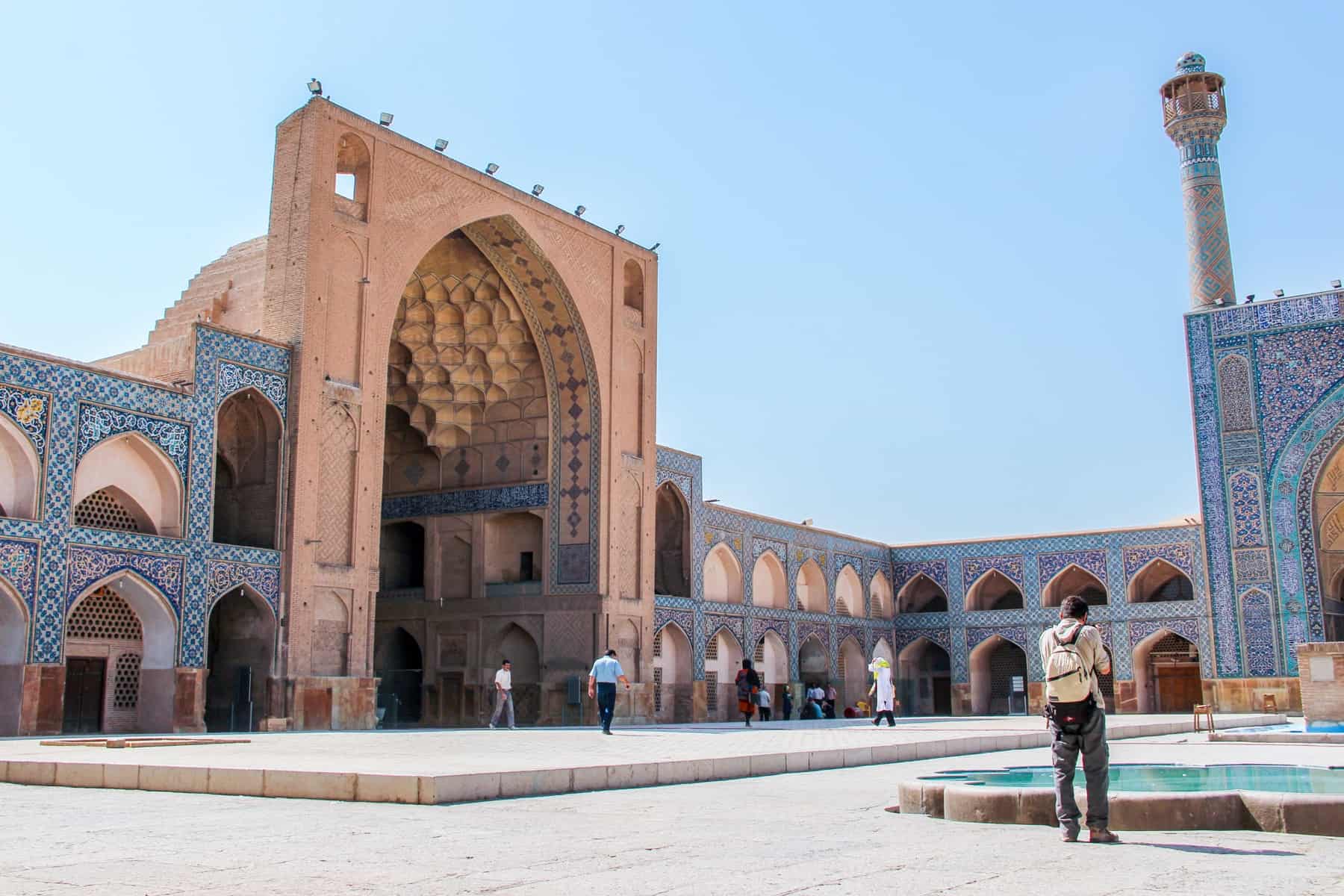
One of the many beautiful places in Iran to visit – The UNESCO World Heritage site of The Great Mosque (Masjid-e Jameh) of Isfahan.
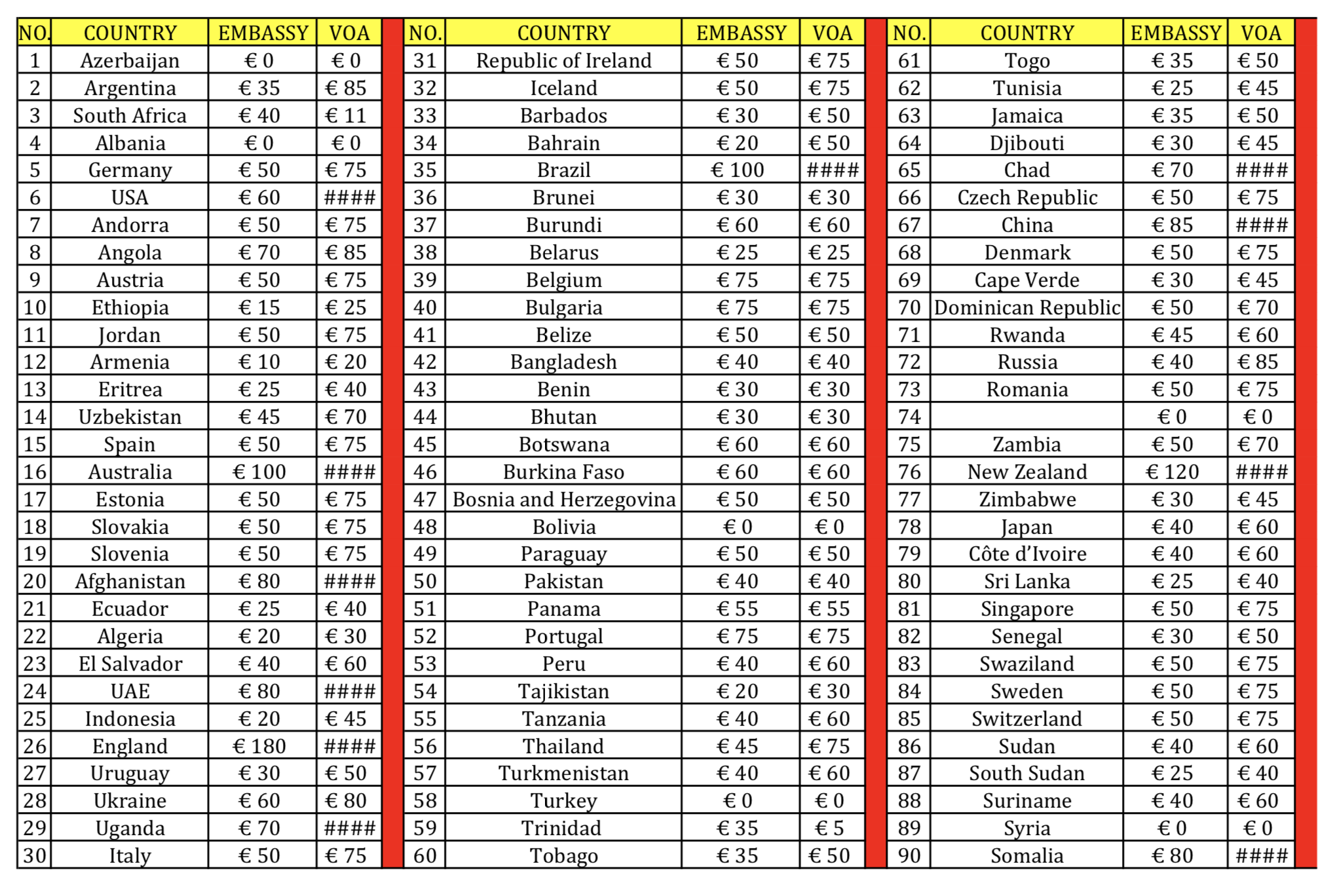
The costs for a visa in Iran and visa on arrival in Iran – each country is different.
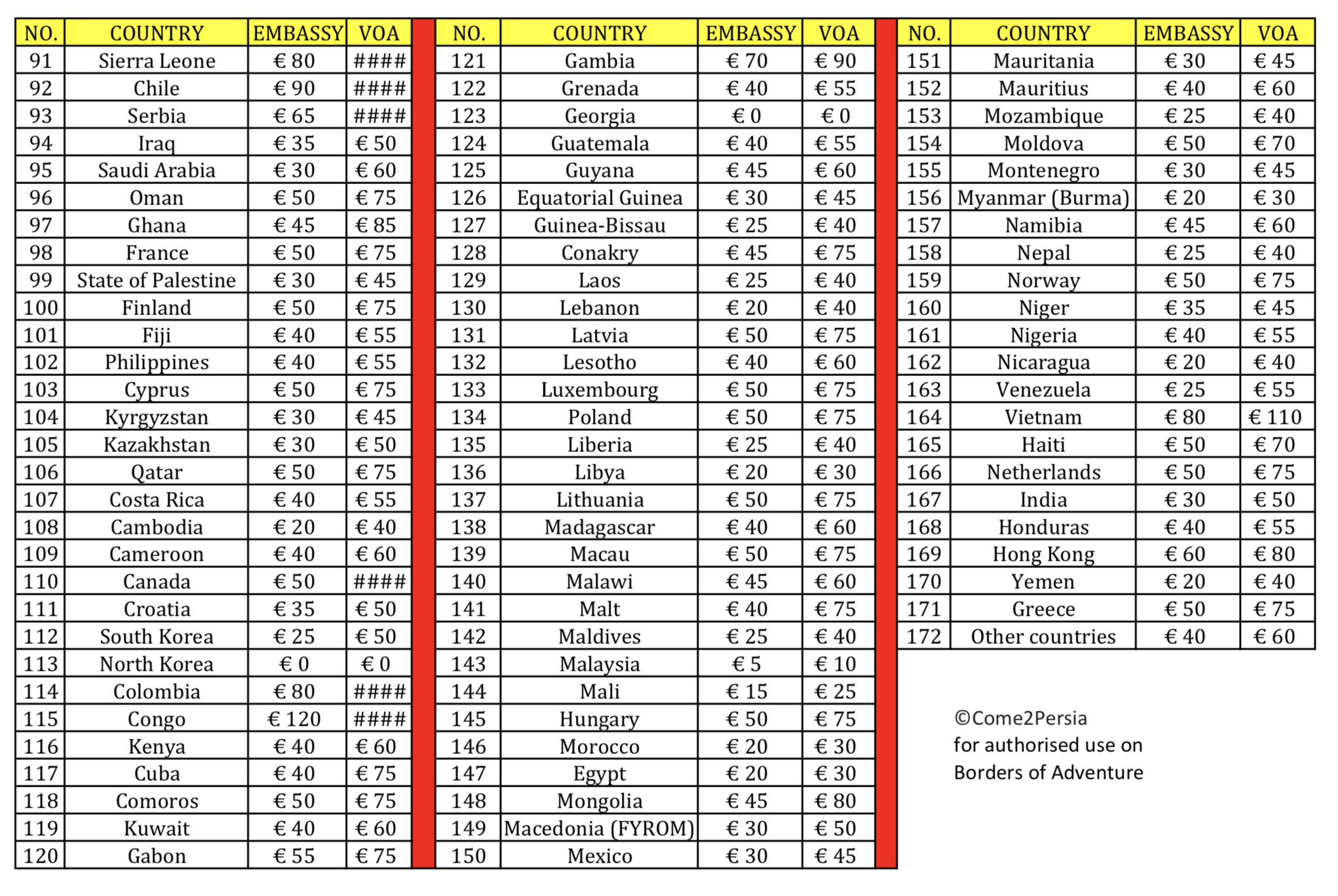
Iran Travel insurance is a requirement to obtain your visa for Iran. Without proof of purchase and printed documentation, you cannot pick up your visa from the embassy or secure your visa on arrival at the airport.
Aside from it being a stupid idea not to have travel insurance coverage, check that your current policy (or the one you are thinking of getting) covers Iran. Some do not provide travel insurance for Iran or only cover limited regions of the country and activities.
Getting Your Iran Authorisation Code – Non-Eligible Nationalities
For those not eligible for a visa on arrival, and those wanting to apply for a visa for peace of mind before they arrive, you have to apply for an Authorisation Code. EVERYONE has to have one of these, which will determine if you are granted an application for a visa.
- For those who HAVE to travel in a group (see below), this code will generally be processed by your tour company.
- For everyone else, you can use 1stQuest which offers essential travel services for Iran travel. Otherwise, source an Iranian travel agency local to you at the time of planning or seek direction from the embassy you wish to get a visa from about where to apply for it.
- When applying for the authorisation code, you will need to specify which embassy you will be processing your visa at – a pain for those travelling around with no solid plans. Once the code is released, you cannot change the embassy choice. It’s wise to choose an embassy in a city you are likely to fly to Iran from (see also timings below).
Authorisation codes (if not booking with tour) come with an administration cost of around 35 Euro, which is dependent on the agency you are working with. There is no set price for an Iran Tourist Visa since it is determined by nationality and where you process your visa.
I paid €180 for mine in Tbilisi, Georgia and a British guy on my tour paid a little more to process his in Paris. The Australians in my tour group paid differing amounts between €50-€100, as did the Germans. There’s no hard and fast rule – it’s more about luck.
If all that wasn’t enough, it is highly likely that
1. Your authorisation code will take WEEKS to process
2. It will most likely arrive with only a matter of DAYS to spare before your planned arrival in Iran or tour start date.
This means that before any trip to Iran, especially when travelling on a tour, you will be rushing to the embassy in the hope of getting your authorisation code for Iran processed quickly. You may have to pay extra for fast-tracking and organise your flight ticket to Iran very last minute. This doesn’t always guarantee the best price and the idea of getting a cheap ticket to Iran has to be pushed aside.
DON’T book your flights to Iran or any travel arrangements until you know your Iran visa will be processed. Many people travel to Turkey beforehand to process their visas and fly to Iran from there, using the country as a cost-effective flight or train route for entry.
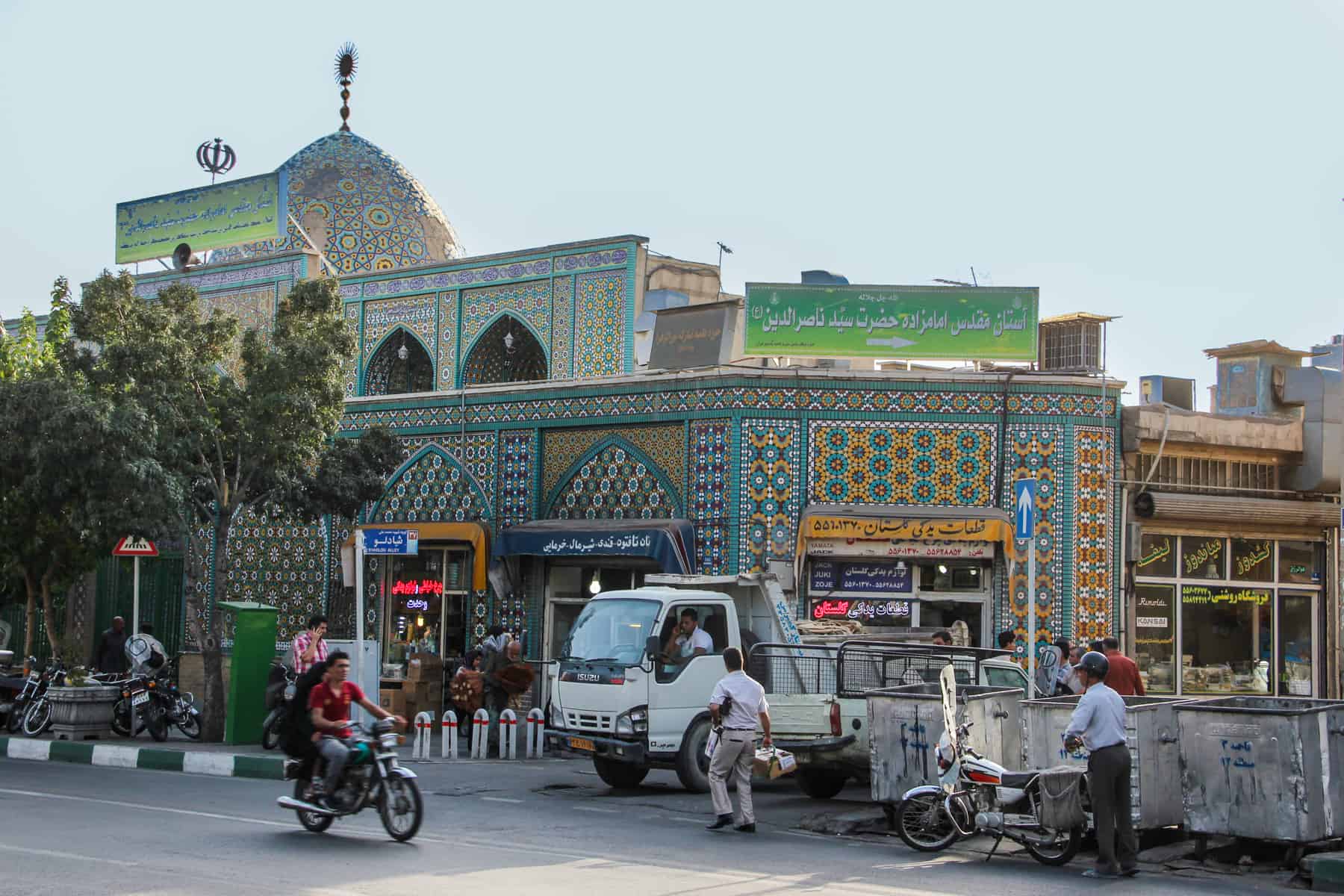
Everybody needs to get an Authorisation Code before travelling in Iran.
Refusal of Entry to Iran
The main reason for Iranian visa refusal is when there is proof you have travelled to Israel and the government’s paranoia based on your career (think journalists, media workers and similar).
Iran tourism issues are not linear, and while anything can happen at any time that would affect a particular nationality entry, the majority of the problems are political-based and beyond our control. Diplomatic relations and any political actions for/against Iran based on historical or current affairs at the time of applying may affect your refusal of entry into the country, or an Iran travel ban put in place.
On 4th January 2020, it was announced that the Iranian Major-General Qasem Soleimani was killed in a US airstrike, with Iran calling for ‘severe revenge’. While the outcome is not yet known, this does ignite fears of a conflict in the Middle East , and it pays to be more aware of travel warnings at this time.
On 6th October 2019, it was reported that the two Australians imprisoned in Iran for flying a drone were freed in a political swap. It is suggested that strained relations between the UK and Iran after Britain seized an Iranian oil tanker in Gibraltar are inciting such political moves to detain people breaking the rules.
On 29th August 2018, France informed diplomats to postpone all but non-essential travel to Iran after a foiled bomb plot near Paris. The following day, Iran dismissed such restrictions , proving that it is best to stay aware of any sudden changes.
Solo Travel in Iran vs Tours in Iran
One of the biggest questions I hear is: Can US citizens / Americans travel to Iran? They absolutely can, but because of the long-standing history of coups, espionage, nuclear sanctions and everything else in between (outside of the control of the average American citizen unconnected to the historical actions of their government), all US passport holders are only allowed into Iran if part of Iran tour packages (or with a tour guide).
Despite restrictions, it is safe for Americans to travel to Iran, so don’t be put off by the bureaucracy needed to get there. US travel tips to Iran focus on this red tape. For example, it still stands that Americans must also be escorted from the airport to the hotel, and cannot make their arrangements. This all has to be pre-organised pick-up (a simple addition via the tour company) so do check this before you leave.
READ MORE: Inside The Den of Espionage – Former US Embassy in Tehran Turned Museum
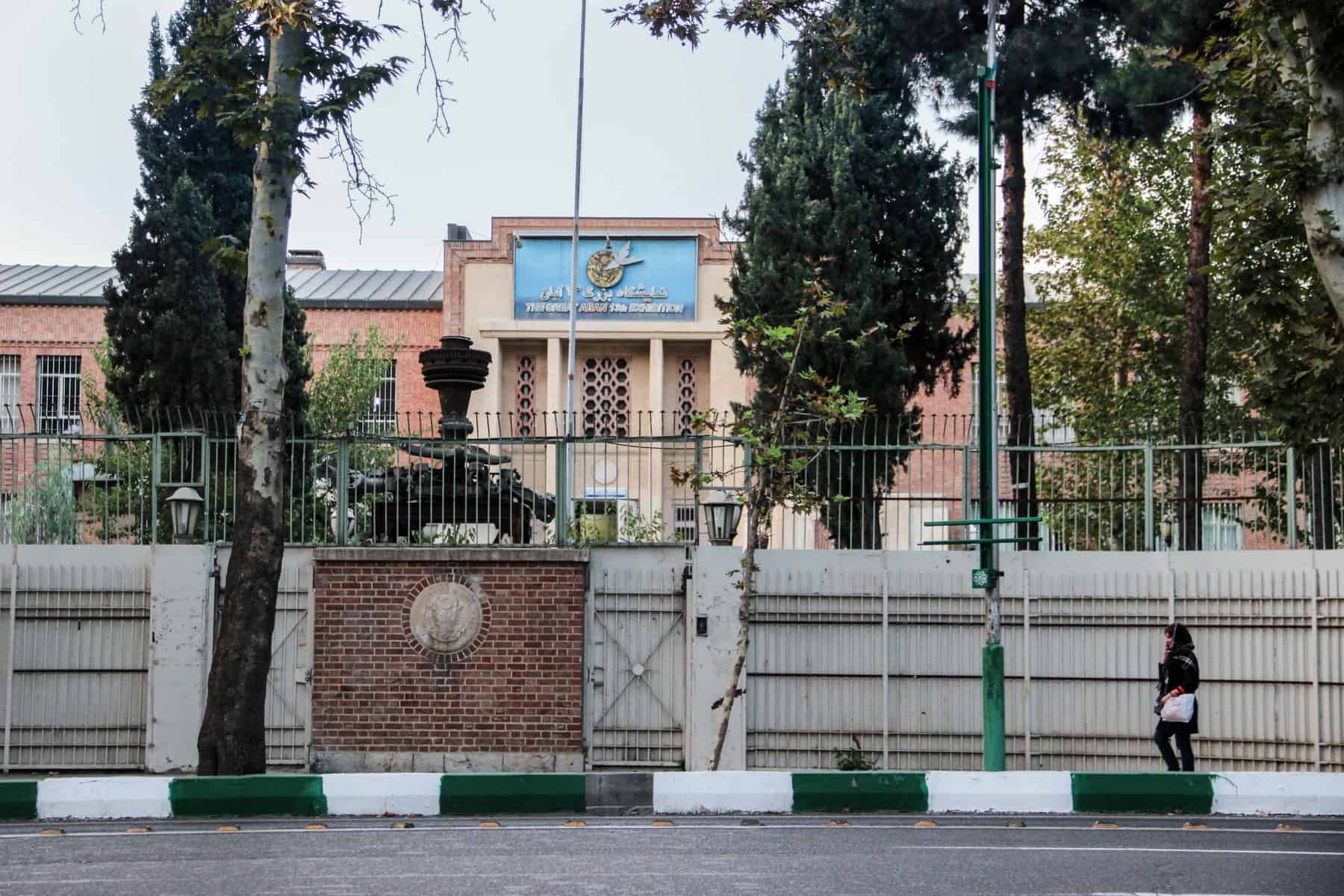
The former US Embassy in Tehran, Iran
As of February 2014, British and Canadian citizens going to Iran became subjected to the same ‘tour only’ sanction (official Iran tour operator or private Iran guide). As a result, your visa is usually only granted for the exact number of days of your tour, with a couple of days on either side if you list this as part of the arrival and departure options.
British passports holders should also pay attention to Foreign Office updates following strained relations between the two countries after the oil tanker seizure, as listed above in ‘Current Diplomatic Relations’.
Unfortunately, Israeli citizens cannot enter Iran at all, and this is unlikely to change anytime soon.
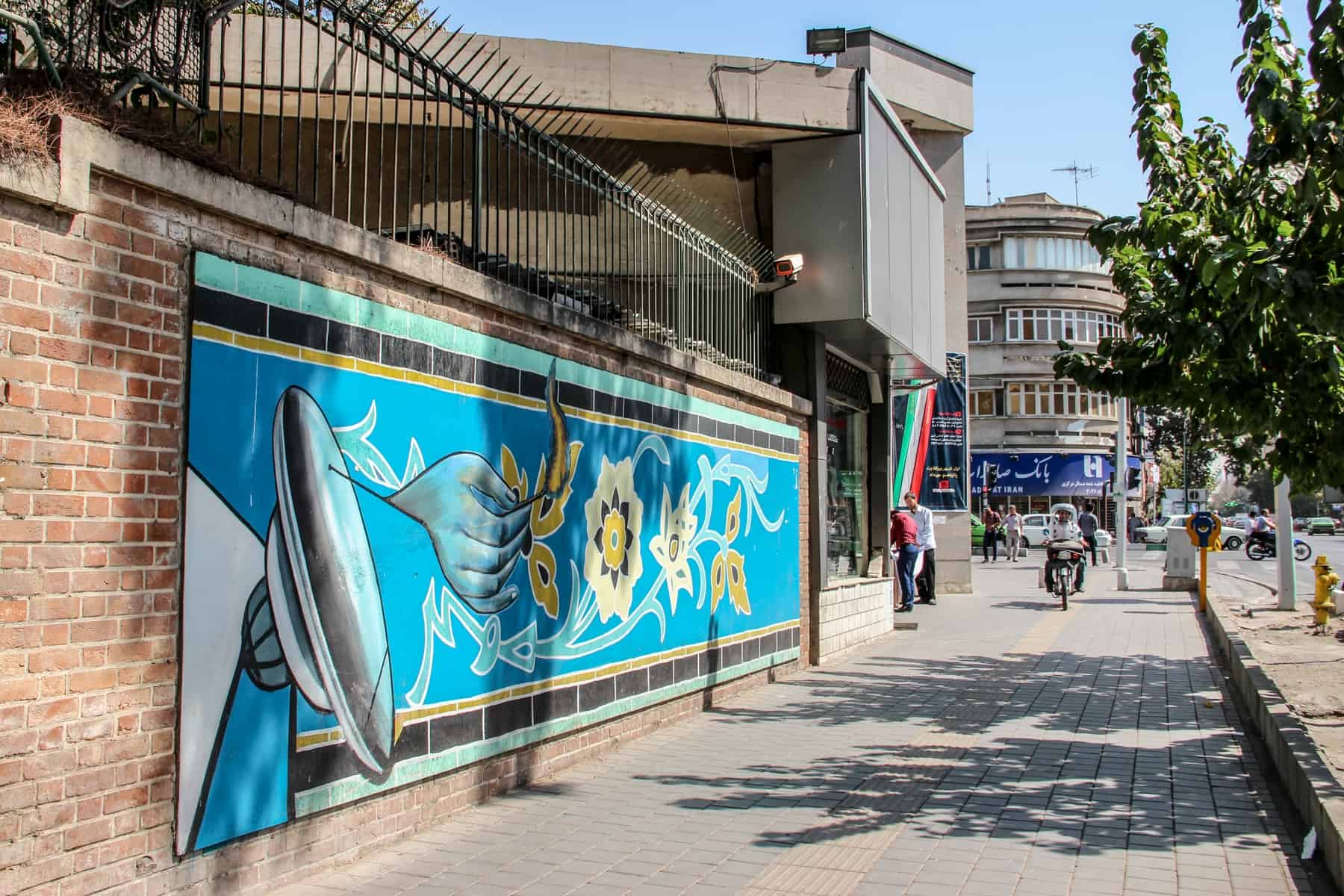
Check on any nationality restrictions before you visit Iran. It may mean having to join a tour and hire a guide.
While those booking up Iran holidays might choose a tour package for the fact that everything is taken care of on the ground and for ease of travel, I had no choice since I had a British passport.
There’s an overwhelming amount of Iran tour packages, and it can often be hard to know where to start. At the time, I travelled with G Adventures on a Discover Persia tour which operated through the revered Iranian agency AITO. I allowed myself free time to visit Tehran on either side of my trip, so I had a taste of both worlds, albeit on a small scale. Currently this trip is not running.
The upside to a tour, however nomadic and sporadic you usually are, is that these trips pack a real punch in getting you to many sites in 14 days. On the G Adventures Iran tour, I saw places I would not have been able to access easily on my own or with public transport. Plus, my local guide to Iran was the bundle of knowledge that a history and sociology geek like me needed for an ancient civilisation such as Persia. The downside of such holidays in Iran is a lack of free time and lazy resting for an itinerary that would normally, on my terms, take about three weeks, not two.
Being in a tour group when visiting Iran does not mean being chaperoned and watched 24-7. ven while on a small group tour, we were allowed time to ourselves in each destination.
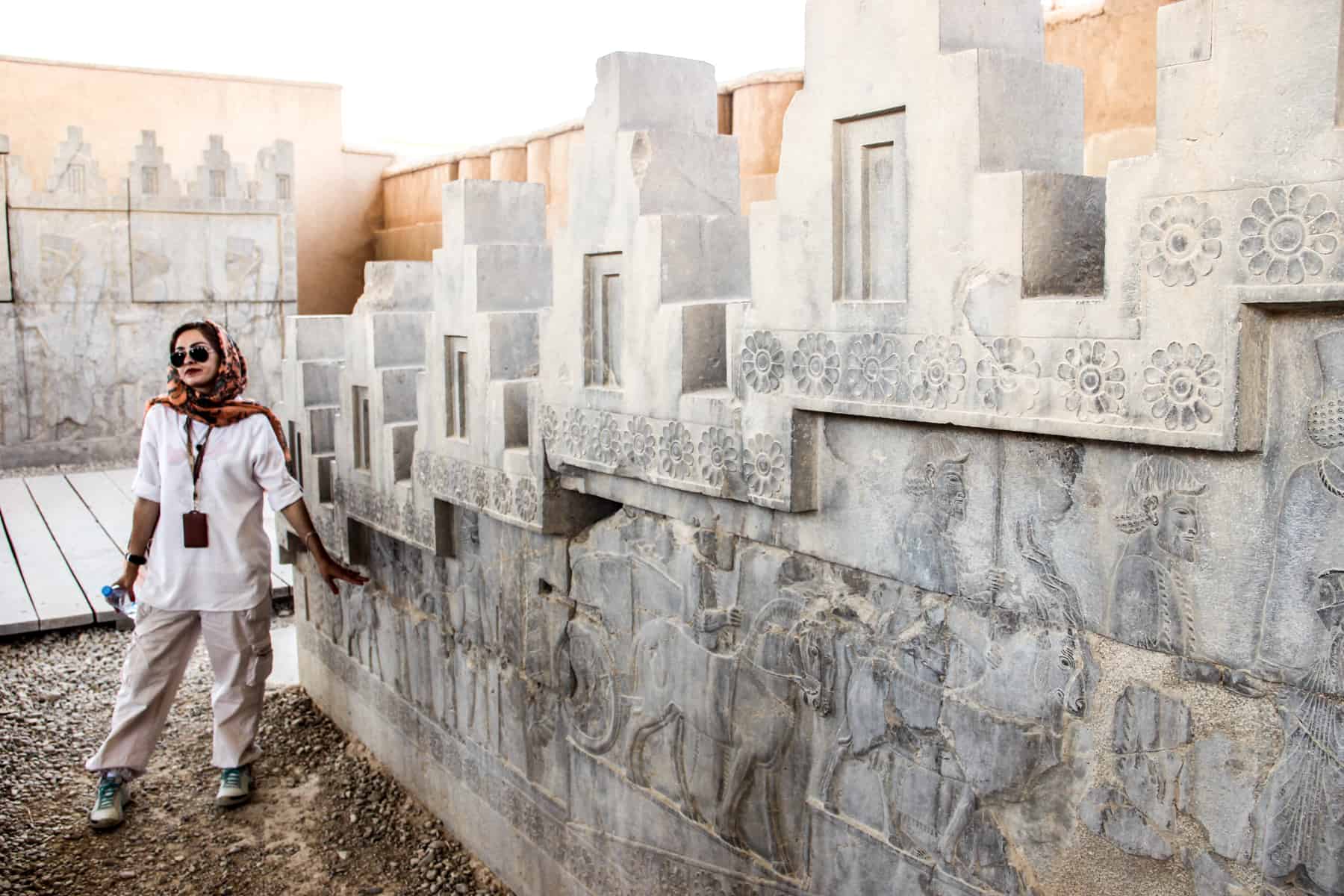
Choosing between and small group tour and a private guide – with a local who will show you all the historical places in Iran.
Generally, under the condition that you must have two people minimum, hiring a private tour guide in Iran is also an option. This is a viable option for those with visa restrictions who do not want to travel in slightly larger groups.
Come2Persia is a certified and reliable Iran travel agency run by a trusted Iranian friend of mine, Ali Reza Nokhostin, who I met and travelled with when in Georgia. He is both passionate about showing off his country and in changing perceptions of Iran. Specialising in incoming tours to Iran, Come2Persia also provides other travel services needed to complete the private tour package, including hotel bookings, visa application, transportation and access to various guides, not just Ali.
Note that while solo / independent travel is moderately easy in Iran (if of a free nationality), Iran is not that well-trodden on the independent travel path. There’s little to no hostels and guesthouses, and a dominance of big, expensive hotels (especially in Tehran) and even then it is rare to stumble upon a bunch of solo travellers to join.
However, solo travel in Iran is happening, and it is safe, it’s just a little more challenging than usual, which can, in itself, be pretty exhilarating.
Note that Couchsurfing in Iran is officially illegal, but it happens anyway. Nearly all independent travellers I have spoken to have mentioned that they have travelled here via this resource with your local hosts, of course, being the best guides. However, travellers looking to Couchsurf in Iran must be aware that they can not hold the Couchsurfing host responsible if anything goes wrong because there is no official ‘filter’ in place when it comes to the hosts listed online.
In a society where women are much more restricted than their male counterparts, to travel Iran as a solo female is a little harder and viewed with surprise/suspicion depending on where you go.
Also in Iran, since public displays of affection between males and females are not allowed, any harassment or inappropriate contact by an Iranian male to a female traveller would be frowned upon and draw attention.
Iran is one of the safest countries in the world based on tourists’ feedback. There have been many solo female travellers who have experienced Iranian hospitality and kindness.
However, it is vital to bear in mind that Iran is an Islamic country with traditional values and of course, some types of outfits would send the wrong message, especially in smaller and more conservative cities, such as Yazd, Kashan and Qom.
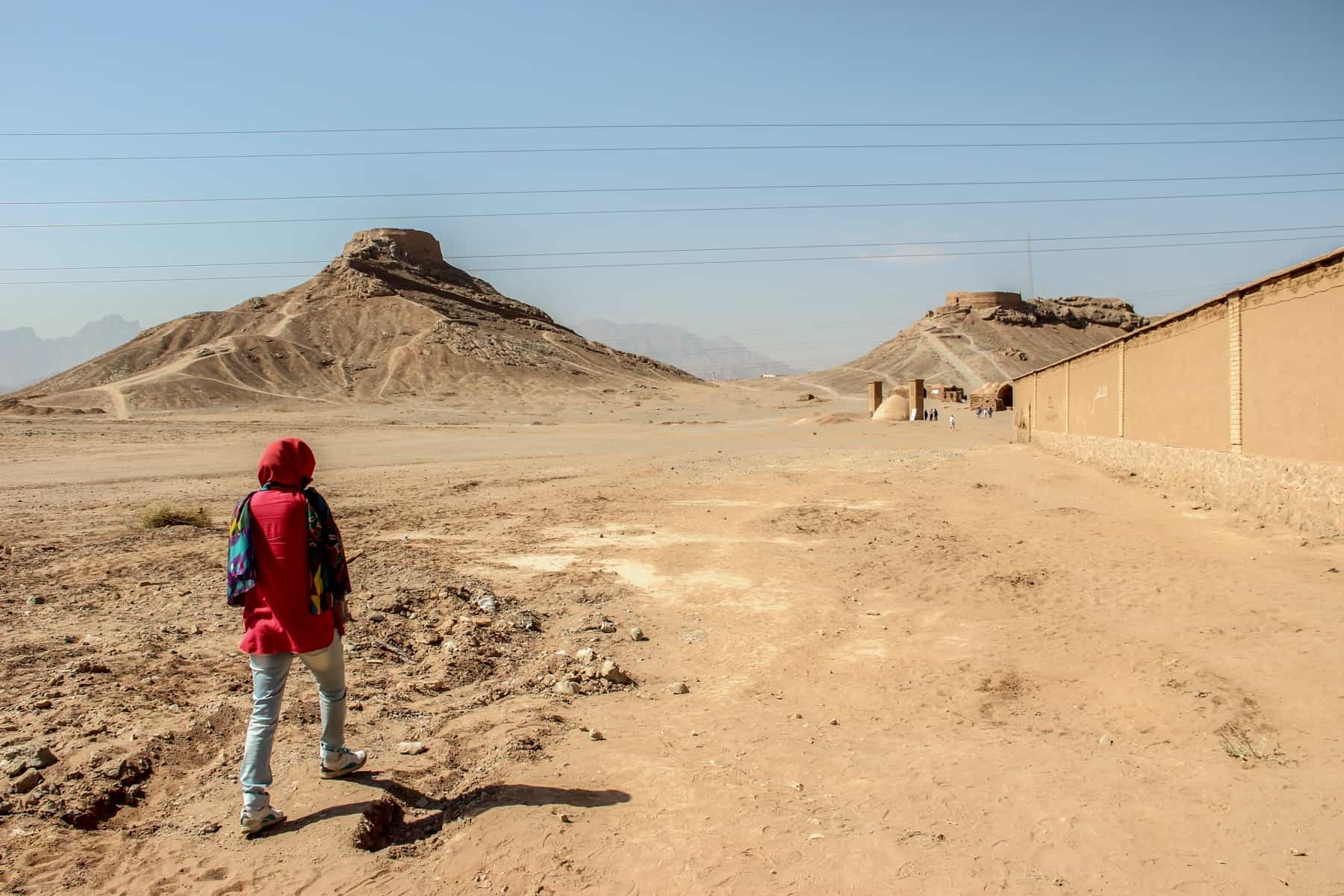
Solo female travel in Iran is safe, but with awareness of the conservative values of this Islamic country.
Iran is a four-season country, which means in different corners of the country, you can experience various climates at the same time. So, when is the best time to go to Iran, based on the different climates in the country? As a quick guide to Iran and its geographical mix, we can divide the country into three regions:
- From early March until late May
- From early September until late November
- There is one high season, from mid-April until mid-November
- Only one high season, from late November until late March
In between the high seasons from July to September is marked by high temperatures rendering travel on the classic route potentially uncomfortable.
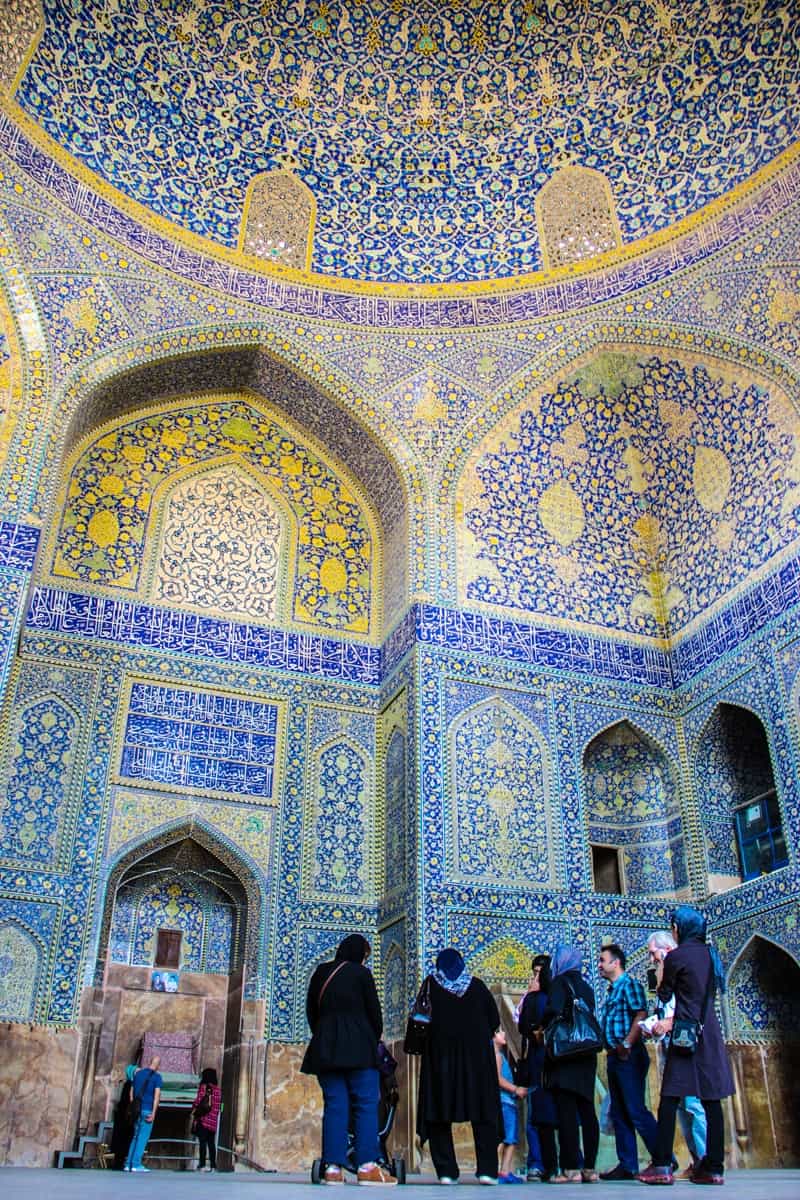
The stunning Sheikh Lotfollah Mosque is Isfahan is one of the must-see sites.
Iranians love to shout about the abundance of UNESCO World Heritage Sites. As my local friend stated, “It gives Iranians a lot of pride to possess such ancient lineage”.
Iran has 24 UNESCO World Heritage Sites – 22 cultural and two natural. Each of which is the result of years of investigation and presentation of evidence as to why they should be regarded as world heritage sites. It would take more than one trip to traverse them all.
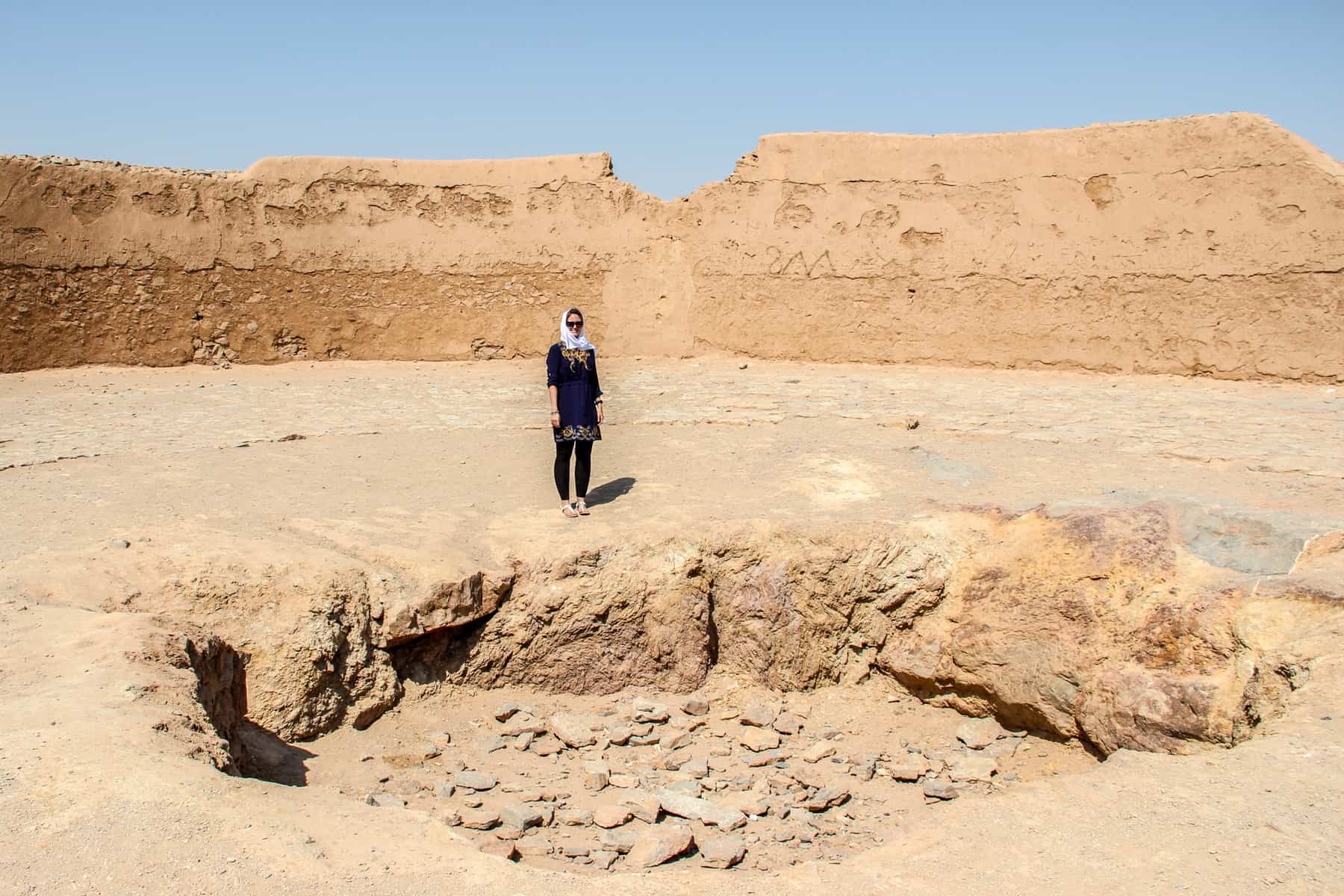
The Zoroastrian Towers of Silence in Yazd – one of the 24 UNESCO World Heritage Sites in Iran.
Dress Code in Iran – Headscarves and Hijabs
Iran does have a strict dress code, and this is one of the biggest concerns for female travellers to Iran. Most importantly – PACK A HEADSCARF IN YOUR HAND LUGGAGE. It’s called ‘Roosari’ in Farsi, and you MUST be wearing it the moment you exit the plane and are officially in Iran.
You must wear a headscarf the entire time you are in Iran (except when in your hotel room), as well as loose clothing that covers your body. But let’s get one thing straight – you don’t have to wear a burka or anything that completely hides you.
When you arrive, you will soon see that reality is far removed from the stereotype. Iranian women are super stylish and proud of their appearance – fashion being a means to stand out and make a statement.
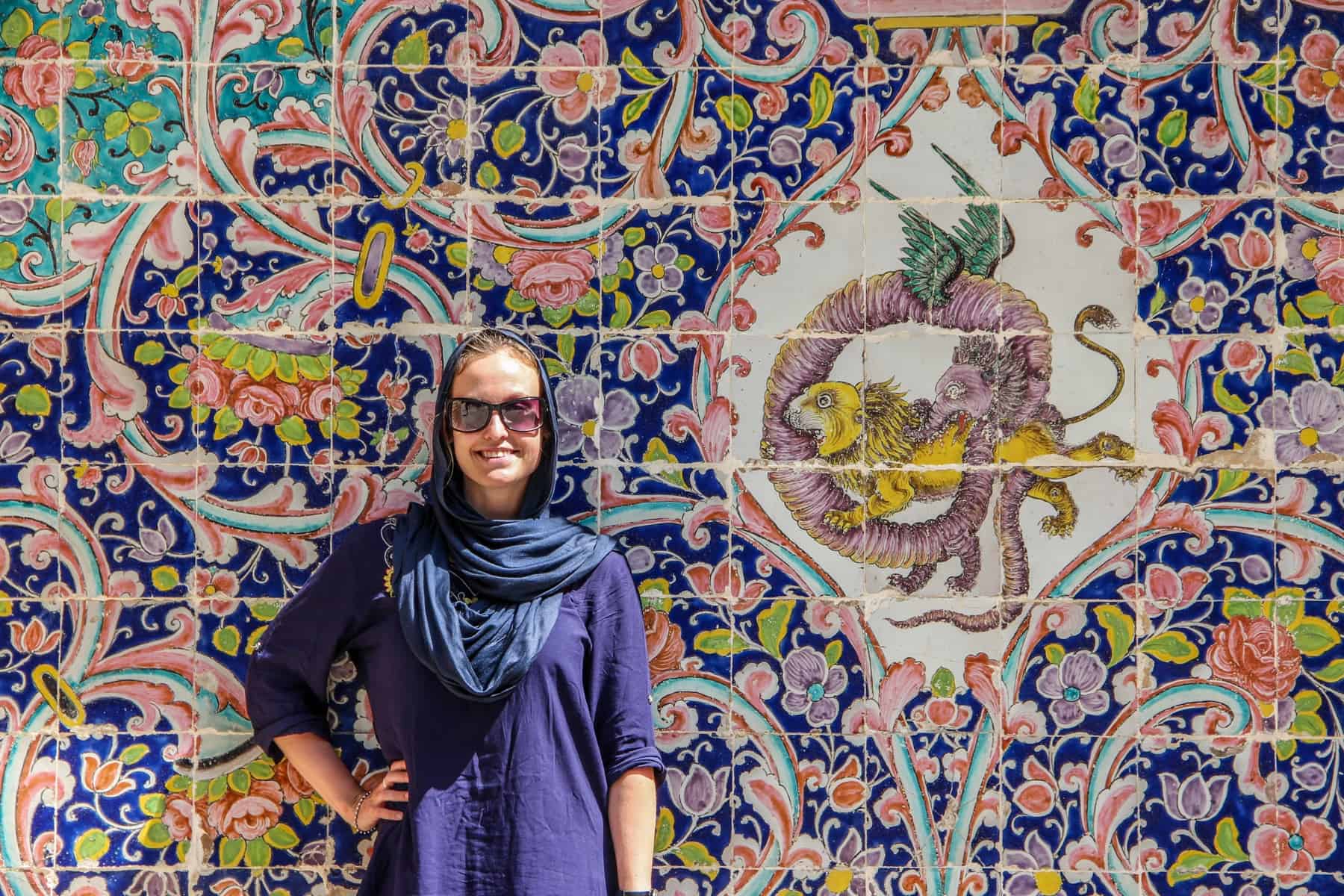
The dress code for women in Iran doesn’t have to be complicated.
The ‘Morality Police’ you hear of do exist in Iran but are not spending their time chasing down foreign visitors, so do not worry too much with that. If anything, you will get a polite mention. Visitors have a bit more flexibility when it comes to the rules.
- A headscarf is the most immediate essential item, and you can buy more when you are there) . If your headscarf falls, don’t worry – quickly put it back on again. You won’t be in trouble for this, but pay attention at all times. Wearing your hair in a high bun or ponytail helps keep the scarf in place. Many Iranian women wear it a little loose and halfway back on their head, since showing a little hair is granted.
- Tops must be loose-fitting, and three-quarter length sleeves are ok – a little more comfortable in the heat. The general rule of thumb is that the body should be covered and arms should not be bare.
- It is said that trousers must be baggy, but some local women wear tight, brightly coloured leggings. As long as your legs are covered down to the ankles, it is fine. For tourists, leggings worn with a long, loose-fitting top are acceptable. However, in the more conservative areas such as Isfahan, Mashad and Qum, respect the values and revert to looser fitting trousers.
- Colour of clothing. It’s a myth that you need to dress in dark colours or black tunics. Embrace fashion the ways the locals do and bring some colour into your Iran packing list!
- Open toes sandals are OK. Pack some sports shoes for longer day trips where you might be walking a lot (such as at the Persepolis). You’ll soon see how sports shoes are fashionable in Iran, especially in bright colours!
- Worried you do not have enough appropriate attire? Fear not, as soon as you arrive in Tehran or even Shiraz (if you fly into the city), hit the bazaars and the local markets . There’s plenty to be sought out. Other people on my trip stuck with two outfits and alternately hand-washed them every night.
- Strict dress codes do not apply in the same manner when travelling with children . Young boys can wear shorts and t-shirts and girls under ten are not required to wear a headscarf.
For men it’s more straightforward – you will be dressing much the same as you do in western countries, except no short shorts, no super short sleeves and no extreme tight-fitting clothing.
READ MORE: Iran Dress Code for Women (What to Wear in Iran)
Is Iran Safe? Is it Safe to Travel to Iran?
Iran’s image of being a terrorist-driven, American bashing, nuclear weapon holding, burka-clad society is something that has been highly driven mainly by western media. “Is Iran safe?” “Isn’t it dangerous in Iran?” are likely to be some of the first questions you encounter from others when you announce you are travelling here.
In short: Iran is a safe place to visit.
Since the election of the more moderate President, Hassan Rouhani in August 2013 and his re-election in 2017 , both international relations and internal rules have become less severe and slightly more open. It won’t take long before Iranians give you a warm welcome, ask where you are from or even invite you to dinner or tea.
It is a part of Iranian culture to go out of their way to help you, and it’s not uncommon to be given a phone number on a piece of paper or a business card in case you need to call upon someone.
The people of Iran are just as keen to show you they are the opposite of how they are portrayed, just as you should be teaching them that the western world doesn’t hate them.
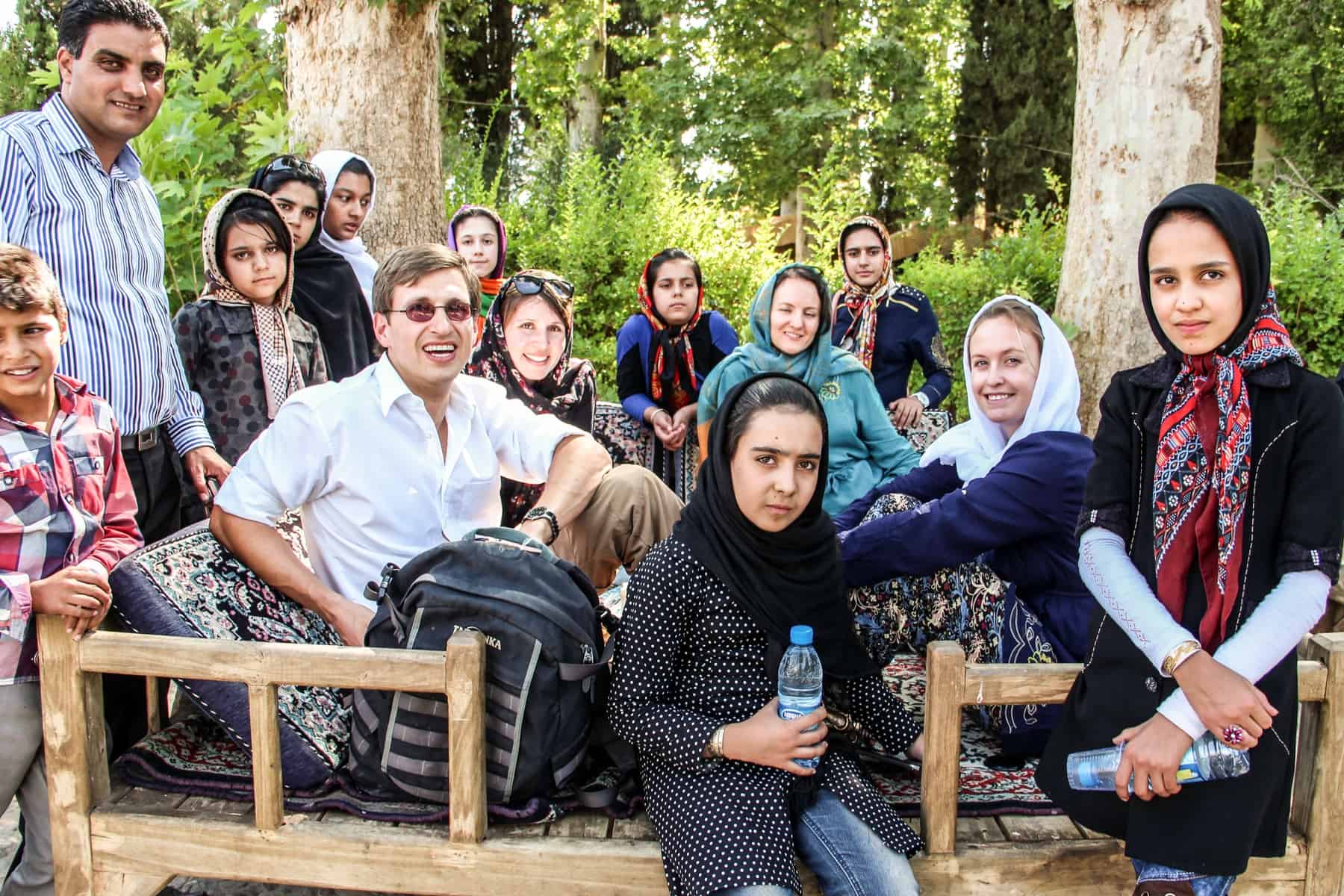
Is it safe to travel in Iran? Absoluely. Locals are very welcoming.
There’s never a right time for those who are worried, anxious or scared. Of course, you need to keep up to date with any significant political changes and your country’s diplomatic ties, but avoid listening to the hive of scaremongering out there and those who say don’t travel in Iran.
For example, in June 2018, there were protests about the economic situation in Iran, and these took place inside and around the Grand Bazaar in Tehran. It means being aware of any internal demonstrations and staying away from those areas, as you would in any country.
Iran remains as one of the most stable countries in the Middle East. While breaking the rules of Islamic society (including drinking alcohol, taking drugs and engaging in sexual activity with locals) can result in deportation, arrest or worse, general travel here is entirely safe.
Don’t assume you can break any rules in Iran, play the dumb tourist and get away with it. Iran is a Muslim country where Islamic law is strictly enforced.
An example of harsh punishment is with the case of the two Australians imprisoned in Iran for illegally flying a drone near a military installation, freed in October 2019, but as part of a political swap. It might seem that the punishment doesn’t fit the crime, but what is justified in your country can have harsher consequences elsewhere.
This is an Islamic State with a strict system, and if you can’t play by Iran rules, don’t go.
Given the location of Iran in the Middle East, the Muslim religion and some similarities in culture and language, the scaremongering of Iran can often revolve around the ‘it’s Arab’ misconception.
Iran is not an Arab country. Iranians are not Arabs. The language spoken is Persian (also known as Farsi) and not Arabic (although there are many languages spoken within Iran including Kurdish and forms of Turkish, Indo-European languages and Khuzi Arabic for example, due to the many ethnic groups that exist within the country).
Not only is the Arab misconception a source of contention generally, but Persians can take offence at these preconceived ideas.
Take US Dollars or Euros with you to Iran and change them up into Iranian Rial at the local exchange offices (not the dodgy guys on the street or at the hotels which have the lower government exchange rate). Before you know it, you have millions of Rials, and it all looks easy.
However, while ALL notes state ‘Rial’ there is another ‘currency’ or ‘super unit’ that is used – Toman – which is not listed on any note or coin.
Toman is used by locals and is one-tenth of the Rial total. 1 Toman = 10 Rial.
When I was first presented with a dinner bill of “37,000”, I was quietly happy that my food had cost the equivalent of $1.5, but this was, in fact, the price in Toman.
To convert to Rial, you simply add a zero – therefore my dinner was 370,000 Rial.
Lost? It takes a couple of days to get used to, but in the majority of cases, unless stated clearly, all prices are in Toman and not Rial. Hence, the basic equation anywhere in Iran is to add a zero onto printed prices (if ‘Rial’ is not listed), or ask market vendors and others which ‘currency’ they are operating in to save the confusion.
A big question is if you can use your credit or debit card in Iran. Sadly not, since there is no network in Iran for the use of international cards. It’s always been the best option to carry enough cash with you for your trip to convert to Iranian Rial on the ground.
However, there is now an Iranian prepaid debit card for tourists and temporary visitors called the Mah Card. Like most travel cards, you can instantly add funds to your card in your preferred or home currency, and it will convert it to Iranian Rial. It is more convenient than carrying cash, protects you from unauthorised purchases and is accepted country-wide.
To get 40% off the price of a Mah Card (Full price €19) enter BECKI at the checkout.
Public Transport in Iran – Options, Usage and Cost
When traveling in Iran, you have various options for public transport:
Intercity transport:
Private car
- Domestic flight
The Metro is available in several cities in Iran, mainly in Tehran; alongside Shiraz, Tabriz, Mashhad and Isfahan. It is the best option to get around in Tehran, and the stations are also easily accessible by taxi and buses. The ticket price for one trip is 1000 Tomans (approximately 25 cents). You can also buy a card to pay for the metro trips and even the buses in Tehran. The rush hours are mainly 7-9 a.m. and 5-7 p.m.
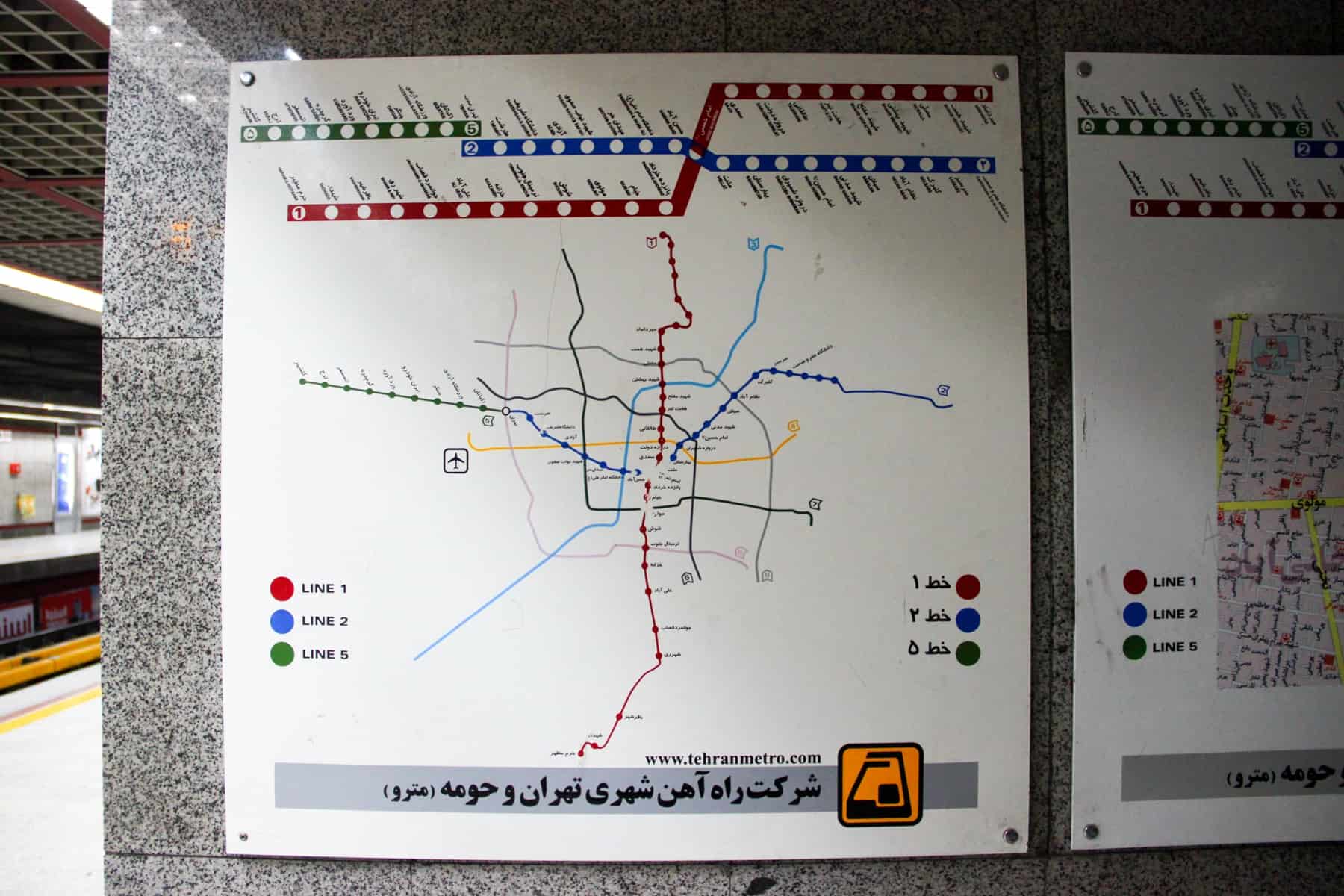
Tehran metro map and the three lines that cover the city.
You can find buses in every corner of the country. There are two main types of buses in big cities: regular and BRT. BRT buses are red, and because they have designated stations and paths, they are express buses. You can pay for the buses by your Metro card, and the fares would vary between 500 to 1000 Tomans (12 to 25 cents) per trip. You can find all the bus and BRT stations on Google Maps.
There are different types of taxis inside the cities:
- Shuttle/shared taxis (khatti): It is a way cheaper way to get around the cities. The two downsides are that they are for fixed destinations and you will have to wait for the taxi to be filled. The fares are also fixed, and you cannot negotiate.
- Private taxis (darbast): You can easily hail a taxi and say ‘darbast’. It means the driver will not pick any other passengers up and you must negotiate the price before getting on.
- Non-registered taxis (shakhsi): These are non-taxi drivers who you would easily spot from the yellow and green cabs. These are people who try to earn some money by giving people a ride. Again you must negotiate the price before getting on.
- Uber-like apps: Tap30 and Snapp are the two leading apps that you can easily use on your phone. Unfortunately, they’re not available on App Store and Google Play, but you can ask a local to help you with downloading them on your phone. Tap30 is available in many cities including Tehran, Karaj, Isfahan, Shiraz, Tabriz and Mashhad. Snapp is available in the same cities and also in Ahwaz and Qom.
- Bisim Taxi: You can also call the numbers 133, 1828 and 1833 in major cities in Iran to call a taxi wherever you are.
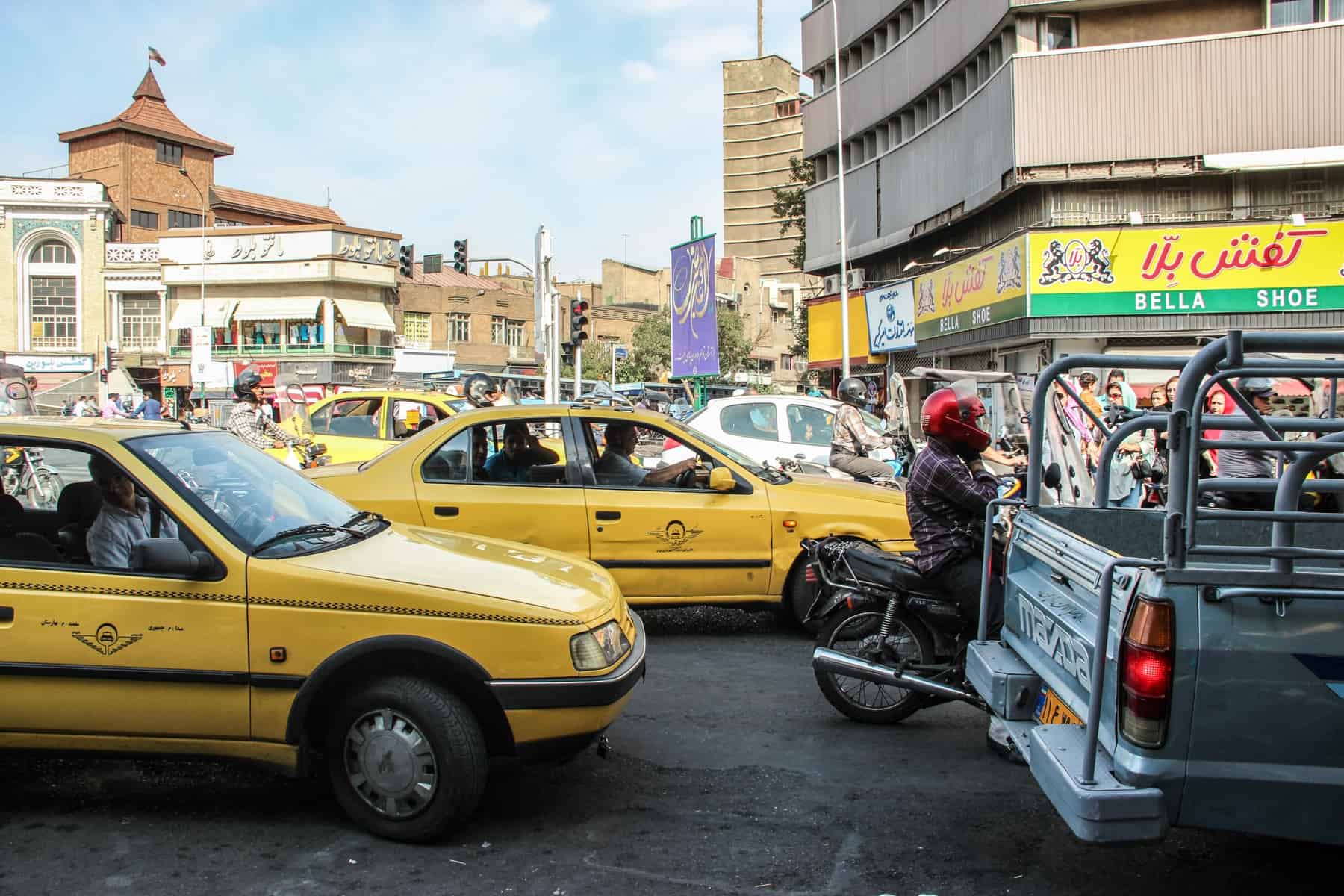
There are plenty of taxi options in Iran.
There are two types of buses between the cities in Iran: regular buses (44 people on board) and VIP buses (25 to 35 people on board). You have more legroom on VIP buses, and you can almost lie down on the seats. You can ask a receptionist at the front desk of the hotel, go to a local travel agency or go directly to the bus terminal to buy a bus ticket in Iran. The prices vary according to the type of bus and the distance. For example, the price for a VIP ticket from Tehran to Shiraz is around 70,000 Tomans ($16).
Using trains is the best and safest option to get around the cities in Iran. There are different types of trains: 4-bed, 6-bed and the so-called ‘bus’ trains. You can also ask if the train you are trying to take is an express train or a regular train. You can book trains through the hotels, local agencies or go directly to the train station. The price for a ticket from Tehran to Yazd, for example, is between 30,000 to 70,000 Tomans ($8 to $15).
You have two options to travel in Iran by a private car. You can hire a driver or a licensed driver-guide who can not only drive you from one city to another but show you the sites en route and give you all the information you need in English and other languages. You can find a driver-guide in Iran through TourHQ . You can either go to a taxi company or a local travel agency to hire a driver or a guide. Beware a killing machine in Iran named ‘Pride’ it’s a very low-quality car produced by Saipa company. It’s the worst car in Iran. Recommended cars in Iran are Peugeots and Samand by Iran Khodro Co.
Domestic flights
If you do not have much time on your hands and you want to visit the classic route (Tehran, Qom, Kashan, Isfahan, Yazd and Shiraz), it is recommended to take a domestic flight from Tehran to Shiraz. From there, you can continue your journey by other means of public transportation eventually back to Tehran. You can buy flight tickets from local travel agencies. The price of the flight ticket is approximately 180,000 Tomans ($40), and it takes around 80 minutes.
On the Metro: Generally, the cars are mixed gender, but if women need more privacy, they can get on the first and the last car on both sides.
On the Buses: In some buses, the women sit in the back and the men in front. Other times it is the opposite. However, a couple can sit together in the men’s section and not vice versa.
Different countries have different specifications, rules and warnings about travel to Iran – some way more dramatic than others. If you can, register or alert your foreign office about your whereabouts for safety and as a piece of mind measure. As a British citizen, with no embassy representation in Iran, this is more so a good idea.
Not that some travellers cannot secure travel insurance until they have alerted the relevant authorities of their travel plans. Hence, it is worth checking precisely who you need to inform before you depart, to be comprehensively covered.
Internet Access in Iran
Be prepared to take a forced ‘Digital Detox’ during your time in Iran. Internet in Iran is slow, all social media (except Instagram and What’s App) is blocked, and you usually are paying per hour for the privilege of a sluggish connection. While I sporadically got decent internet, which allowed my VPN to work, it was never superb. Want to look up sites in Iran? Super quick. Want to find some decent news in the outside world? Good luck.
Tell your family and friends that they may not hear from you that often, and be prepared to do without the connection, however hard it may be.
Irancell is the best phone operator in Iran which offers temporary SIM-cards designed for tourists. They offer a pre-paid 4G internet and credit balance, and when it is used up you can put in a new credit code sold at any supermarket all around Iran to increase your credit and buy internet packages.
You can only have only one VPN app on your phone, so you will need to test which one works best. For Android users, Hi VPN, Psiphon, Hotspot Shield are recommended, and for IOS users Psiphon, Free VPN, VPNProxyMaster and X-VPN are deemed to be the best VPN in Iran that work well at the moment.
Food in Iran (and Vegetarian Difficulties)
I had built up incredible visions of Persian cuisine in my mind before I got to Iran. I thought it would be everywhere – easily accessible and in abundance. Wrong.
Traditional Persian food is available, but you have to do some digging on where to go and find it. Try delicious vegetable and pomegranate stews, traditional Dizi (a lamb based strew where the broth is separated from the solids which are then mashed together and eaten separately) or Ash (a thick and tasty soup of lentils, beans, starch noodles, vegetables, fried mint, fried onion and yoghurt).
Other than that, you will realise that Iran’s streets are paved with fast food outlets, whose neon lights advertise the norm – kebabs, burgers and pizzas. Try and seek out the falafel places, since these are usually the best choice for a cheap and tasty fix.
Vegetarians have more of an issue. I travelled with a vegetarian and whether at a big buffet or a local teahouse or restaurant, what appeared to be the vegetarian option still had meat in it. It may mean living on aubergine/eggplant-based dishes, which are your safest bet, or begging for meat to be left out of your meal if not already pre-prepared.
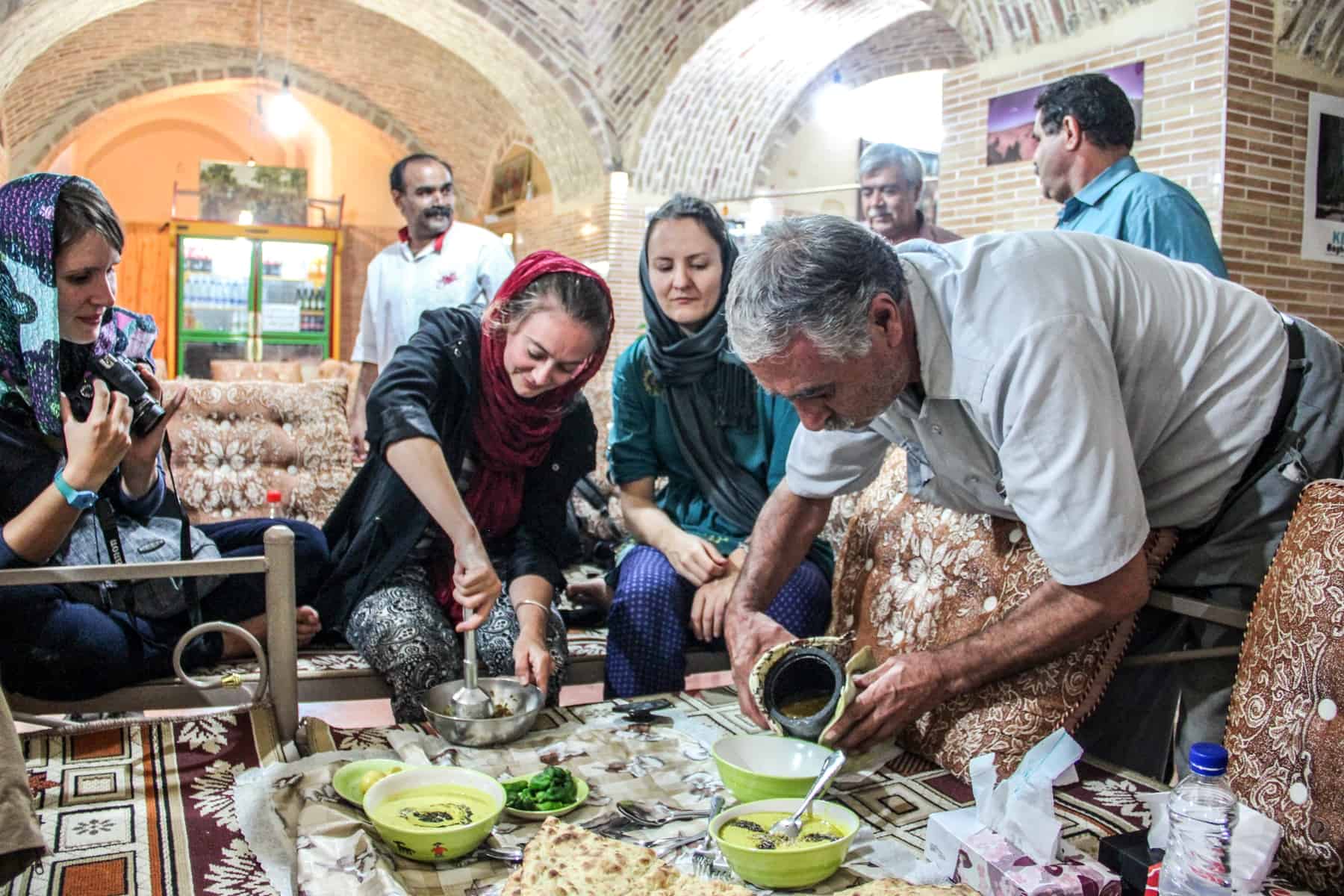
Food in Iran is better when locals show you real Persian cuisine.
There’s no alcohol in Iran. No bars, no clubs. Nothing. The best you get is non-alcoholic beer in a variety of fruity flavours like peach, lemon and strawberry which grace most menus.
There’s no set of different rules for travellers in Iran and those visiting. A local might be being kind in offering to find you the real deal at some underground gathering, but really, don’t take the chance. They might be able to waver the punishment; you won’t.
Like any country, it is crucial to know, understand and adhere to cultural and religious customs and rules that can often be very different from those at home. Here are the main rules for etiquette in Iran and interesting Iranian culture facts:
- One of the primary forms of social etiquette is TAROF, which is where Iranians usually insist on offering things to people and sometimes they do not mean it. However, you should not accept the first time.
- In Muharram month (the mourning month of Imam Hossein) people DO NOT usually wear bright colours (especially red) to respect the religious values.
- In Ramadan month , in which the majority of people keep fast during the day, it is disrespectful to eat and drink in public.
- In restaurants in Iran , it is incredibly unpleasant to see anyone clear their nose, especially loudly. In general, restaurant or not, it is also unusual to see somebody break wind.
- Shaking hands between men and women is a complicated topic. Generally speaking, it is not okay for men and women who are not related to shake hands. However, it is entirely relative. Usually, it is not advised for female tourists to extend their hand towards men, and it’s best to wait and see if the men do so first.
- The thumbs-up hand signal a derogatory sign in Iran, and it is best not to use it, especially in the presence of older people.
- When it comes to public displays of affection , you’ll see that affectionate touching, kissing, and shaking hands between men and women who are relatives are very normal. Iranian dating customs are more complex. You can kiss your significant other on the cheek, but french kissing strictly goes beyond the line. Holding hands is not something one would raise an eyebrow about at all, whereas hugging, on the other hand, would seem to be crossing the line a little. It is relative as to what extent the public display of affection is tolerated. For example, inside holy places and religious cities, it would not be easily tolerated.
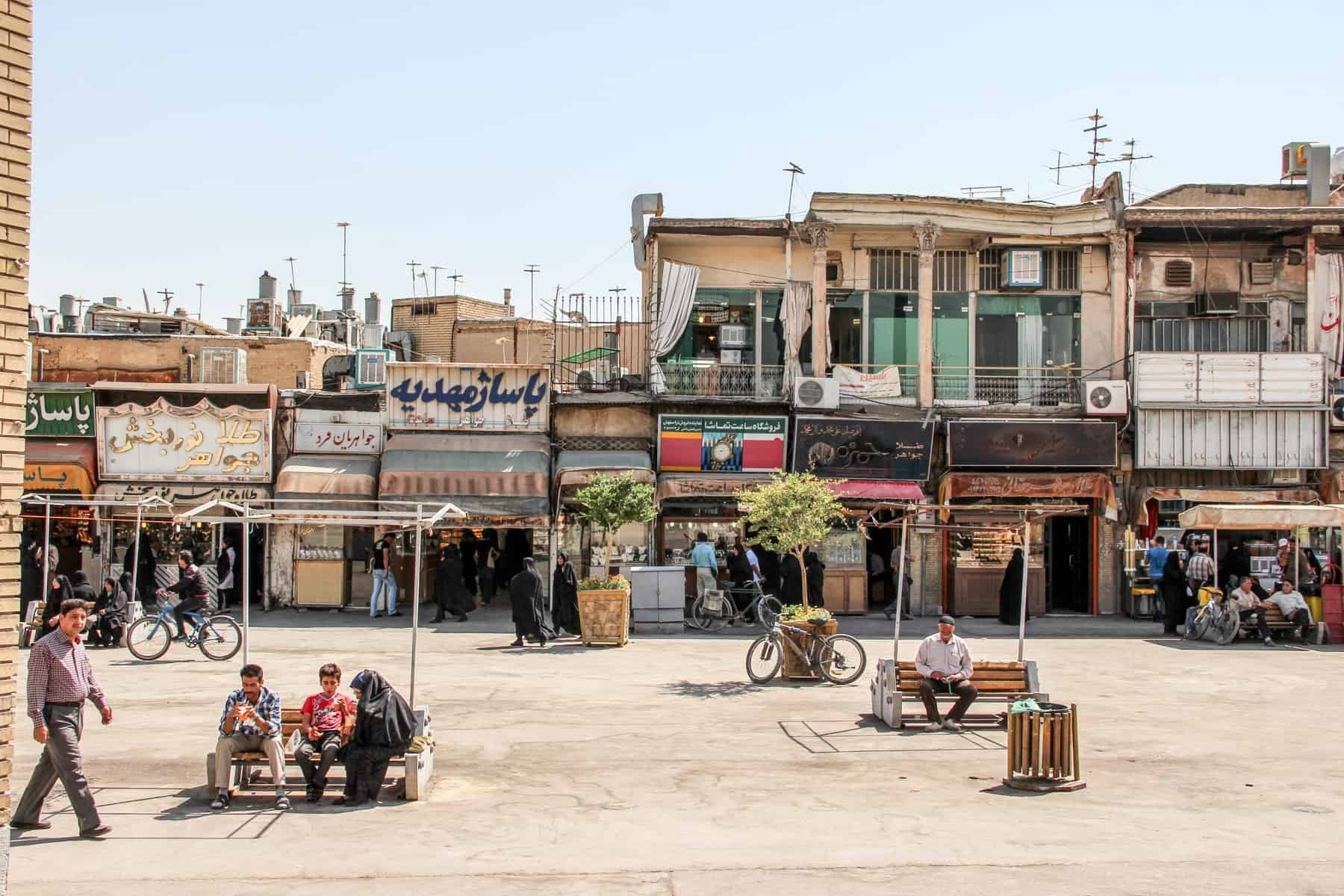
Wherever you are in Iran, it is important to adhere to cultural and religious customs and rules.
‘Persian Time’ is much like ‘Asian Time’ – things take much longer than you expect. When you travel Iran you’ll soon see that service is slower and the times you are given for things, like an arrival at a destination, are not always clear or roundabout correct, like this example:
Guide: “It takes four or five hours. So if we leave at 8 am, we will get there around 4 pm.”
Me: “But that’s eight hours, not four.”
Guide: “Yes, it takes about eight hours. We will stop at x, y and z on the way and arrive around 2 pm.”
In short, don’t rely on or worry about time, and pack a bit more patience than you would at home, especially when it comes to food, service and paying.
Ancient Persia isn’t an easily absorbed history lesson. While your guide (if you choose to have one or if you are a part of a tour group) will spout a level of information that will blow your mind, it is worth reading up on the history of Persia, as well as details on the lead-up to the Iranian Revolution in 1979. This will give a valuable understanding of the basic makeup of the country.
It will mean names like Zoroastrian, Cyrus the Great, the Achaemenid Empire, Reza Shah, Ayatollah Khomeini and Ayatollah Khamenei won’t be lost on you when you go to Iran.
Great books to read before you arrive include:
- Revolutionary Iran: A History of the Islamic Republic for a guide on the more recent history
Iran: What Everyone Needs to Know is by the same author, Michael Axworthy, and tries to explain how there’s more to Iran than its foreign relations, with part of the book also unravelling Iran’s economy, politics, culture and people.
Daughter of Persia: A Woman’s Journey from Her Father’s Harem Through the Islamic Revolution is about a woman who was born in Iran, left to study in the States and returned to a country in the grip of profound change.
- The Wind in My Hair: My Fight for Freedom in Modern Iran about a journalist in exile after being arrested for political activism
Best for when on the road:
- Easy reference for most of us came from the Lonely Planet Iran guide book . While it shouldn’t be your sole source of information, this particular Lonely Planet is a quick fix Iran travel guide, especially for historical hotspots. Having this paper guide was a handy resource for the entire trip, especially since quick access to the internet in Iran both at the hotels and while on the road is very limited.
Have you been to Iran? Are there any other pre-departure tips you would add? And if planning a trip there, and what difficulties are you facing, if any?
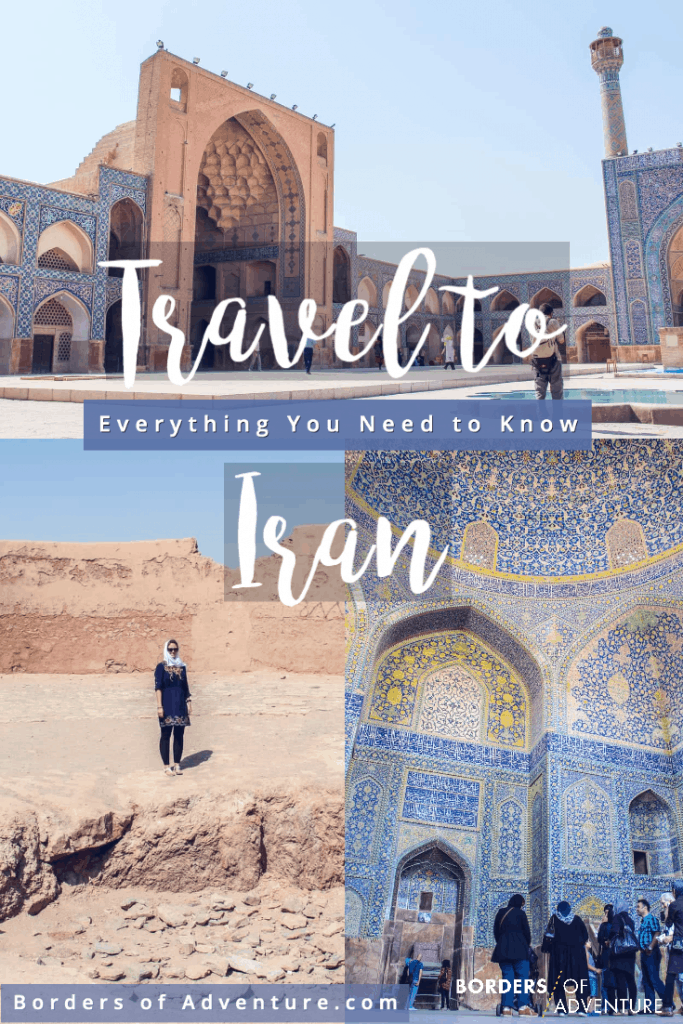
Any plagiarism of this Iran travel blog or any of its descriptions used on other sites and blogs without attribution is not information authorised by myself for use. Know your source.
About Becki
Becki Enright is a British Travel Press Award-winning writer whose work focuses on changing perceptions about misunderstood aspects of destinations. Her writing combines storytelling with insight into the social, historical, political and economic factors that shape the country or place in relation to tourism. Becki has appeared live on Sky News and CNN and has contributed to high profile media including National Geographic, Time.com, Guardian online, New York Times, Grazia and Buzzfeed.
Marcela says
19 April 2022 at 7:42 pm
Hi, is it possible to rent a car without a driver in Iran? Thanks, I loved your post!
28 April 2022 at 11:39 am
I think you can, yes! However, it isn’t something I know much about.
Hanieh says
28 March 2022 at 8:19 pm
Iran and Tehran are great🤩
7 August 2021 at 4:02 pm
Hello. I want to thank for this text. It is completely true about Iran and I as an Iranian approciate that describe Iran and Iranians truly. I really enjoy it. Most of Iranians think people of world consider us as a terrorist country while people of Iran differ from Republic Islamic Iran.
Miranda says
24 October 2019 at 8:53 am
I really like to travel to Iran, but I don’t know when is the best time to travel there, what is your recommendation?
24 October 2019 at 10:52 am
Hi Miranda. All the details are in the article. You can find an overview of the best time to visit Iran here: https://www.bordersofadventure.com/travel-to-iran-things-to-know/#When_is_the_Best_Time_to_Visit_Iran
- Article Archives
- Work with me
- Privacy Policy


- Kindle Store
- Kindle eBooks
Promotions apply when you purchase
These promotions will be applied to this item:
Some promotions may be combined; others are not eligible to be combined with other offers. For details, please see the Terms & Conditions associated with these promotions.
Buy for others
Buying and sending ebooks to others.
- Select quantity
- Buy and send eBooks
- Recipients can read on any device
These ebooks can only be redeemed by recipients in the US. Redemption links and eBooks cannot be resold.

Download the free Kindle app and start reading Kindle books instantly on your smartphone, tablet, or computer - no Kindle device required .
Read instantly on your browser with Kindle for Web.
Using your mobile phone camera - scan the code below and download the Kindle app.

Image Unavailable

- To view this video download Flash Player
Follow the authors

Lonely Planet Iran (Travel Guide) Kindle Edition
Lonely Planet Iran is your passport to the most relevant, up-to-date advice on what to see and skip, and what hidden discoveries await you. Hike among the Castles of the Assassins in Alamut Valley, Lose yourself in Esfahan's historic bazaar, or ski in the Alborz Mountains -all with your trusted travel companion. Get to the heart of Iran and begin your journey now!
Inside Lonely Planet Iran Travel Guide:
- Full-colour maps and images throughout
- Highlights and itineraries help you tailor your trip to your personal needs and interests
- Insider tips to save time and money and get around like a local, avoiding crowds and trouble spots
- Essential info at your fingertips - hours of operation, phone numbers, websites, transit tips, prices
- Honest reviews for all budgets - eating, sleeping, sight-seeing, going out, shopping, hidden gems that most guidebooks miss
- Cultural insights give you a richer, more rewarding travel experience - festivals, cuisine, religion, history, architecture, literature, music, crafts, environment
- Over 50 maps
- Covers Tehran, Esfahan, Yazd, Shiraz, Persepolis, Kashan, Choqa Zanbil, Takht-e Soleiman, Tabriz, Masuleh, Mashhad, Garmeh, Alamut Valley, Alborz Mountains, Kaluts, Qeshm Island and more
The Perfect Choice: Lonely Planet Iran , our most comprehensive guide to Iran, is perfect for both exploring top sights and taking roads less travelled.
Looking for more extensive coverage? Check out Lonely Planet Middle East guide.
About Lonely Planet: Since 1973, Lonely Planet has become the world's leading travel media company with guidebooks to every destination, an award-winning website, mobile and digital travel products, and a dedicated traveller community. Lonely Planet covers must-see spots but also enables curious travellers to get off beaten paths to understand more of the culture of the places in which they find themselves. The world awaits!
Lonely Planet guides have won the TripAdvisor Traveler's Choice Award in 2012, 2013, 2014, 2015, and 2016.
'Lonely Planet. It's on everyone's bookshelves, it's in every traveller's hands. It's on mobile phones. It's on the Internet. It's everywhere, and it's telling entire generations of people how to travel the world.' - Fairfax Media
'Lonely Planet guides are, quite simply, like no other.' - New York Times
- Print length 962 pages
- Language English
- Sticky notes On Kindle Scribe
- Publisher Lonely Planet
- Publication date September 1, 2017
- File size 77235 KB
- Page Flip Enabled
- Word Wise Not Enabled
- Enhanced typesetting Enabled
- See all details
Customers who bought this item also bought

Product details
- ASIN : B072LXRPYK
- Publisher : Lonely Planet; 7th edition (September 1, 2017)
- Publication date : September 1, 2017
- Language : English
- File size : 77235 KB
- Text-to-Speech : Enabled
- Screen Reader : Supported
- Enhanced typesetting : Enabled
- X-Ray : Not Enabled
- Word Wise : Not Enabled
- Sticky notes : On Kindle Scribe
- Print length : 962 pages
- #7 in Southwest Asia Travel
- #9 in Iran Travel Guides
- #42 in Middle Eastern Travel
About the authors
Lonely planet.
With over 150 million guidebooks in print, Lonely Planet is a trusted source for any traveler. Since our inception in 1973, we've inspired generations of travelers to discover amazing places and enabled curious travelers to get off the beaten paths to appreciate different cultures and become agents of positive change.
Mark Elliott
Mark Elliott is an English travel writer best known for travel books and articles on Azerbaijan, and for unusual map-based route guides for Asia. His first major work, Asia Overland, (co-authored with Wil Klass) was an ultra-budget manual for those wishing to cross the continent in the pre-Internet era. It garnered something of a cult following among overland travellers of the day as did the 2003 regional follow-up, Southeast Asia Graphic Guide. Elliott has contributed to around 50 Lonely Planet books covering destinations from Bosnia to Belgium, Iran to Taiwan.
Customer reviews
Customer Reviews, including Product Star Ratings help customers to learn more about the product and decide whether it is the right product for them.
To calculate the overall star rating and percentage breakdown by star, we don’t use a simple average. Instead, our system considers things like how recent a review is and if the reviewer bought the item on Amazon. It also analyzed reviews to verify trustworthiness.
- Sort reviews by Top reviews Most recent Top reviews
Top reviews from the United States
There was a problem filtering reviews right now. please try again later..
Top reviews from other countries
Report an issue
- Amazon Newsletter
- About Amazon
- Accessibility
- Sustainability
- Press Center
- Investor Relations
- Amazon Devices
- Amazon Science
- Sell on Amazon
- Sell apps on Amazon
- Supply to Amazon
- Protect & Build Your Brand
- Become an Affiliate
- Become a Delivery Driver
- Start a Package Delivery Business
- Advertise Your Products
- Self-Publish with Us
- Become an Amazon Hub Partner
- › See More Ways to Make Money
- Amazon Visa
- Amazon Store Card
- Amazon Secured Card
- Amazon Business Card
- Shop with Points
- Credit Card Marketplace
- Reload Your Balance
- Amazon Currency Converter
- Your Account
- Your Orders
- Shipping Rates & Policies
- Amazon Prime
- Returns & Replacements
- Manage Your Content and Devices
- Recalls and Product Safety Alerts
- Conditions of Use
- Privacy Notice
- Consumer Health Data Privacy Disclosure
- Your Ads Privacy Choices
Independent travel in Iran: 1 to 4-week itinerary
By Joan Torres 8 Comments Last updated on April 1, 2024
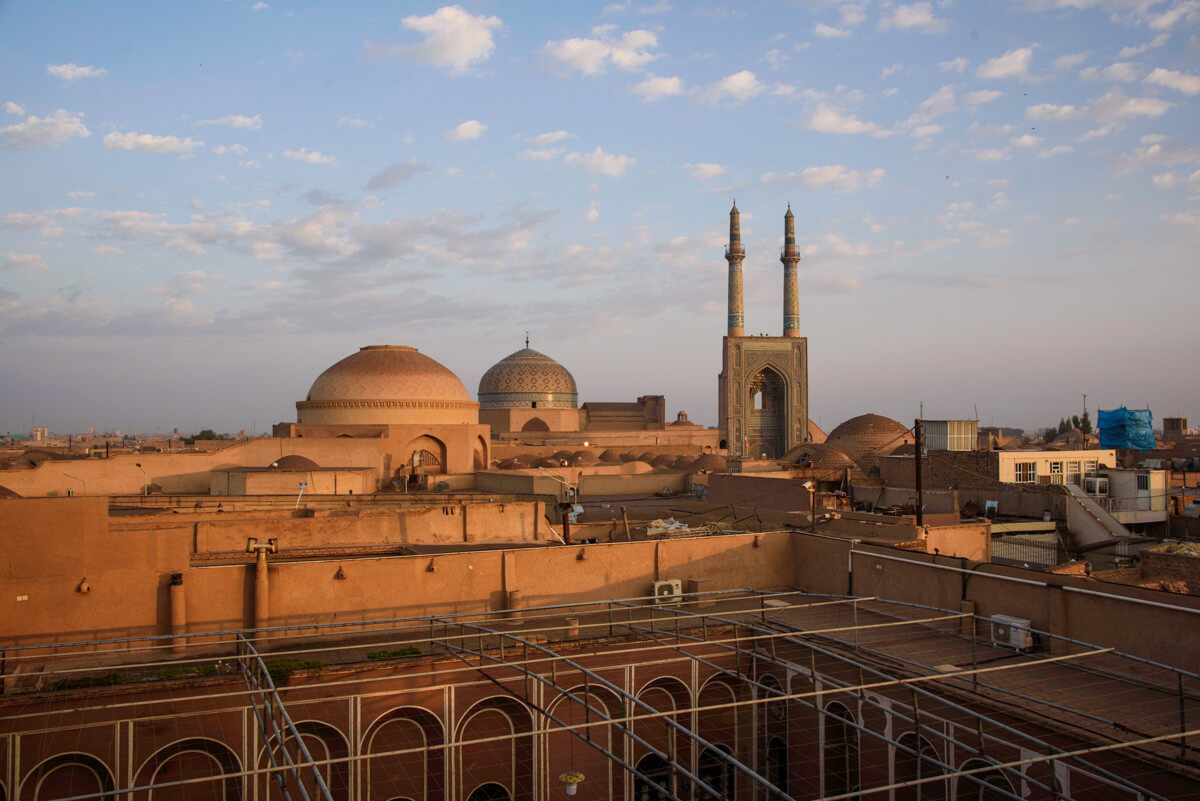
Skip all content and get ExpressVPN
Get unrestricted access with the fastest VPN for Iran country.
Iran, the hottest destination of the decade, is a country filled with a very old history, mind-blowing architecture and amazing people.
The country is, however, extremely big, has been inhabited for millennia and was ruled by one of the most powerful empires that ever existed in human history.
As a consequence, Iran is, today, an extremely complex society home to an infinite number of historical sites, many of which are not open to the public yet.
And there is even more.
With some striking mountain ranges, the Persian Gulf islands, unique deserts and countless towns and cities with different kinds of people and culture, Iran is a country which you can’t finish, not in a lifetime at least.
However, whether you come here for a week or a month, getting a glimpse of the great power of the Persian empire or getting to know some locals over a cup of local chai is totally possible.
After visiting the country twice for more than months, I have compiled this 1 to 4-week itinerary for independent travel to Iran that contains my favorite places in the country.
It took me almost two months to visit all the places I mention, spending 4 to 5 days on each one, which is a lot of days. However, if you plan well-ahead and stay 2 or 3 days in each one, you could perfectly squeeze my Iran itinerary in a month.

In this backpacking itinerary for Iran you will find:
Table of Contents
- Moving around
- Accommodation
- Day 1, 2 – Tehran
Day 3, 4 – Kashan
- Day 5, 6, 7 – Esfahan
Day 8, 9 – Yazd
- Day 10, 11, 12 – Kaluts
Day 13, 14 – Shiraz
- Day 15, 16, 17 – Mashhad
- Day 18, 19 – Gonvad e-Qavus
- Day 20, 21 – Khalid Nabi
- Qeshm Island – 3 days
- Masuleh – 3 days
- Tabriz – 3 days
- More resources
How to book hotels, flights and tours in Iran
Because of the sanctions, foreign cards or popular sites such as booking.com can’t be used in Iran, but now you can thanks to 1stQuest .
1stQuest is a local company that offers services such as visa LOI, hotel booking, tours, domestic flights, and travel insurance for Iran.
5% discount on ALL bookings with voucher code:
How to travel independently around Iran (Transportation)
Iran is an extremely easy country to move around, as it has a very well-connected bus network and plenty of domestic flights.
Domestic flights
Iran is a pretty big country, so for those short in time, taking a domestic flight would be wise, especially for going from Tehran to places like Qeshm Island, Mashhad or Shiraz.
You can check flight schedules and book your tickets through 1stQuest, and you can get a 5% discount on ALL flights:
With voucher code: ATC-QST
Bus – Buses are the way to go in Iran. There are endless connections and the VIP buses are particularly comfortable and not expensive at all.
Because of the sanctions, in Iran, most booking sites don’t accept international foreign cards. Before, you could book them via 1stQuest but they are not offering this particular service anymore. However, you may still use 1stQuest for visa services, hotels, flights, travel insurance and tours.
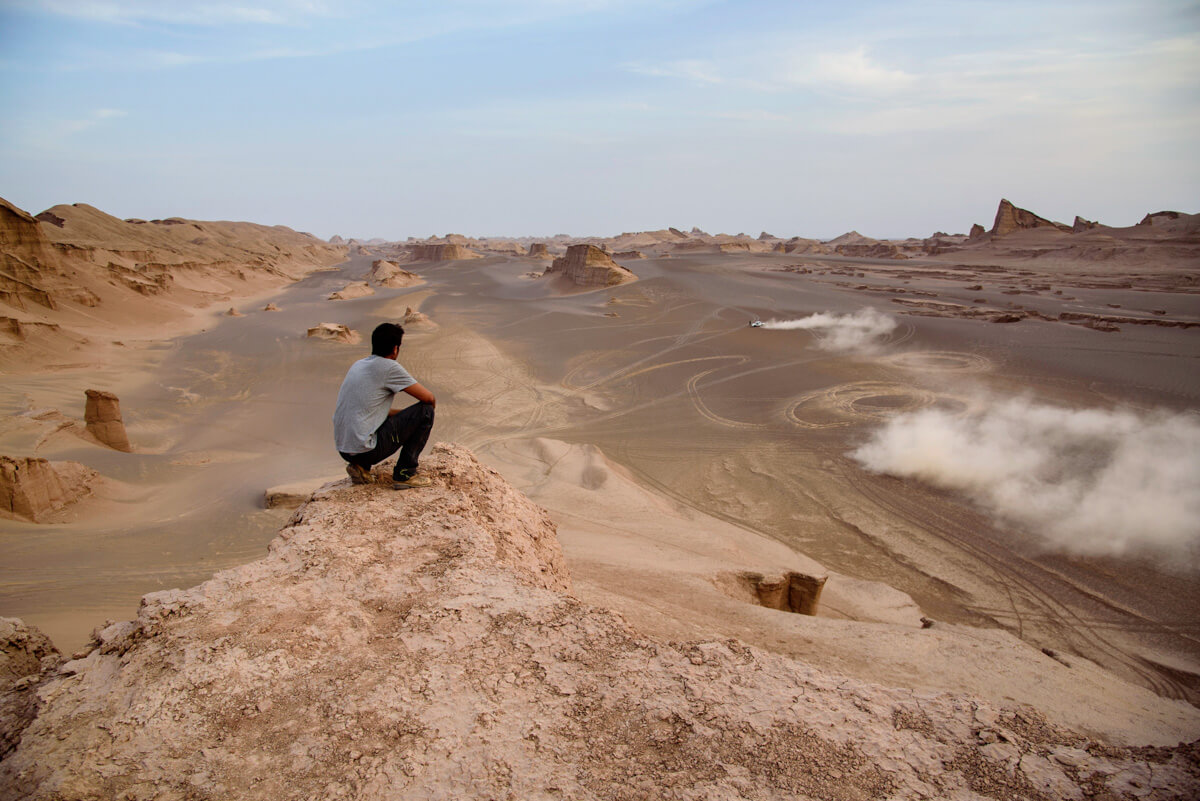
Accommodation in Iran
As you may know, popular websites such as Booking.com , don’t have hotels listed in Iran.
Therefore, how can you book a hotel in Iran? Well, you have a couple of options:
- Via your travel agency (if you go on a tour)
- Making a phone call
- Just showing up and trying your luck
- Via a local booking website like 1stQuest
From luxury hotels to backpacker hostels, 1stQuest has many listed hotels all over the country.
You can get a 5% discount in ALL your hotels bookings.
Use my promotional code: ATC-QST
Side note – Keep in mind that the Iranian Government sometimes blocks this sort of travel websites, so 1stQuest may not be accessible from an Iranian server. In this case, there are 2 things you can do: 1 – Book the different hotels in advance, before going to Iran 2 – Get a VPN for Iran like ExpressVPN to access censored sites. CLICK HERE TO LEARN MORE
Best books for backpacking in Iran
Here’s a selection of a few useful books but, for a complete list, check the best books about Iran , classified into politics, history and novels
Bradt guide – Bradt has always the most comprehensive guides to the most off-beat countries. I love Bradt because they give plenty of tips for the independent traveler, as well as loads of cultural insights.
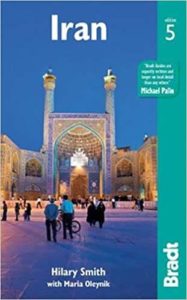
Lonely Planet guide – I personally prefer Bradt but, if you are a Lonely Planet fan, they have just released their latest edition for Iran.

Best graphic novel – Persepolis – This is, perhaps, the most famous story ever written about Iran. It is the story of a non-religious woman, before and after the 1979 revolution. An easy way to understand the complexity of Iranian society.
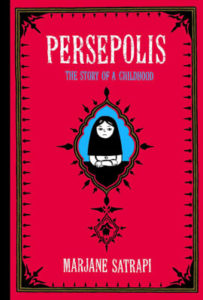
Independent travel in Iran – 1-week Iran itinerary
Iran is a massive piece of land so, if you only have one week, after Tehran, the closest cities are Kashan and Esfahan.
In Iran, you have to pay to enter most sites, including all the mosques, gardens and museums I am suggesting in this article. Usually, most sites charge between 150,000 and 200,000IR , which is 5 to 10 times more than what the locals have to pay
Map of the one-week Iran travel itinerary
Day 1 – Tehran
The capital of Iran is a real chaotic metropolis, where you can find an extremely mixed society, both the traditional, conservative Iran and the most hipster people in the country.
From ancient bazaars to 21st-century malls, Tehran is a very surprising city that could you keep busy for several weeks. This mixed society reminded me a lot to Beirut .
If you are lucky and the sky is clear, you must go to Tabi’at Bridge , the place from where you get the best views of the Tehran skyline.
Also don’t forget to check out the Grand Bazaar of Tehran , a real maze of bustling streets and carpet shops, and Golestan Palace , located in the middle of the city jungle but where you find beautiful gardens and the classic, colorful Persian tiles Iran is famous for.
A lot of people who visit Iran also go to Caucasian countries. Read my ultimate guide for traveling to Georgia
Moreover, if you are into politics, don’t forget to check out what used to be the actual USA Embassy before the 1979 revolution, as today it is a museum with plenty of anti-American propaganda.
Last, if you wanna take a break from all the chaos, go to Darband , located at the bottom of Mount Tochal and almost reachable by metro. With plenty of waterfalls and small day-treks, this was my favorite spot in the city.
For more information, read: Things to do in Tehran in 2 days
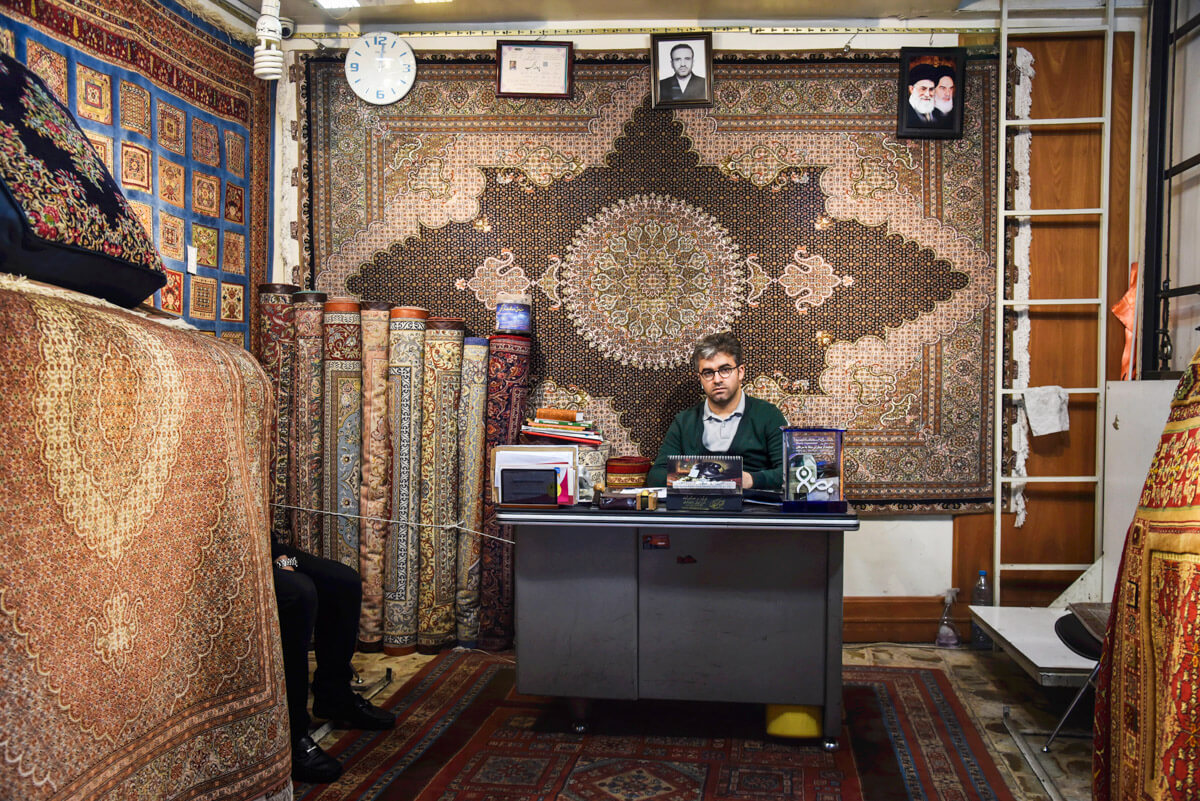
The best tours in Tehran
- Old Town Tehran – Oudlajan is the old quarter of Tehran and this walking tour will take visit all highlights.
- The Armenian Quarter – Tehran is home to a large Armenian Christian population and in this tour you will explore the area where they live.
- Golestan Palace – One of the top attractions in Tehran.
You can get a 5% discount on ALL your tours.
Where to stay in Tehran
You can get a 5% discount on ALL your hotel bookings.
Backpacker Hostel – Heritage Hostel – Plenty of common areas, a beautiful garden with a Persian pool, a barbecue place, and very modern facilities. I honestly think that this is the best hostel in the country and the best choice for independent travelers in Iran.
Budget Hotel – Khayyam Hotel – A cheap option, but very good, option near the Grand Bazaar of Tehran, so this is a great choice for budget travelers that don’t want to stay in a hostel.
A bit nicer – Hejab Hotel – A good option for mid-range travelers.
For more options, check Best areas to stay in Tehran .
Getting out of Tehran
Since this is the capital, you can come and go by public transportation from anywhere in the country.
Against the Compass tip – In order to save time, some independent travelers book a one-way ticket to either Shiraz, Yazd or Esfahan and visit all the cities on their way back.
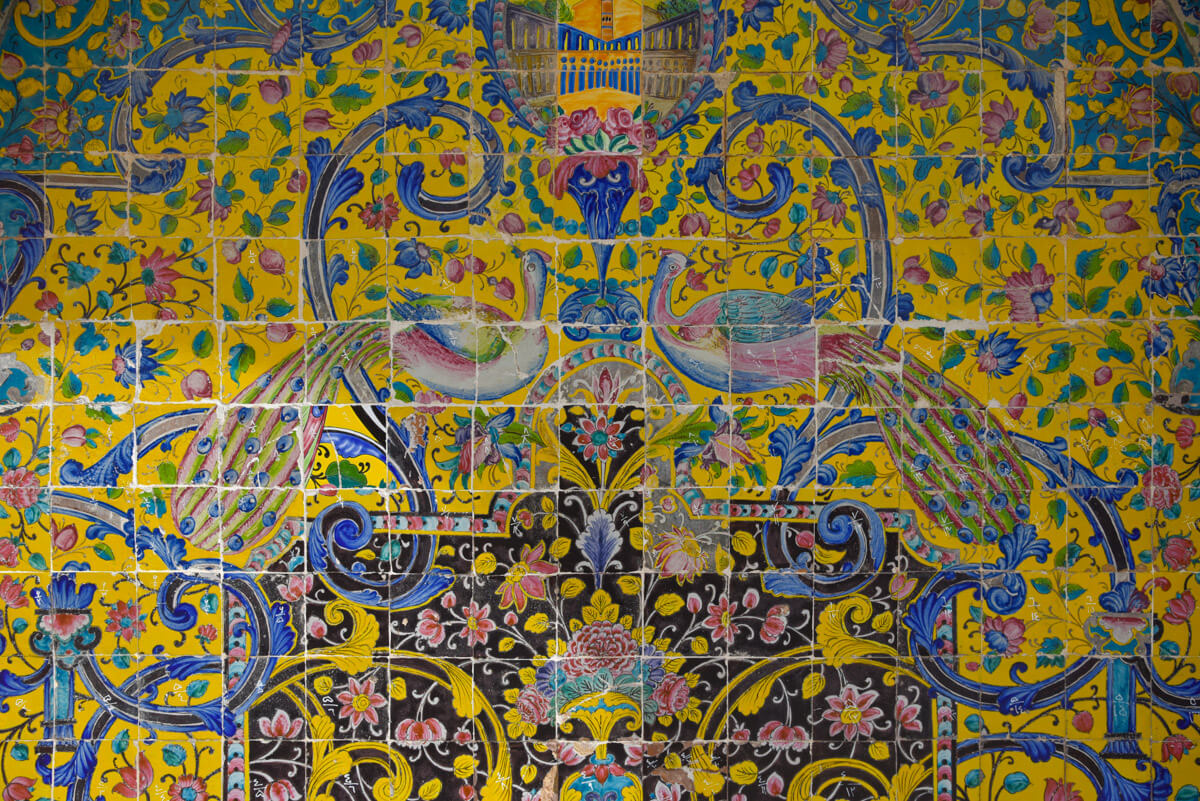
Kashan isn’t the greatest of all the Persian cities but its privileged location makes it very convenient for any Iran itinerary.
This also means that tour groups abound but this shouldn’t put you off because I can’t deny that it is actually pretty and, if you don’t have the time to visit Yazd, Kashan also has the famous wind towers and windy mud-brick alleys.
Besides the classic bazaar, where you can check out the textiles Kashan is popular for, don’t forget to visit Khan Amin al-Dowleh Timche , a mosque with one of the craziest dome ceilings; the traditional Persian Fin Gardens and the unique Agha Bozorg , a big mosque whose wall colors are confused with the houses from the old city.
For more information, read: Things to do in Kashan
Against the Compass tip – If you want a more off the beaten track option, Qom is a better alternative to Kashan. I personally didn’t go there but it is a very holy city with some amazing shrines and the location is also very convenient the 1-week Iran itinerary.

Best day trips from Kashan
To be very honest, Kashan isn’t my favorite place but I have to say that this is a good base for doing a few great day trips:
- Nushabad – 2,000-year old labyrinthic ruins.
- Maranjab desert – Sand dunes with epic sunsets.
You can visit both on a combined tour.
Where to stay in Kashan
Budget Hostel – Sana Historical Hostel – With both private rooms and dorms and located right in the old town, Sana is the most popular choice for independent travelers.
Budget Traditional House – Kamal-a Molk House – A beautiful, and very cheap, traditional guest house in the heart of Kashan.
Mid-range – Mahinestan Raheb – A few hundred-year-old house which has been beautifully restored into a beautiful hotel, very comfortable and lovely.
For more options, here you can see all the available hotels in Kashan
How to get to Kashan from Tehran
It’s very easy. Buses run regularly and it is only a 3-hour journey. You can also go by train but it takes 1 or 2 additional hours.
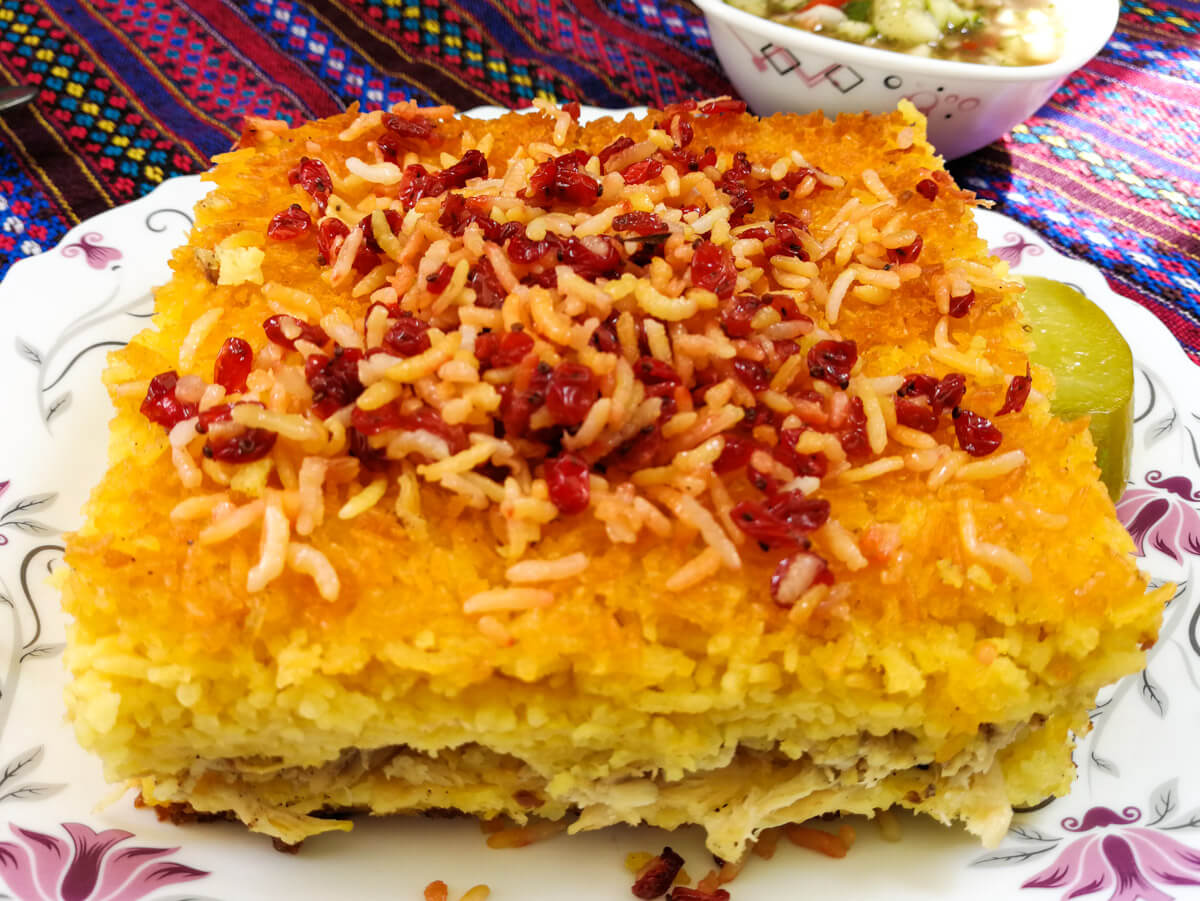
Day 5, 6 – Esfahan
Tip – If you have more than a week, consider staying in Esfahan for at least 3 or 4 days.
Esfahan is Iran’s most amazing city and its mosques are one of the main reasons independent travelers come to Iran.
With hundreds of years of history, Esfahan has always been home to a very important community of intellectuals and scholars and, historically, its importance was often compared to Athens or Rome.
Today, according to Iranian standards, this is a pretty modern city, very clean, composed of perfectly tree-lined streets, which makes it very pleasant to walk around.
The first place you need to go is Imam Square , where you find both the Shah Mosque and Sheikh Lotfallah Mosque , whose ceilings and domes will leave you breathless.
Imam Square is also a place where locals hang out, especially during late afternoon and evening, so I recommend you not to rush and stay there for a while.
During the day, I suggest you stroll down the old bazaar , one of the nicest in the country, with plenty of spices and the worldwide famous creepy mannequins.
In the evening, a good idea is to head to the river to see the different historical bridges, the most famous being Si-o-seh Pol . However, the last time I was there in April 2018, the river was completely dry, which made me very sad.
Oh! By the way, Esfahan is also famous for some sweets called gaz , which are filled with walnuts and have a gummy texture. Also, don’t forget to look for the local biryani (which is quite different from Indian and Pakistani) and saffron ice-cream .
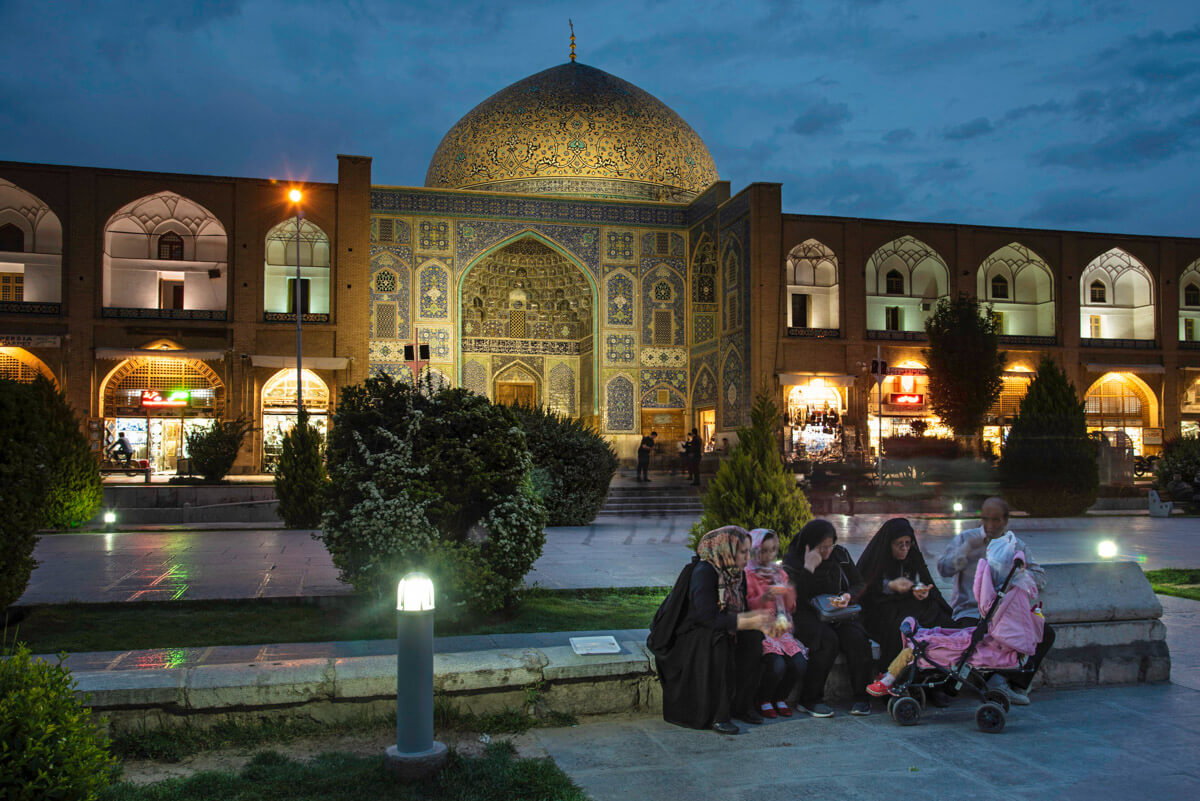
Where to stay in Esfahan
Budget Hostel – Ragrud Hostel – A brand-new hostel with very modern facilities, awesome staff and the best reviews ever. I am sure this place will, very soon, become very popular in Esfahan.
Budget traditional house – Sarayeh Orbidehesht – If you prefer a traditional guest house, this one is really great.
Mid-Range Hotel – Setareh – Traditional breakfast, super friendly and English-speaking staff and very close to the main attractions.
For more options: Click here to see all the available hotels in Esfahan
How to get to Esfahan from Kashan
There are several buses all day long and it is just a 3-hour trip.
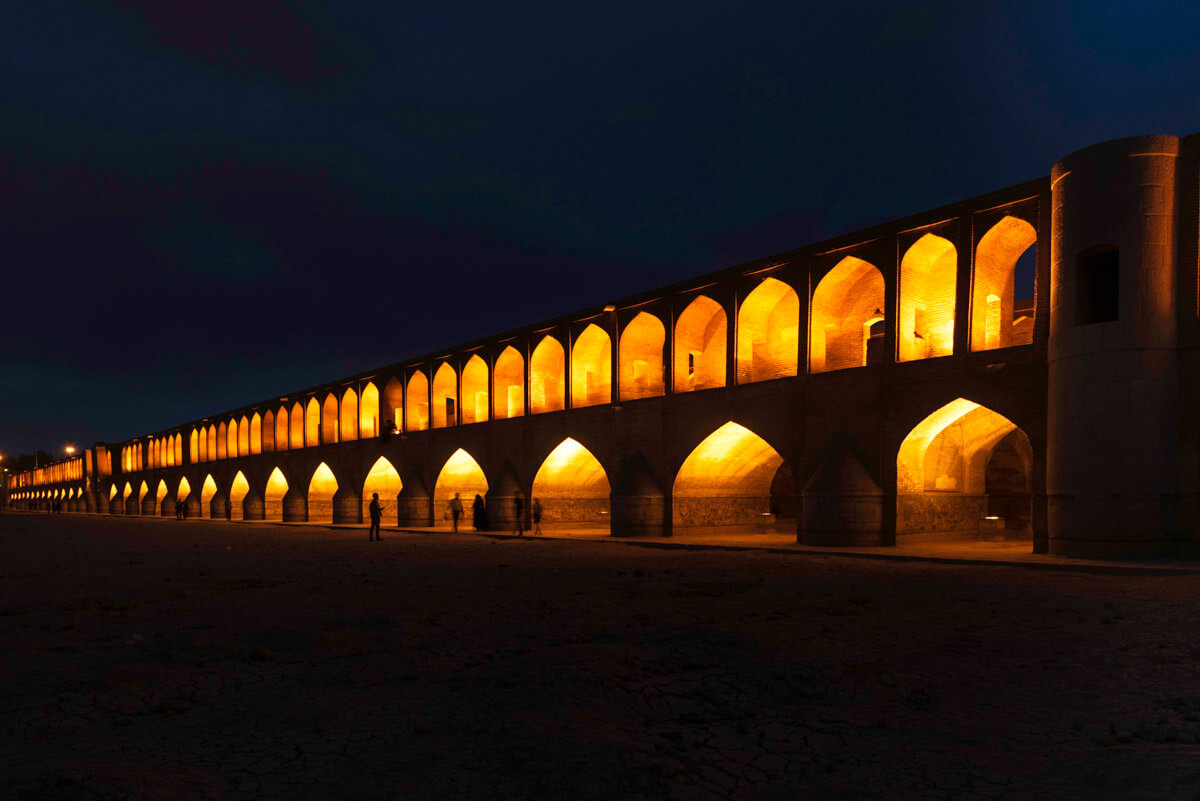
Independent travel to Iran – 2-week Iran itinerary
Most people would have two weeks for traveling independently in Iran.
If you want to save time, consider flying from Tehran to Shiraz, as you will save a 1,000-kilometer journey.
Map of the two-week Iran backpacking itinerary
With its perfectly-shaped old city, cute mosques, souvenir shops and plenty of decent coffee places, Yazd is, by far, the most touristic city in Iran. It reminded me a lot of Khiva in Uzbekistan .
With tens of tour groups overrunning the magnificent narrow alleys of the old town, to be very honest, I am not the biggest fan of Yazd but, truth be said, it is a very beautiful city and, perhaps, the most photogenic in the country.
Moreover, I also liked Yazd because it is a nice place to chill out. After hectic travels and hard-backpacking, it is always nice to finally be in a place where you are just one more tourist, find good accommodation, coffee and loads of food choices.
So yeah, I actually enjoyed Yazd and it should be a must on any Iran itinerary.
This used to be a Silk Road trading town, so there is a lot of heritage dating from that period. The coolest thing to do in Yazd is get lost in the old city, while you check the wind-towers and stumble across the different sites and mosques, the most remarkable being Masjed e-Jameh , a mosque from the 15th century and one of the tallest in Iran, with 48-meter minarets.
At sunset, you must go to a rooftop to enjoy the views . There are many hotels and cafés that allow you to do that.
Some places will charge you 1€, while in others you just need to order something. I can’t recommend anyone in particular because all of them have different views and perspectives but Orient Hotel is a popular spot.
Moreover, just outside of the old city, you find the Amir Chakhmaq complex , the famous three-storey facade building and the main landmark in the city.
Also, you should know that Yazd has the second largest population of Zoroastrians, a religion that dates back at least 4,000 years and was the official religion in the pre-Islamic Persian Empire.
Here, they have one of their holiest sites, the Fire Temple , which has a flame which they claim hasn’t stopped burning since the 5th century .

Where to stay in Yazd
Budget Hostel – Shahdad – The only real backpacker hostel in town, this traditionally decorated hostel is the best option for budget travelers.
Mid-range Hotel – Moshir al Mamalek Garden Hotel – You will love this place. A building with real wind towers, many travelers claim that this the best hotel they ever stayed in Iran.
For more options: Click here to check all the available hotels in Yazd
How to get to Yazd from Esfahan
Esfahan to Yazd is a good 4 to 5-hour ride and buses run frequently.

Day 10, 11, 12 – The desert of the Kaluts
In Kerman province, quite far away from everything, you find the Kaluts, the most silent and remote desert I have ever been to.
Here, NASA registered the highest temperature ever found on the Earth’s surface (71ºC) so, if possible, try not to come in summer. Nevertheless, the temperature cools down exponentially in the evening, so you should be fine for the sunset.
Life is not possible in the Kaluts, not even microorganisms, but its beauty and sunsets are out of this world, similar to the Mars landscape so, if you are fancying some desert adventure, this is the place to go.
If you have time, you can also visit Kerman city, as well as Shazdeh Garden and Shah Nematollah Vali Shrine. These sites are quite off the beaten track and the people in Kerman are always happy to meet foreigners.
The closest settlement to the Kaluts is an oasis town named Shahdad , famous for its date plantations, handicrafts made of palm trees, lovely traditional guesthouses and desert fortresses.
For more information, read my guide: A trip to the desert of the Kaluts

Where to stay in the Kaluts
You can camp if you go on a pre-arranged tour but, if not, you can stay at the nearest village called Shahdad. There is a very budget guest house called Ab Anbar and a fancier one named Nebka . Both are nice.
How to get to the Kaluts from Yazd
If you are traveling independently in Iran, first, you need to go to Kerman city, which is around 400km from Yazd. It is quite a journey, so I recommend you take an overnight bus (or train).
Shahdad is 100km from Kerman and a taxi would roughly cost 850,000IR.
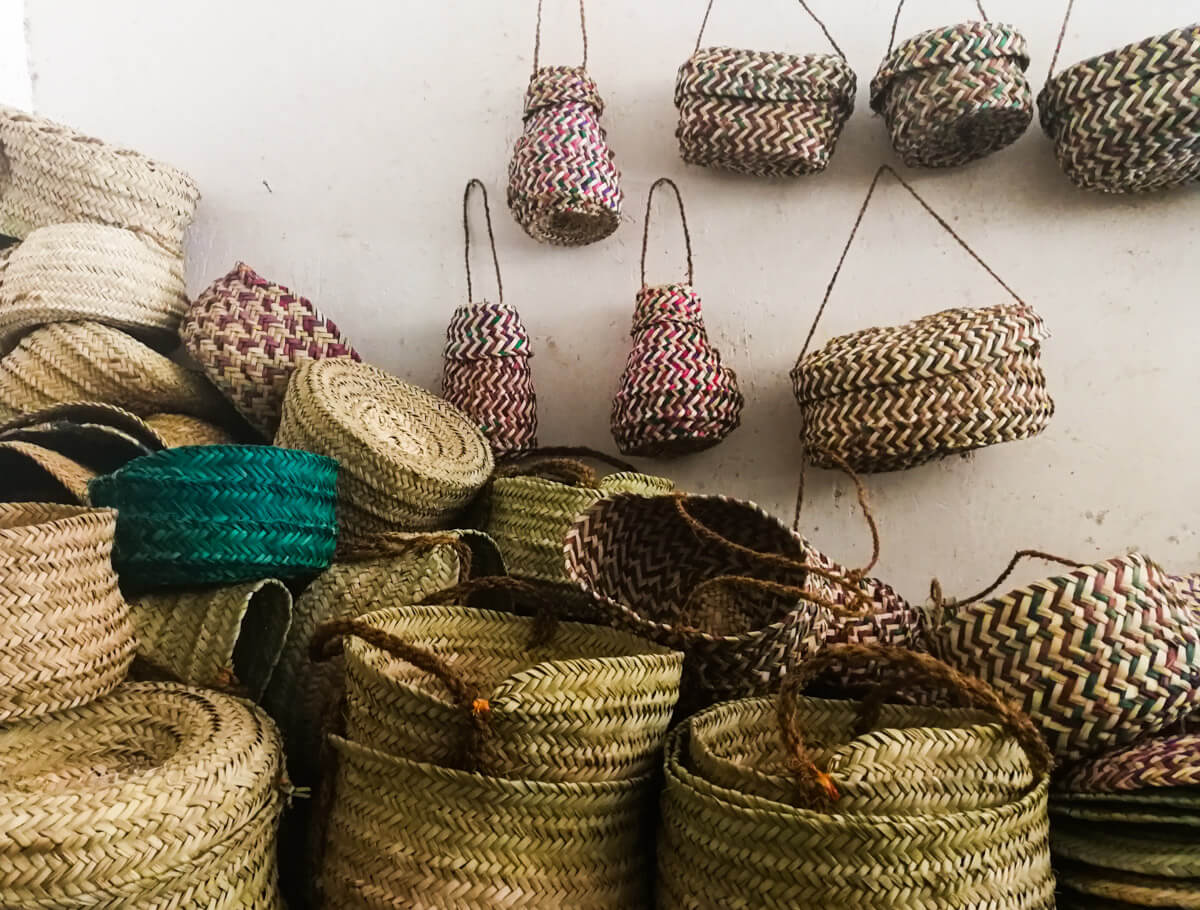
I love Shiraz.
Actually, I stayed here for 10 days, mainly because I was doing a project for a company but I enjoyed my time very much.
For some reason which I don’t know, the people from Shiraz are very open-minded, more than other cities in Iran. Actually, I drank more alcohol here than anywhere else in the country.
One day, one guy invited me to his house at 9:30am in the morning and gave me some shots of arak . It was a nice feeling to wander around Shiraz a bit tipsy after that.
There are also a lot of things to do in Shiraz, like visiting Vakil mosque , Nasir al-Molk , the famous mosque with the famous color effect from the sun rays; the ancient Vakil Bazaar , the less-visited, but outstanding, Shrine of Shah-e Cheragh and Hazfez Tomb and, of course, the ancient Persepolis , the ruins of what used to be the center of one of the greatest empires that ever existed.
For more information, read my guide: Things to do in Shiraz
Day trips from Shiraz
To visit these places, you will have to add 1 or 2 additional days for each one to your original Iran itinerary.
- Visiting the Qashqai Nomads – Read my report here
- Exploring the ruins of the Sassanid Empire – Read my report here
- Trekking in the Zagros Mountains – Read my report here
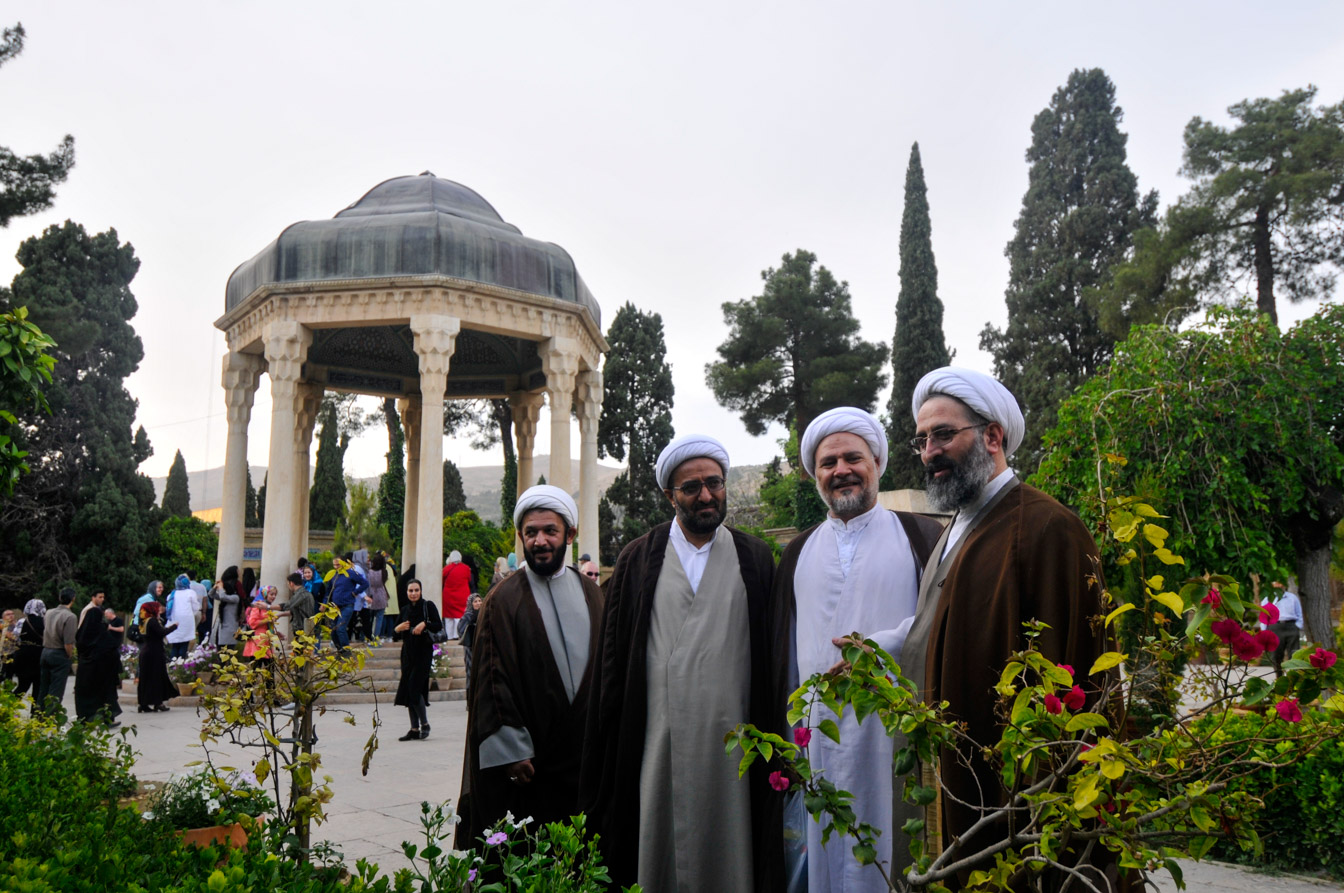
Where to stay in Shiraz
Backpacker Hostel – Taha Traditional Hostel – A real backpacker hostel, very well-located and great traveling atmosphere. Highly recommended!
Boutique Hotel – Niayesh – The busiest hotel in town, where everybody stays, from backpackers to wealthy couples and tour groups. Breakfast is included and it has several outdoor areas where you can rest and get some food.
For more options: Click here to see all the available hotels in Shiraz
How to get to Shiraz from Kerman
It’s a 7 or 8-hour trip, so I strongly recommend taking a night bus.
Getting out of Shiraz
You can take a direct bus to Tehran, no problem, but if you want to save time, consider flying.
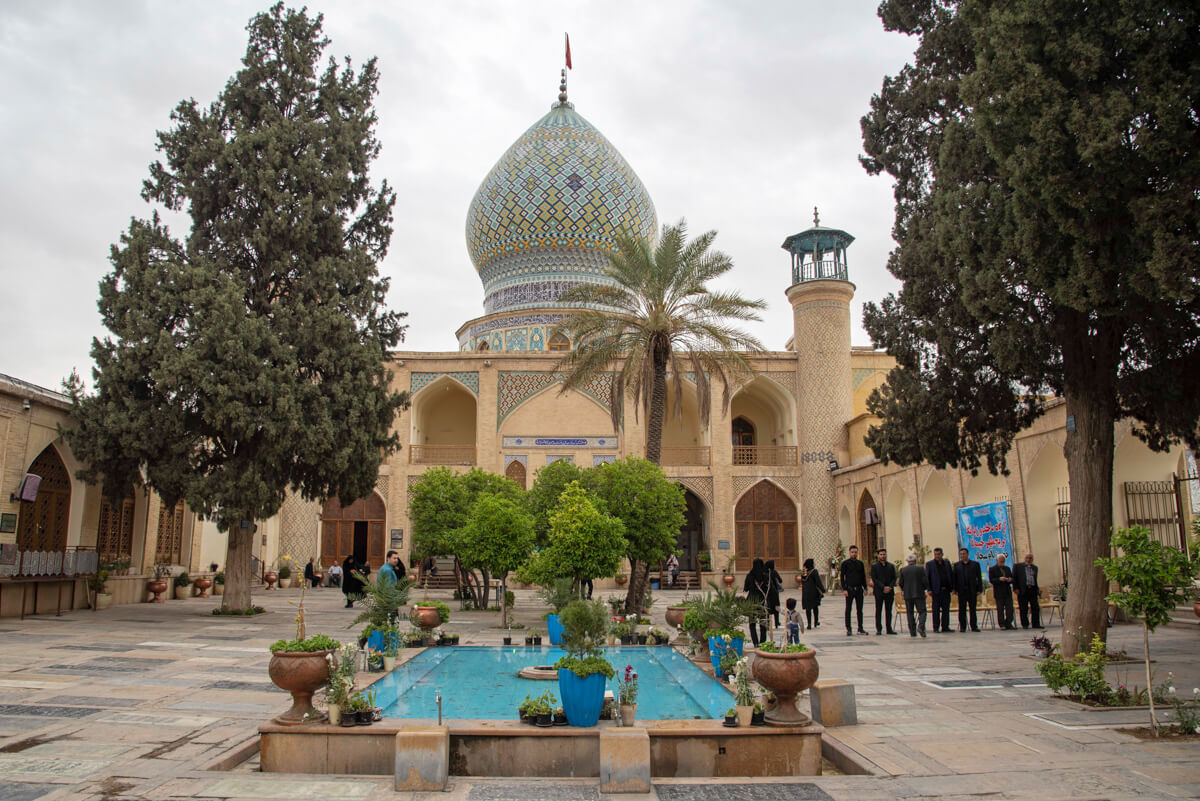
Independent travel to Iran – 3-week Iran itinerary
It’s mandatory to have a travel insurance to get your visa on arrival in Iran. Because of the sanctions, most insurance companies don’t provide coverage for Iran, but IATI Insurance does. Get your exclusive 5% discount if purchasing via this link
If you have an extra week for independent travel in, consider getting off the beaten track, so I suggest you visit Golestan province and Mashhad.
This is just my personal opinion but the truth is that I really loved these places. Let me tell you why.
Map of the 3-week travel itinerary to Iran
Day 15, 16 – Mashhad
There are two reasons to visit Mashhad:
One is to visit the Imam Reza Shrine and the other is to stay at Vali’s .
As you may know, Mashhad is the holiest place in Iran and one of the most important cities for Shia Muslims in the world. The reason is that the shrine is where Imam Reza rests, the 8th Imam of Twelver Shiïtes.
The shrine is the largest religious complex in the world and, when you step in, it is easy to understand why. It is f*** huge and you will lose count of all the courtyards and different mosques.
Cameras in Mashhad The only downside is that you can’t take in a professional camera but only your phone. I didn’t know that and had to leave my camera and tripod at the entrance and didn’t have battery on my phone, so no pictures for me. Moreover, if they see you are a foreigner, they will assign you a guide, which kind of sucked as well, because mine didn’t explain anything to me but just made me follow him. You can, however, sneak in easily.
As the top pilgrimage site in the country, Mashhad is a wealthy city with great tourism infrastructure, as it receives loads of pilgrims from Lebanon and Iraq , two countries with large Shia populations.
There is a modern metro line and plenty of different food options, including Lebanese restaurants.
The second reason to come is to stay at Vali’s. Vali has a family homestay that, for years, has hosted plenty of international travelers, especially overlanders going (or coming) from Afghanistan and Turkmenistan.
I stayed 4 days at his house as the only guest and we celebrated the Iranian New Year, ate great homemade food and they just took very good care of me.
Besides, he has plenty of stories to tell, is very talkative and can you take outside of the city for day trips.
Visit Vali’s website for more details.
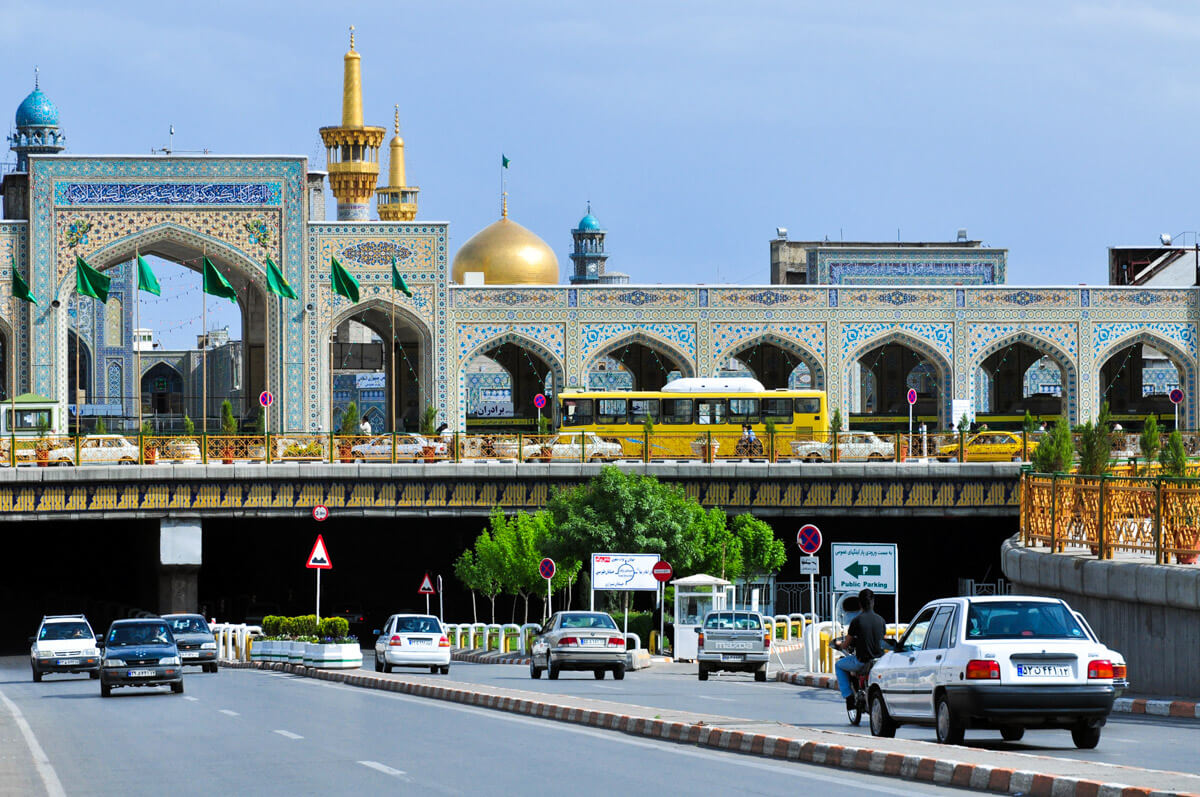
Best day trips from Mashaad
I recommend you go to Kang, a traditional stepped village 50km from Mashhad. It’s very beautiful to see and there are some small trekking opportunities around the area.
To go there, take the Metro Line 1 to Vakilabad and then a bus or shared taxi. Additionally, a trip by taxi from the city center with 1-hour visit costs 600,000IR.
Where to stay in Mashhad
Budget Homestay – Vali’s – Like I said, staying at Vali’s is one of the best things to do in Iran. Visit his website for more information .
Mid-range – Darvishi Royal Hotel – Vali’s is great but it’s a place for budget backpackers. If you wanna stay in a good hotel, this is one of the best options in town.
How to get to Mashhad
Being the most visited city in the country, you can get here on a direct bus or train from anywhere in Iran, including Shiraz, if you are following the suggested itinerary.
The only downside is that Mashhad is really far away, no matter where you are, so if don’t have much time, consider flying in. I personally went by train from Bandar Abbas and it was a 23-hour journey.

Day 17, 18 – Gonvad e-Kavus
Gonvad e-Kavus is the main city in Golestan province, one of the least visited provinces in Iran but, controversially, the most beautiful.
I bet that you didn’t know that this province is home to the largest population of Turkmens, the actual people from Turkmenistan. This means that, in Golestan, there is a clear Central Asian culture, visible in their food, nomadic life and Mongolian features.
In Gonvad-e Kavus you find a UNESCO World Heritage site (a 72-meter tower), handicraft shops selling traditional Turkmen products and is the gateway to some of the most striking scenery in the whole country.
Golestan is the ultimate destination for independent travel to Iran.
For more information, read my travel guide to Golestan
Where to stay in Gonvad e-Kavus
There are very few options and your best bet will be staying in Hotel Ajam or Couchsurfing.
How to get to Gonvad e-Kavus from Mashhad
You should take a night bus. It’s an 8-hour journey.

Day 19, 20 – Khalid Nabi
Also located in Golestan, Khalid Nabi is the most stunning site I visited in my Iran itinerary, and not for the site itself but because it is located in the most epic spot ever.
Basically, Khalid Nabi is a cemetery where a pre-Islamic prophet and his followers are buried. The prophet is buried inside a cute building, whereas all his followers are found under some penis-shaped rocks.
The bigger the penis is, the older the man when he died. If you see a cross-shaped rock, it means that the person buried is a woman.
The archaeological is not the only reason to come but the landscape is absolutely gorgeous and the area is filled with small Turkmen villages and nomadic yurt camps.
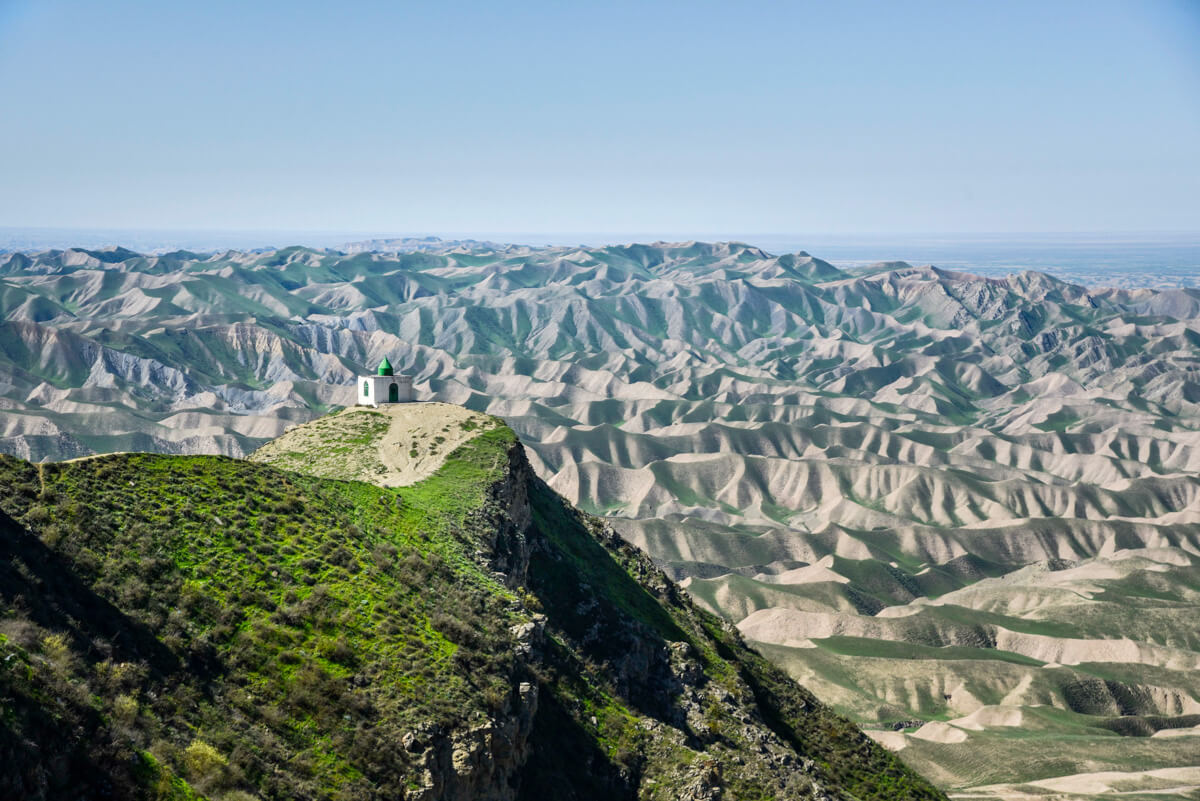
Where to stay in Khalid Nabi
If you want to experience the real Turkmen and Central Asian culture, I recommend you stay in Tamer-e Qarah Quzi , a village 35km before from Khalid Nabi. Here, there is a homestay run by Naim and his family, a Turkmen family that will bless you with their hospitality.
Besides, Naim can also take you for some trekking and visit nomadic camps.
Highly recommended!
How to get to Khalid Nabi and Tamer-e Qarah Quzi
To go to Tamer, you have to get a local shared taxi to Kalaleh (40,000IR) and, from there, a second one to Tamer (40,000IR). Khalid Nabi is just 35km away from Tamer but the road is really bumpy so it takes around 1.5h.
A round-trip by taxi costs 400,000IR. I hitchhiked and was picked up by some Iranians from Tehran who were drinking vodka in the car. It was pretty cool.
Remember that, for more information, read my guide to Golestan province
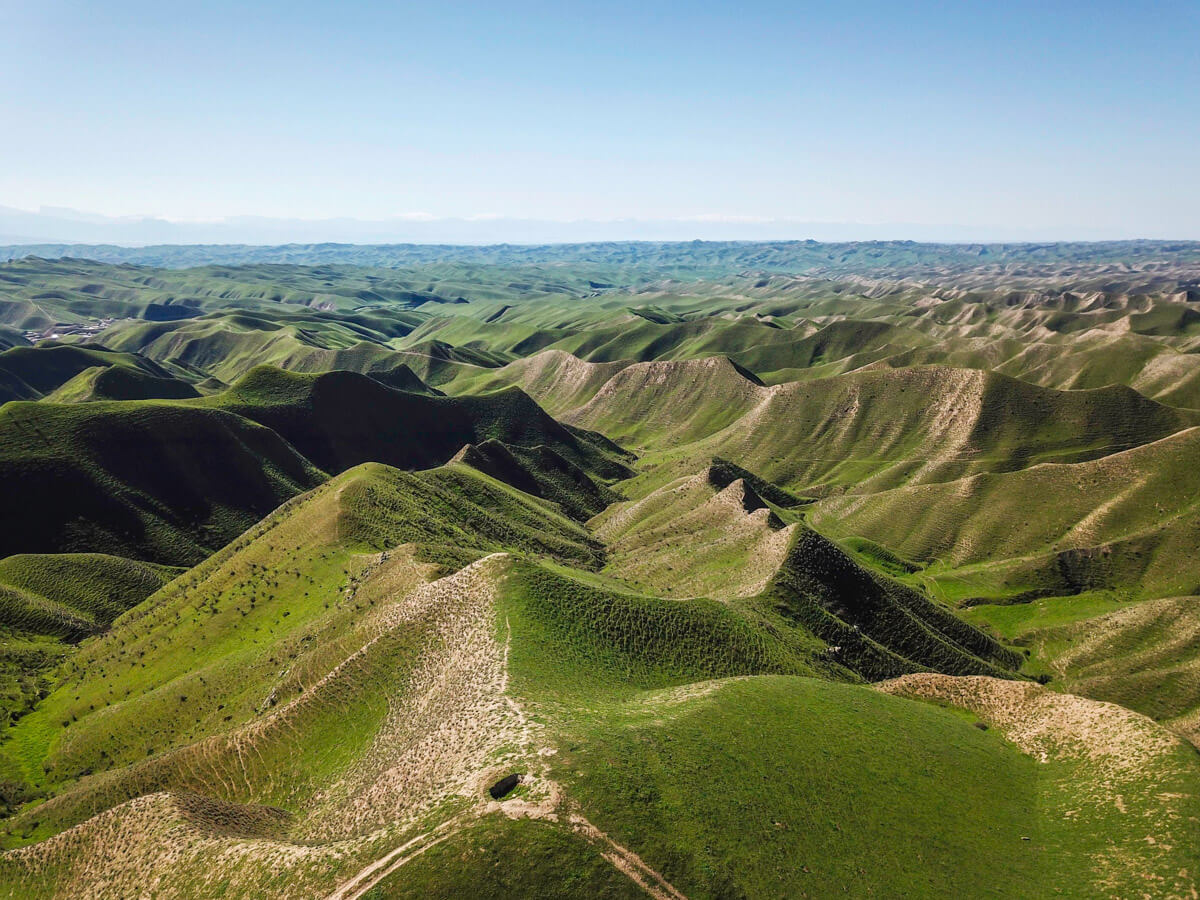
Iran independent travel – 1-month Iran itinerary
If you have a full month, consider adding the Persian Gulf Island and the north-west to your Iran itinerary.
Map of the 30-day travel itinerary to Iran
Qeshm Island – 3 extra days from Shiraz
Note – You should come here after Shiraz.
If you wanna taste the Persian Gulf culture, I suggest you add Qeshm Island to your Iran itinerary.
The Persian Gulf culture is the traditional culture from Oman , Saudi Arabia , the United Arab Emirates and, of course, south Iran. This culture, however, is fasting disappearing in the Arab countries but, fortunately, not in Qeshm.
The inhabitants of Qeshm are Sunni Wahabis, the most conservative branch of Islam. The most surprising thing is the way local women dress, in such colorful abayas and wearing some strange masks. It may seem a bit intimidating but they are actually quite laid-back and you can take photos of them, no problem.
Qeshm is also famous for its geology, consisting of strange rock formations. To see this, go at sunset to Star Valley .
I also suggest you visit the Shib Deraz and the Sea Turtle Breeding Area , Hengam Island , Laft and, of course, try the local food, which consists of spiced seafood.
You can also take a ferry to Hormuz Island , which leaves every day at 9am and 2pm. I personally didn’t go but I have been told that it is a beautiful island.
The only downside of Qeshm Island is that, for people who travel independently in Iran, the public transportation options are scarce.
For more information, read my travel guide to Qeshm Island
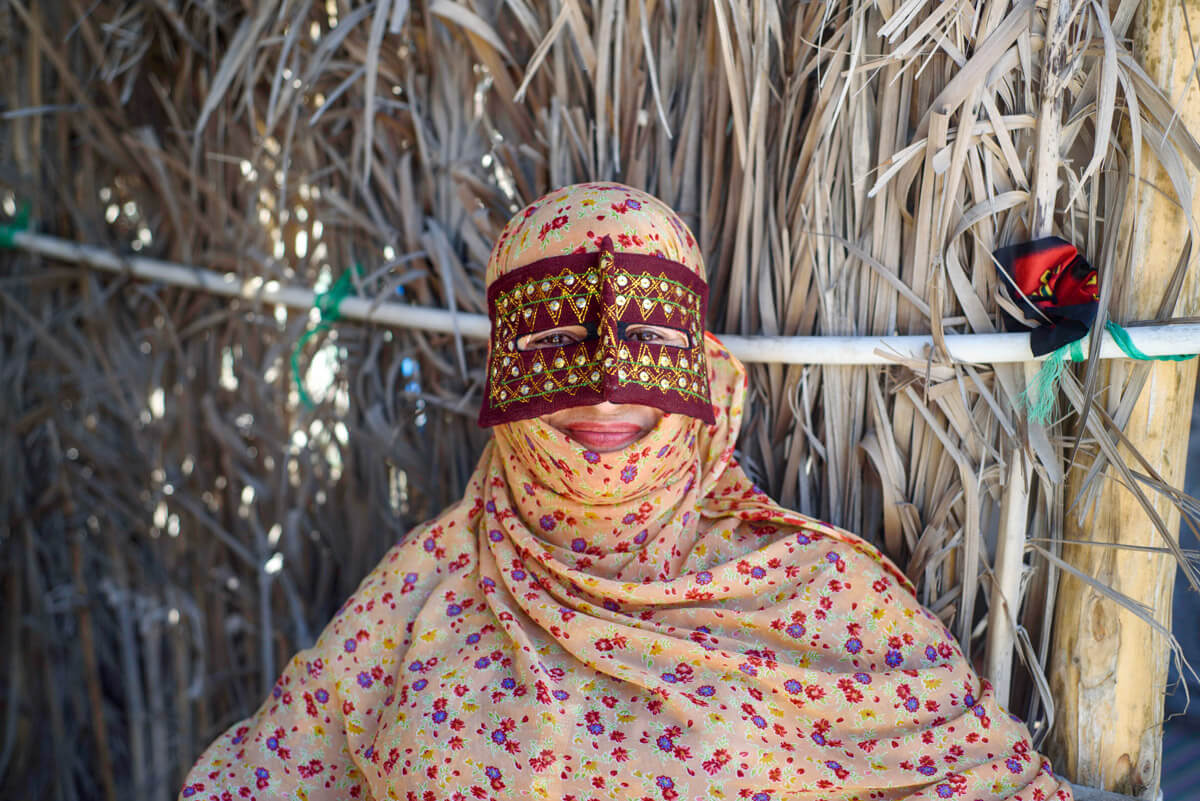
Where to stay in Qeshm Island
I recommend you pick one place and do day trips from there.
I personally pitched my tent in Shib Deraz beach but there are a few good options to stay around the island.
In Qeshm, there are some nice hotels and, if you want to stay somewhere remote, stay in Sar Rig Village, at Asad’s Homestay.
How to get to Qeshm Island from Shiraz
From Shiraz, you need to take a bus to Bandar Abbas (8 hours, 500km).
Once in Bandar Abbas, go to the ferry terminal. Boats leave every half an hour (150,000IR).
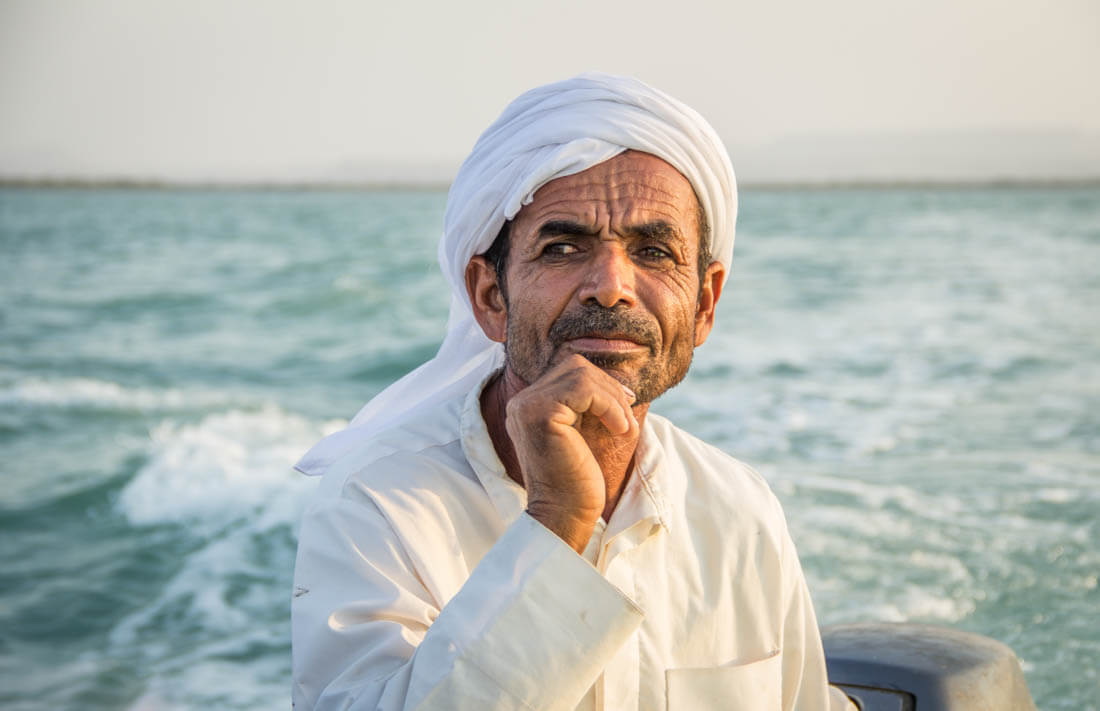
Masuleh – 3 extra days from Tehran
Masuleh is the most famous stepped mountain village in Iran.
However, being the most famous means that it gets a mix of different opinions and feelings.
The most voracious travelers will tell you not to go because it gets swamped with local tourists, souvenir shops, and pricey restaurants, whereas the rest will tell you that it is a lovely village and you must go.
In my opinion, both are kind of wrong. On the one hand, it is true that Masuleh gets all the attention from all the travel guides and this is because it is actually very cute and has a developed tourist infrastructure.
On the other hand, despite being very touristic, most tourists just remain in the village, without knowing that Masuleh is surrounded by some of the most awesome mountains in the country, composed of lush, green plains and remote shepherd huts, which offer amazing trekking opportunities.
I went trekking myself and didn’t bump into absolutely anyone. So yeah, I think that you should definitely come.
For more information, read my travel guide to Masuleh
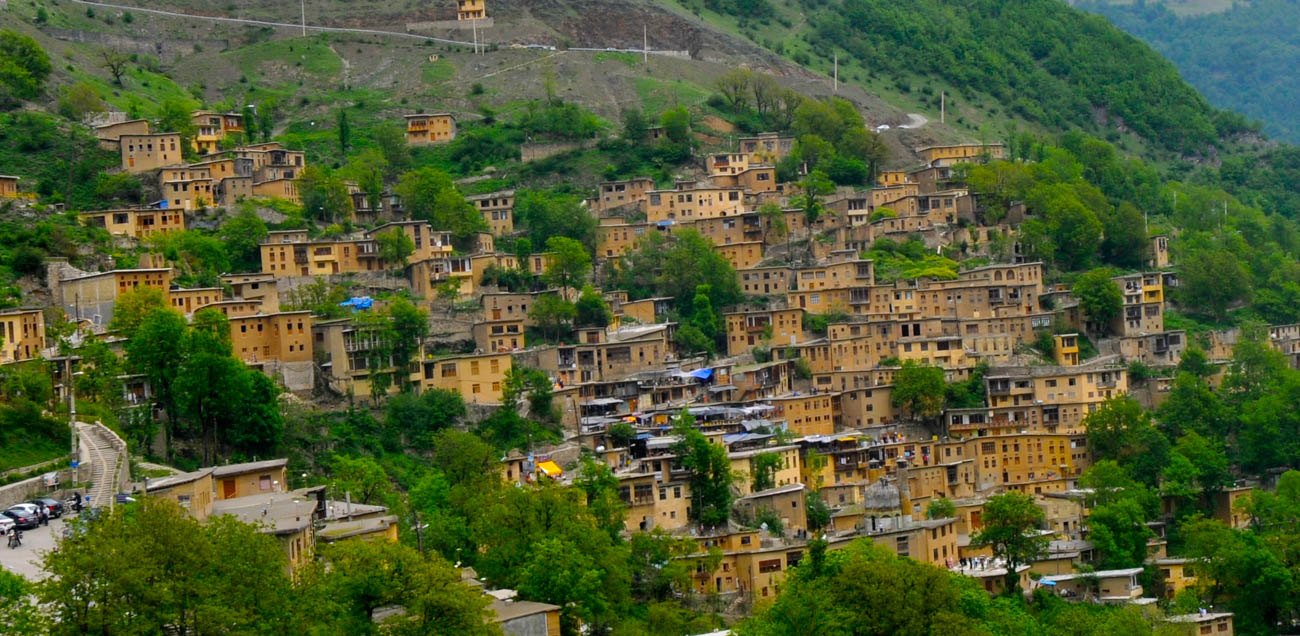
Where to stay in Masuleh
I stayed in a random homestay and you can do the same because there are many but they can’t be booked online.
If you are looking for comfort, Aram Hotel seems like a popular mid-range option.
How to get to Masuleh from Tehran
You need to first go to Fuman, which takes 4 hours from Tehran. Masuleh is 34km from Fuman and private taxis cost 300,000-400,000IR. Local shared taxis leave from a station 3km from the main bus station and they cost 100,000-150,000IR.
Additionally, if you don’t find buses to Fuman, you can also go to Rasht, which is a bigger city very close to Fuman.

Tabriz – 3 extra days from Masuleh
The city where the famous Persian carpets come from and where you find the largest covered bazaar in the world, Tabriz is a real off the beaten track city and, practically, the only visitors are overlanders coming from the Caucasus countries.
The bazaar has been listed as a UNESCO Heritage site so, if you are into bazaars, it doesn’t get much better than this.
Tabriz also has some very friendly people who haven’t been spoiled by mass tourism yet, so people are quite a highlight, as well. Don’t forget to visit the Blue Mosque , even though due to an earthquake, it still undergoing a long restoration process.
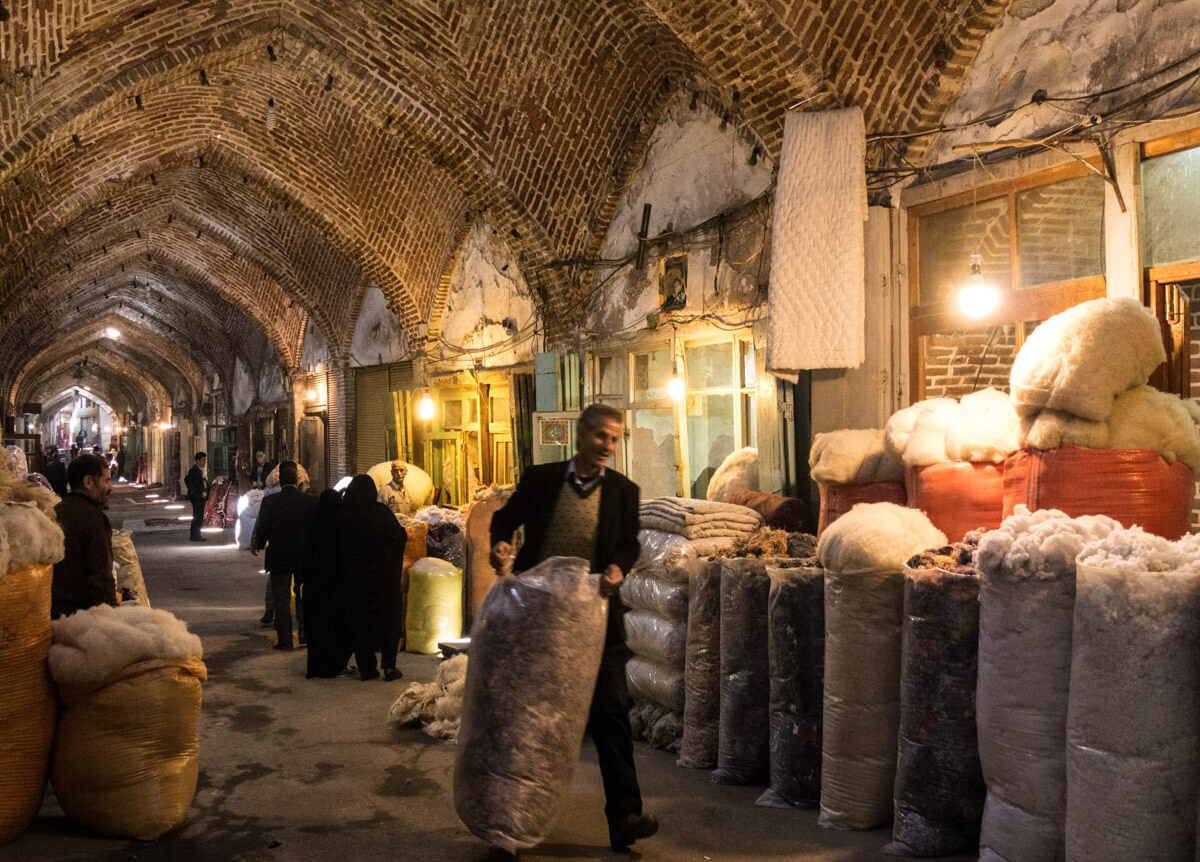
Best day trip from Tabriz: Kandovan
I also suggest you go to Kandovan , often called the little Cappadoccia, a very peculiar cave city easily reachable from Tabriz. You can book you
For this, you should first take a bus to Osku, which shouldn’t cost more than 40,000IR. Then, a taxi to Kandovan would cost 200,000IR roughly.
Where to stay in Tabriz
Budget Hotel – Ramsar Guest House – Cheap accommodation for backpackers. (online booking not available)
Mid-range Hotel – Tabriz el Goli Pars – Nothing fancy but good quality service according to its price range.
For more options: CLICK HERE TO SEE ALL THE HOTELS AVAILABLE IN TABRIZ
How to get to Tabriz from Masuleh or Tehran
If you are in Masuleh, you should go to the city of Rasht, where you may find direct buses.
If you are in Tehran, take an overnight bus because it is a very long way. They leave daily.
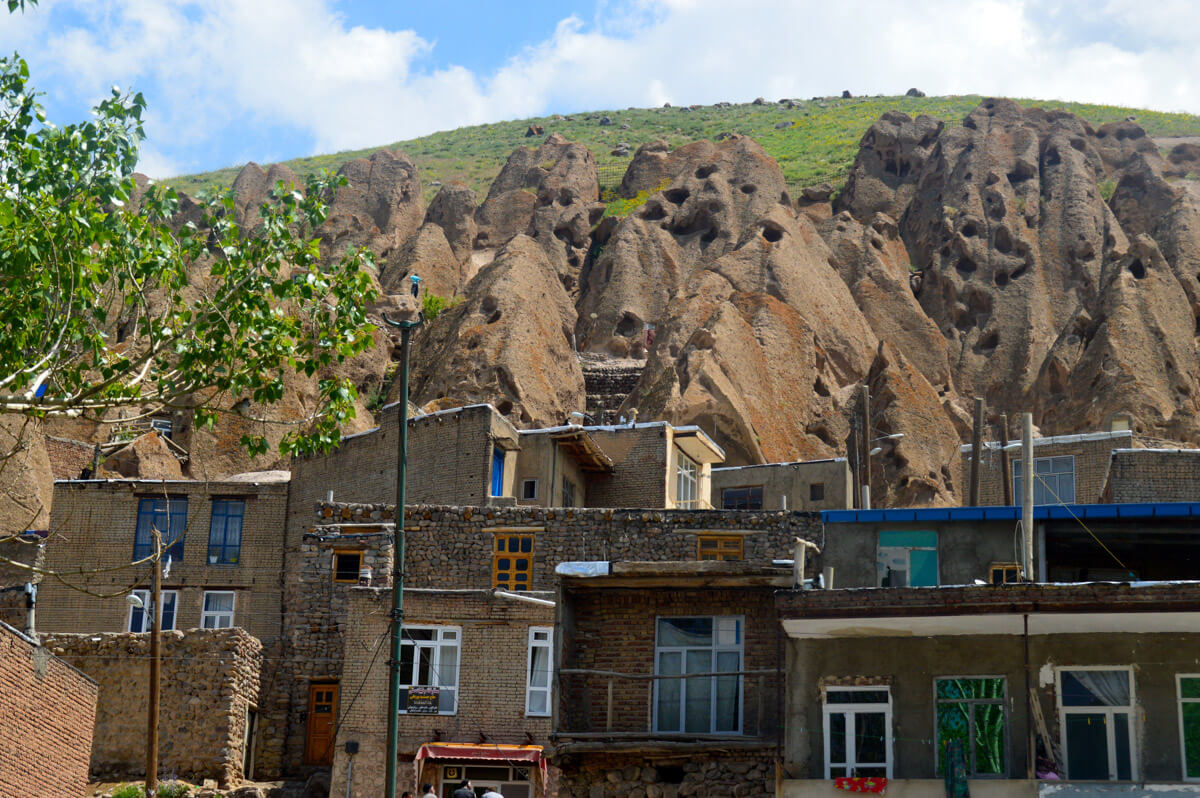
More resources for independent travel in Iran
📢 In my Travel Resources Page you can find the list of all the sites and services I use to book hotels, tours, travel insurance and more.
Remember to always use my code – From booking a hotel to visa services, travel insurance and tours, if it is via 1stQuest , remember that you can use my 5% discount code, as many as you want, whenever you want: ATC-QST
All guides and articles for traveling in Iran destination
- Iran Travel Guide
- Best Books about Iran
- Travel insurance for Iran
- VPN for Iran
- Solo Female Travel Guide to Iran
- Tehran Travel Guide
- Qeshm Island Travel Guide
- Travel Guide to Shiraz
- A trip to the desert of the Kaluts
- Trekking Guide to Zagros Mountains
- Meeting the Qashqai People
- Fars Province Travel Guide
- Visa Guide for Iran
- Masouleh Travel Guide
- Travel Guide to Golestan Province
- Iran-Iraq border crossing
- Is Iran Safe?
- Darband Travel Guide
- Best Hotels in Tehran
Travel Itineraries to other countries in the Middle East
- Syria Itinerary
- Saudi Arabia Itinerary
- Travel Guide to Oman
- Travel Guide to Lebanon
- Iraq Itinerary
You might also like our Pakistan Travel Guide or Azerbaijan Travel Guide .
You will also be interested in: Where in the Middle East is safe? and The most beautiful places in the Middle East .
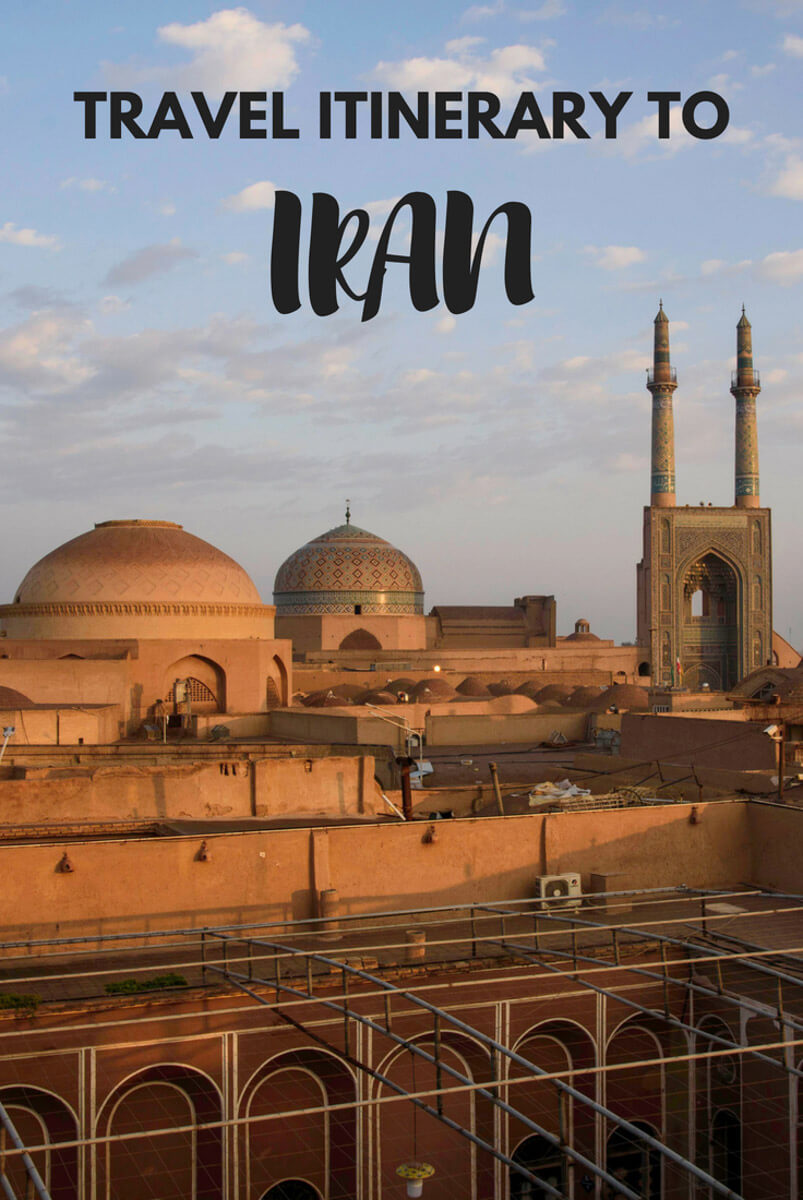
Hello Joan, how are you? Just discovered your website today and I have to say that this is the most useful blog I have ever visited 🙂 I have a question. I have 3 weeks in Iran and besides doing the classic itinerary from Tehran to Shiraz I also want to visit one of the less visited places you recommend. I can’t decide between Kurdistan and Golestan. Which one would you go with? Thank you in advance
Hey man! That’s a very hard question to answer! It really depends on what you like. To be honest, I haven’t visited much of Kurdistan, as I just passed through on my way to Iraq and spent less than 24 hours, but I traveled in Golestan extensively and i loved it because my Turkmenistan visa was denied in the past and Golestan is the closest place in the world to Turkmenistan, as most people there are ethnically and culturally like the Central Asian country. Kurdistan is also great, but I had already visited Iraqi Kurdistan before, so I preferred spending more time in Golestan
Having spent quite a bit of time in Iran over the years, I applaud your effort in promoting travels in this lovely country with exceptionally friendly people.
I would highly recommend your blog to friends who are planning to visit and so wish this was available when I was there.
Great job and keep up with the good work. Thank you!!!!
I really miss Iran, thanks for compiling some of the best things about it and putting it out there 🙂
Hello friend very compelete useful guide which encourage me (as an iranian & travel lover) to start visiting my country again, if this COVID-19 let us. I,ve visited most of the famous places when i was a kid with my family and i think a majority of them most be re-visited since i coudnt remember as well as your descriptions BTW, we pronounce that city in Golestan as Gonbad e-Kavus (NOT GonVad) and its not the main city of Golestan altough a large one (main is Gorgan)
Hello Joan. Thank you for your blog. I see you used a drone while in Iran. I thought they were banned. Would you mind to explain how you did? Thanks Antonio
Hi Antonio, I didn’t do anything. I just entered with it.
Impressive article, enjoyed reading it. Thanks for shedding light on this topic.
Leave a Comment Cancel reply
Your email address will not be published. Required fields are marked *
Notify me when new comments are added.
Join our Expeditions
From Syria to Iraq in Pakistan, Against the Compass is finally running expeditions to the most epic and off-the-beaten-track countries.
We have scheduled expeditions for every month of the year.
Latest posts
- How to Travel to Libya in 2024
- Backpacking Venezuela Travel Guide (2024)
- How to travel to Afghanistan during Taliban rule (2024)
- How to visit Los Llanos in Venezuela
- How to visit Angel Falls and Canaima National Park
(+98) 935 -122 0038
Ultimate iran travel guide [2024].
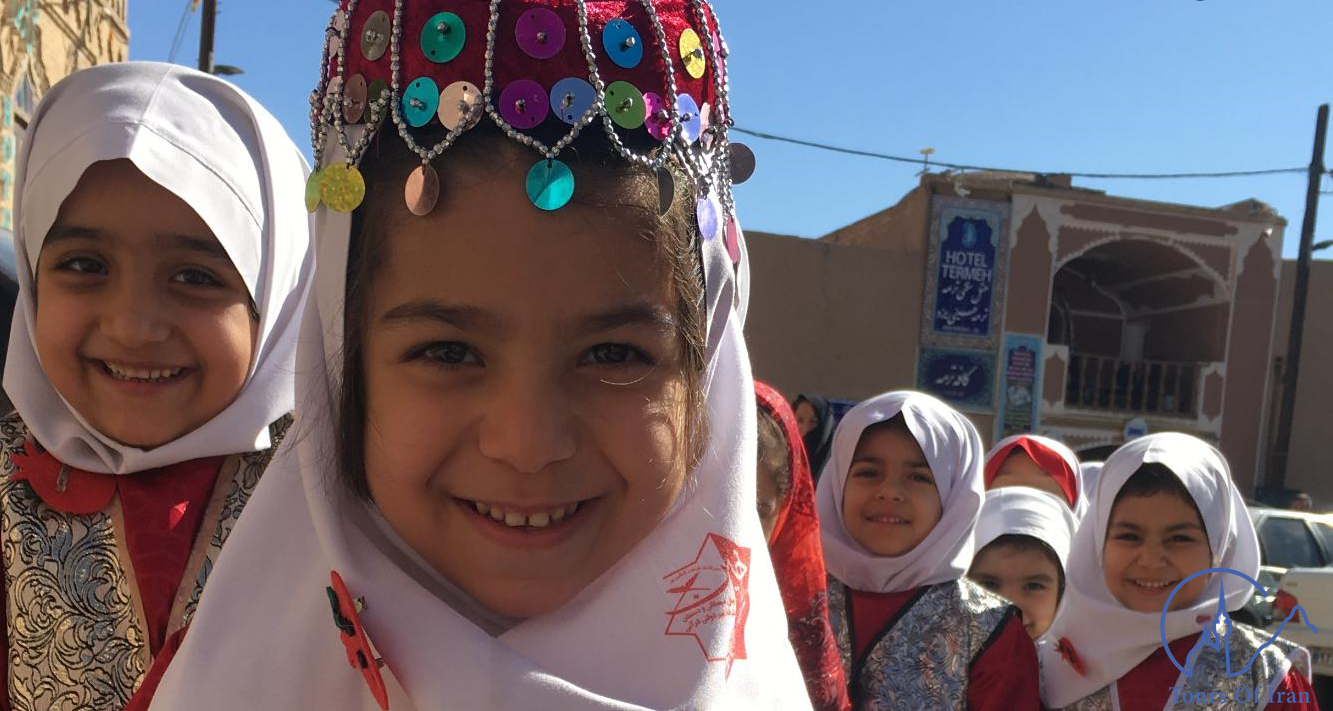
Table of Contents
Welcome to the ultimate Iran travel guide!
You will find all the information and insights you need to plan a memorable trip to this mesmerizing country in this comprehensive article. From the ancient ruins of Persepolis to the bustling bazaars of Tehran, Iran offers many experiences for travelers seeking history, adventure, and cultural immersion.
Iran a country steeped in history and culture, is located in Western Asia. With deserts, mountains, and lush green valleys, it boasts a diverse landscape. The country’s warm hospitality, rich traditions, and architectural wonders make it a top destination for intrepid travelers.
Let’s just dive in the Iran travel guide:
Plan A Perfect Trip To Iran
Planning is critical to a successful trip to Iran. Here are some essential steps to help you plan a perfect trip to Iran:
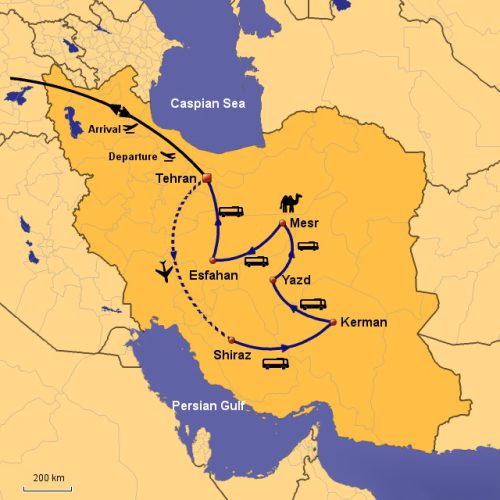
Get a thorough understanding of Iran
Taking the time to research Iran’s history, culture, customs, and places of interest is the first step in the Iran Travel guide. Make sure you are familiar with local traditions and netiquette to ensure a respectful and enjoyable experience.
Iran has been a crossroads of cultures and civilizations for thousands of years. From the ancient Persian Empire to the Islamic Golden Age, Iran’s past has left an indelible mark on its present. Discover the fascinating stories of Persian kings and poets at UNESCO World Heritage Sites such as Persepolis.
Documents Required for Travel to Iran
Make sure your passport is valid for at least six months after your intended departure date. The type of visa you need will depend on your nationality and the purpose of your visit.
Iranian visa requirements can be complex, so it’s important to check with your country’s Iranian consulate or embassy for the latest information. You can also simply submit your Iran Visa Application Form and Tours of Iran will handle the rest.
In Iran, tourist visas are usually valid for 30 days and can be extended. Visit Visa Information for more information on Iran visas.
Best Time to Visit Iran
Throughout the year, Iran experiences a variety of weather conditions.
Spring (March to May) and autumn (September to November) are considered the most ideal times to visit when the weather is pleasant and mild.
Iran’s landscapes come alive with colorful flowers in spring, making it an ideal time for outdoor activities and sightseeing. However, autumn is a great time to explore historical sites and hike in the mountains because of its cooler temperatures.
Plan a flexible itinerary
Make an itinerary that covers your preferred destinations while allowing for unexpected discoveries. You can find well-known sites as well as hidden gems off the beaten track in Iran.
Iran’s must-visit destinations
Isfahan is a city that will amaze you with its stunning architecture. Explore the majestic Imam Mosque and the enchanting alleys of the historic bazaar and marvel at the intricate designs of Naqsh-e Jahan Square.
Persepolis: Step back in time at Persepolis, an archaeological marvel that was once the ceremonial capital of the Achaemenid Empire. Admire the colossal columns, intricate reliefs, and ancient tombs that narrate the glorious past of Persia.
Shiraz: Shiraz, the city of poets and flowers, beckons with its poetic charm. Visit the tomb of Hafez, the renowned Persian poet, stroll through the tranquil Eram Garden, and explore the mesmerizing Nasir al-Mulk Mosque.
Tehran: Discover the dynamic capital city of Iran, Tehran , where modern skyscrapers stand alongside historical palaces. Visit the Golestan Palace, delve into Iran’s rich history at the National Museum, and enjoy panoramic views from the Milad Tower .
Yazd: Yazd has a unique architectural heritage, boasting traditional windcatchers that cool the buildings during scorching summers. In Yazd Explore the Jame Mosque and immerse yourself in the ancient Zoroastrian culture.
The Ancient City of Bam: Explore the ancient city of Bam, known for its impressive mud-brick citadel that dates back over 2,000 years. Although partially destroyed by an earthquake, Bam Citadel is still a testament to Iran’s rich history.
The Caspian Sea: Escape to the picturesque coast, where lush green forests meet sandy beaches. Relax in the resort towns of Ramsar and Chalus, or embark on a scenic journey through the dense forests of the Alborz Mountains.
Tabriz: Tabriz , a historic Silk Road city, is renowned for its UNESCO-listed bazaar, the largest covered market in the world. Admire the stunning Blue Mosque and explore the Tabriz Historic Bazaar Complex, a UNESCO World Heritage site.
Chabahar: A port city with untouched beaches and offshore islands. Enjoy activities like scuba diving, snorkeling, and dolphin watching, and witness the unique landscapes of the Martian Mountains.
Must-See Historical Sites in Iran
Iran’s rich history has left behind a treasure trove of historical sites and architectural wonders. Here are some must-see places to explore:
Persepolis – Ancient Ruins Frozen in Time
Persepolis , also known as Takht-e Jamshid, is one of Iran’s most significant archaeological sites. Built during the Achaemenid Empire, it was the ceremonial capital and symbol of Persian power.
The sprawling complex of Persepolis features imposing stone platforms, magnificent gateways, and intricate bas-reliefs. The reliefs depict various scenes, including royal audiences, processions, and representations of tribute-bearing nations.
Visiting Persepolis is a journey back in time to the ancient world, where you can witness the grandeur and glory of the Persian Empire.
Naqsh-e Jahan Square – A Jewel of Islamic Architecture
Located in the heart of Isfahan, Naqsh-e Jahan Square , also known as Imam Square, is an iconic symbol of the city’s grandeur and history. Constructed during the Safavid era, the square is an impressive example of Islamic architecture and urban planning.
Surrounded by stunning buildings, including Imam Mosque, Sheikh Lotfollah Mosque, and Ali Qapu Palace, Naqsh-e Jahan Square is a UNESCO World Heritage site. Its vast open space once hosted royal ceremonies, polo games, and other grand events.
Visiting the square during different times of the day reveals the changing hues of the surrounding buildings, adding to the allure of this historical masterpiece.
Golestan Palace – A Window to the Qajar Era
In the heart of Tehran, Golestan Palace is a masterpiece of Qajar-era architecture and design. The palace complex served as the seat of power for several rulers of the Qajar dynasty.
The palace’s opulent rooms, halls, and gardens showcase exquisite craftsmanship and intricate tile work. Visitors can explore the Marble Throne Hall, Mirror Hall, and the stunning Shams-ol-Emareh (Edifice of the Sun), offering panoramic views of Tehran.
Golestan Palace provides a glimpse into Iran’s royal past and the luxury of the Qajar dynasty.
Pasargadae – The Tomb of Cyrus the Great
Pasargadae, located near Shiraz, is another UNESCO World Heritage site in Iran. It is home to the tomb of Cyrus the Great, the founder of the Achaemenid Empire and one of history’s most influential leaders.
The tomb’s simple design starkly contrasts Persepolis’s grandeur, reflecting Cyrus’s humility and humanity. The site also includes the ruins of Cyrus’s palace and a royal garden.
Visiting Pasargadae offers an opportunity to pay homage to one of the ancient world’s most respected leaders and learn about the roots of the Persian Empire.
Bam Citadel – A Silent Witness of History
Located in southeast Iran, the Bam Citadel is an ancient mud-brick fortress that has stood for over 2,000 years. Once a bustling city along the Silk Road, Bam was tragically devastated by an earthquake in 2003.
Despite the destruction, the citadel still stands as a testament to the architectural genius of ancient Persia. Exploring the citadel’s ruins takes you on a journey through time, with remnants of ancient buildings and streets telling the stories of its vibrant past.
Historic Gardens of Iran
Iran is famous for its exquisite historic gardens, recognized as UNESCO World Heritage sites for their cultural significance and beauty. These gardens combine art, architecture, and nature, creating an oasis of tranquility within bustling cities.
Eram Garden – A Paradise in Shiraz
Eram Garden, located in Shiraz, is a magnificent Persian garden dating back to the 13th century. Its name, “Eram,” translates to “heaven” in Arabic, fitting for the garden’s ethereal beauty.
The garden’s design includes flowing water, cypress trees, and vibrant flowerbeds. At its center stands the Qavam House, a grand mansion that showcases traditional Persian architecture.
Fin Garden – A Timeless Sanctuary
Fin Garden, situated in Kashan, is a historical oasis that dates back to the Safavid era. Its design represents the harmony between architecture and nature, with a central pavilion overlooking a large reflecting pool.
The garden’s tranquil ambiance and refreshing water features make it a favorite among locals and visitors. Strolling through the garden, you’ll encounter hidden corners, colorful blossoms, and ancient cypress trees.
Shazdeh Garden – A Crown Jewel of Kerman
Shazdeh Garden is a stunning example of Persian garden design located in Kerman. Built during the Qajar era, it is a visual masterpiece featuring terraced gardens cascading down the mountainside.
The garden’s fountains, water channels, and lush greenery create a serene atmosphere, providing respite from the arid climate of Kerman. Shazdeh Garden’s symmetrical layout and charming pavilions make it a popular spot for leisurely walks and photography.
Prepare for the Cultural Experience
Embrace the unique cultural experience that Iran offers. Dress modestly, particularly in religious sites, and respect local customs and traditions.
Iranians are known for their warm hospitality and friendly nature. Don’t be surprised if strangers offer you tea or engage in friendly conversations. Accepting these gestures with a smile is a way of showing appreciation for their hospitality.
Iran Travel Guide: Cultural Experiences in Iran
Traveling to Iran is not just about exploring historical sites and natural wonders; it’s also an opportunity to immerse yourself in the country’s vibrant culture and traditions. Here are some cultural experiences that will enrich your journey:
Traditional Persian Cuisine – A Gastronomic Delight
Indulge in a culinary journey through Iran’s delectable dishes. Persian cuisine is known for its rich flavors, aromatic herbs and spices, and meticulous preparation.
Rice plays a central role in Iranian cuisine, and various rice dishes, such as Chelo Kebab, Zereshk Polo, and Baghali Polo, are staples on dining tables. Meat lovers will delight in the succulent kebabs, including Barg, Jujeh, and Koobideh.
When enjoying Iranian Dishes , Remember to try the famous Persian stews, such as Ghormeh Sabzi (a herb and meat stew) and Fesenjan (a walnut and pomegranate stew). These dishes embody the culinary heritage of Iran and reflect the country’s diverse regional flavors.
Tea Culture – A Symbol of Warmth and Hospitality
Iranian Hospitality is one of the strongest feelings that you experience in Iran. Iranians have a strong tea culture, and sharing tea with locals is a familiar ritual. Tea is more than just a beverage in Iran; it symbolizes hospitality and warmth.
The traditional way of serving tea is to pour it into small glasses from a samovar (a traditional teapot). Iranians often accompany tea with sweets or dates, creating a delightful balance of flavors.
Joining locals for tea is a fantastic way to engage in conversations and learn more about Iranian culture and daily life.
Persian Carpets – A Work of Art
Persian carpets, known as Persian rugs, are world-renowned for their intricate designs, vibrant colors, and exceptional craftsmanship. These handwoven masterpieces are a significant part of Iran’s cultural heritage and artistry.
Every Persian carpet tells a story, with each region boasting unique styles and patterns. Carpets are not just decorative elements in Iranian homes; they hold deep cultural and symbolic value.
Visiting a carpet workshop allows you to witness the skill and dedication of Iranian weavers as they create these exquisite works of art. Whether you purchase a carpet or appreciate the artistry, Persian carpets offer a glimpse into Iran’s rich cultural tapestry.
Nowruz – Celebrate the Persian New Year
If your visit aligns with the spring equinox, celebrate Nowruz, the Persian New Year. Nowruz marks spring’s first day, symbolizing rebirth, renewal, and the triumph of light over darkness.
Nowruz celebrations typically last for two weeks and include various customs and traditions. One of the most popular activities during Nowruz is setting up a Haft-Seen table adorned with seven symbolic items, each starting with the letter “S” in Persian.
During Nowruz, you’ll witness lively street festivities, special performances, and a joyous atmosphere throughout the country. Joining in on the Nowruz celebrations will immerse you in the spirit of new beginnings and unity.
Ta’arof – The Art of Polite Gestures
In Iran, politeness and courtesy are highly valued, and one way this is expressed is through a cultural practice known as Ta’arof. Ta’arof involves polite gestures, expressions, and offers that can sometimes appear confusing to visitors.
For example, when Iranians offer something, such as food or tea, they may do so with the expectation that the offer will initially decline. This can lead to a back-and-forth exchange of polite refusals before accepting the offer.
Ta’arof is a way of showing respect and humility, and while it might be initially unfamiliar to visitors, embracing it adds to the cultural richness of your experience in Iran.
Iran Travel Guide: Safety Tips
Iran is generally safe for travelers, and a crime against tourists is rare. The Iranian people are known for their warmth and hospitality; visitors are often welcomed with open arms.
Still, like when you go anywhere, be careful and know what’s happening around you. Petty theft can occur in crowded places, so keep an eye on your belongings and avoid displaying expensive items.
Iran Dress Code and Etiquette
Iranian people, especially women, prefer dressing modestly. Women should wear loose-fitting, non-transparent clothing that covers the arms and legs. It is also customary to wear a headscarf, or hijab, in public.
Men are required to adhere to a dress code of modesty in Iran, refraining from wearing shorts and sleeveless shirts by cultural norms. Traditional Iranian clothing, such as a chador or manteau, is optional for foreign visitors.
In addition to the dress code, respecting local customs and cultural norms is essential. Avoid public displays of affection, and always ask for permission before taking photos of people, especially on religious sites.
Money in Iran
Using international bank cards in ATMs in Iran can be challenging due to international sanctions and restrictions.
International debit and credit cards are not commonly accepted in Iran. This is because Iranian banks have limited or no connections with international banking networks, such as Visa or Mastercard.
The recognized monetary unit of Iran is the Iranian Rial (IRR). As an international traveler, you’ll likely deal with Toman, which equals 10 Rials. The exchange rate can fluctuate, so checking the current rate before your trip is advisable.
Cash is the preferred form of payment in Iran, as credit and debit cards are not widely accepted. ATMs are available in major cities, but you can not use international bank cards & it’s just for local bank cards. So it’s best to carry enough cash for your daily expenses.
To ensure you have access to funds while traveling in Iran, it’s advisable to carry sufficient cash in Iranian Rials or explore alternative options such as exchanging foreign currency at authorized exchange offices or using pre-loaded travel cards that are accepted in the country.
Read more about Iranian Currency .
Language Barrier
While Persian (Farsi) is the official language of Iran, many Iranians, especially in urban areas, can communicate in English, especially in hotels, restaurants, and tourist sites.
Learning a few basic Persian phrases, such as greetings and expressions of gratitude, will be appreciated by the locals and enhance your travel experience.
Iran Travel Guide: Final Words
This was the Iran Travel Guide [2023]. When Travel to Iran, it’s a destination that will capture your heart and ignite your sense of wonder. With its rich history, stunning landscapes, and warm hospitality, it promises an unforgettable travel experience. From exploring ancient ruins to savoring delicious cuisine and immersing yourself in Persian culture, every moment in Iran celebrates heritage and beauty. So, pack your bags, prepare for the adventure of a lifetime, and get ready to create memories that will last a lifetime.
Leave a Reply Cancel reply
Your email address will not be published. Required fields are marked *
Our EXPERTS
Mohammad hesani [email protected], sori hasanzadeh [email protected] 98 935 122 0038, recent posts.
- Yazd Travel Guide
- Travel to Iran From Brazil
- The Heritage of Nomads in Iran
- Shrine of Imam Reza
- Iran Tour for Canadians
Related posts
Nicest caravansaries to stay overnight while in iran, top 8 ancient ruins to visit in iran, top 10 iranian handicrafts, it’s something to try, travel to iran in summer, social media in iran: a comprehensive guide to stay connected, women visitors in iran.

IMAGES
VIDEO
COMMENTS
Discover the best books in Amazon Best Sellers. Find the top 100 most popular Amazon books. ... Iran Travel Guide 2024: A Comprehensive Travel Guide to Exploring Hidden Gems, Landscapes, Scenic Beauty, Rich Heritage, and Cultural Wonders, Alongside Insider Tips for a Memorable Vacation.
Content organized by neighborhhod. Recommended 1, 2, 3 and 4-day itineraries. Guided walking tours. Detailed maps throughout - includes walking maps and a pull-out planning map. SHOP NOW. Buy Lonely Planet's Iran travel guide book direct from Lonely Planet. The world's leading travel guides.
IRAN (BRADT TRAVEL GUIDE) by Smith, H., Baker, P. L., Oleinik, M. 6th edition, 2020. The Iran (Bradt Travel Guide) is a comprehensive guidebook that provides a detailed look at the history, culture, and geography of Iran. The guidebook covers everything from the bustling cities to the remote deserts, offering practical advice and insider tips ...
1. Table of Contents. Iran (Bradt Travel Guide Iran) Iran - Culture Smart!: The Essential Guide to Customs & Culture. A History of Iran: Empire of the Mind. Iran, Persia: Ancient and Modern. Iran, Islamische Republik und jahrtausendealte Kultur (German Book) FAQs about Traveling to Iran.
#1 best-selling guide to Iran* Lonely Planet Iran is your passport to the most relevant, up-to-date advice on what to see and skip, and what hidden discoveries await you. Hike among the Castles of the Assassins in Alamut Valley, Lose yourself in Esfaha…
Discover the best books in Amazon Best Sellers. Find the top 100 most popular Amazon books.
All the Shah's me n - Stephen Kinzer. This is the best book on Iran's coup. Prior to the 1979 Revolution, the country was ruled by a pro-USA Shah. This Shah had come into power in 1953, after carrying out a coup d'état backed by the USA, in which the democratically elected Prime Minister Mohammad Mosaddegh was overthrown.
Bradt Travel Guides, 2005 - Travel - 276 pages. Patricia Baker's Iran is aimed squarely at the cultural traveller attracted to this country's ancient sites, which include the ruins of Persepolis, innumerable beautiful mosques and Islamic architecture. Advice on cultural awareness and religious sensitivity is set in the context of Iranian ...
Hilary Smith, author of The Bradt Guide to Iran. ... Group travel in Iran can and does open doors in more senses than one - it cuts down endless queuing and waiting for buses and the like. ... Most of his 130 or so books have been lost but fragments remain to show he wrote knowledgeably on economics, poetry, philosophy (influencing St Thomas ...
Iran travel guide. About Iran. ... Book a Hotel. About The World Travel Guide. The World Travel Guide (WTG) is the flagship digital consumer brand within the Columbus Travel Media portfolio. A comprehensive guide to the world's best travel destinations, its print heritage stretches back more than 30 years, with the online portal reaching its ...
45 minutes read. The Iran Travel Guide unveils a fascinating juxtaposition of age-old traditions and cutting-edge modernity, set against the canvas of awe-inspiring landscapes. Located in Western Asia, Iran is a living testament to the diverse cultures and civilizations that have influenced it throughout history —from the ancient Elamites and ...
How to book hotels, flights and tours in Iran. Because of the sanctions, foreign cards or popular sites such as booking.com can't be used in Iran, but now you can thanks to 1stQuest.. 1stQuest is a local company that offers services such as visa LOI, hotel booking, tours, domestic flights, and travel insurance for Iran.
There's a lot of Customs to Follow. You Need a Visa for Iran. You Need to Dress Appropriately. Females. Males. Have a Head Scarf in Your Carry-On Luggage Before Arrival. Bring a Phrase Book or Have Google Translate on Your Phone. Bring a Lot Of Cash. The Currency Has Two Names.
You can book trains through the hotels, local agencies or go directly to the train station. The price for a ticket from Tehran to Yazd, for example, is between 30,000 to 70,000 Tomans ($8 to $15). Private car. You have two options to travel in Iran by a private car.
Mark Elliott is an English travel writer best known for travel books and articles on Azerbaijan, and for unusual map-based route guides for Asia. His first major work, Asia Overland, (co-authored with Wil Klass) was an ultra-budget manual for those wishing to cross the continent in the pre-Internet era.
Lonely Planet Iran (Travel Guide) Among the Iranians: A Guide to Iran's Culture and Customs; Iran (Bradt Travel Guides) There are also some net information in this web-page. Also there are some books written by Iranian authors like Iran Travel Guide that is unavailable outside of Iran as far as I know. (Note: This book costs only 2$ USD!)
If you are traveling independently in Iran, first, you need to go to Kerman city, which is around 400km from Yazd. It is quite a journey, so I recommend you take an overnight bus (or train). Shahdad is 100km from Kerman and a taxi would roughly cost 850,000IR. Typical handicrafts from Shahdad.
Taking the time to research Iran's history, culture, customs, and places of interest is the first step in the Iran Travel guide. Make sure you are familiar with local traditions and netiquette to ensure a respectful and enjoyable experience. Iran has been a crossroads of cultures and civilizations for thousands of years.
Reflecting the grandeur of Isfahan's mosques and palaces, hand-painted tiles are a popular item among tourists. These tiles, adorned with floral motifs, Persian calligraphy, and scenes from folklore, make for beautiful wall hangings or coasters. 5. Traditional Sweets and Nougats.